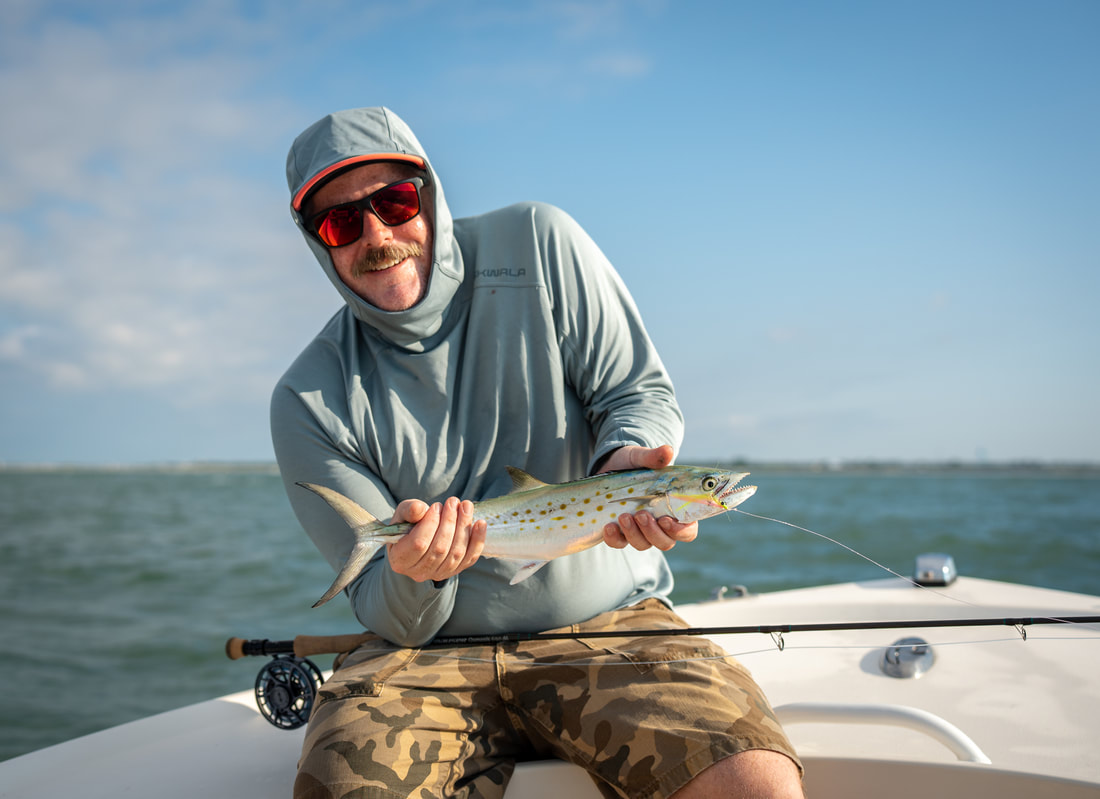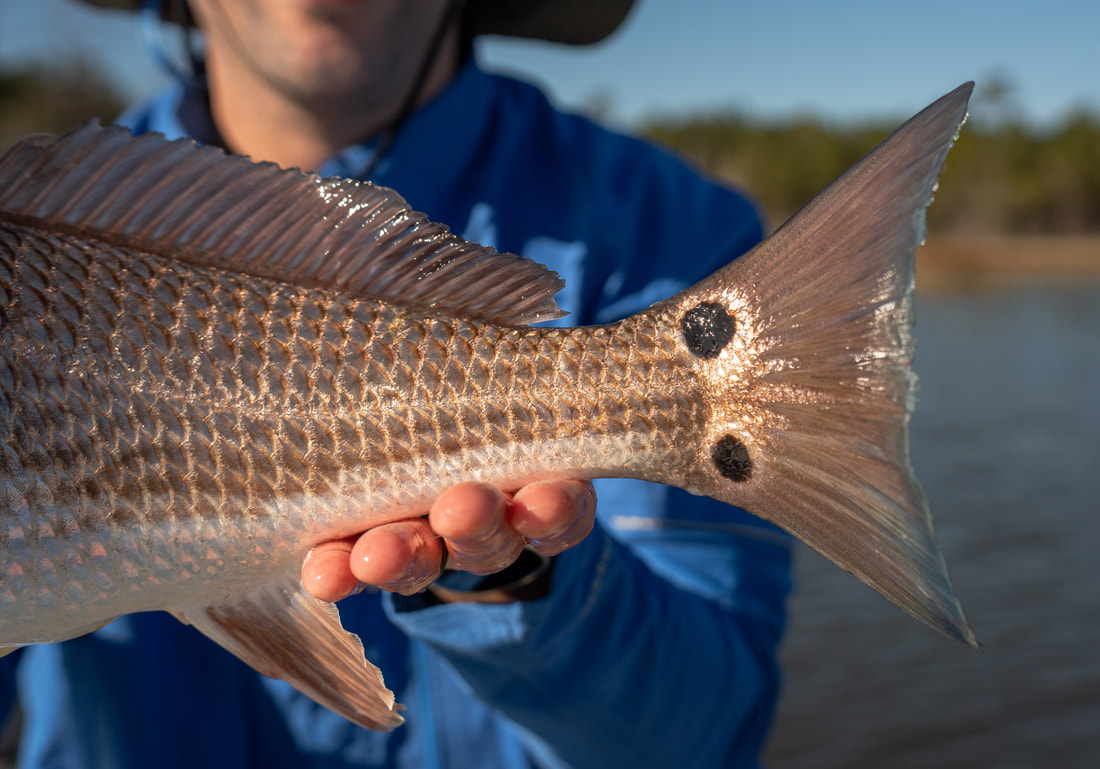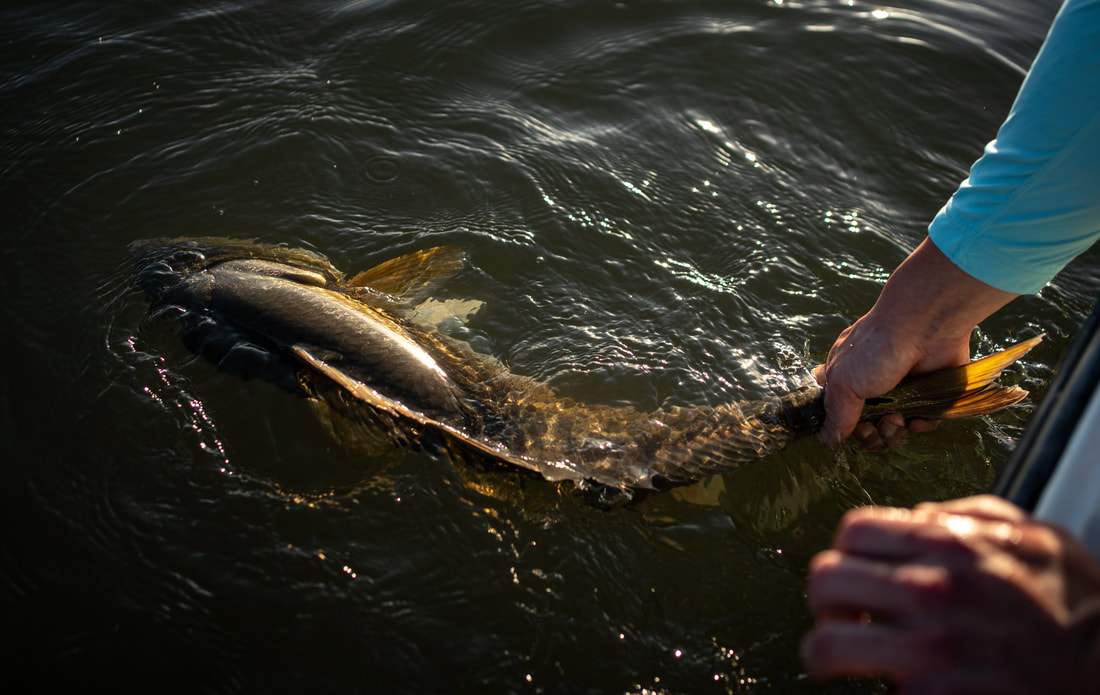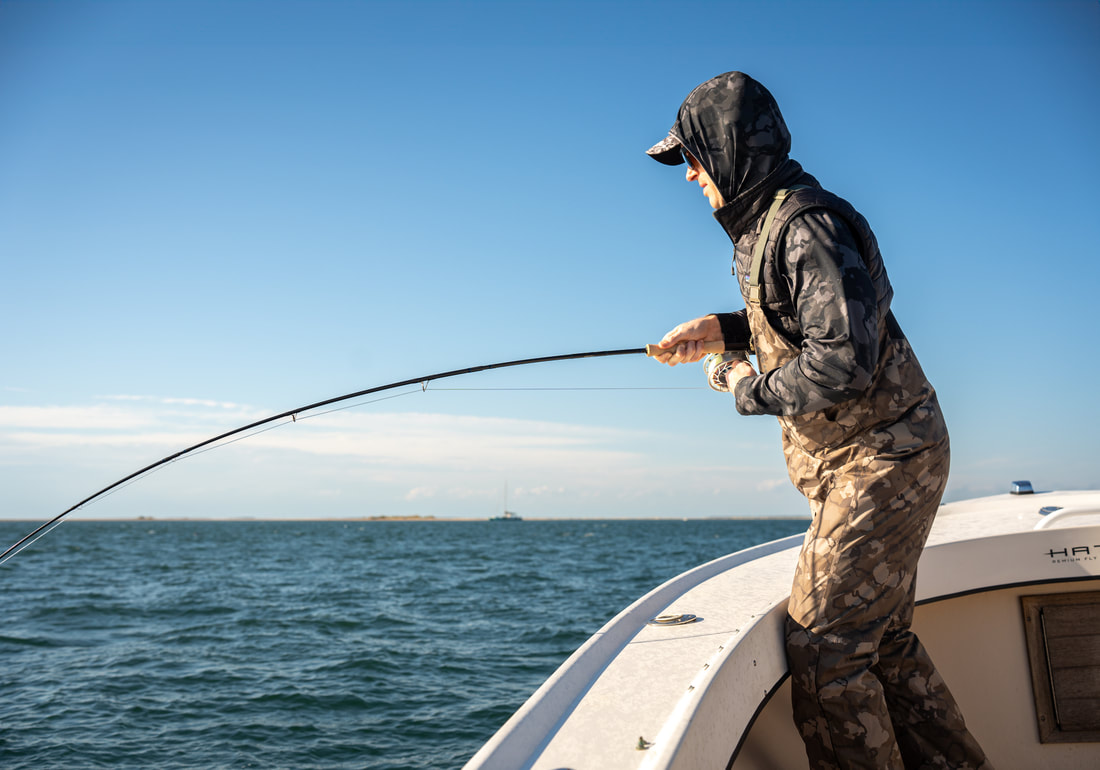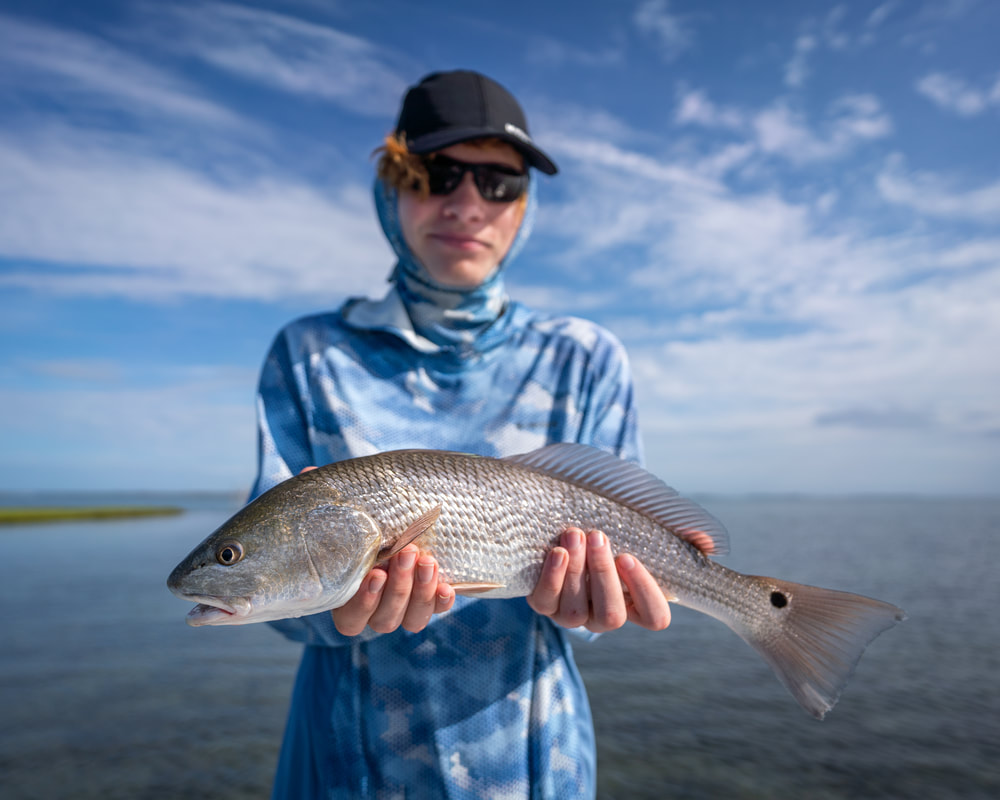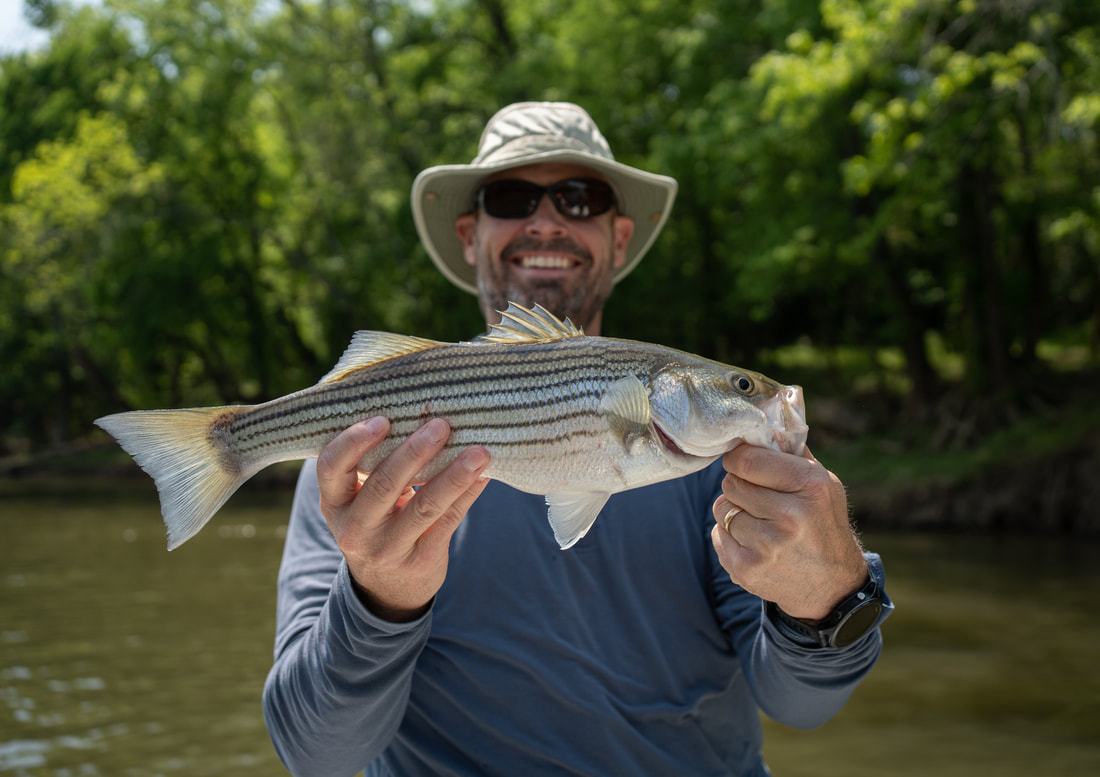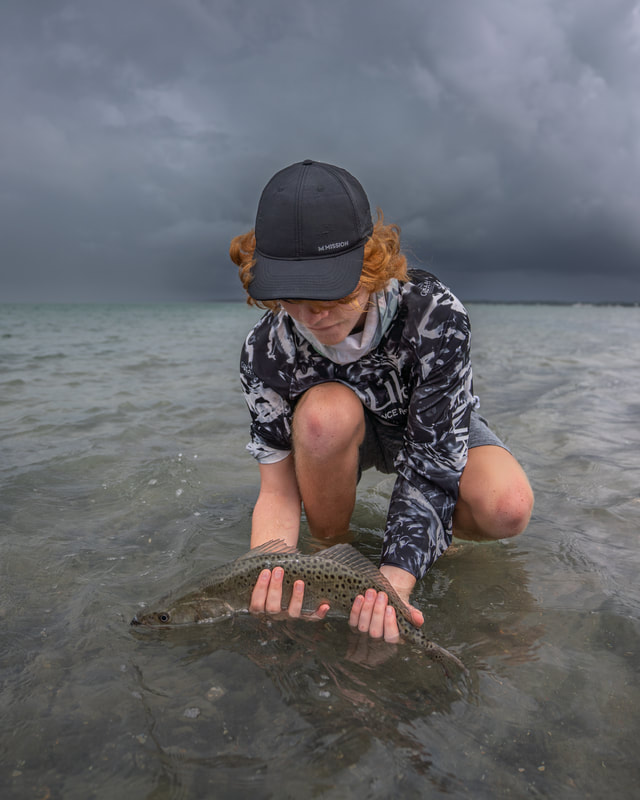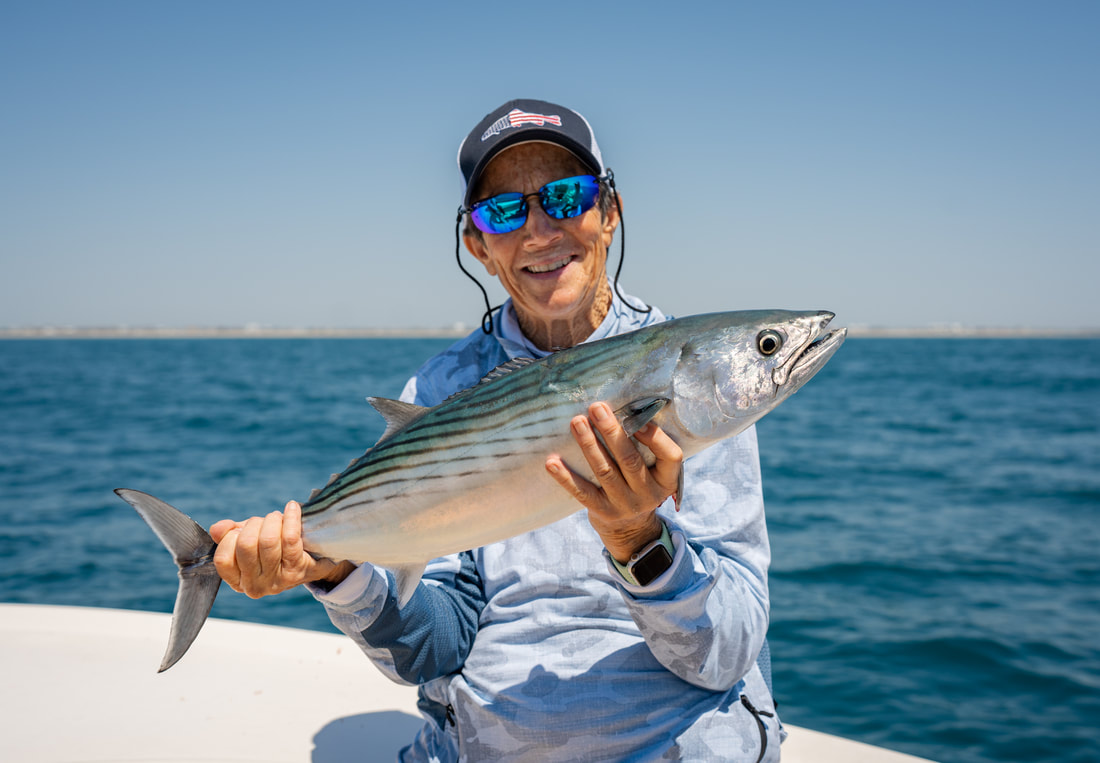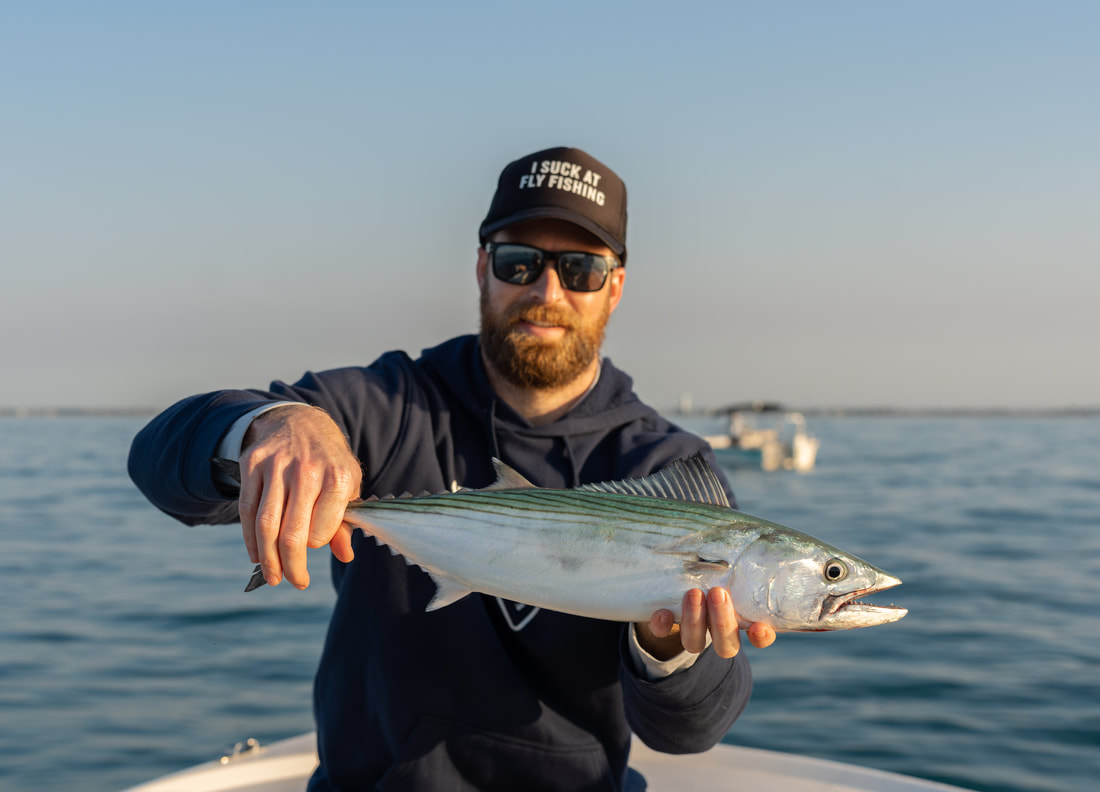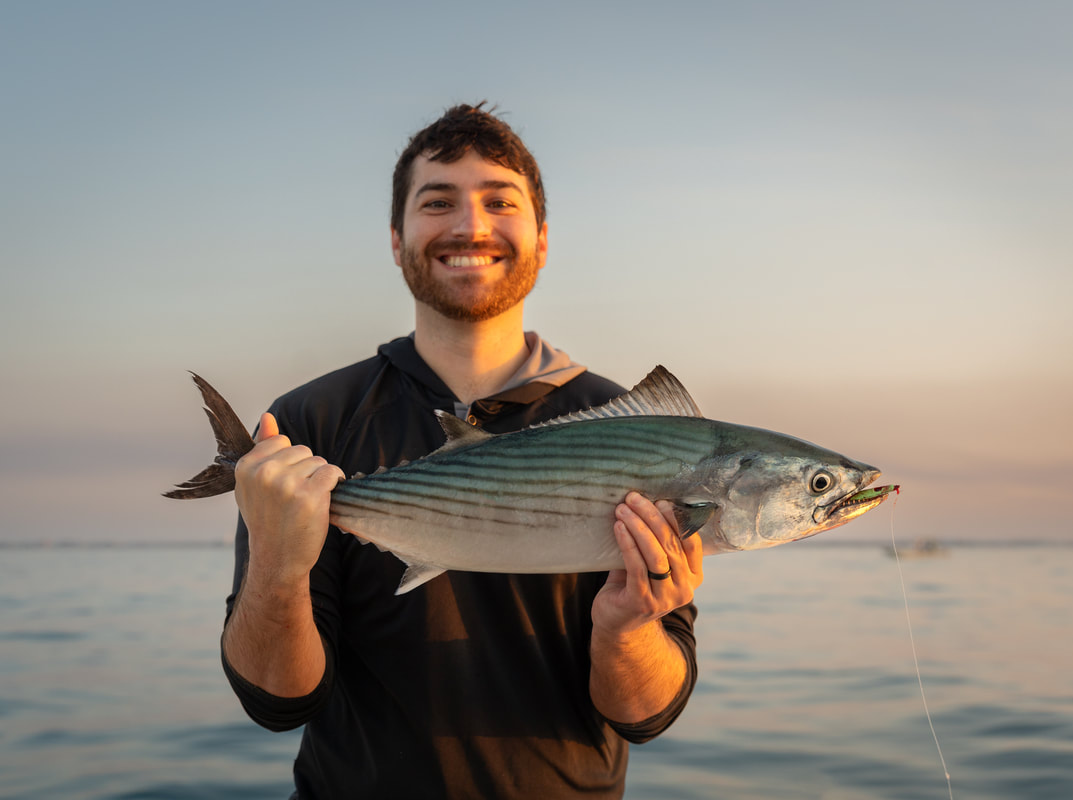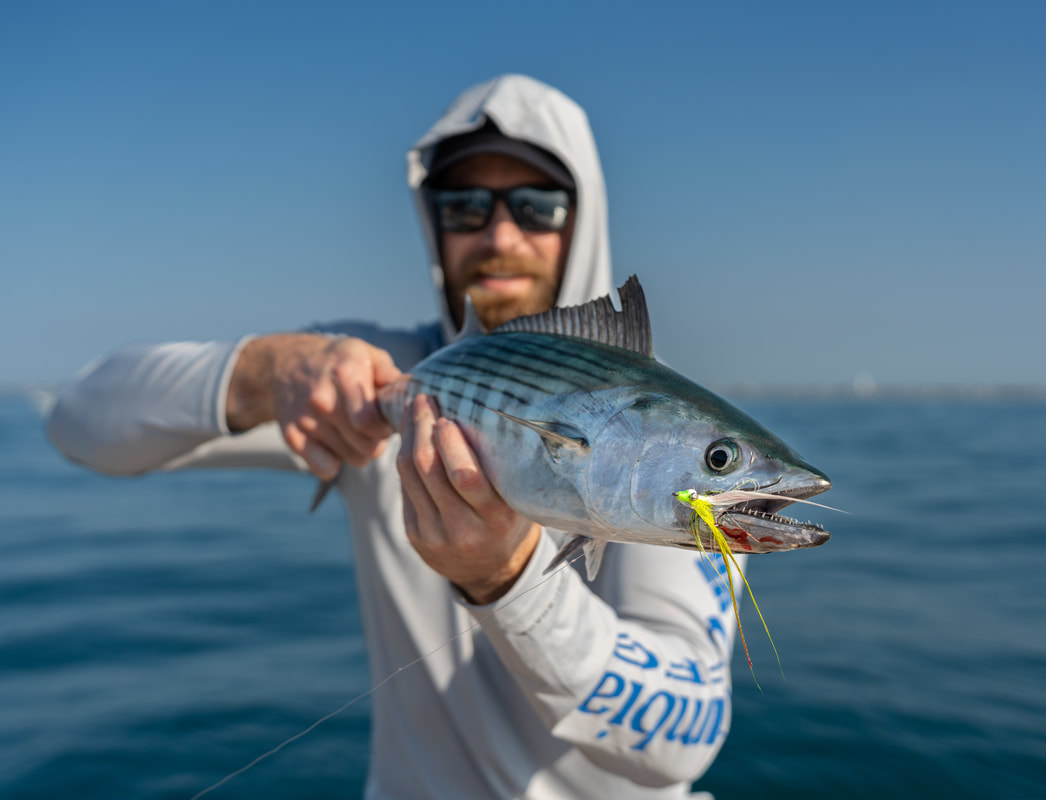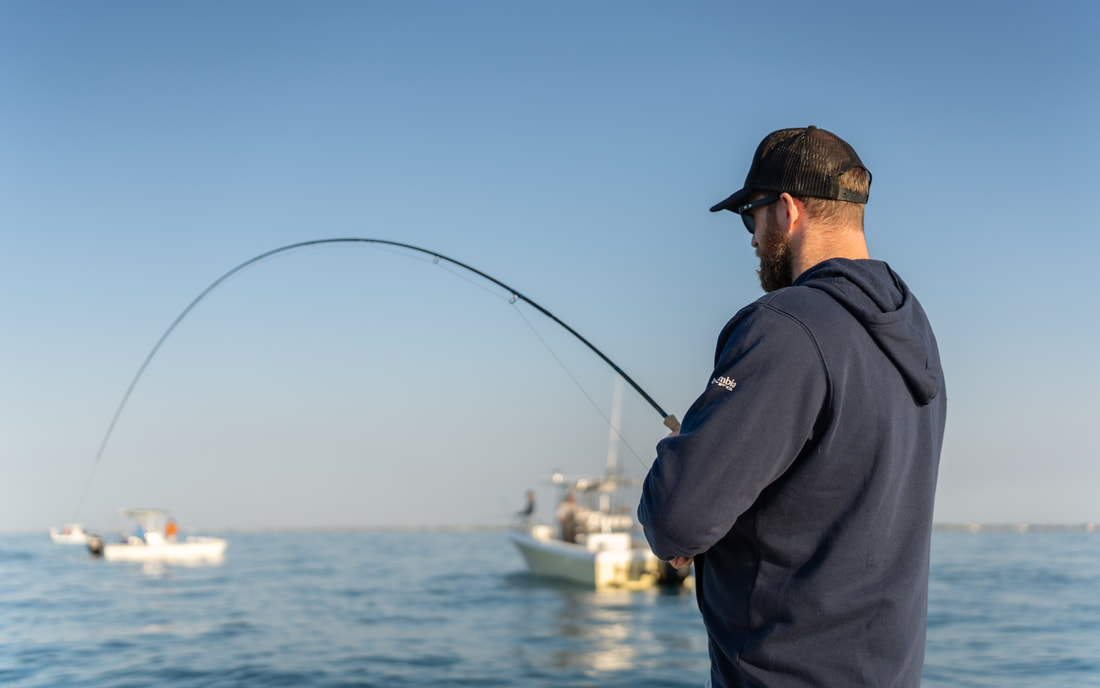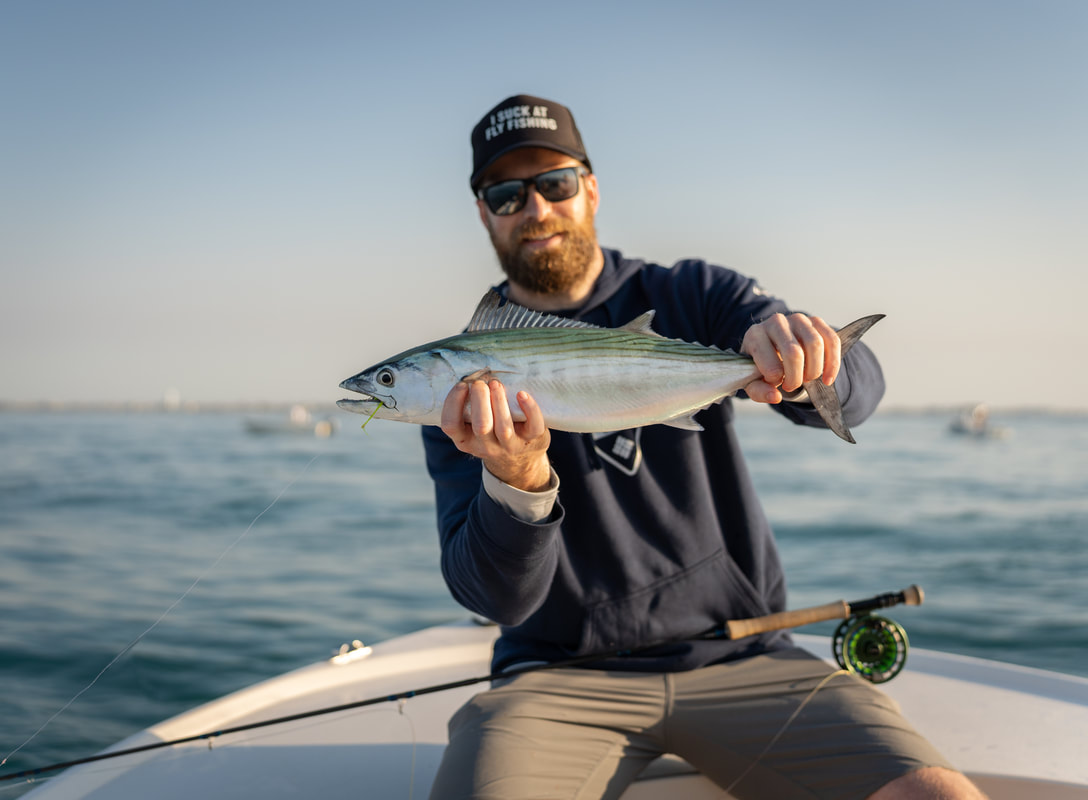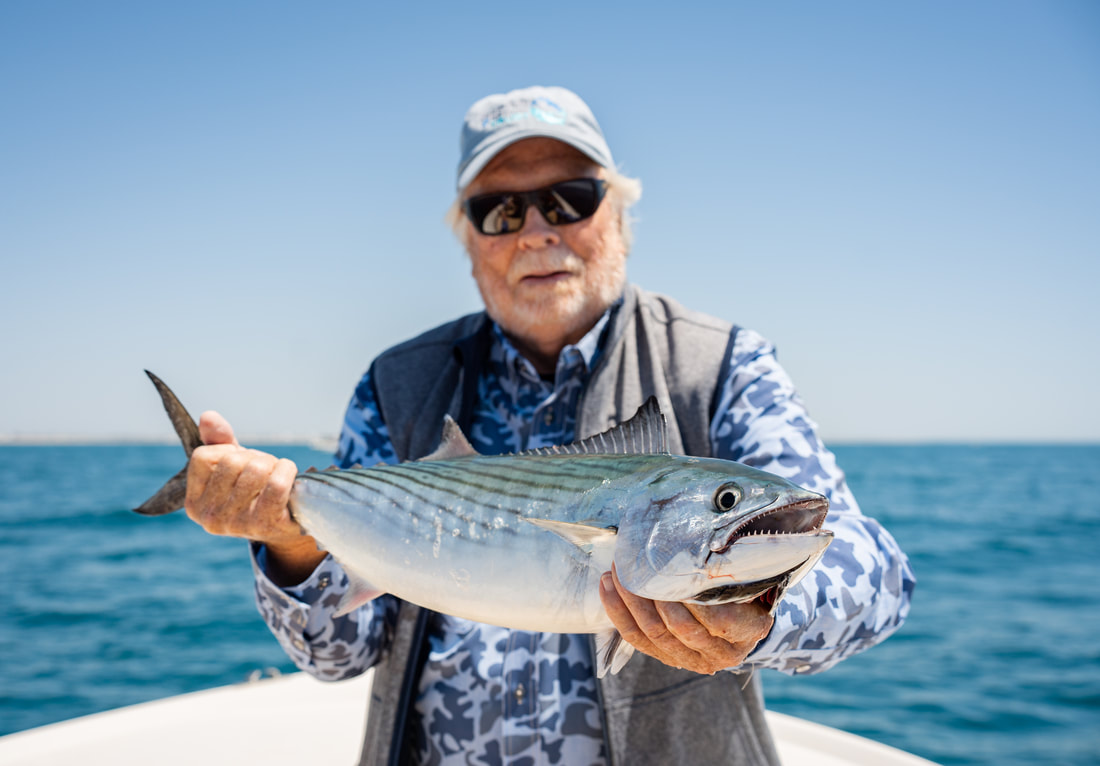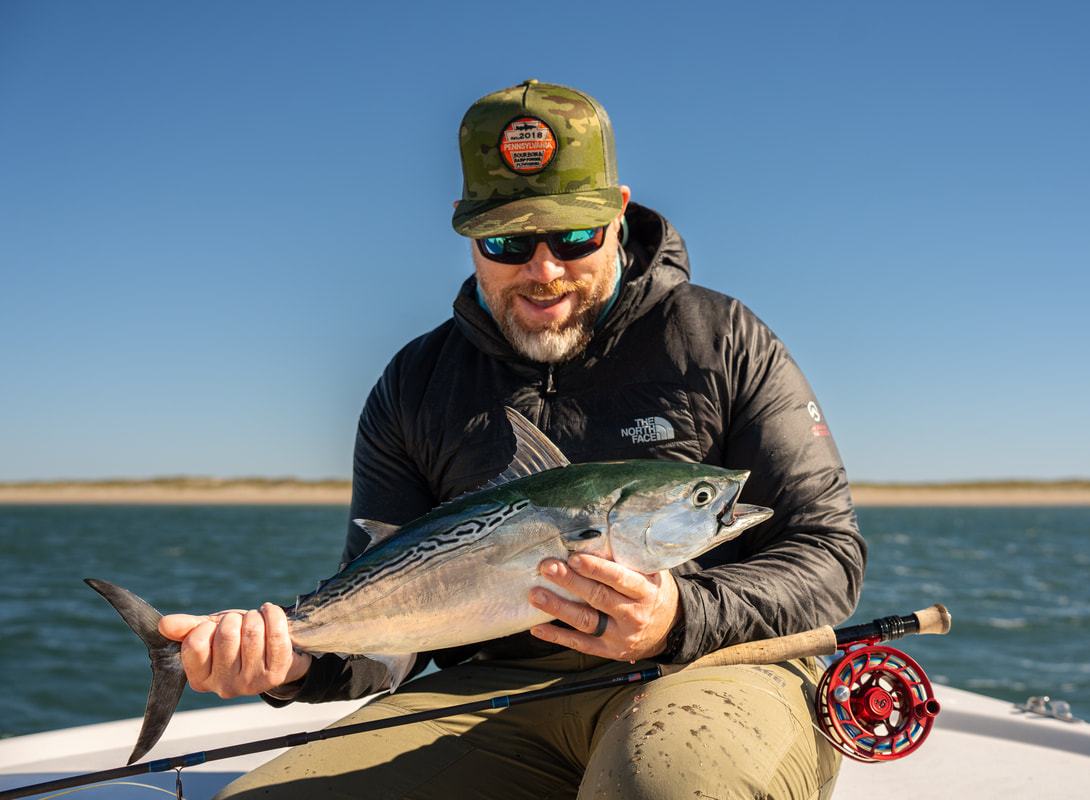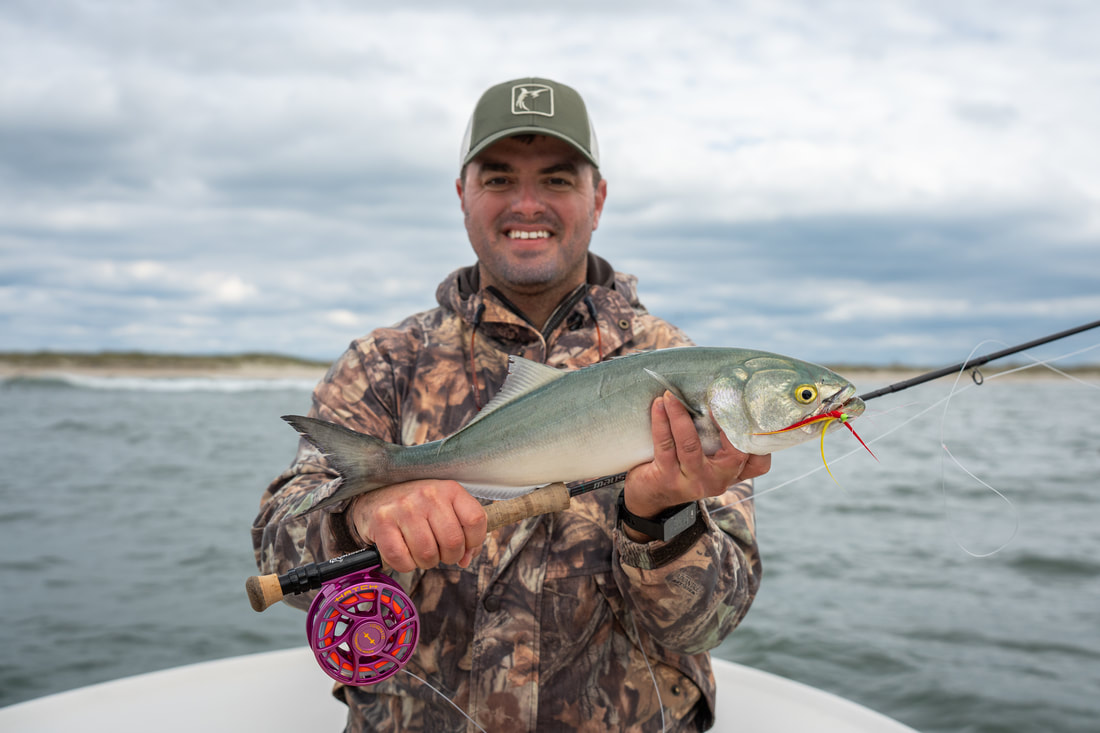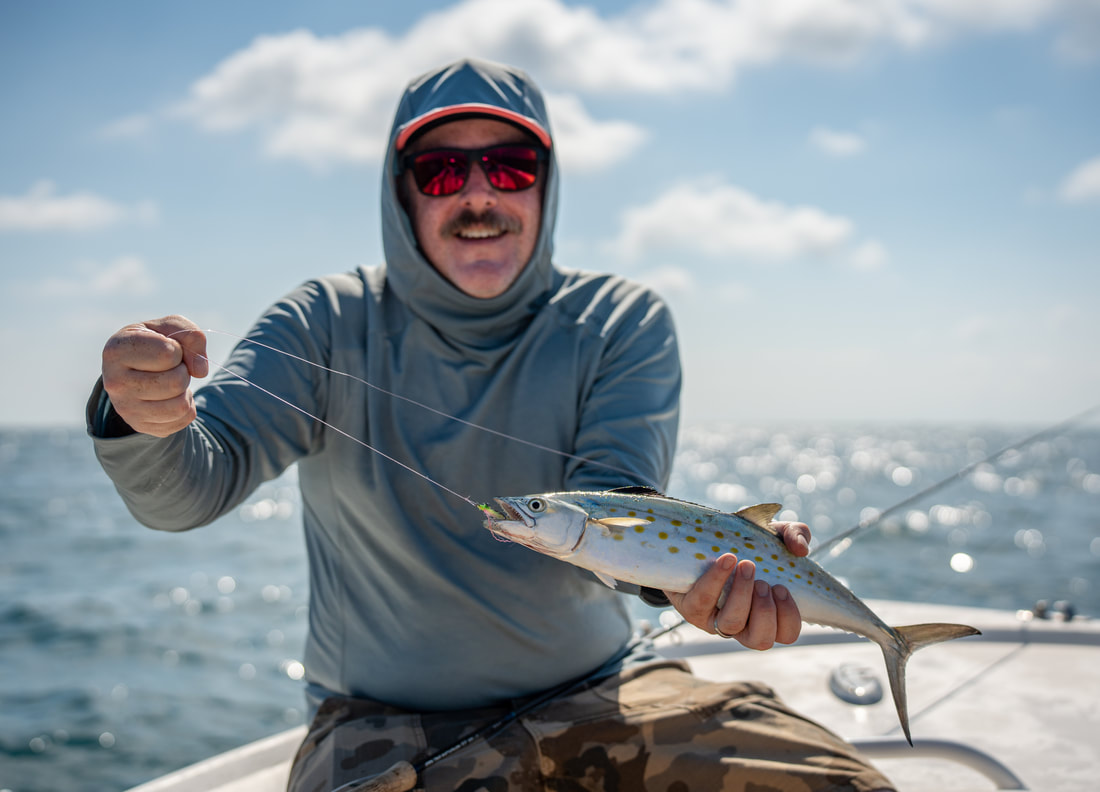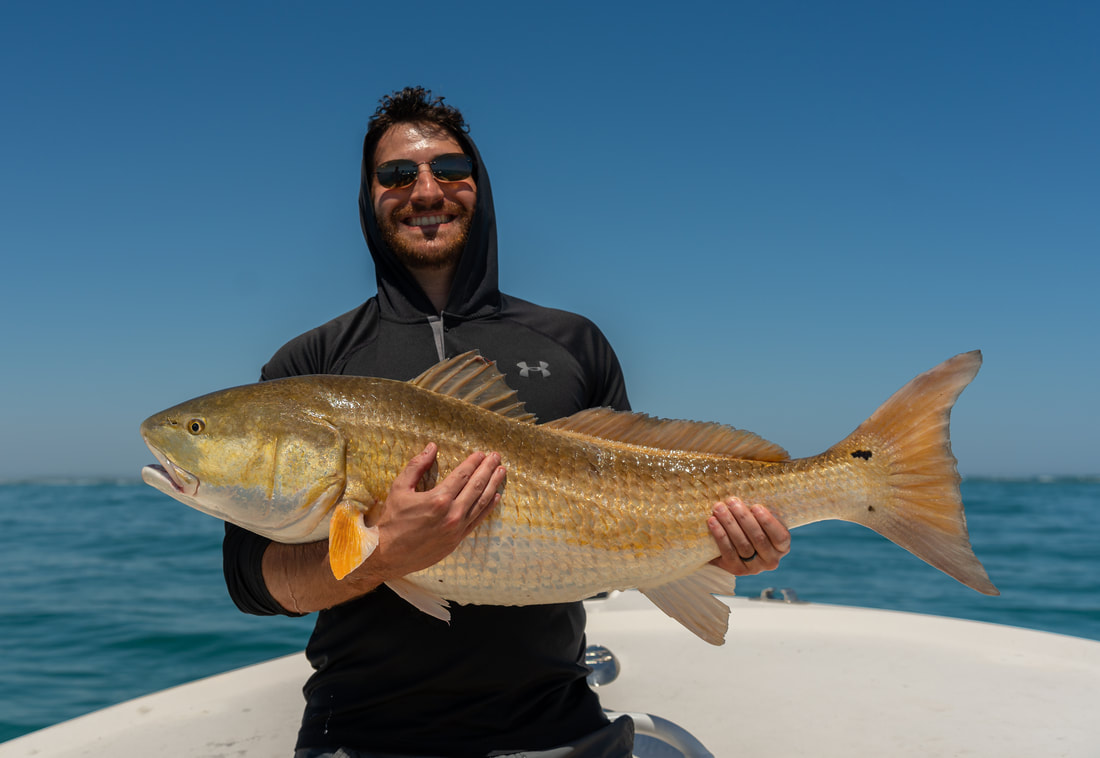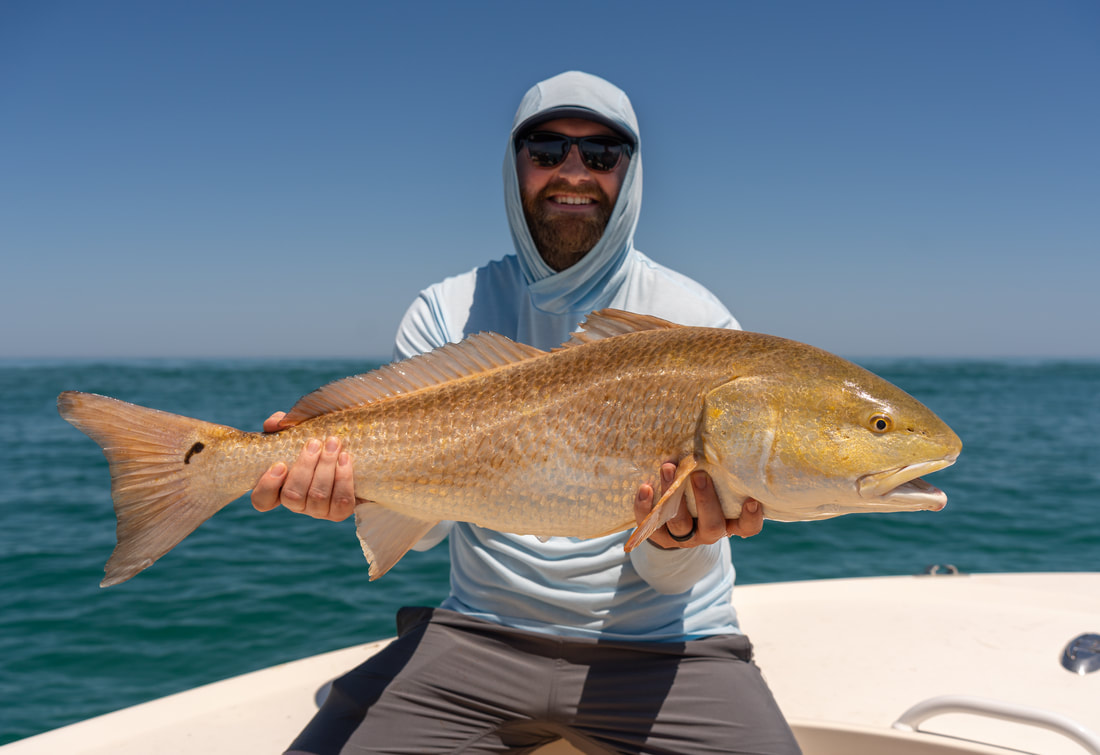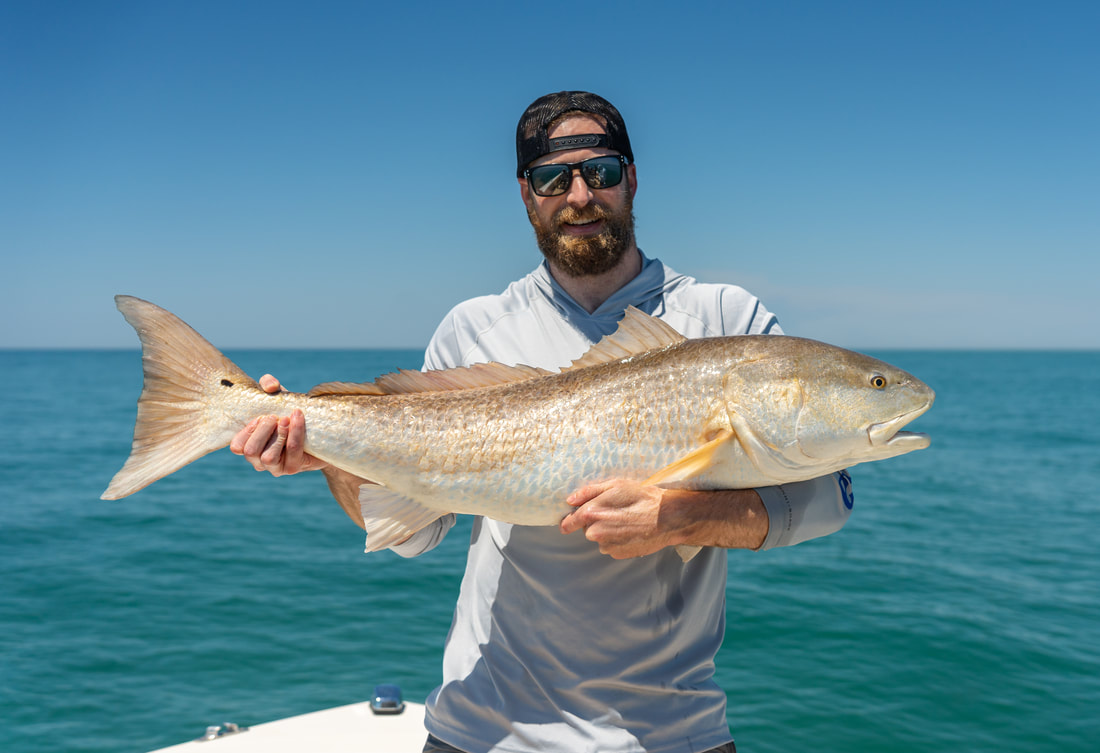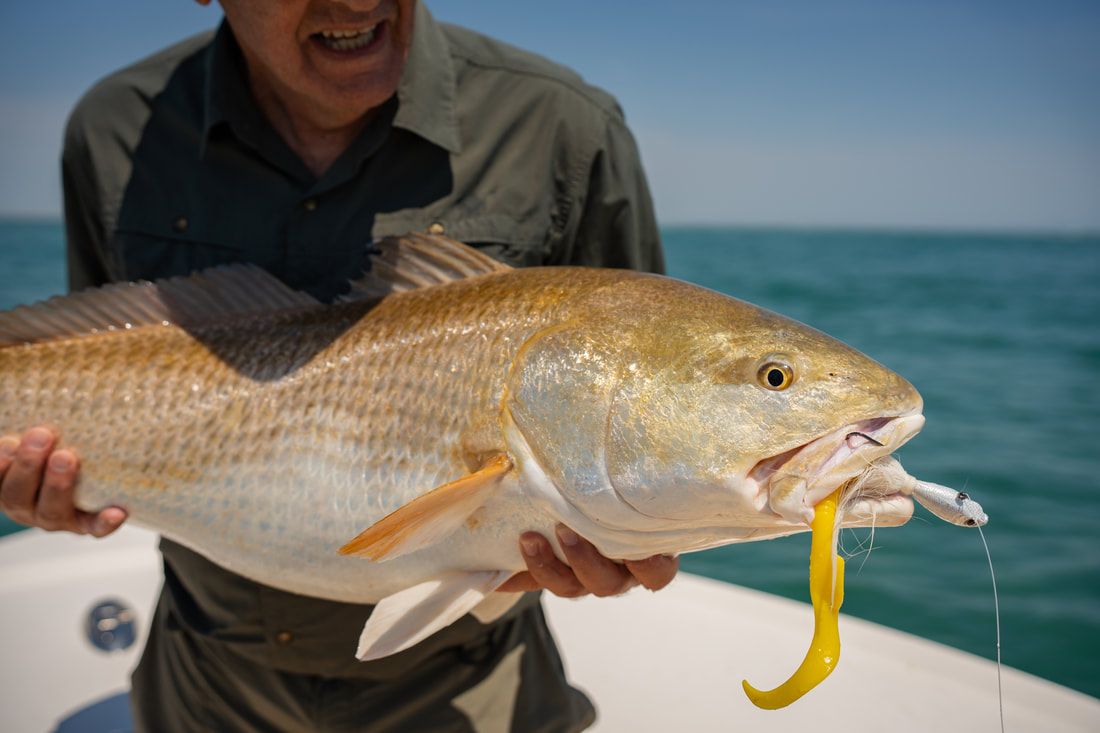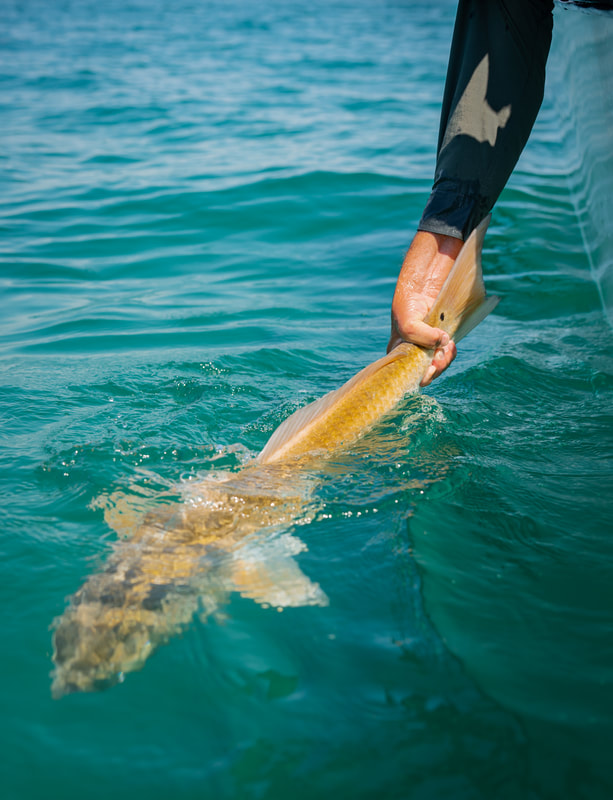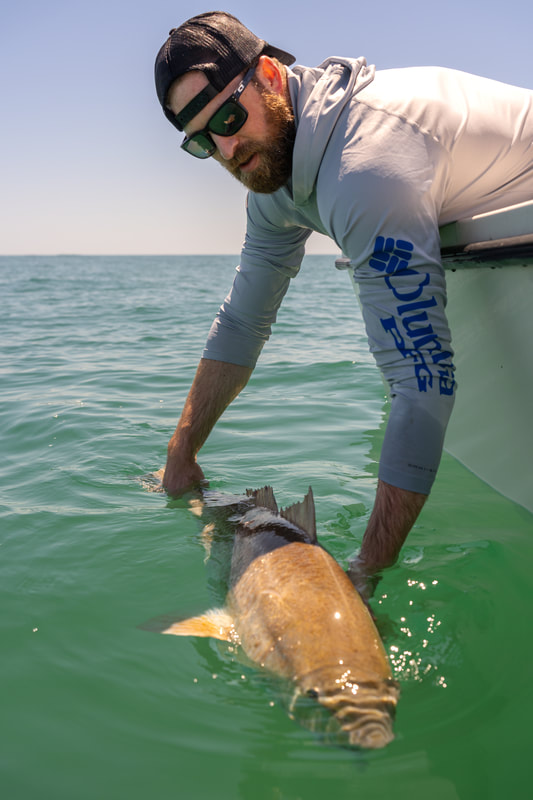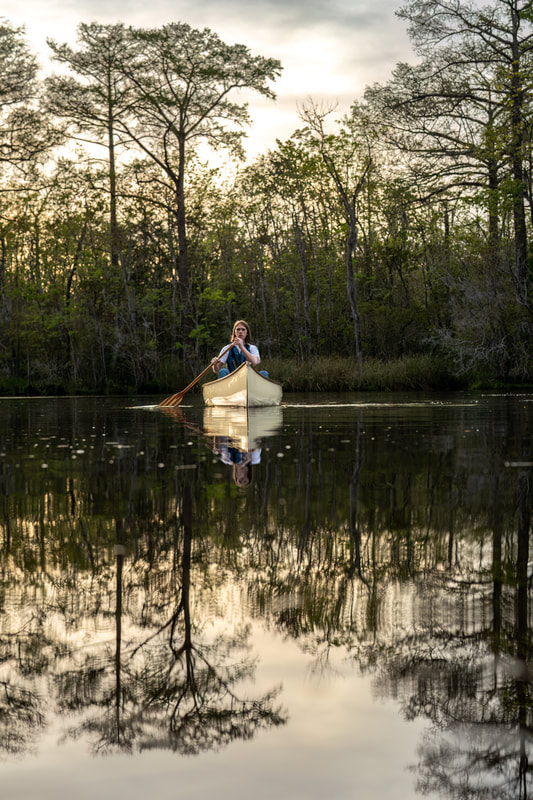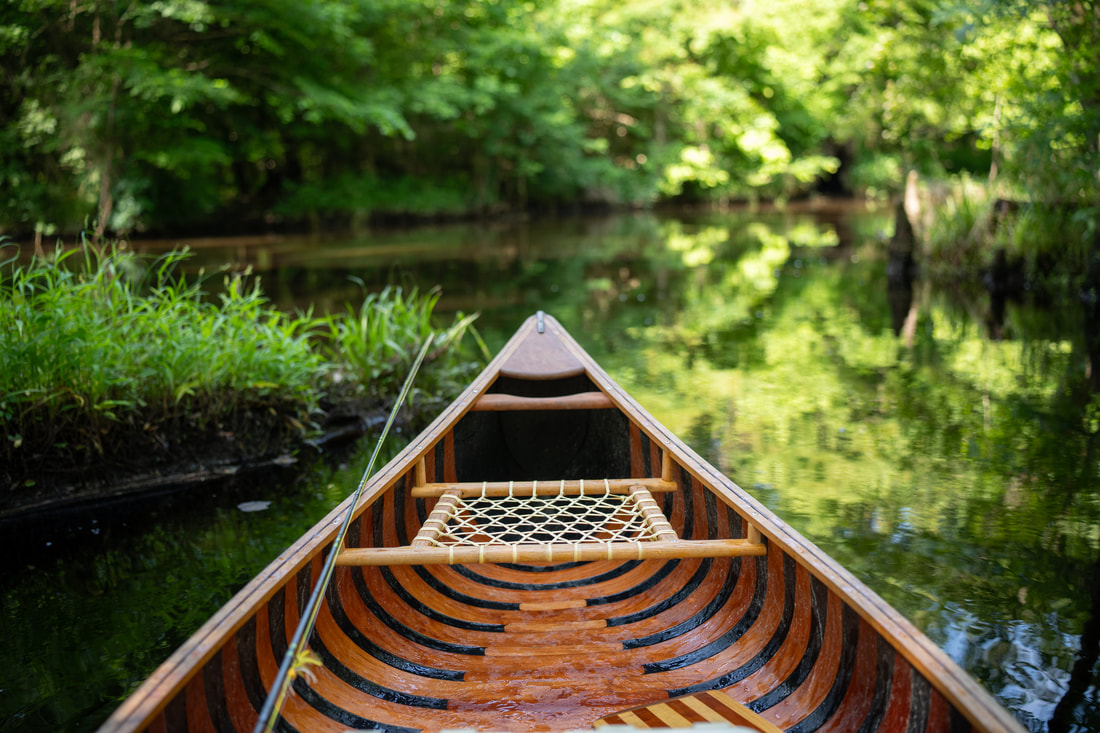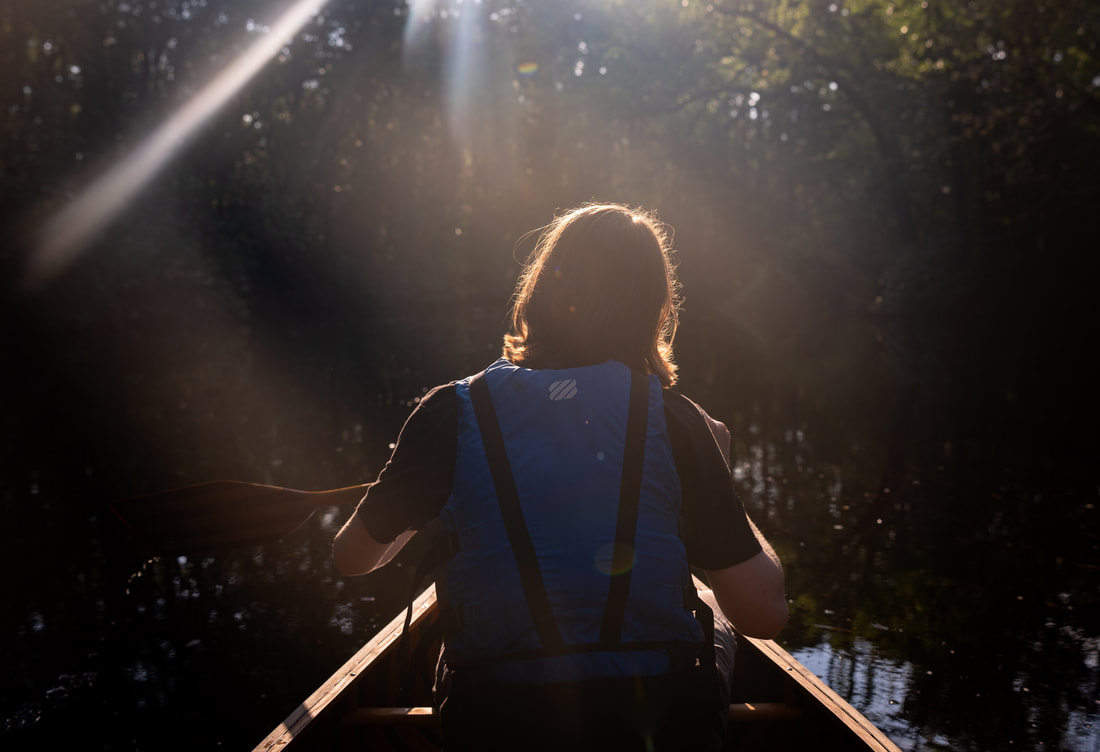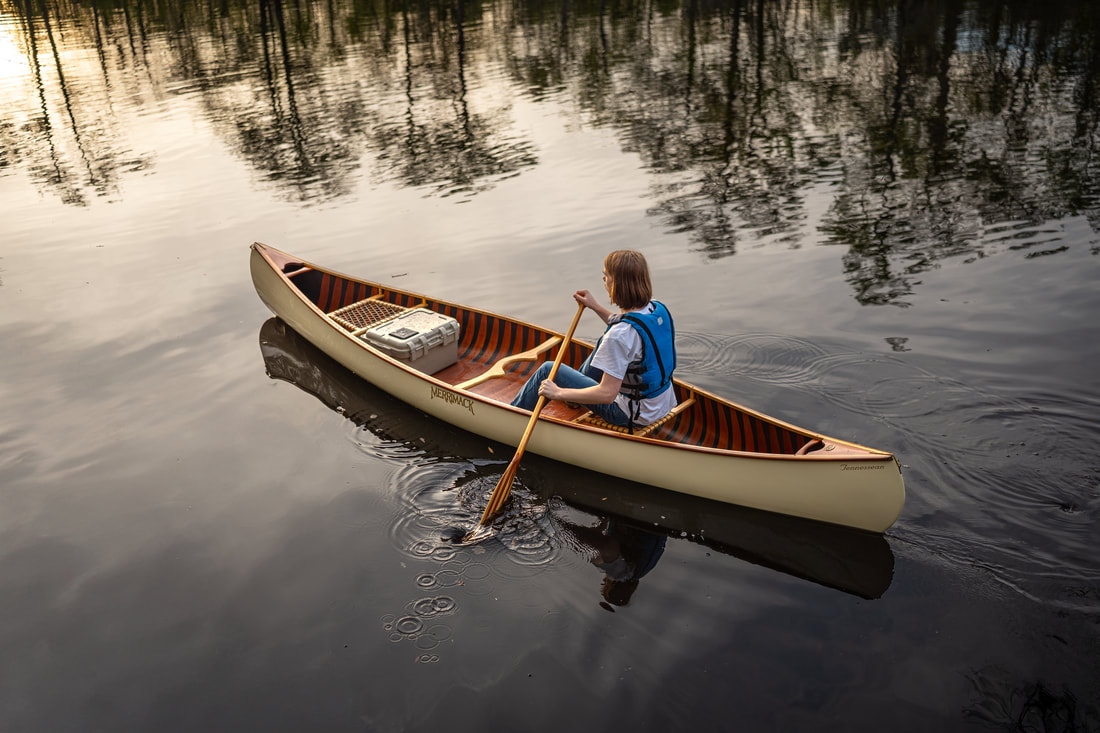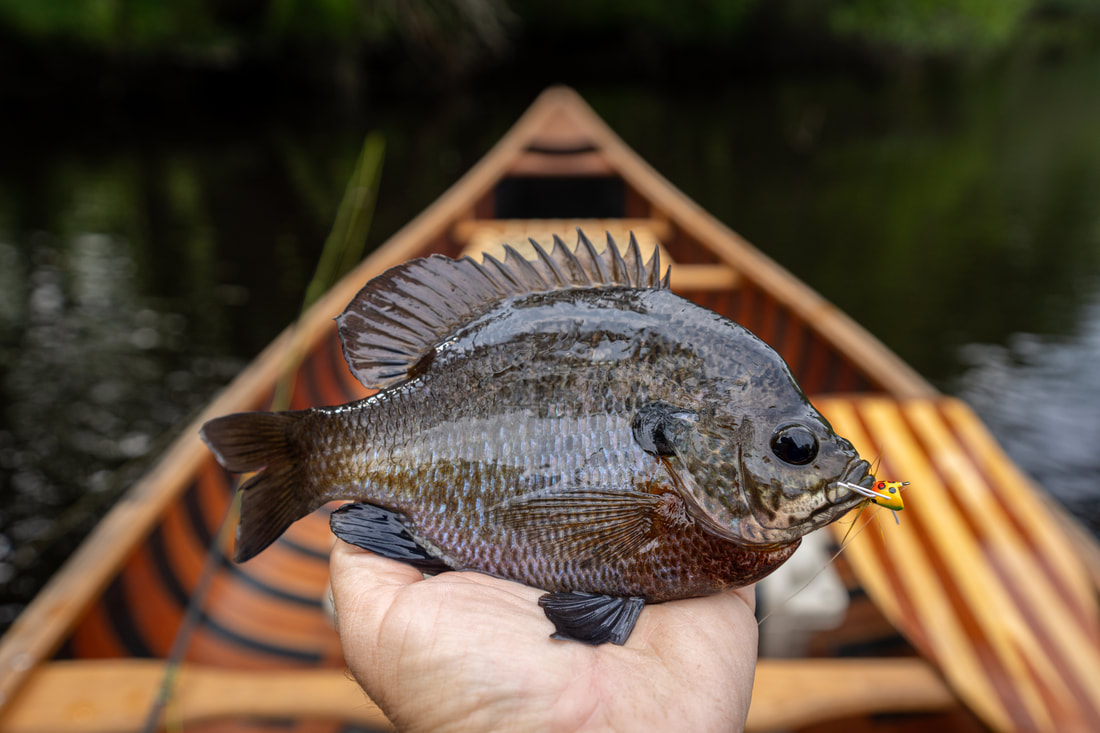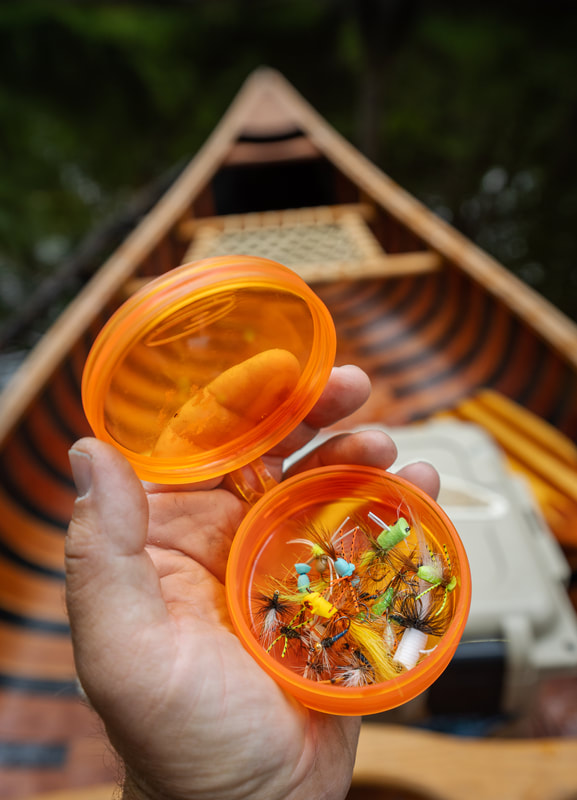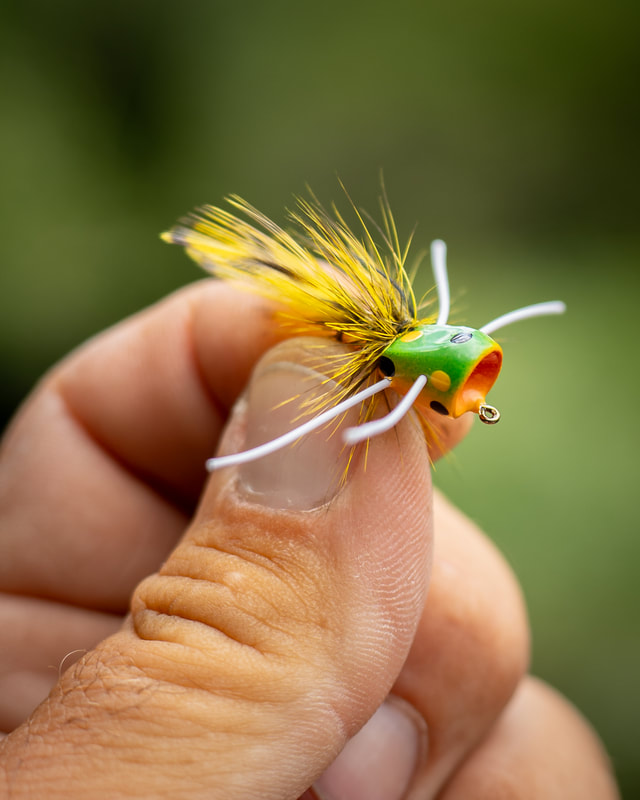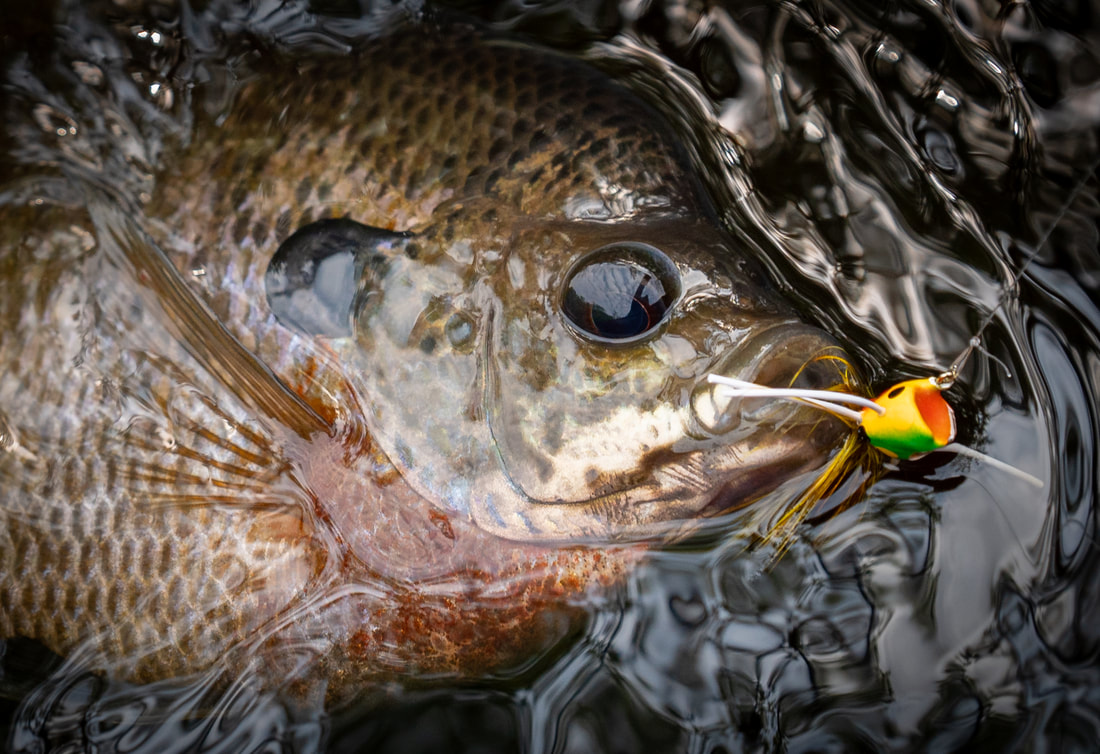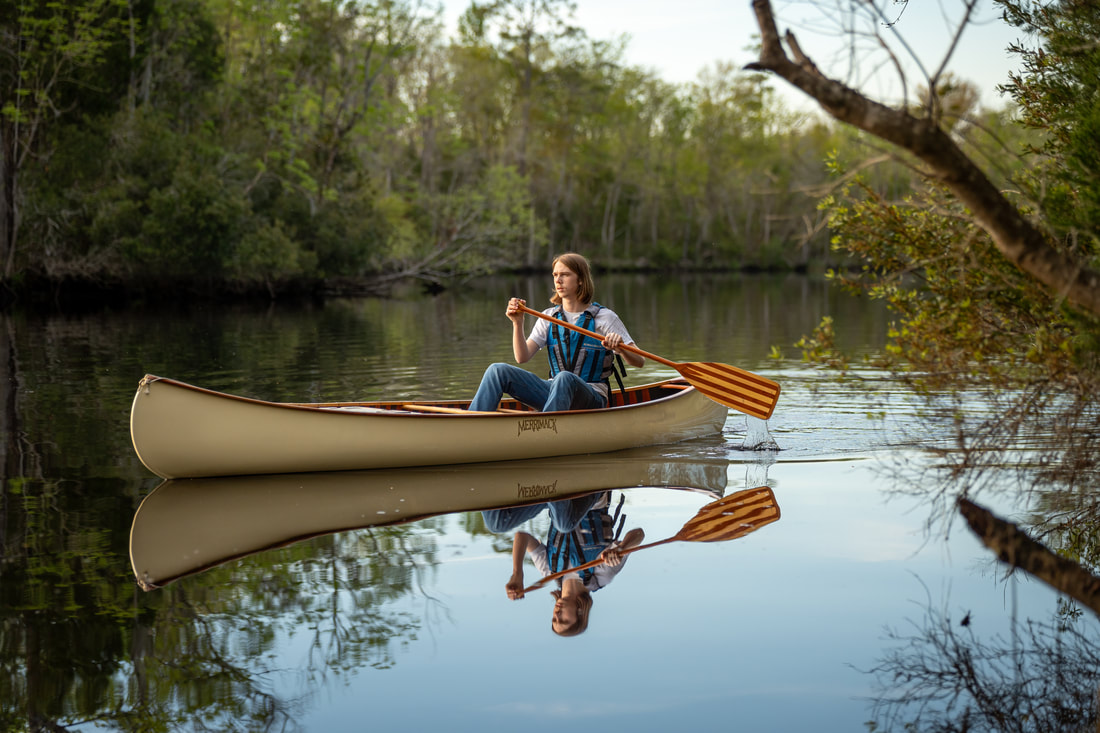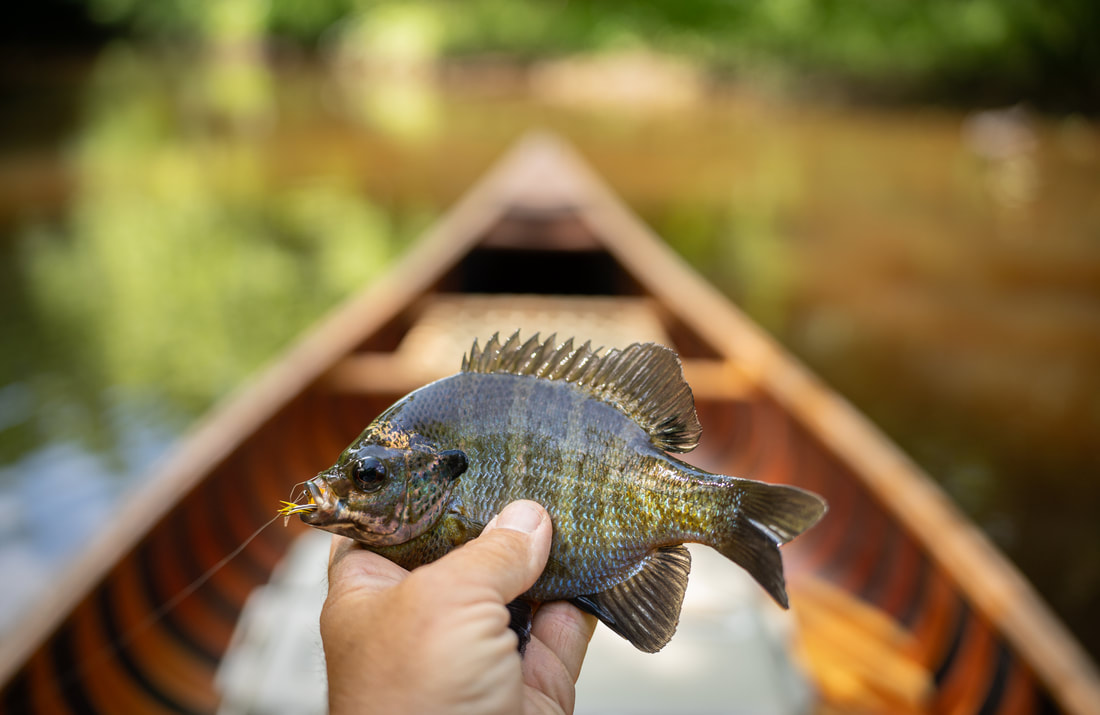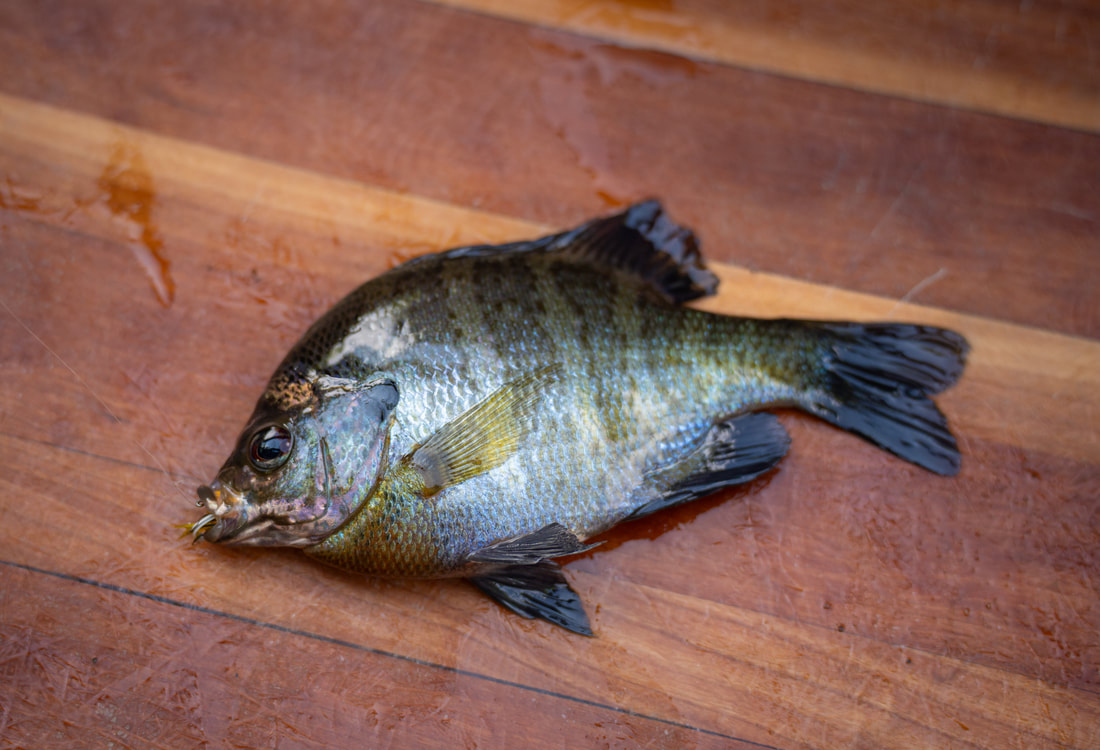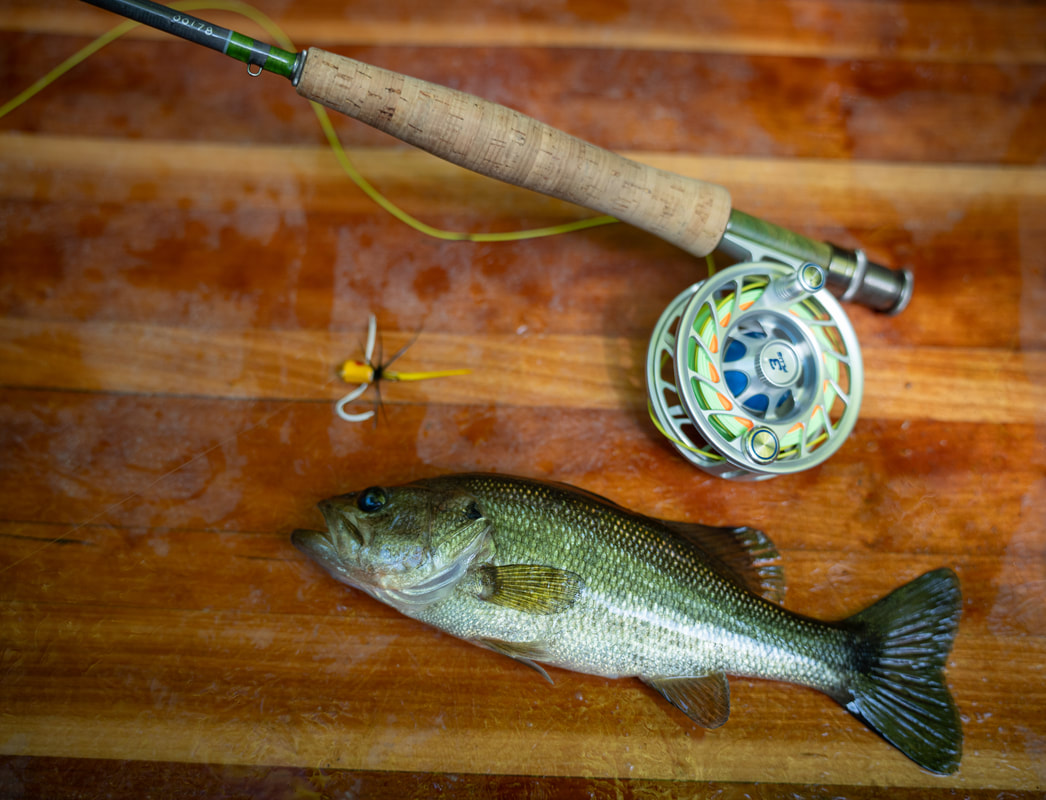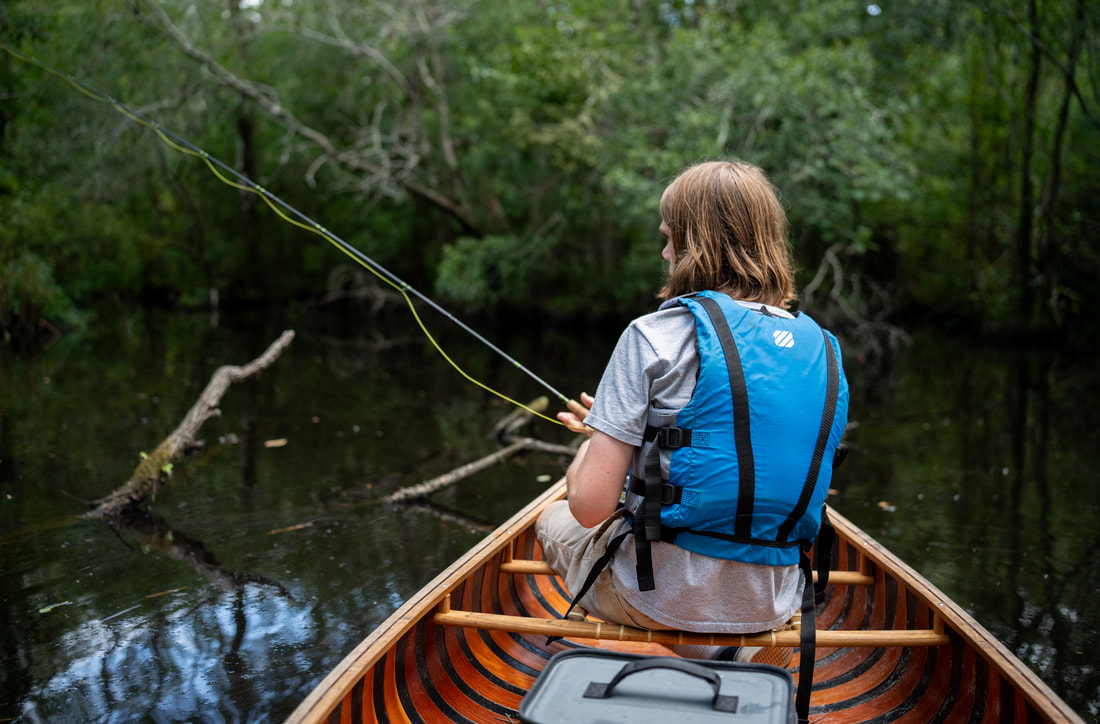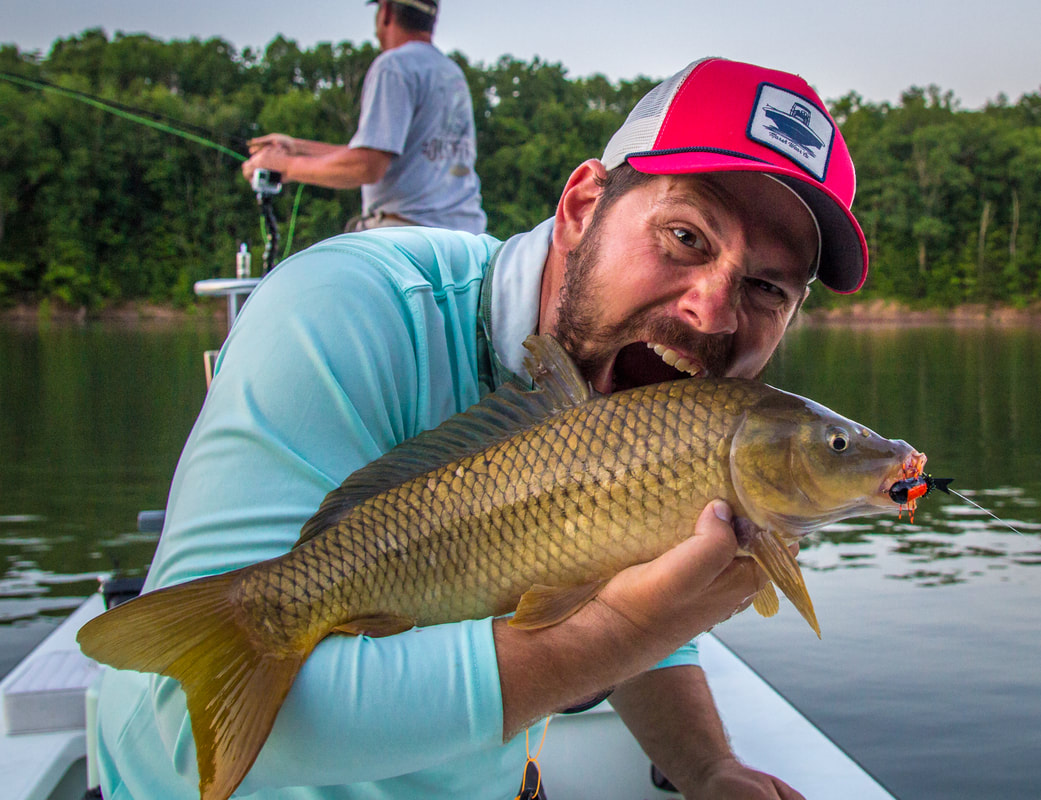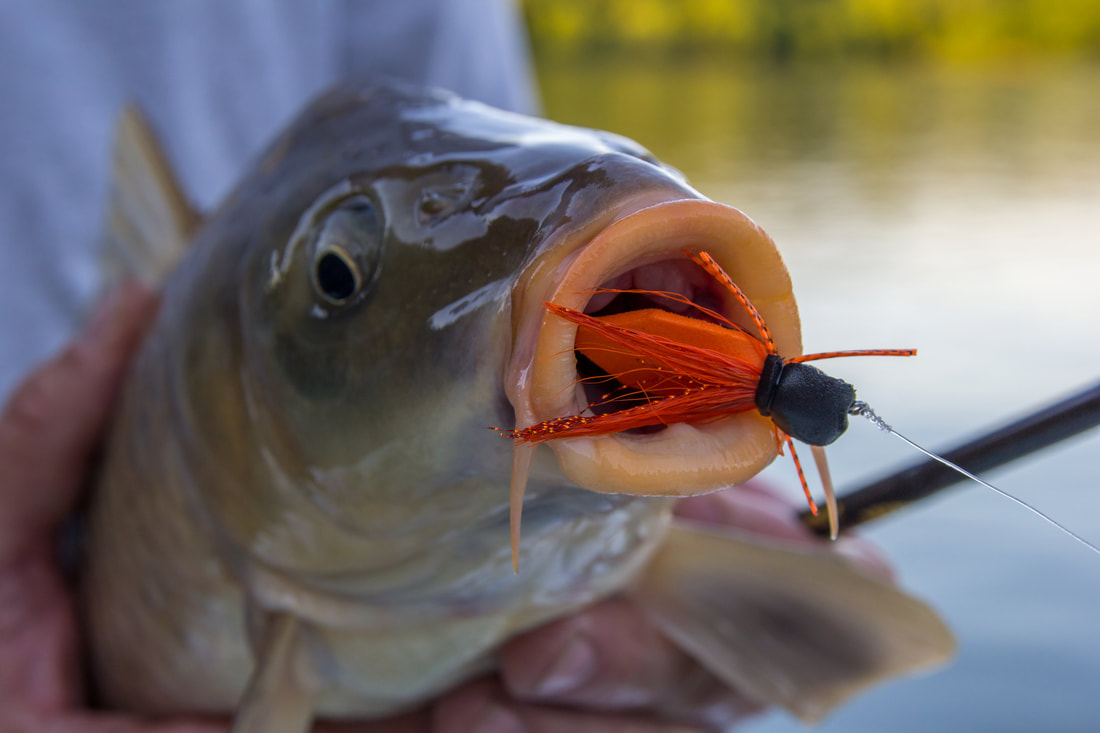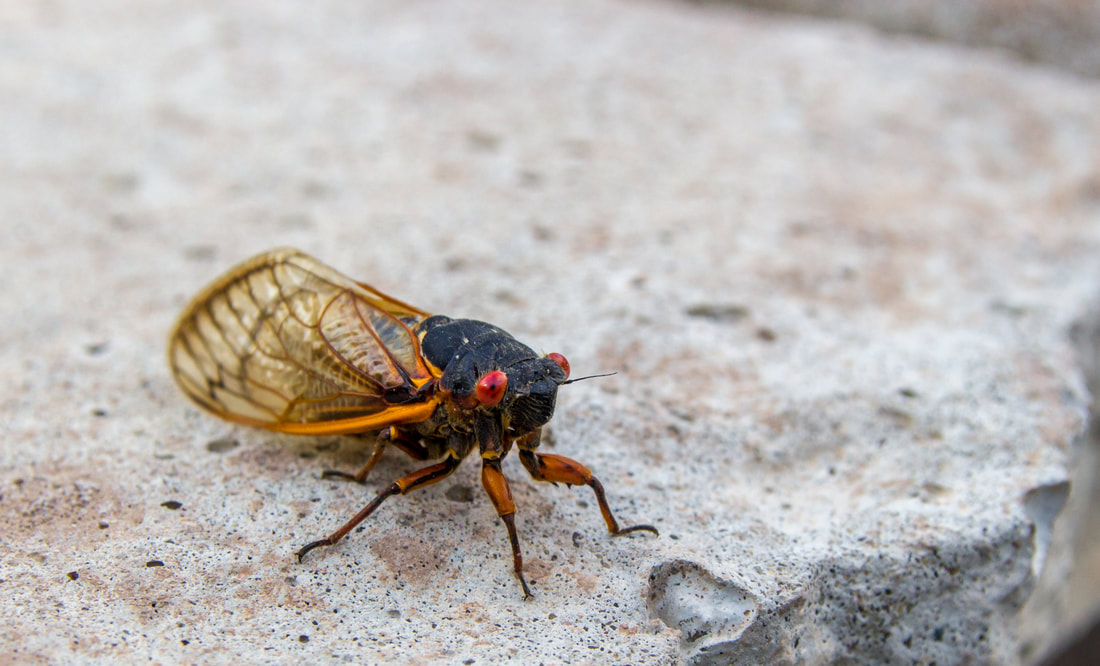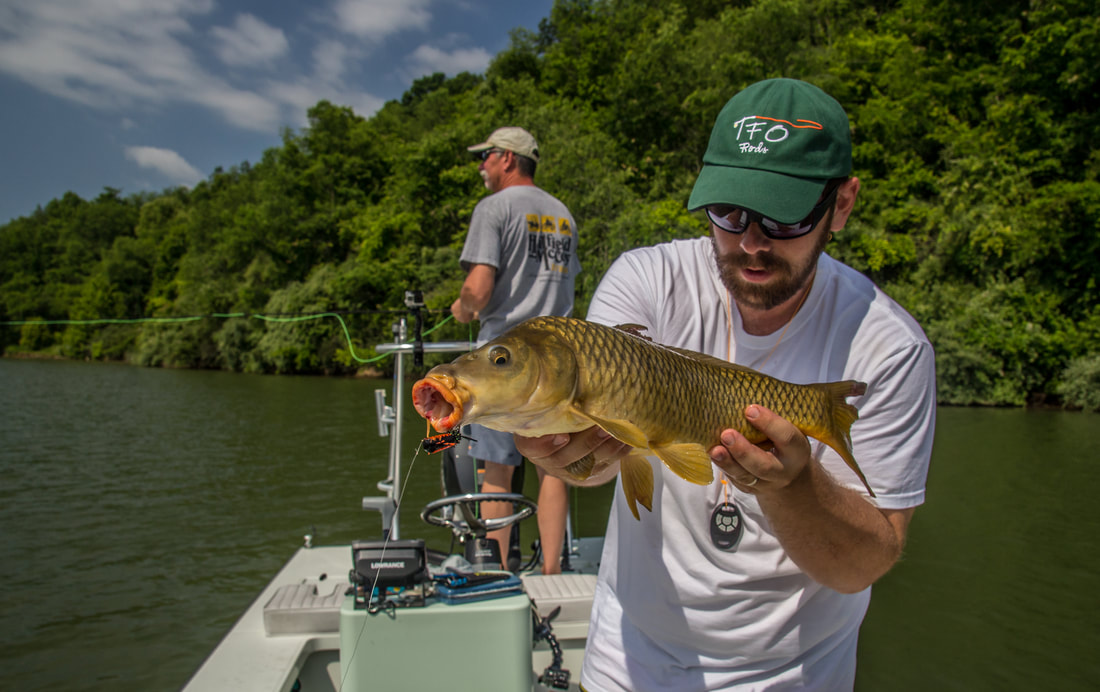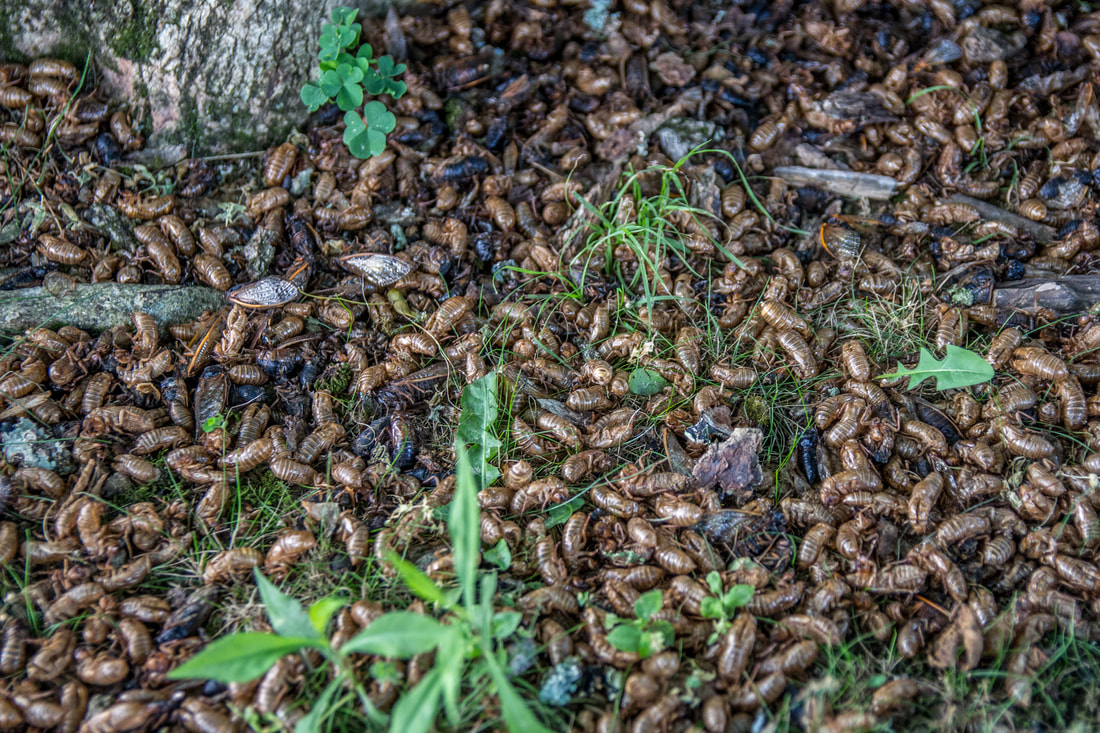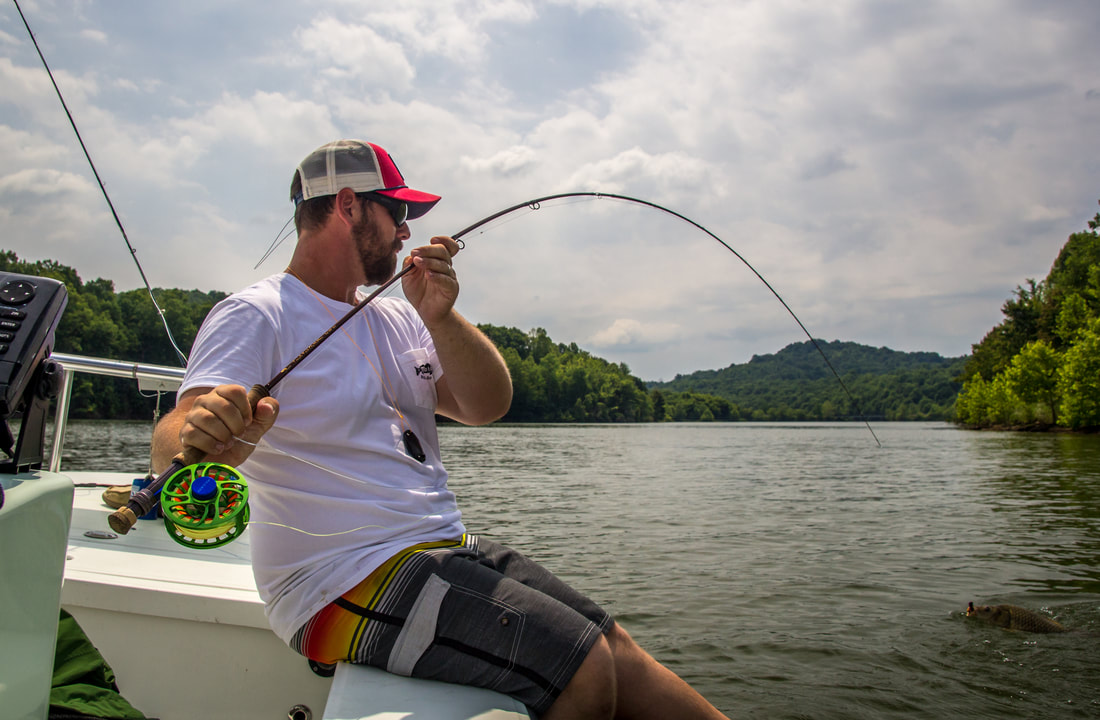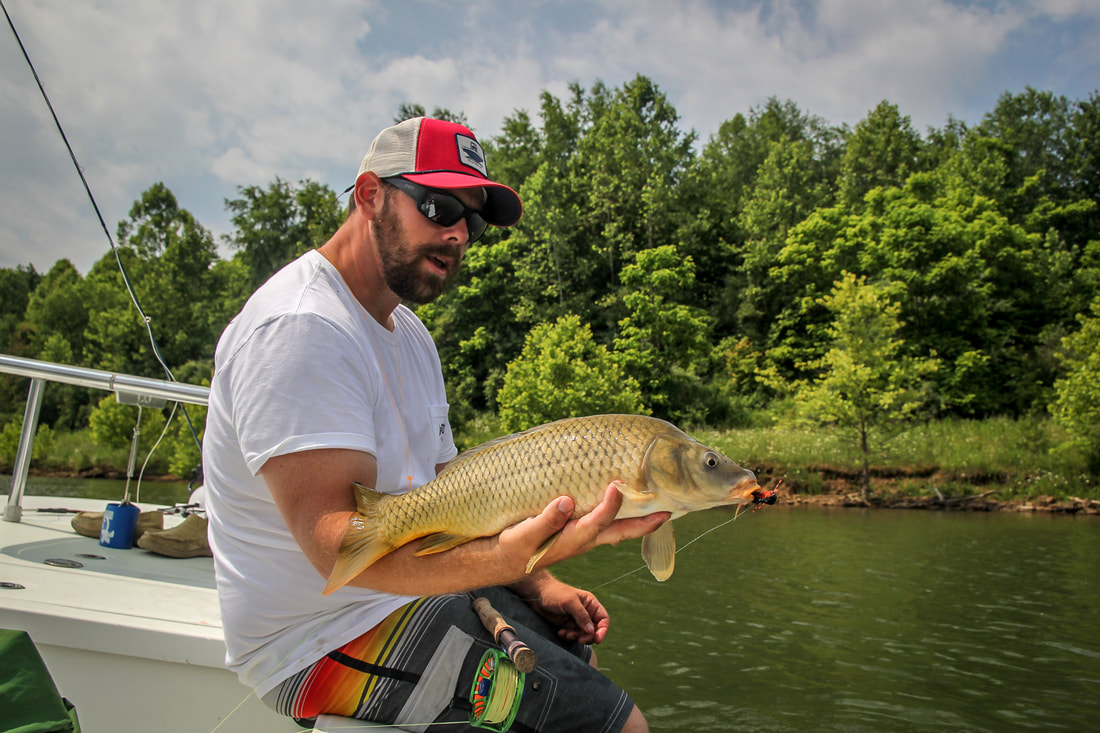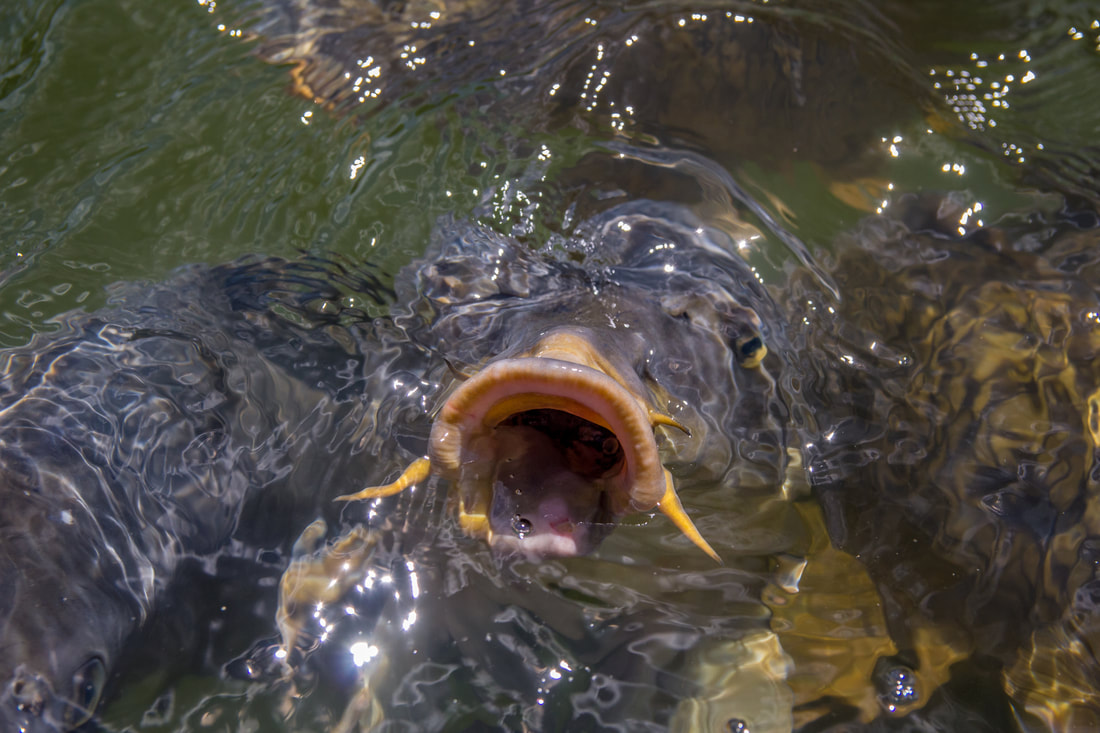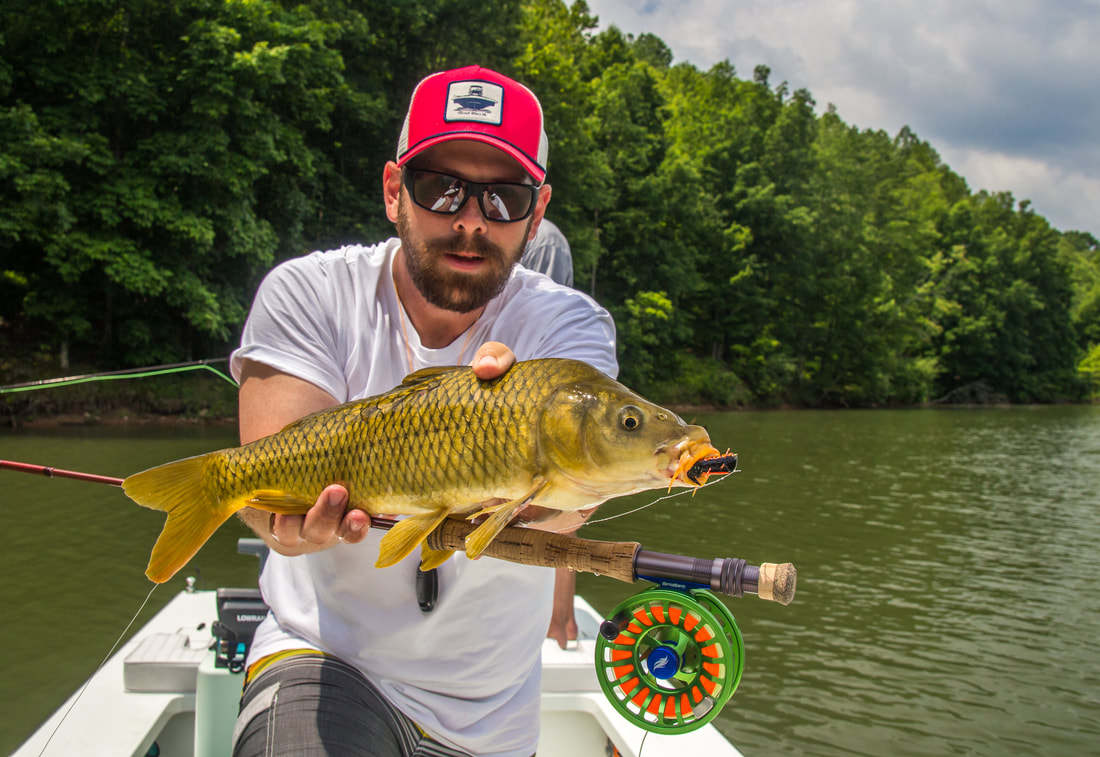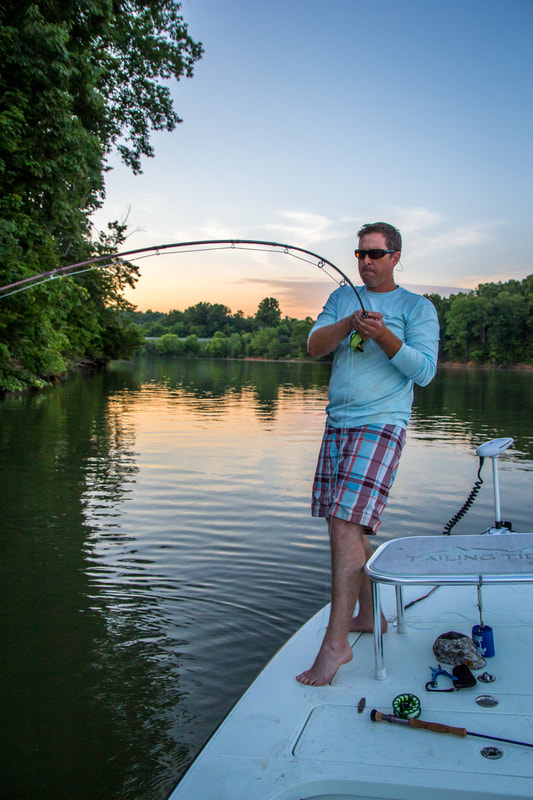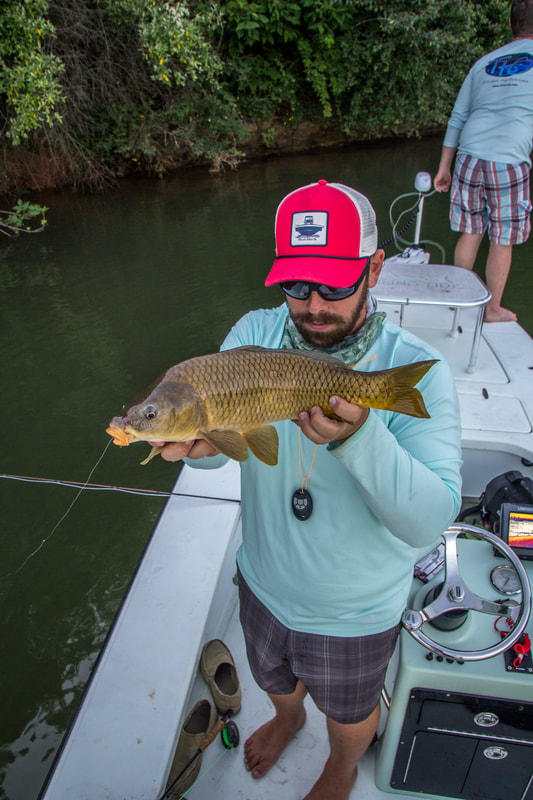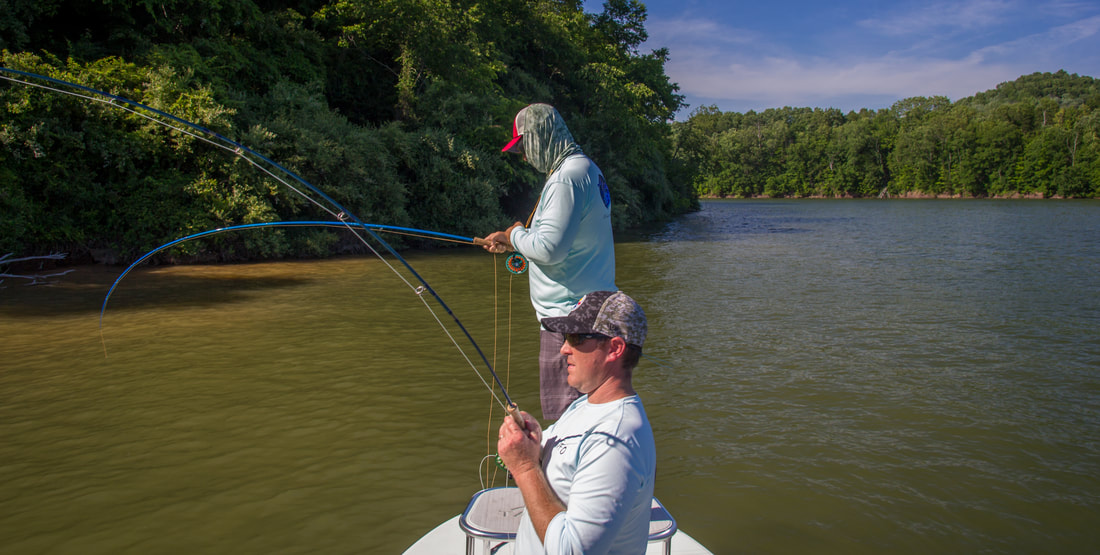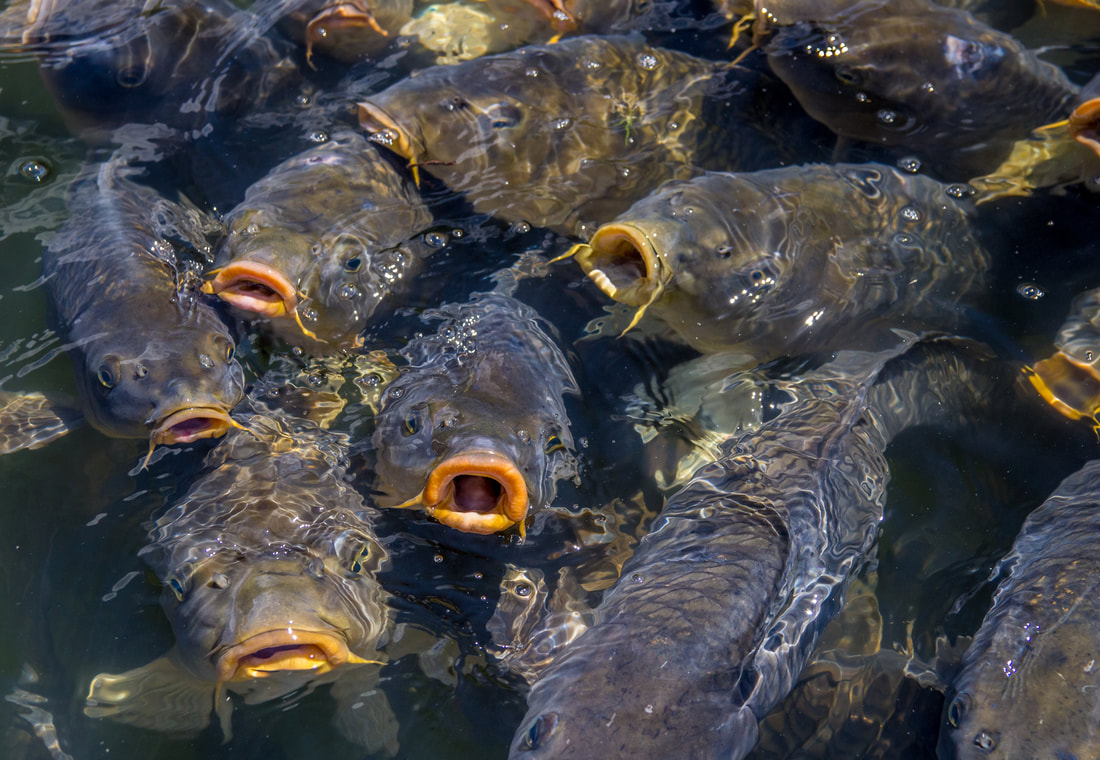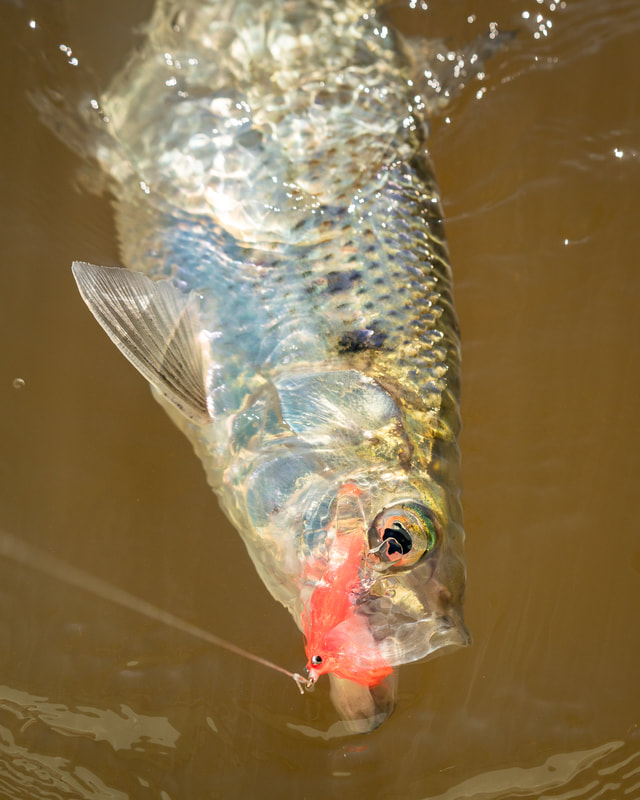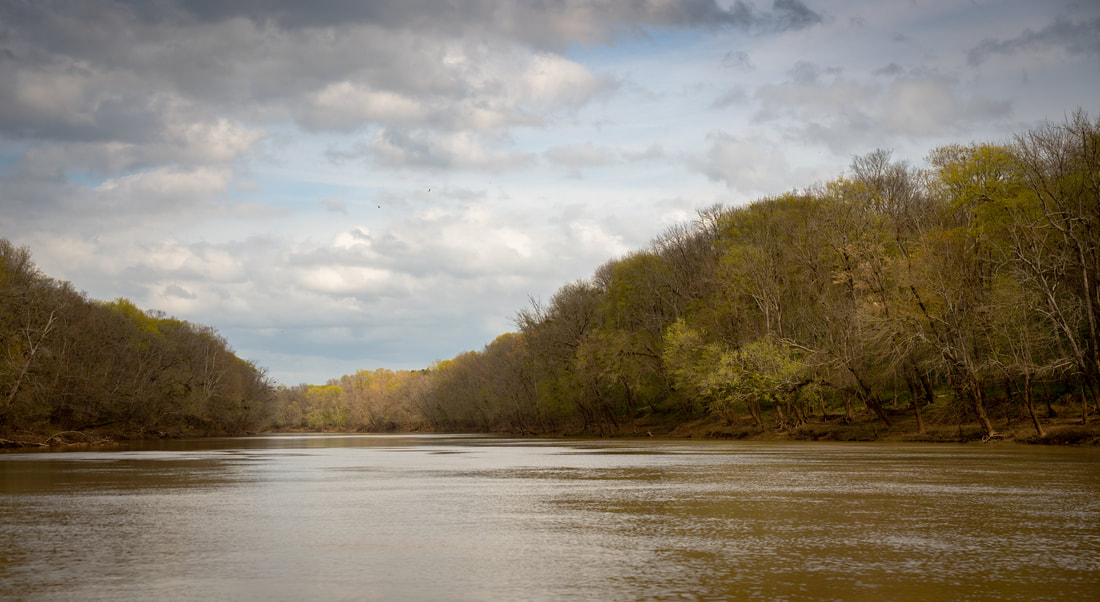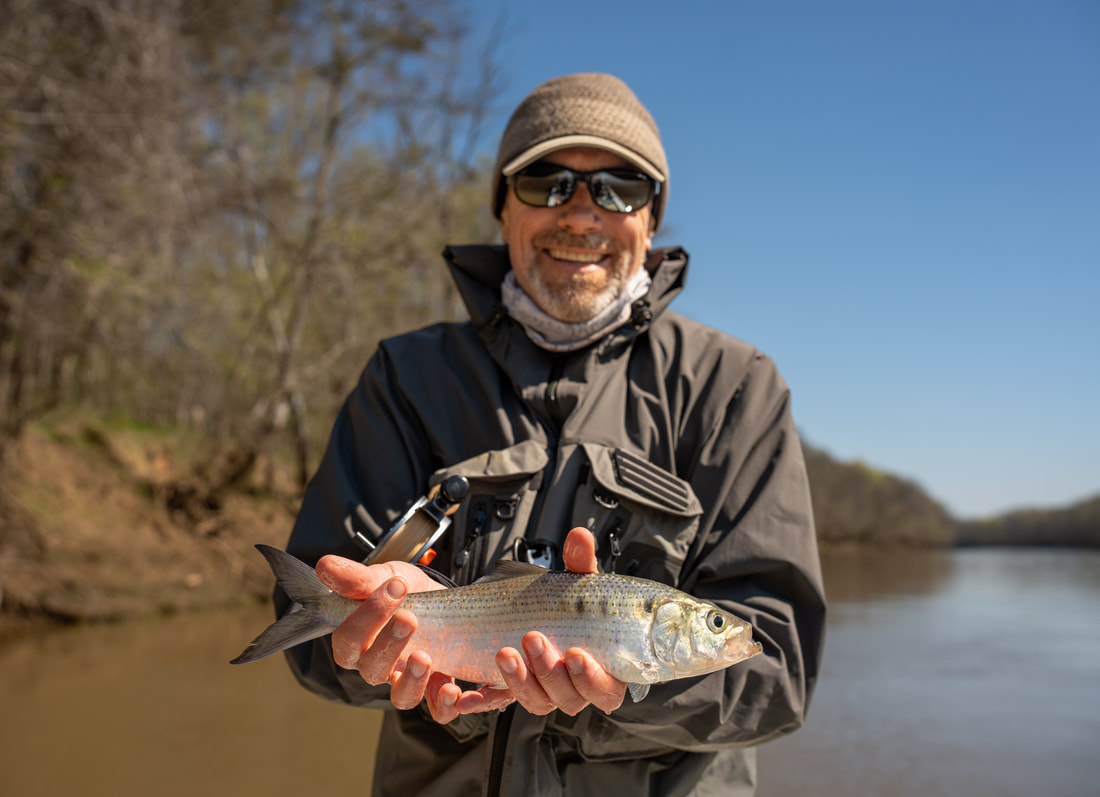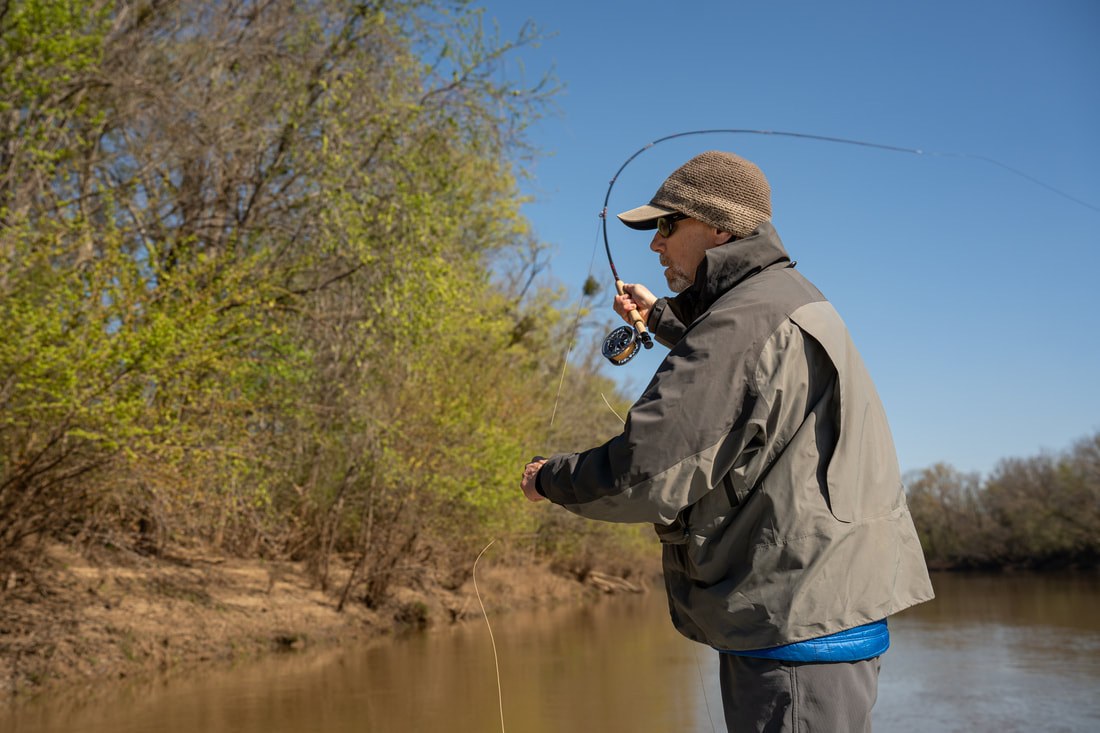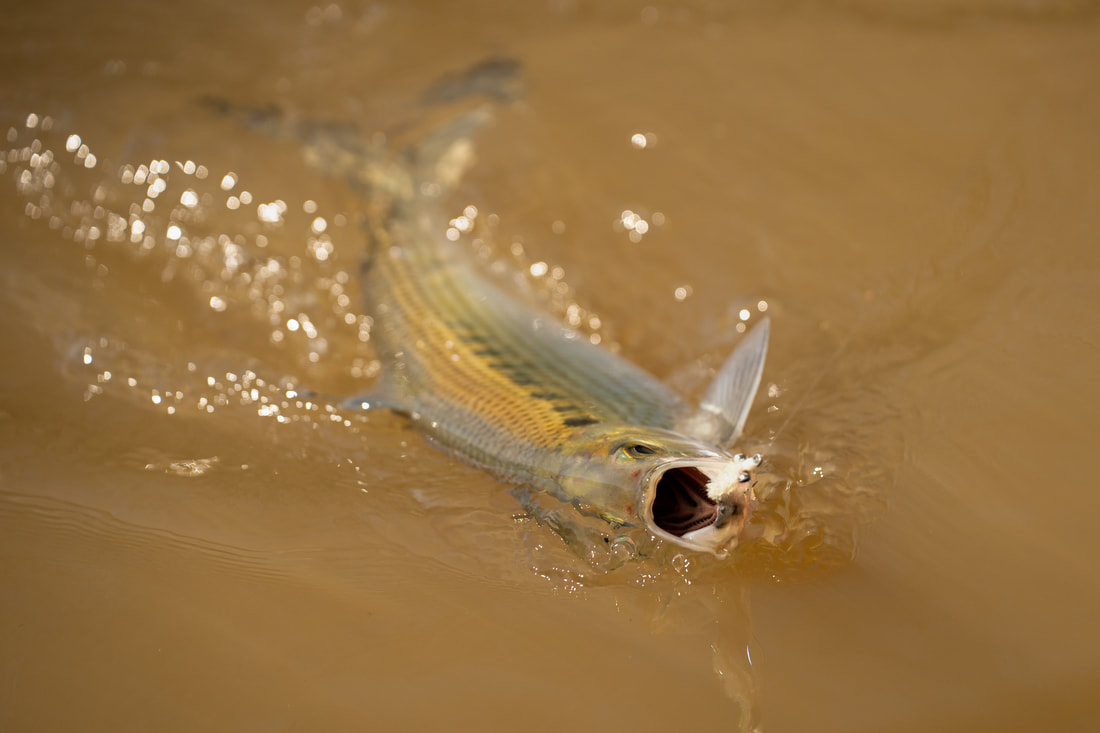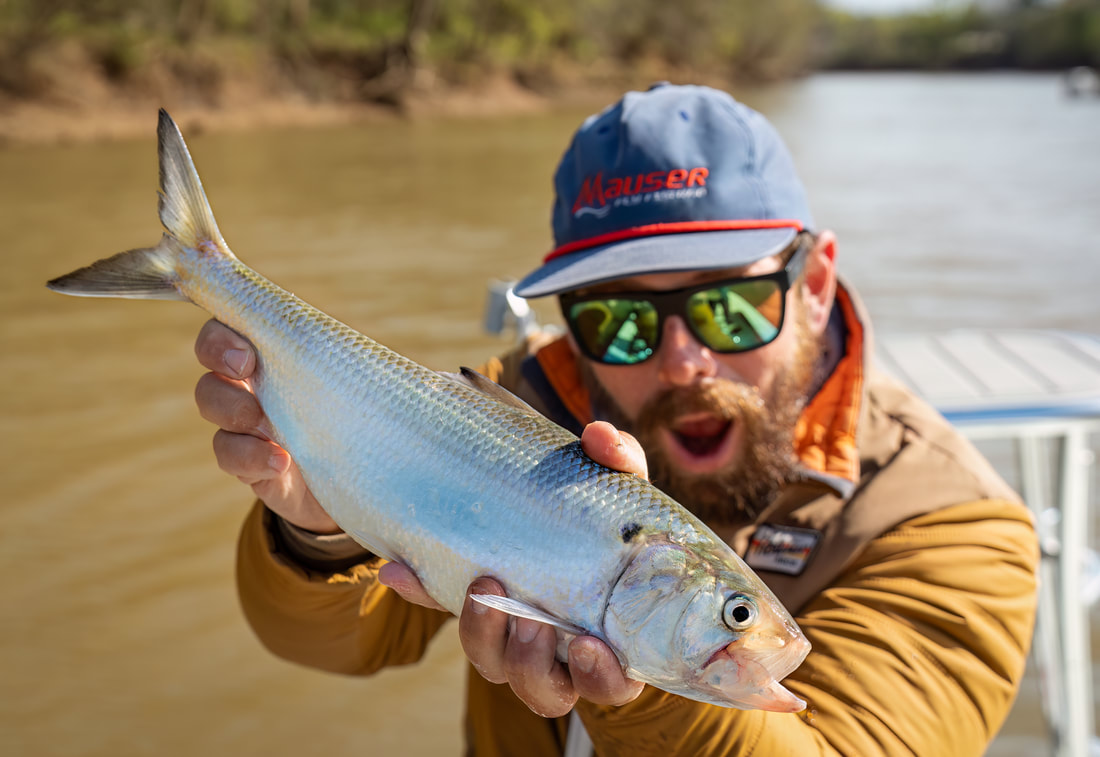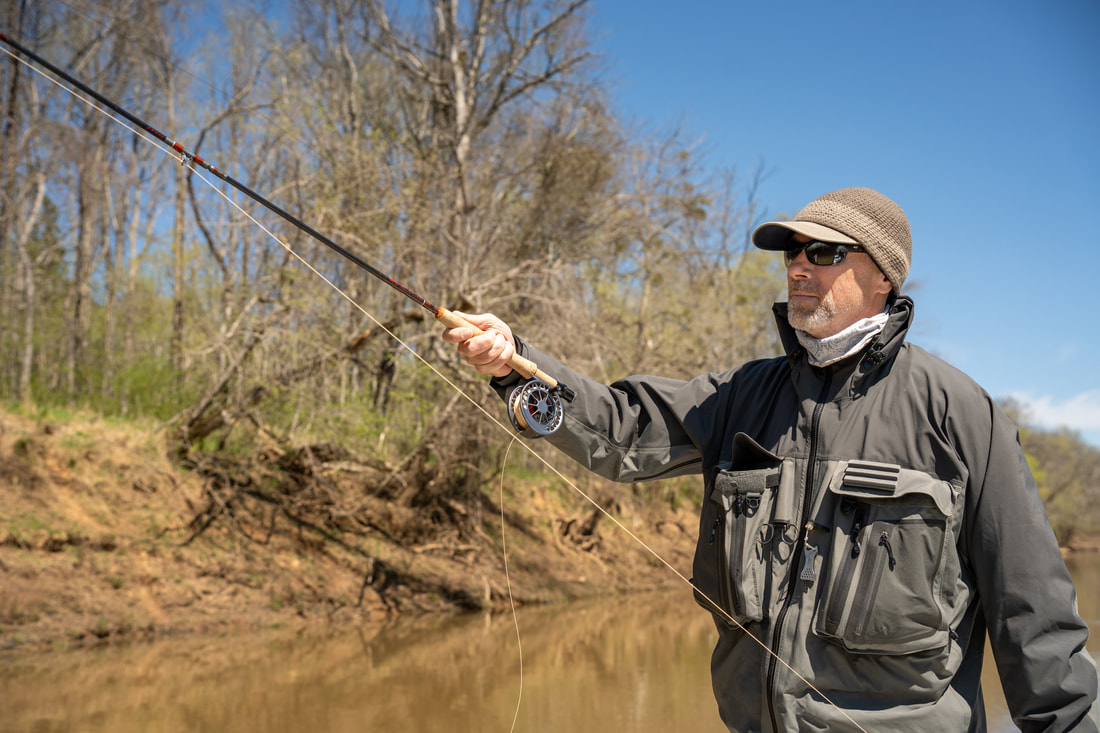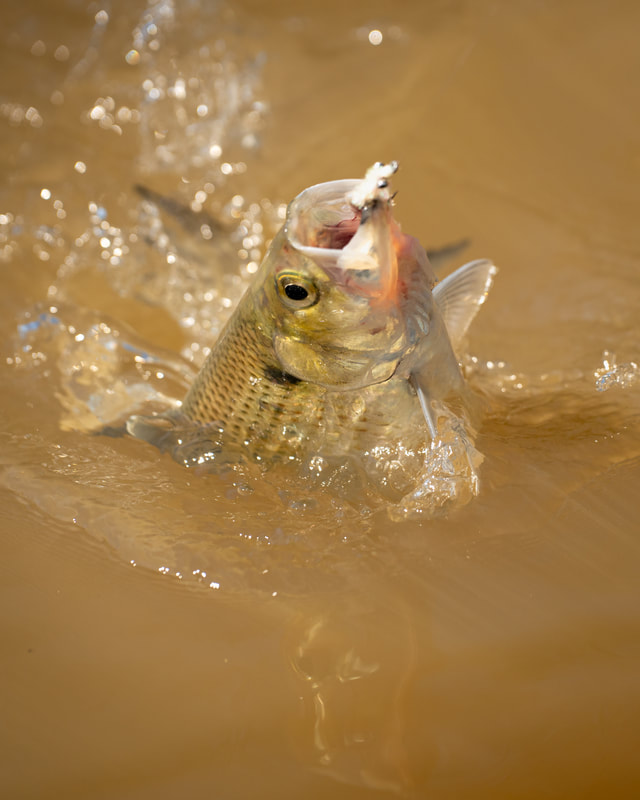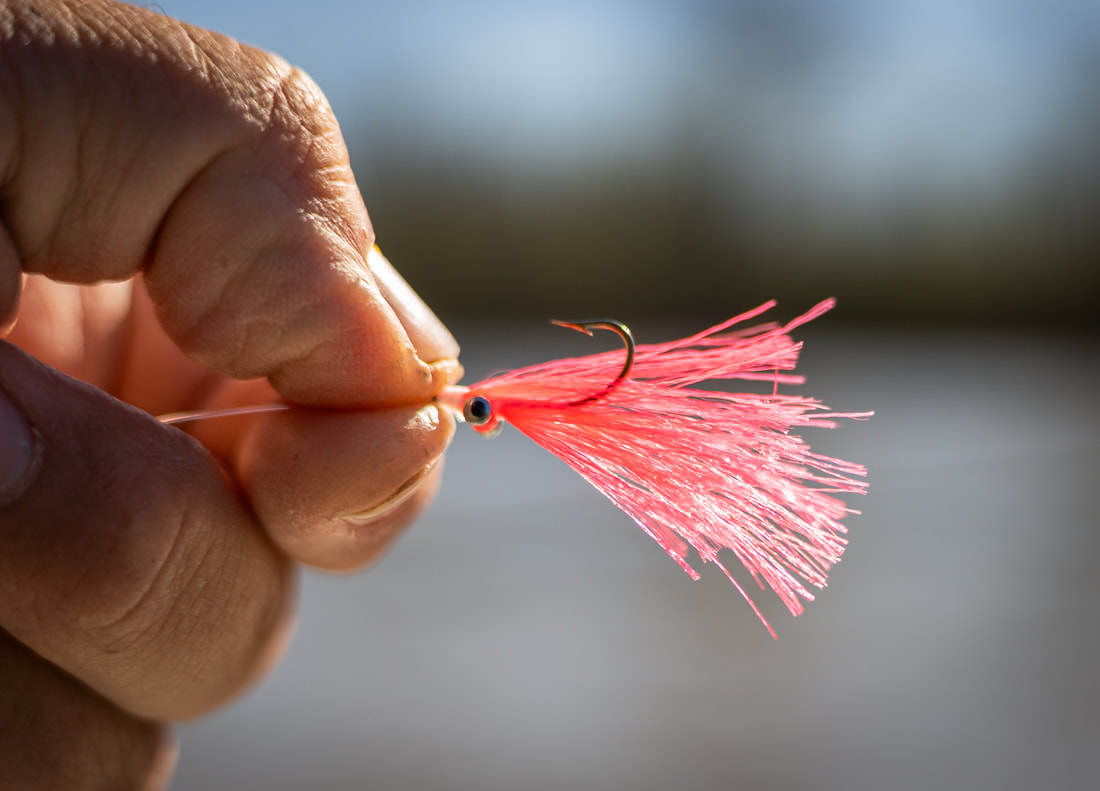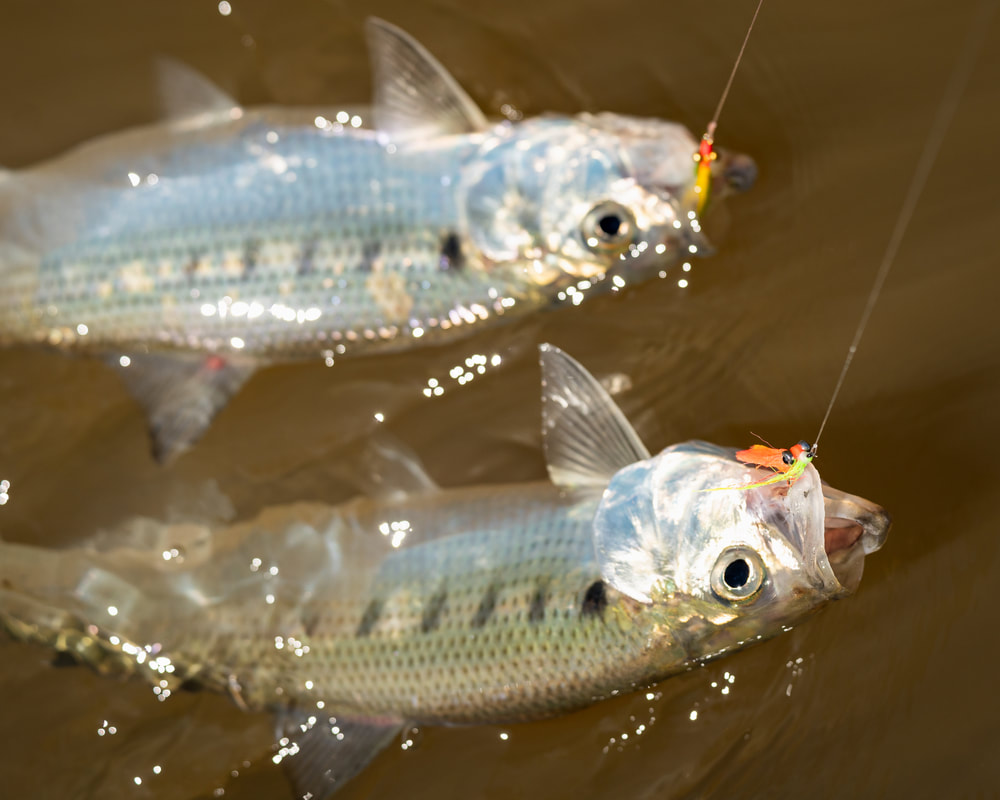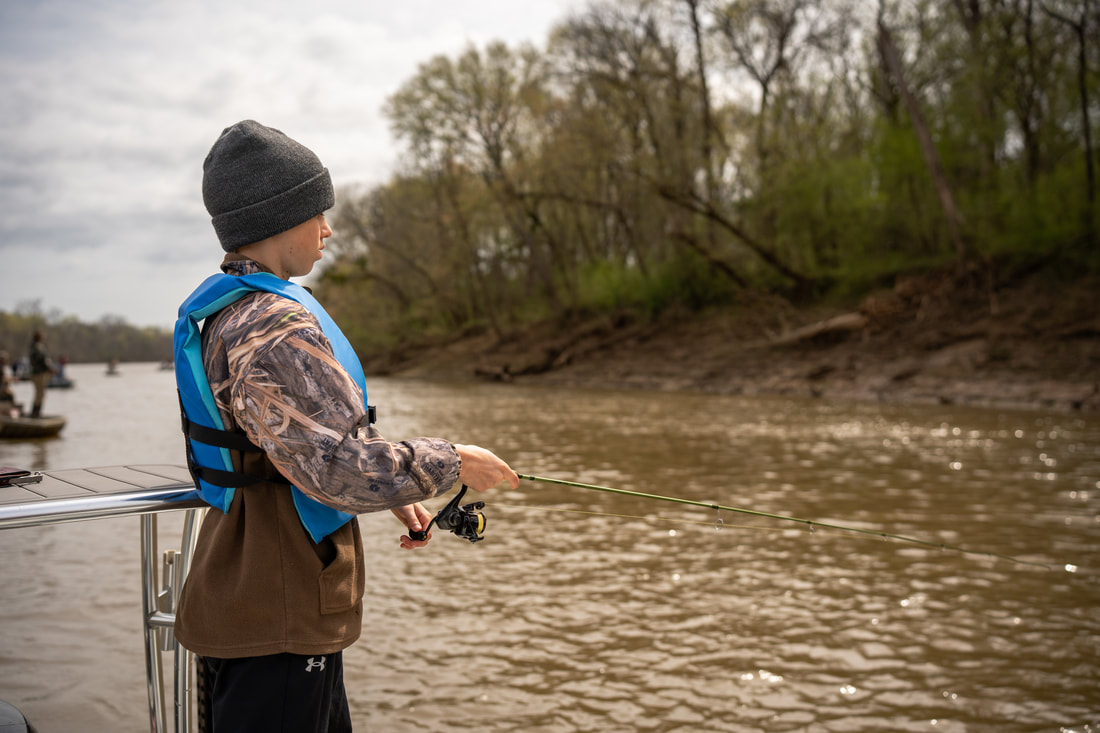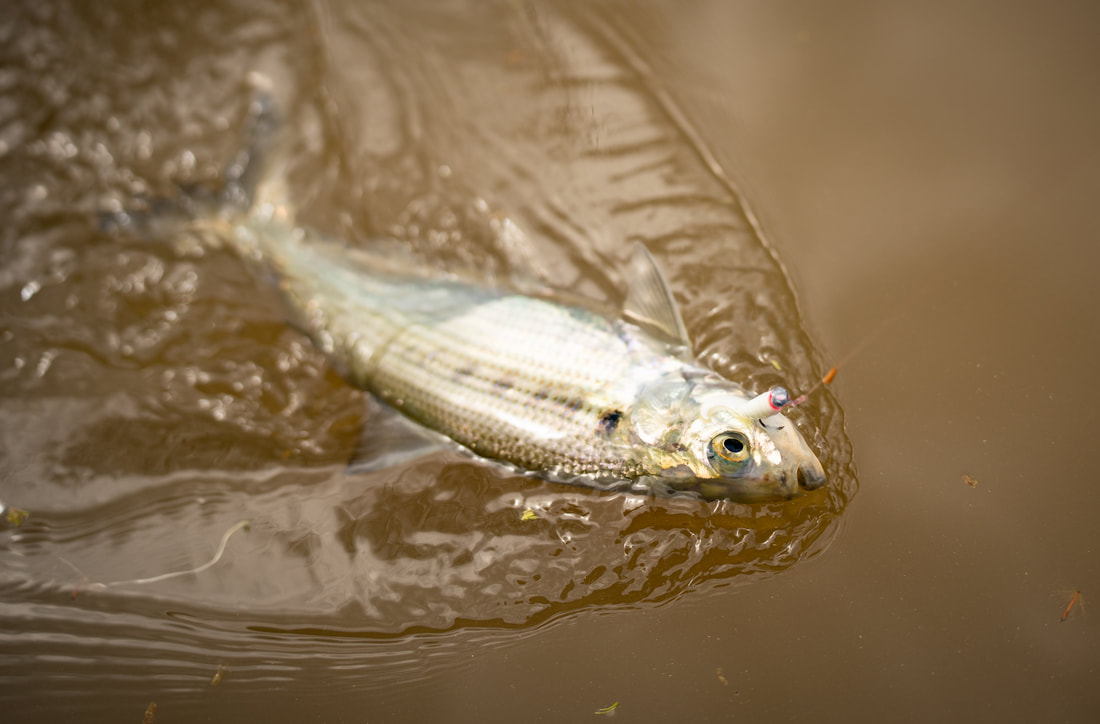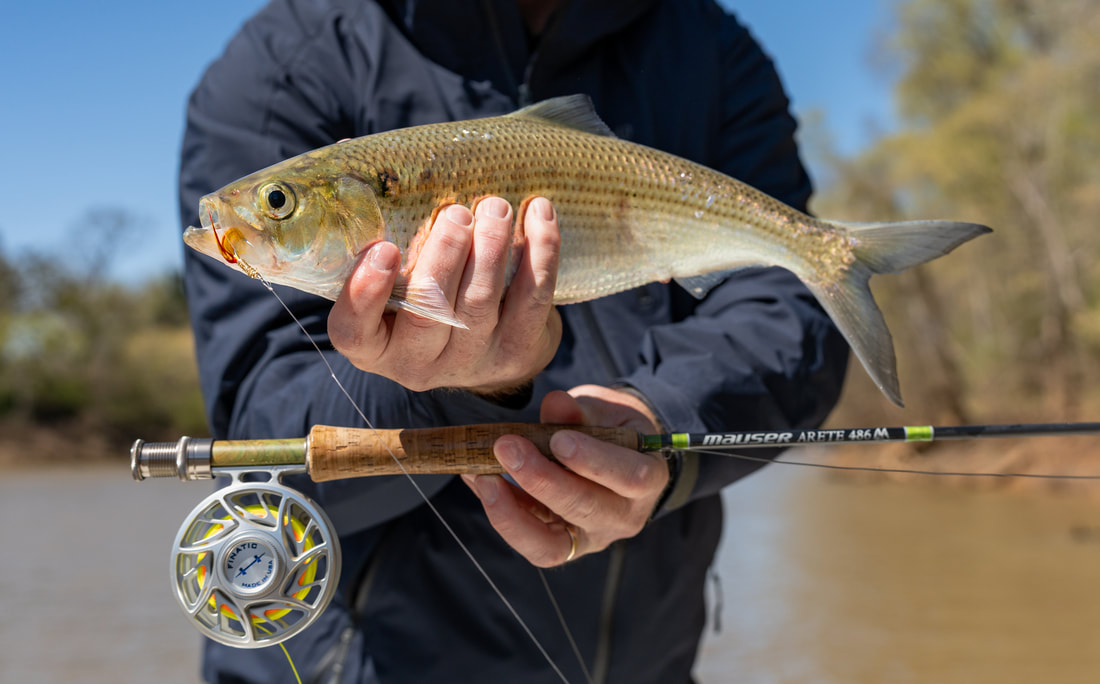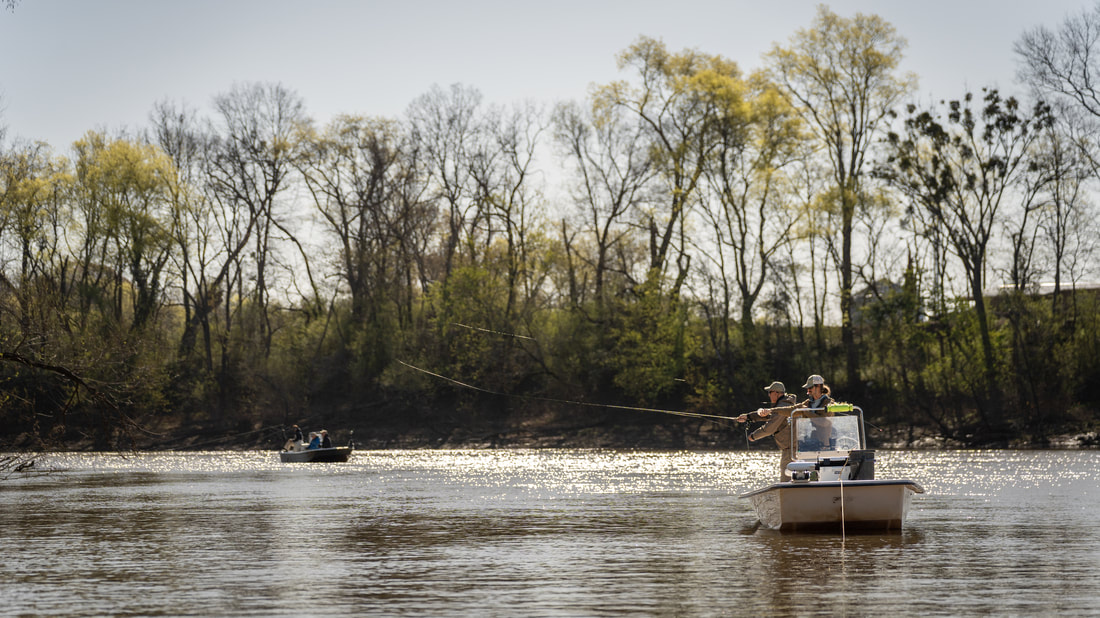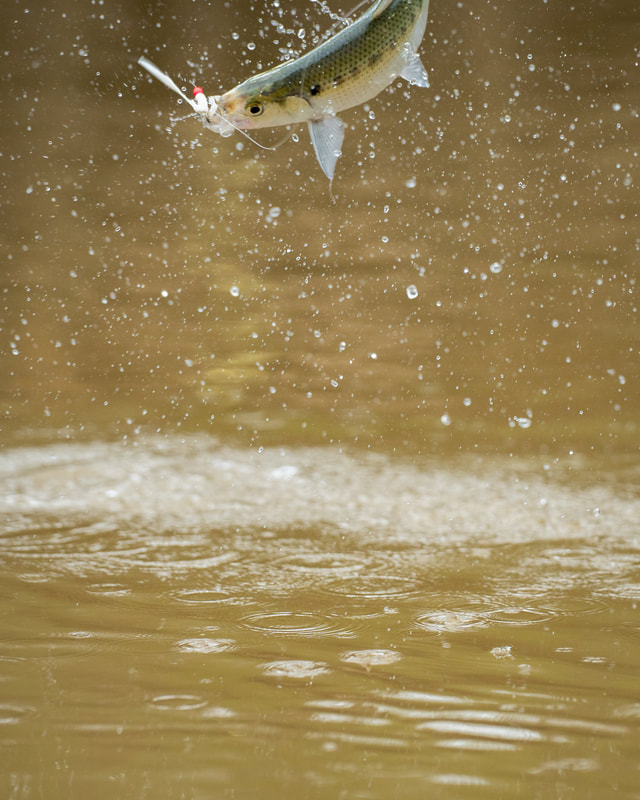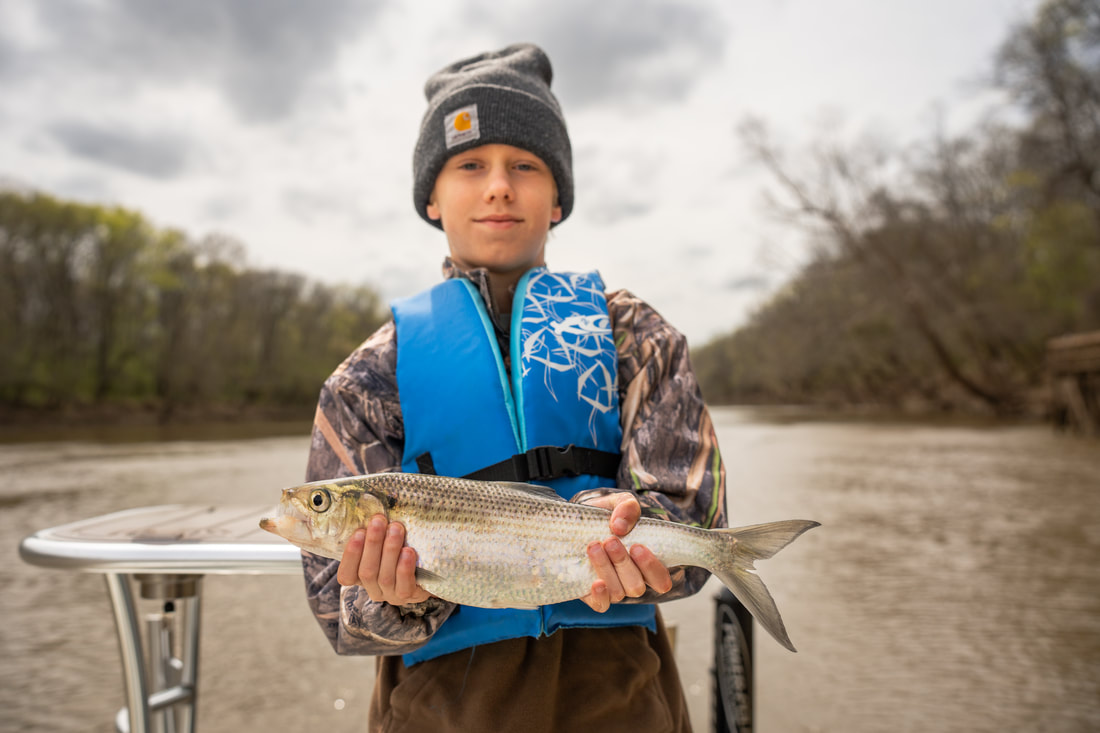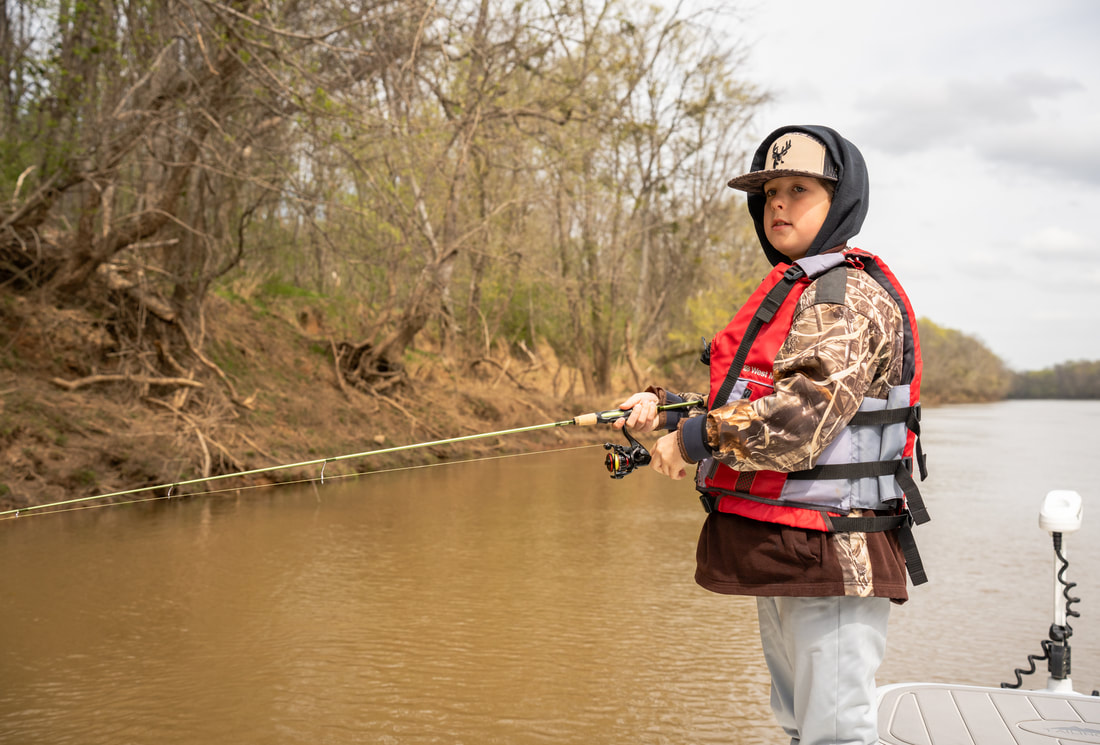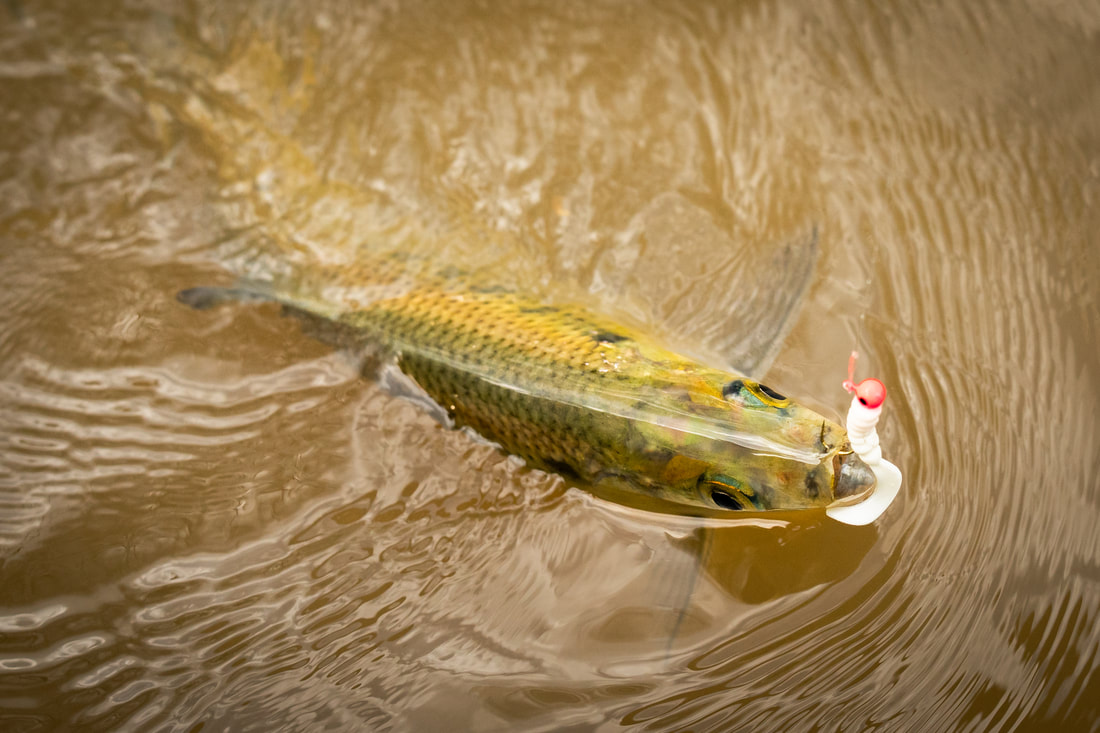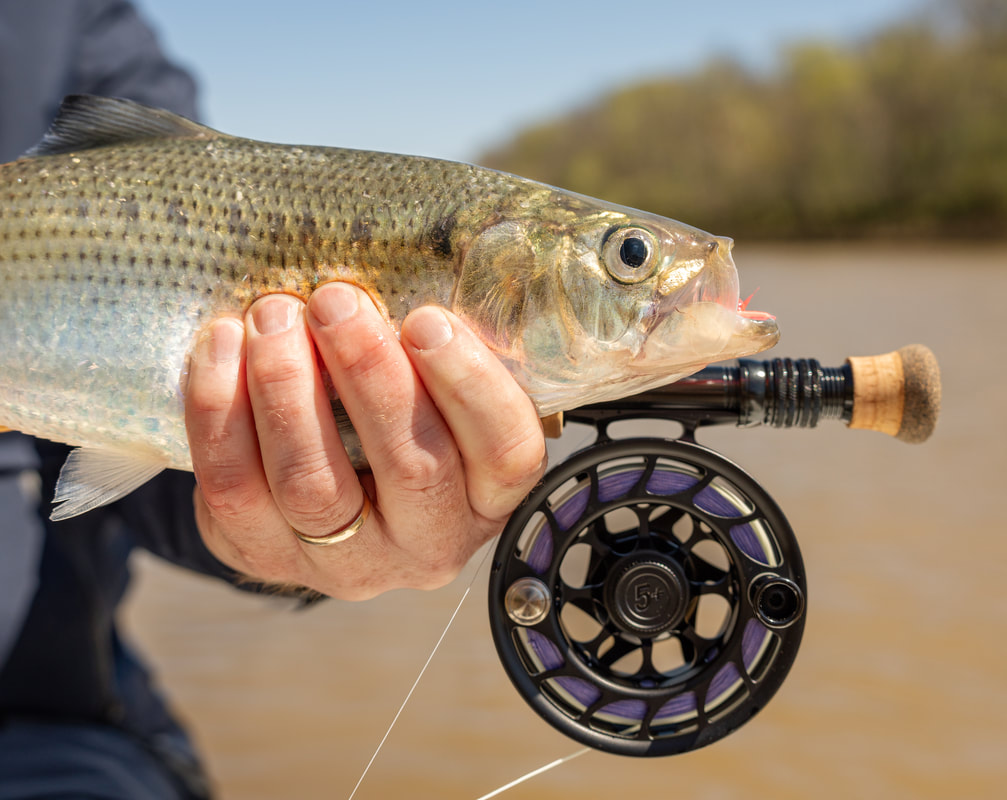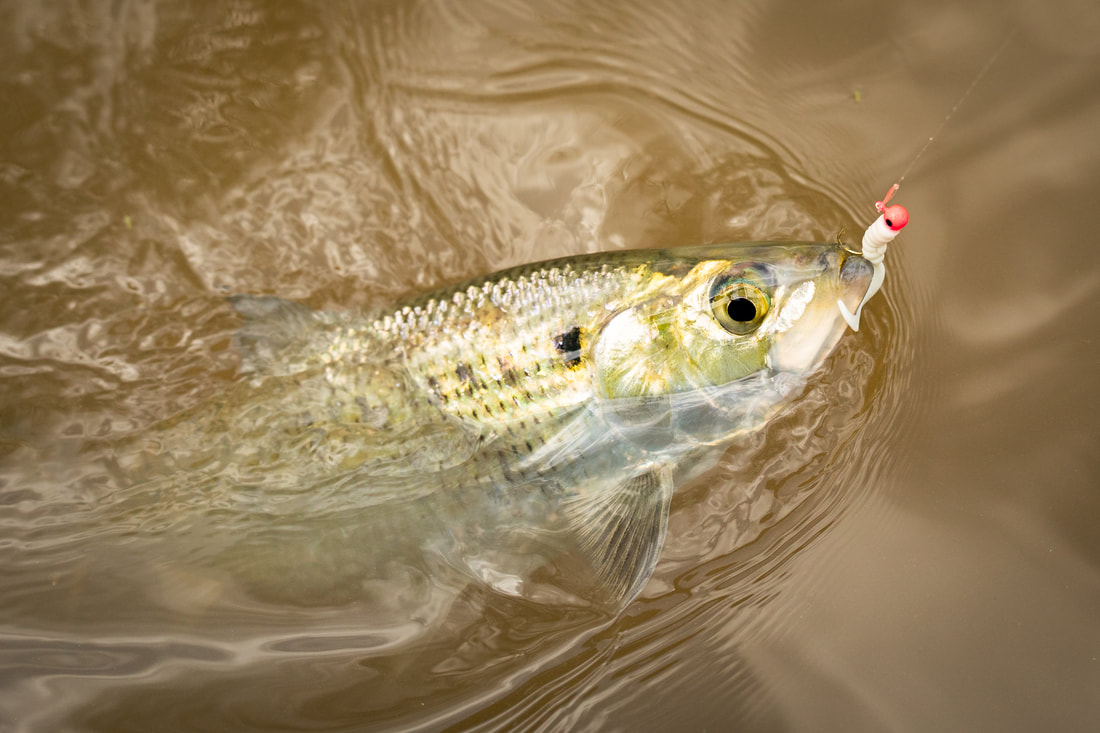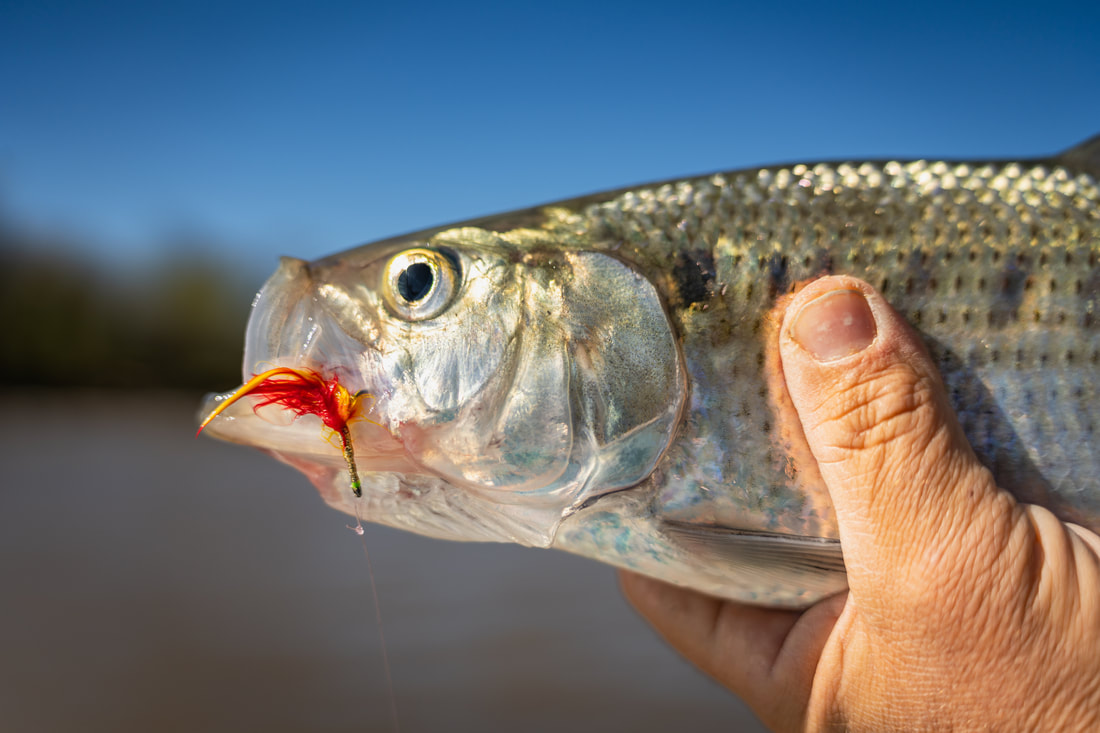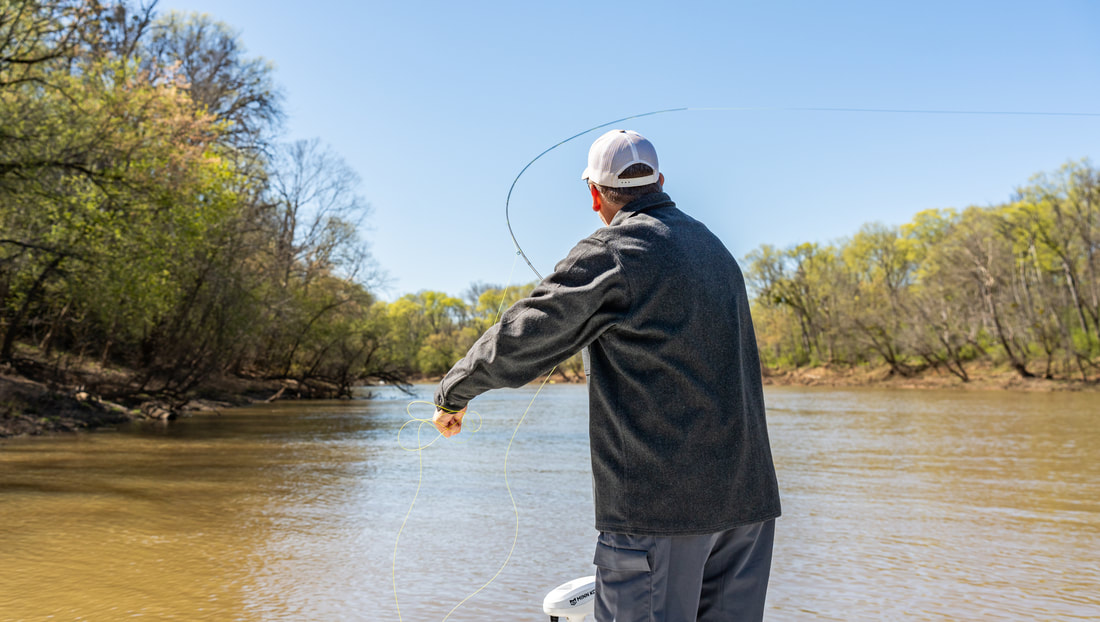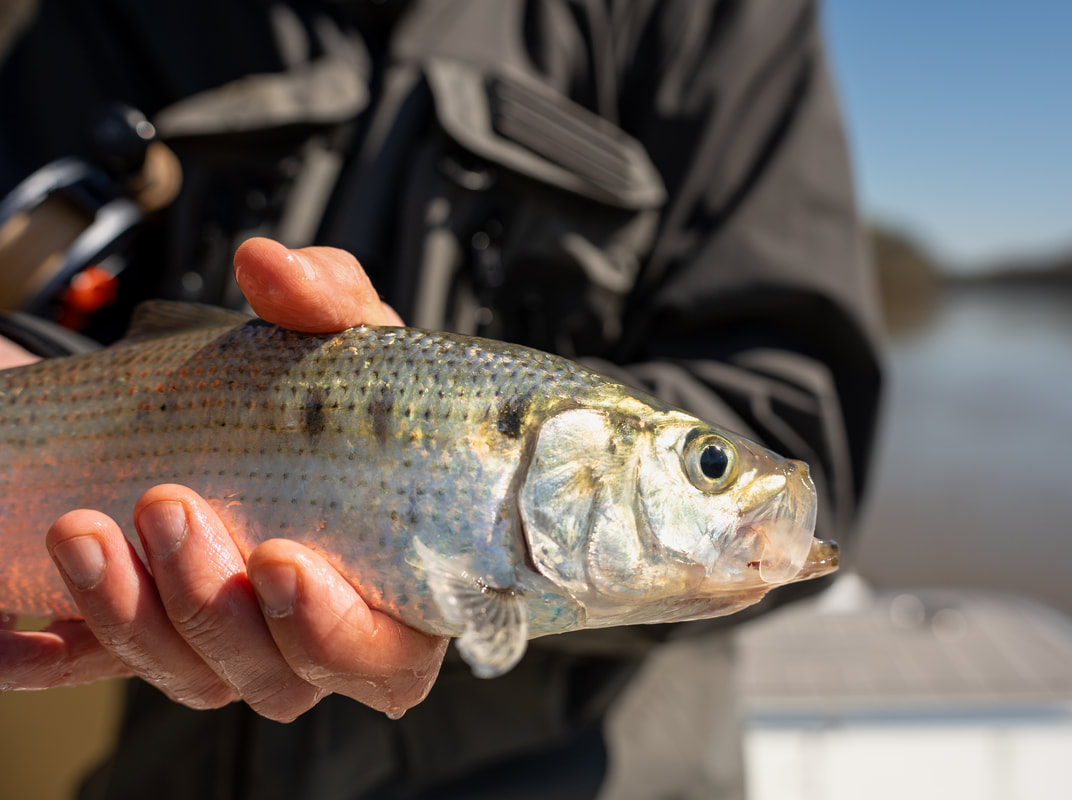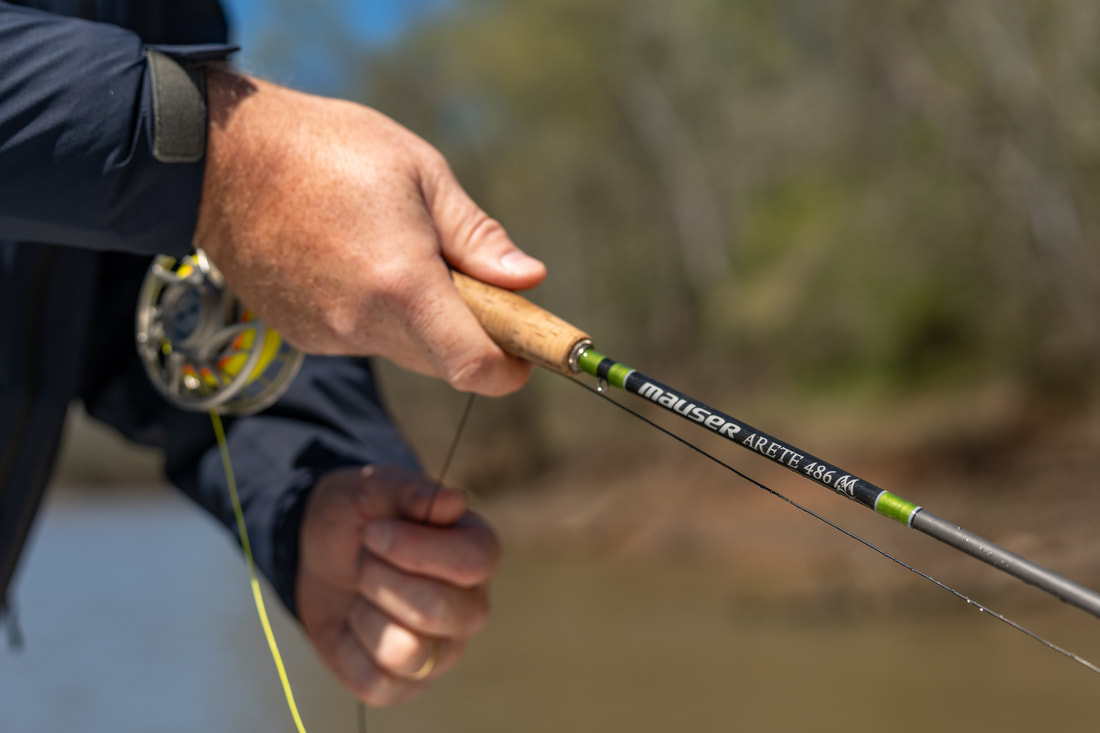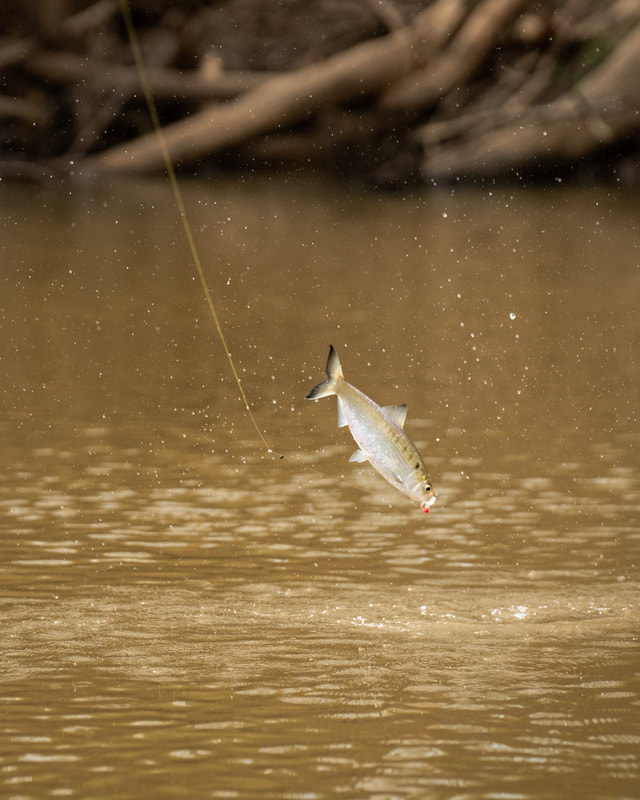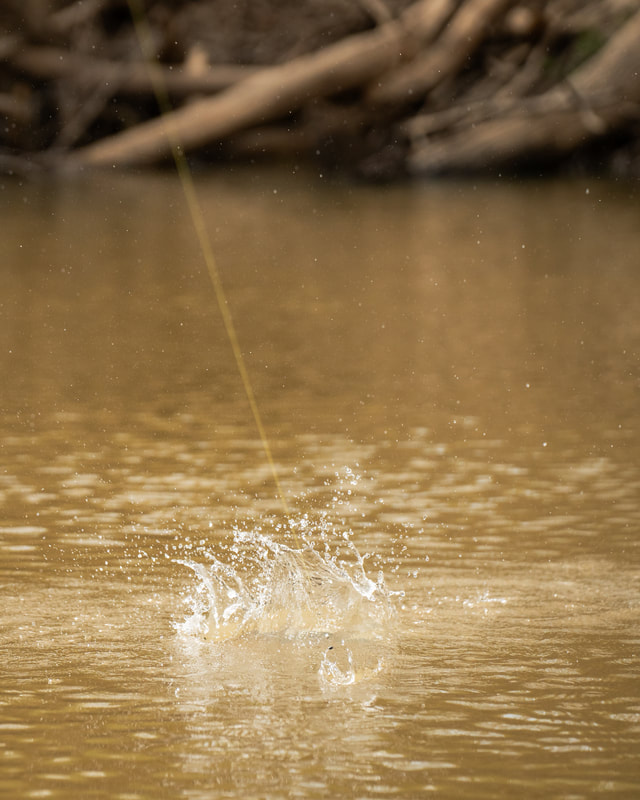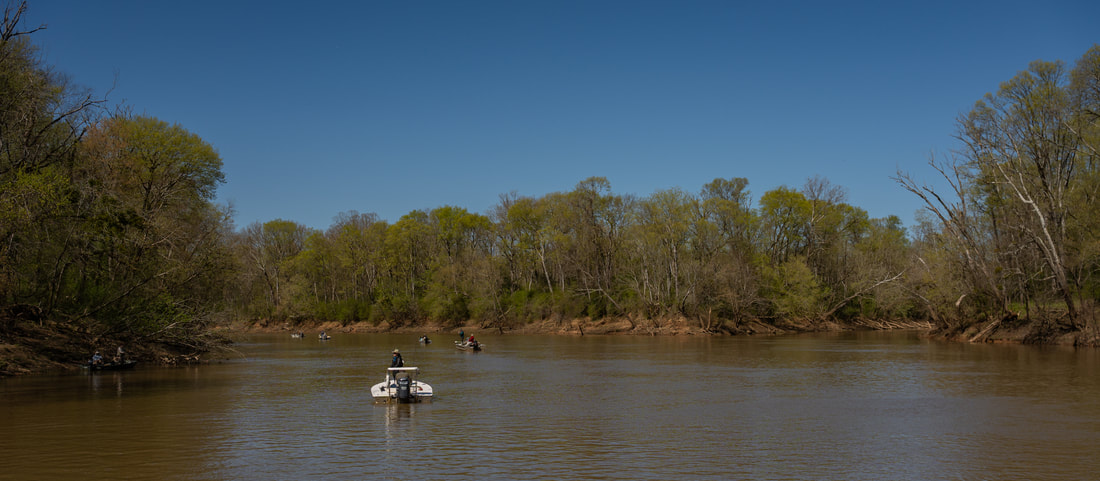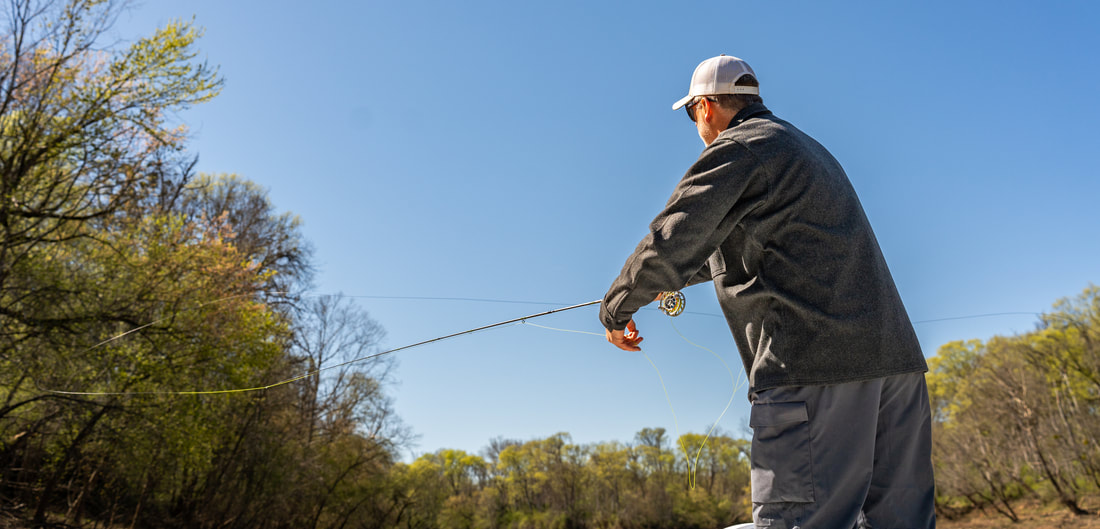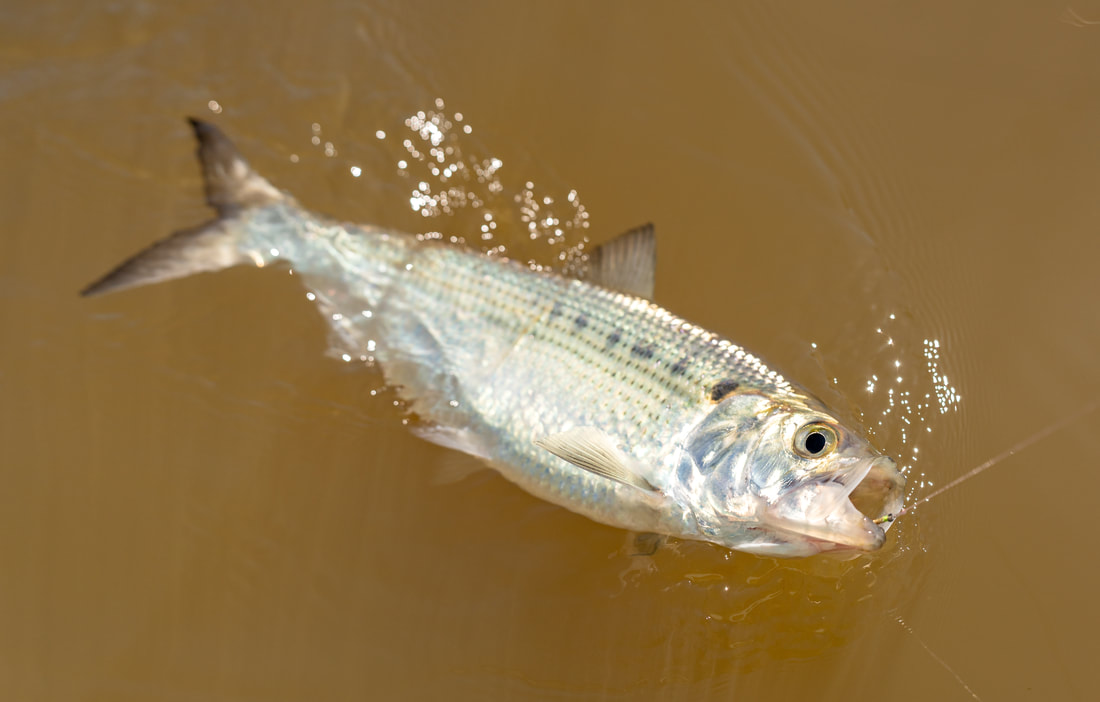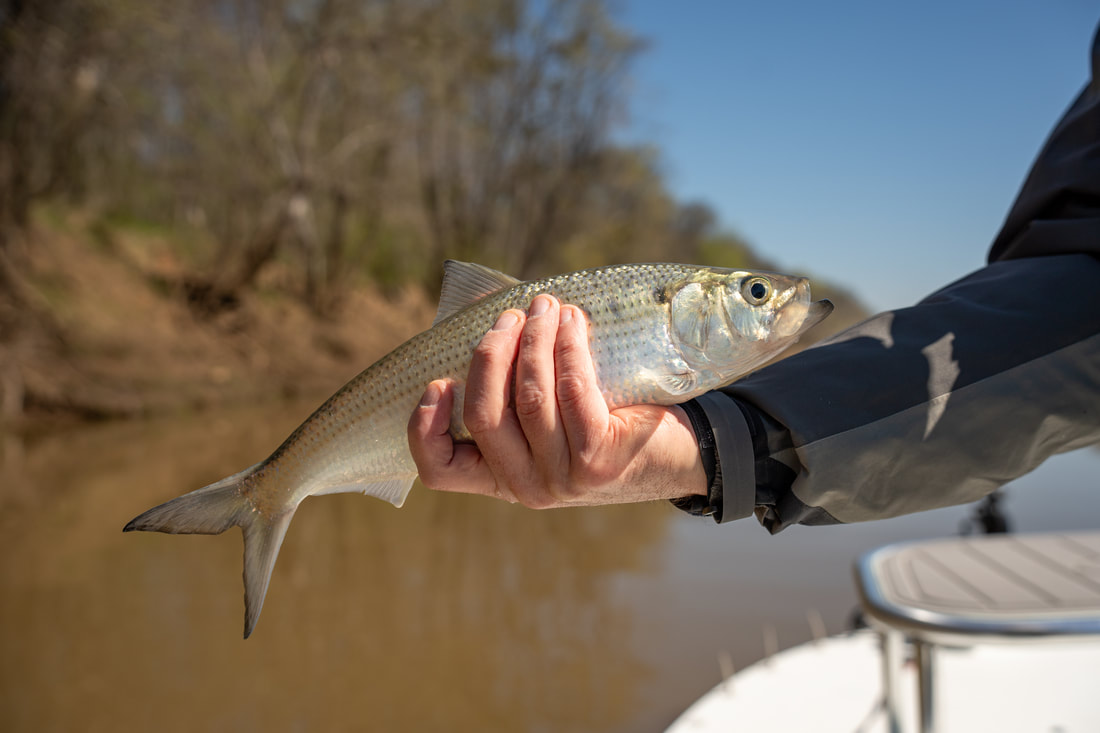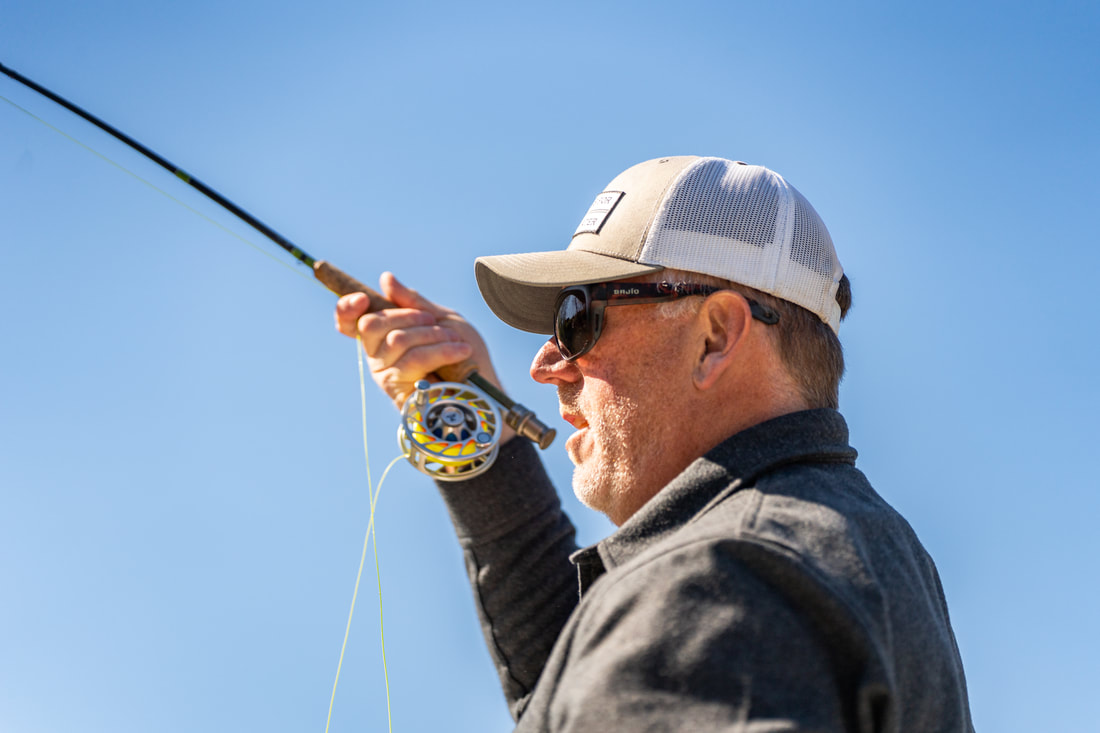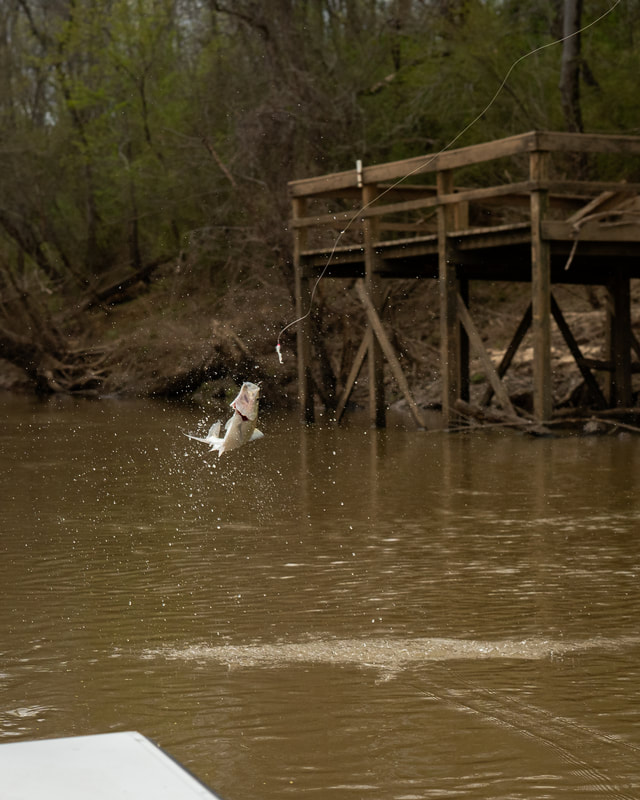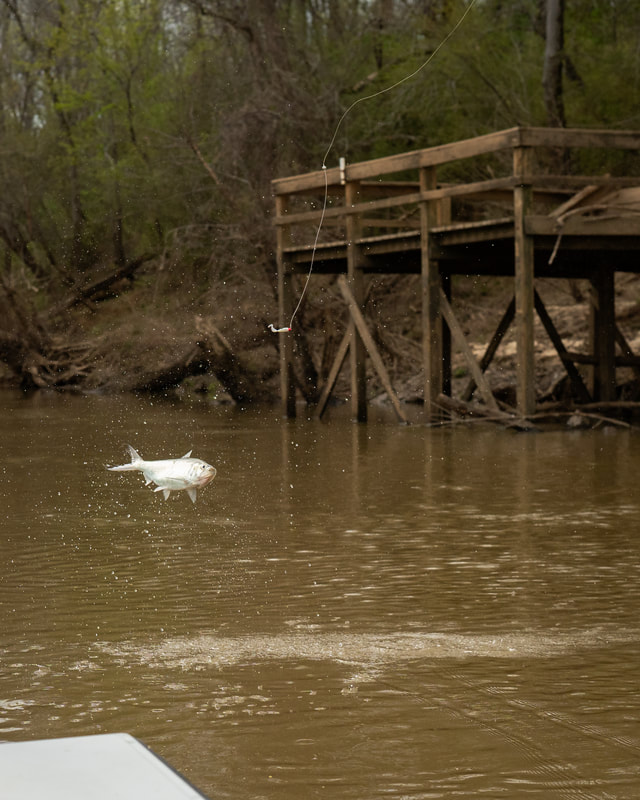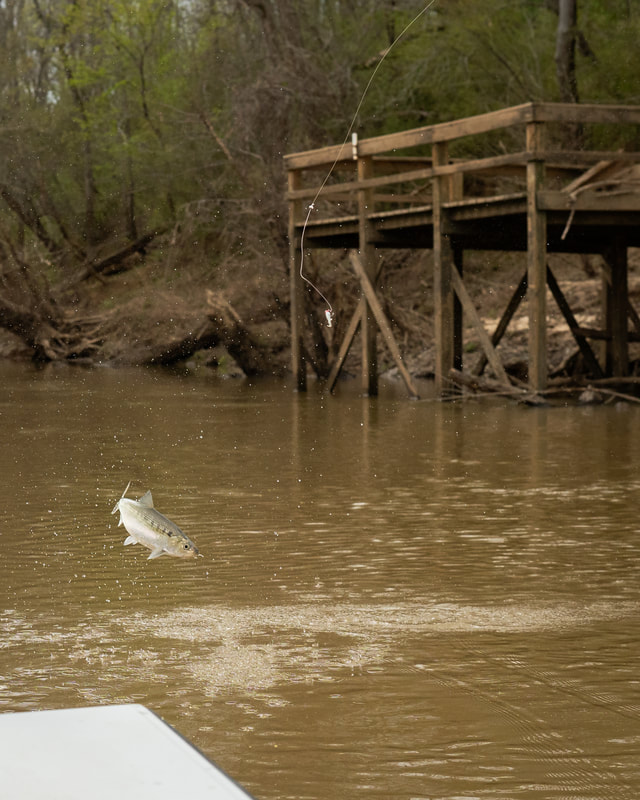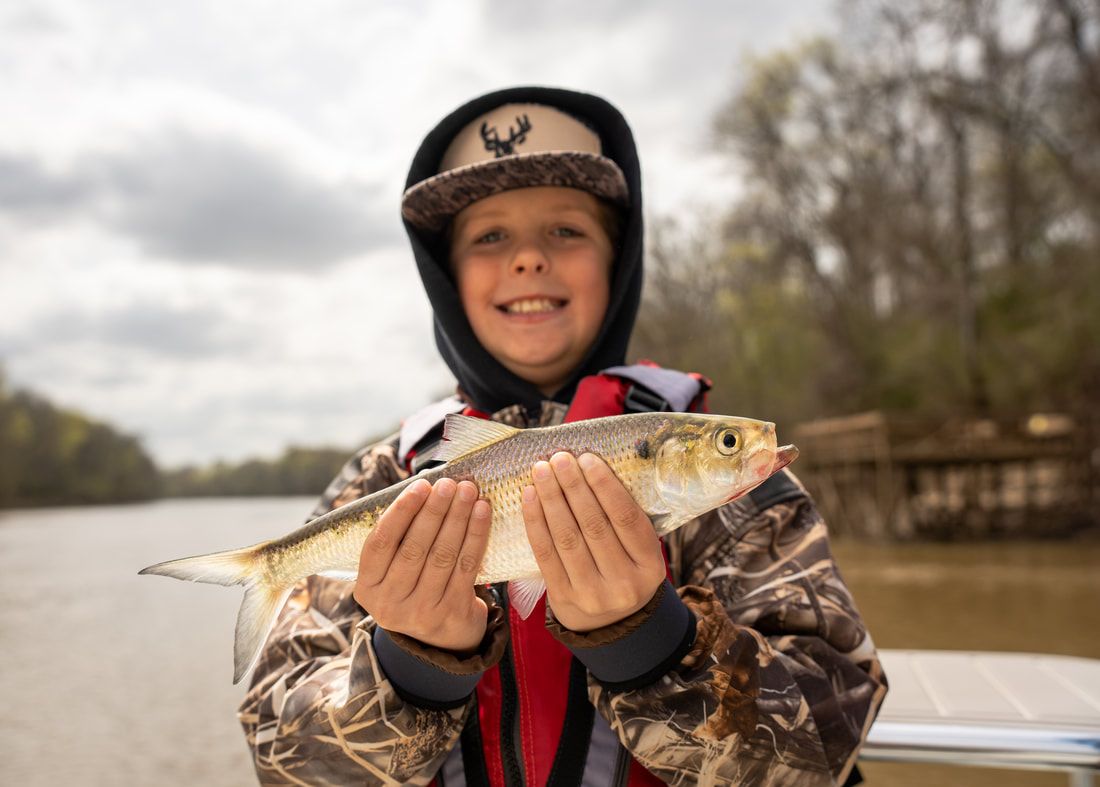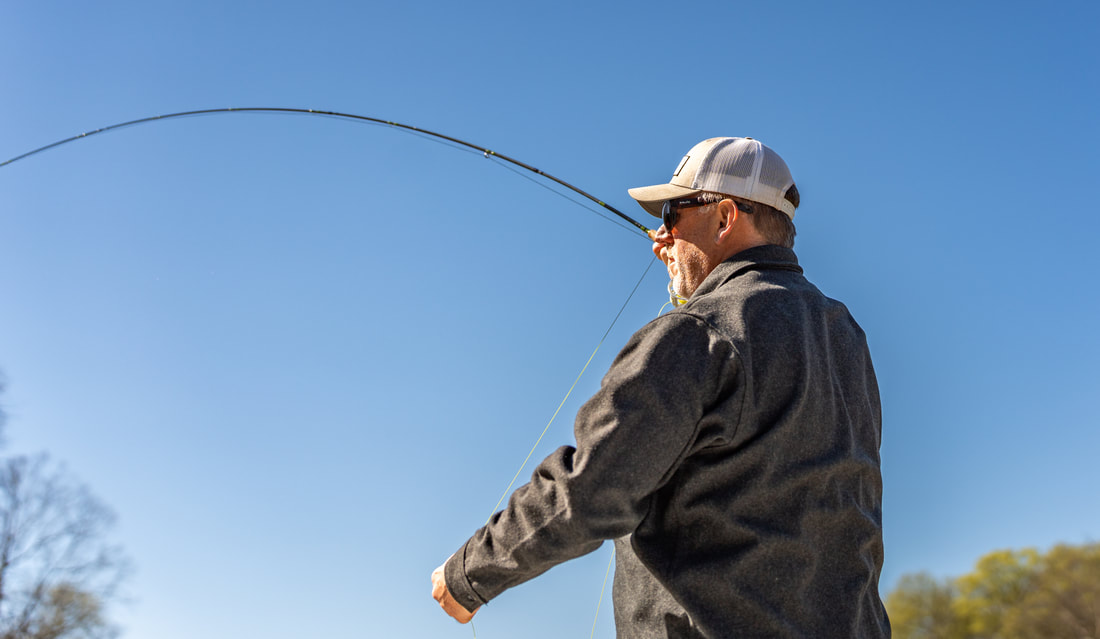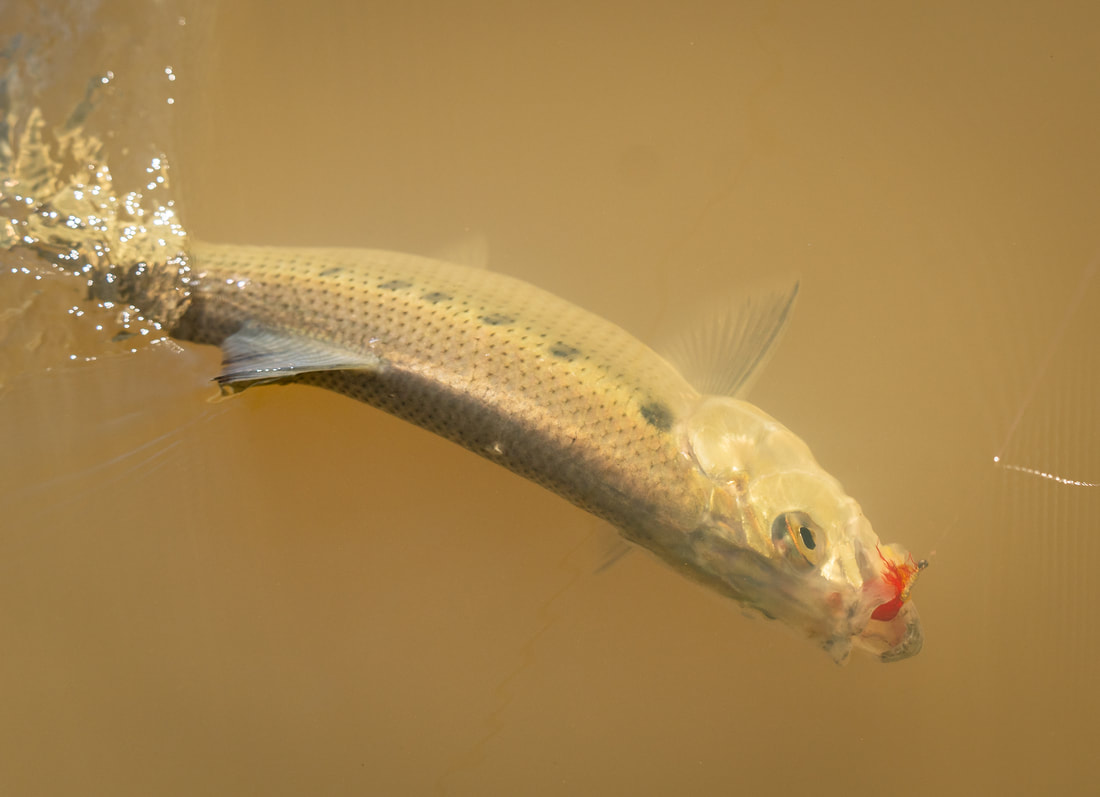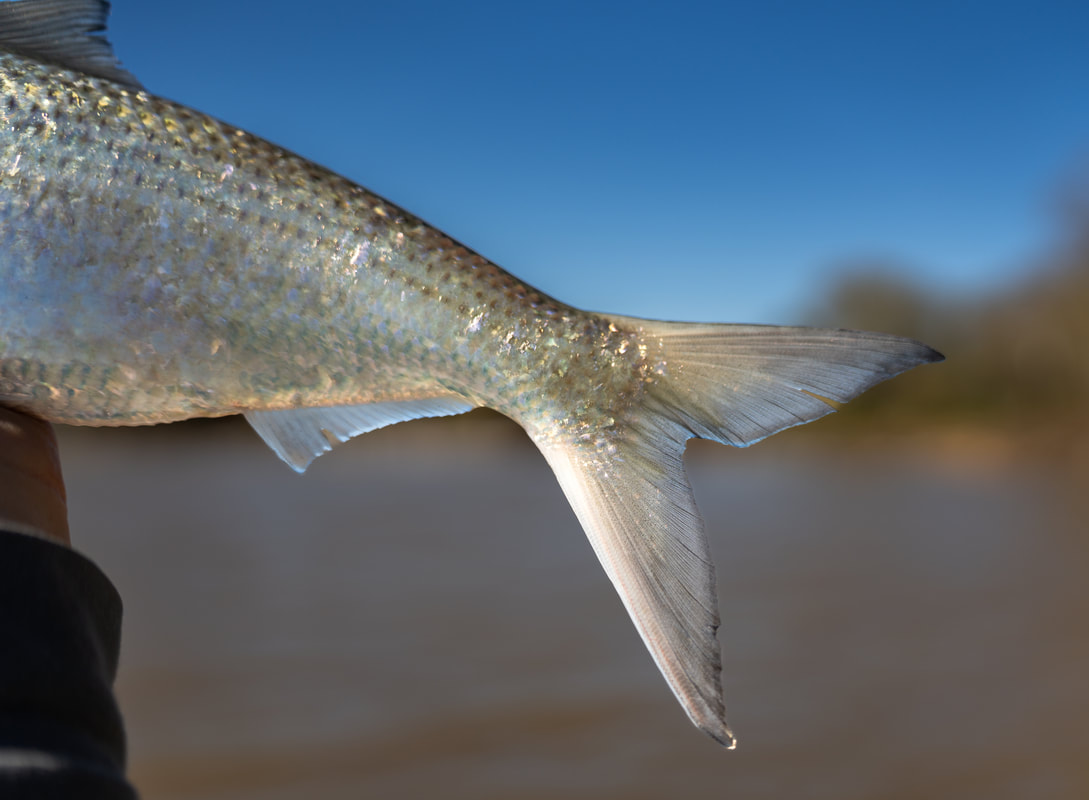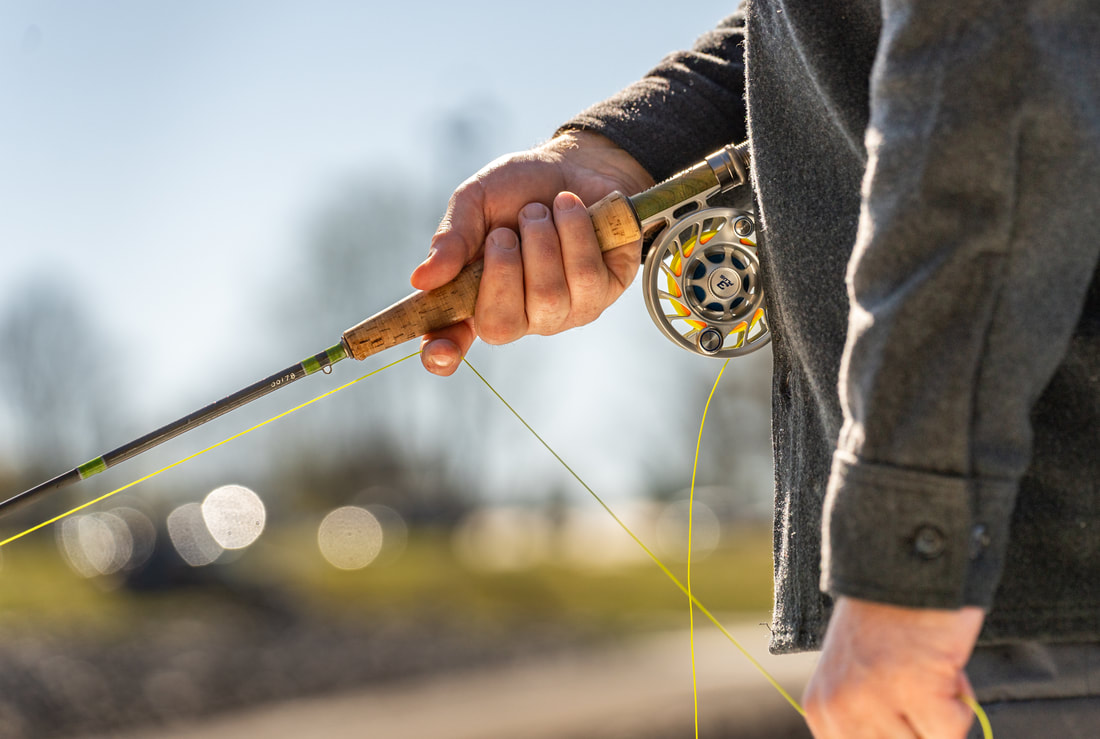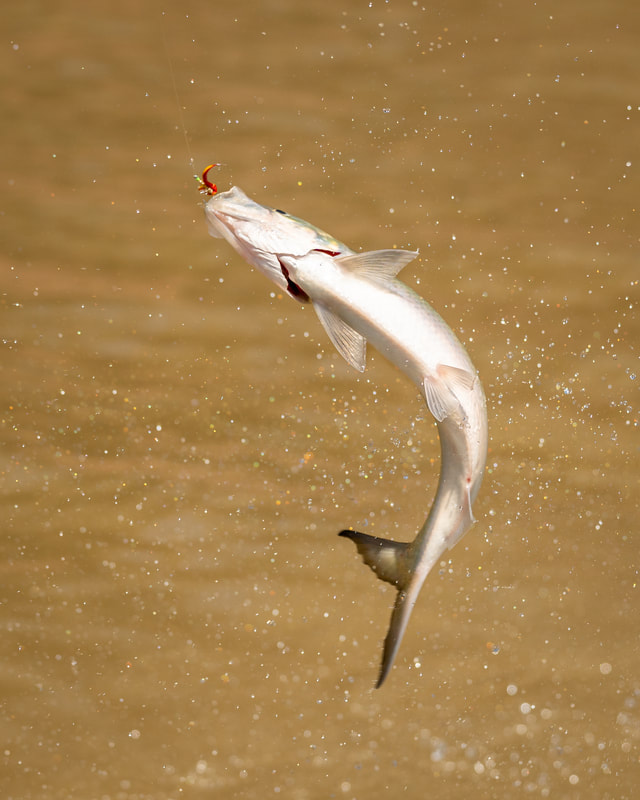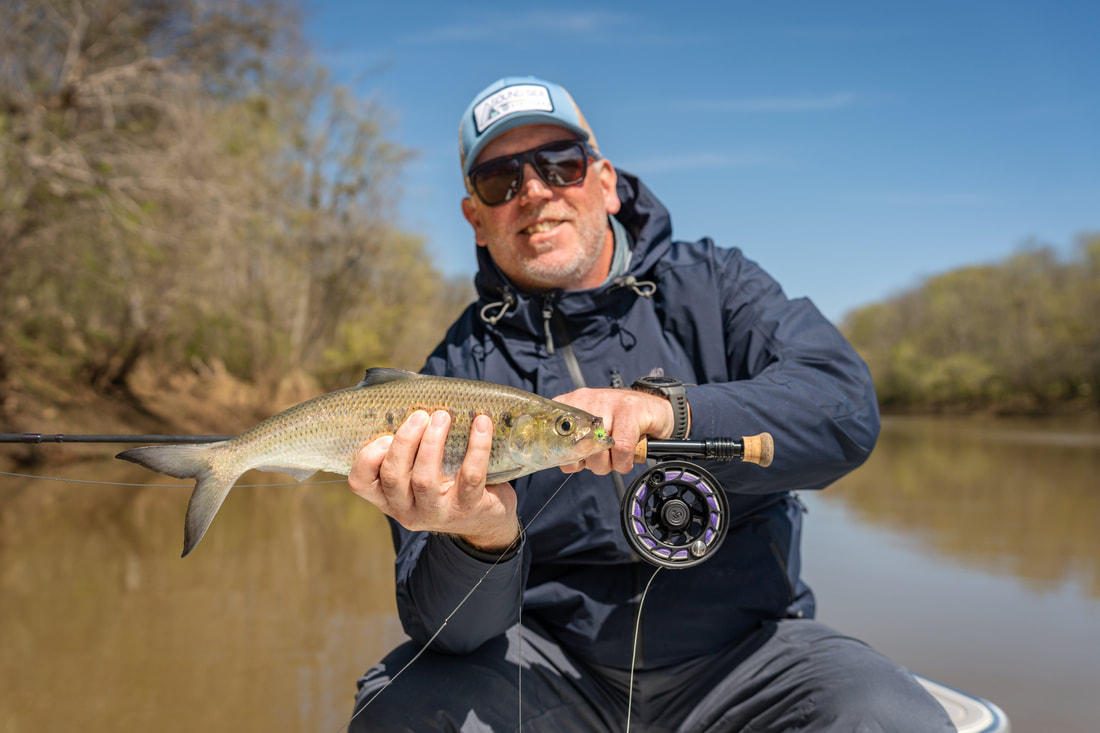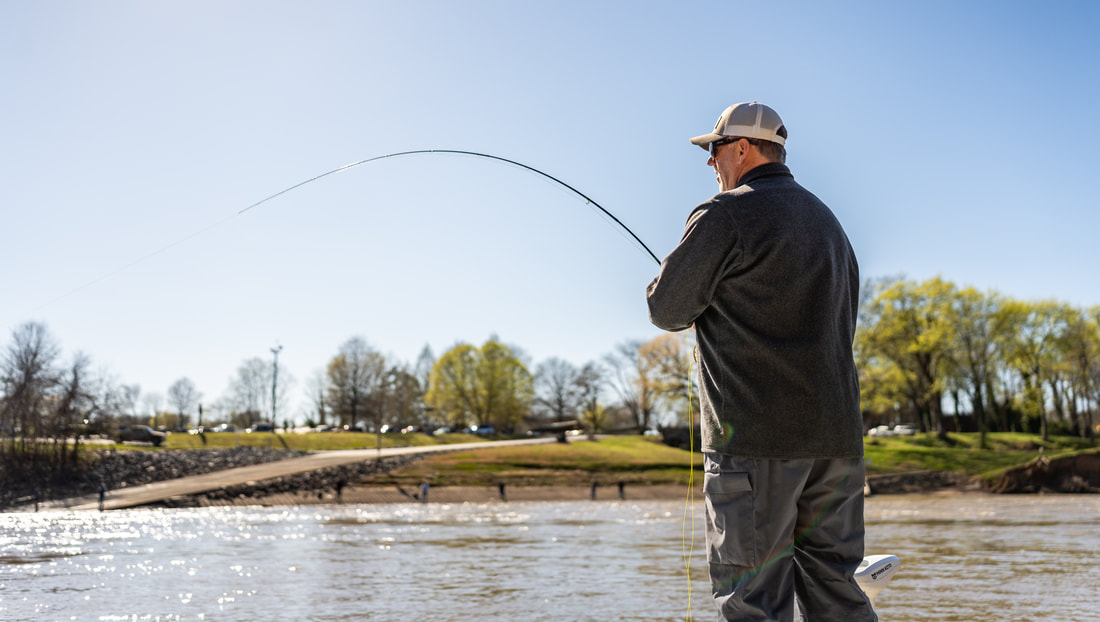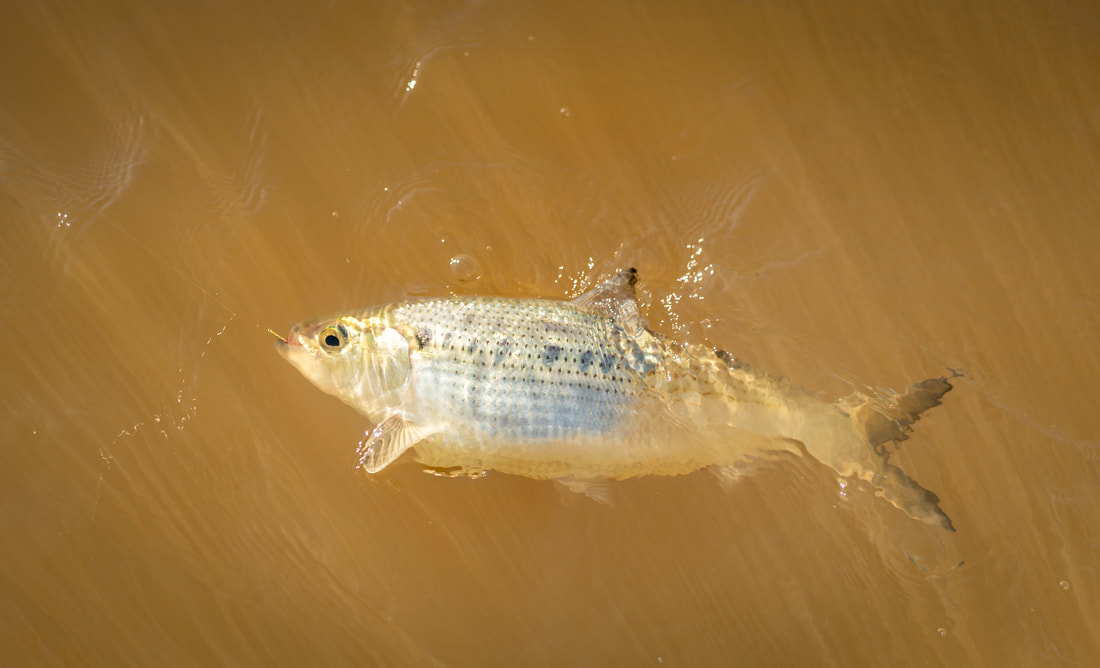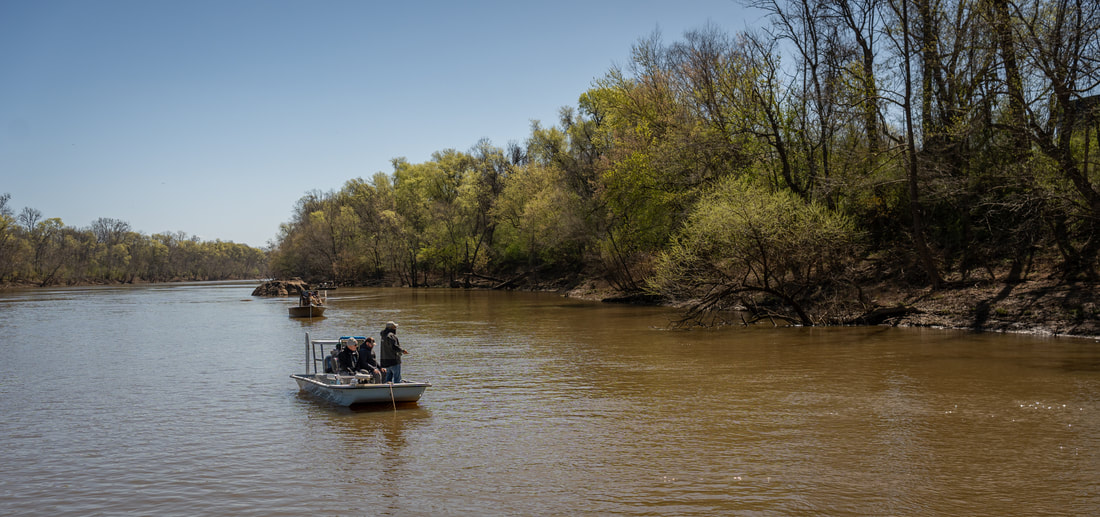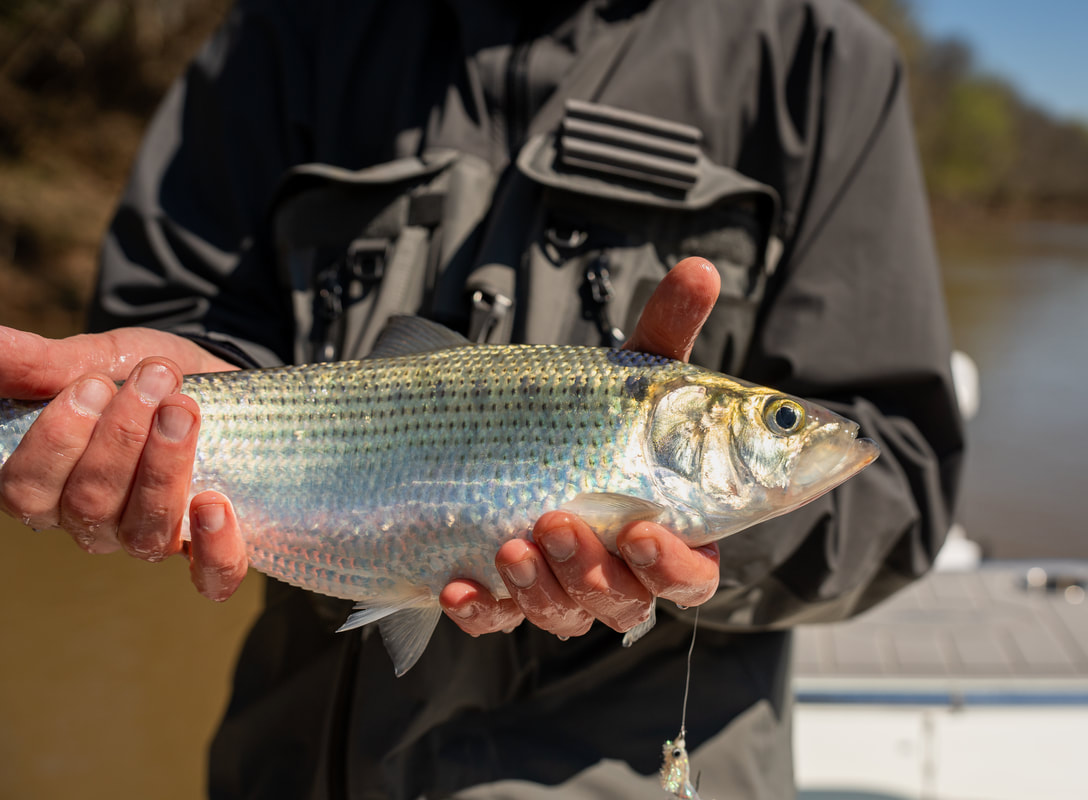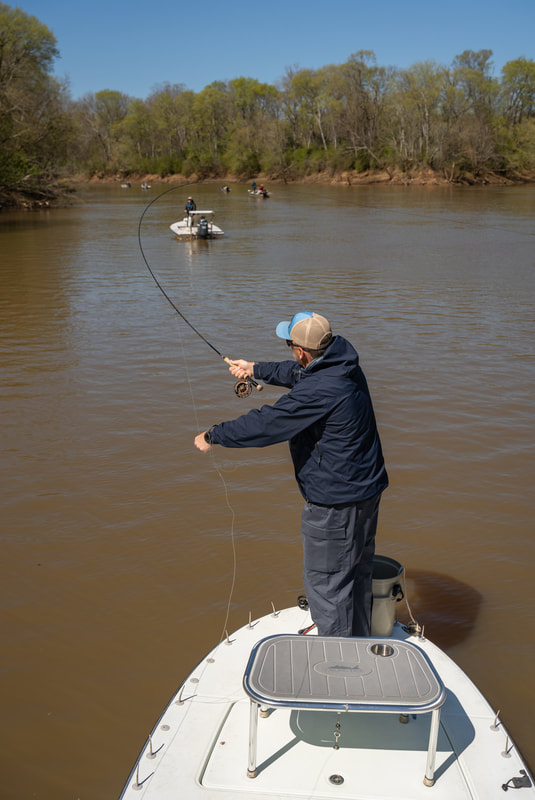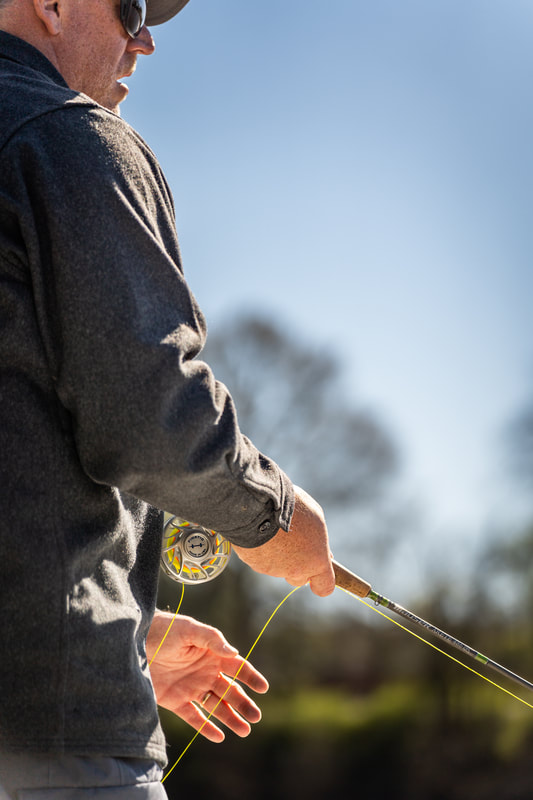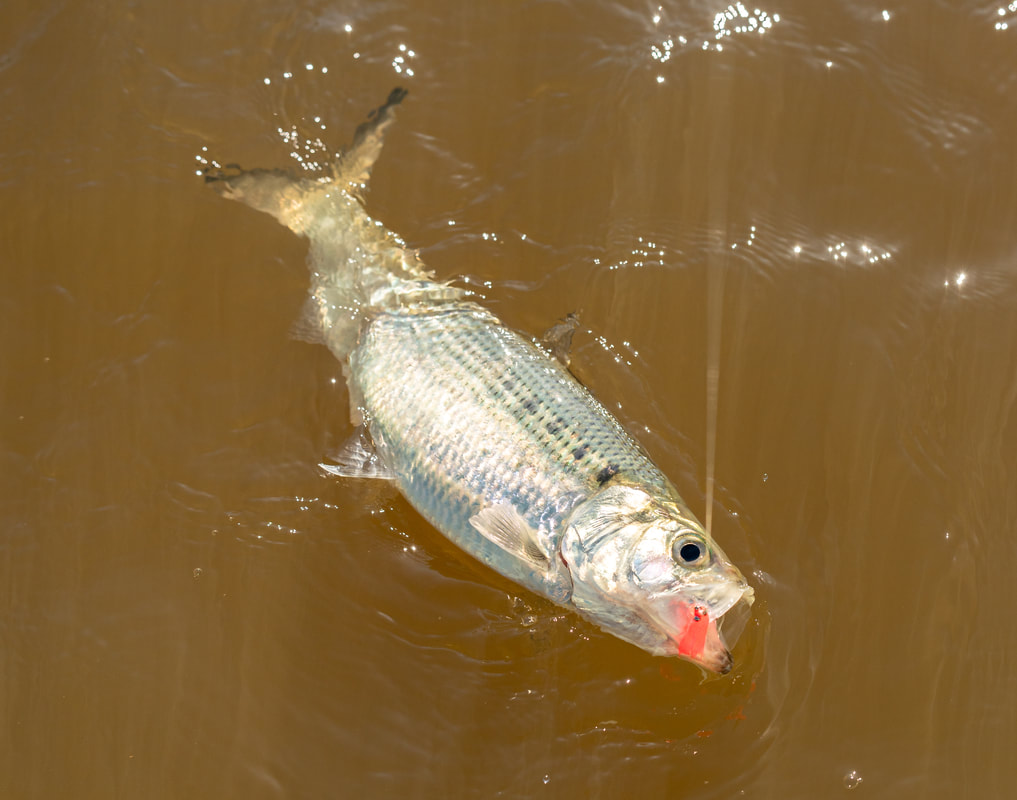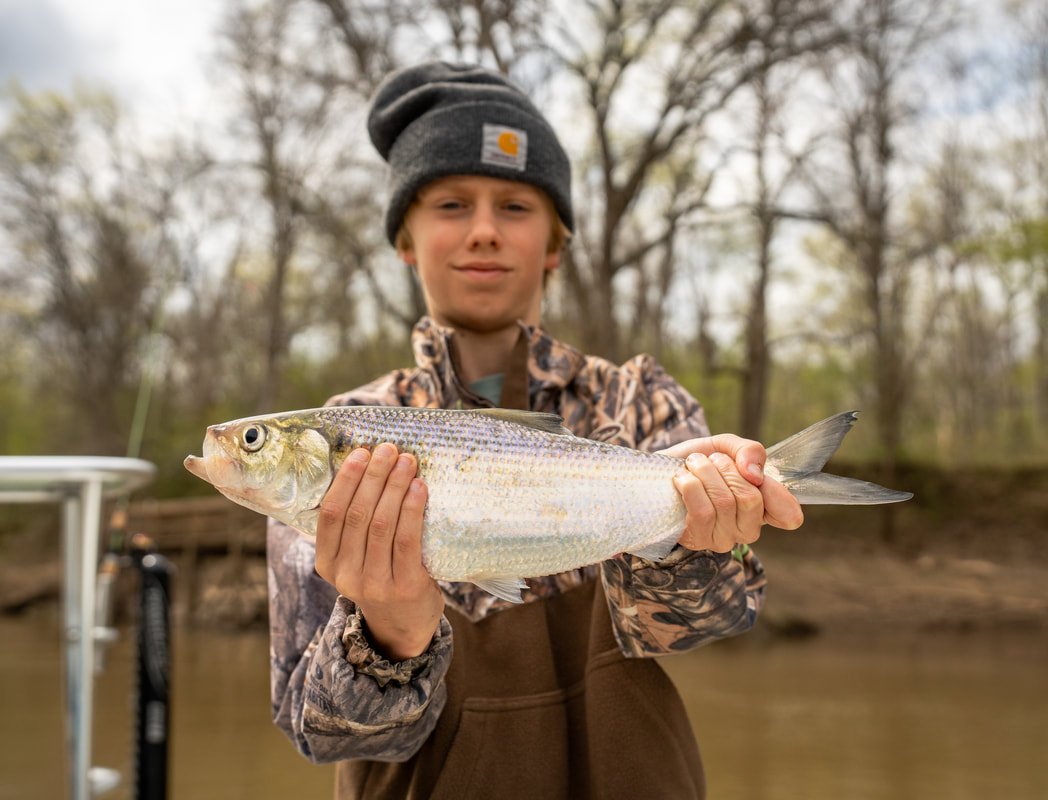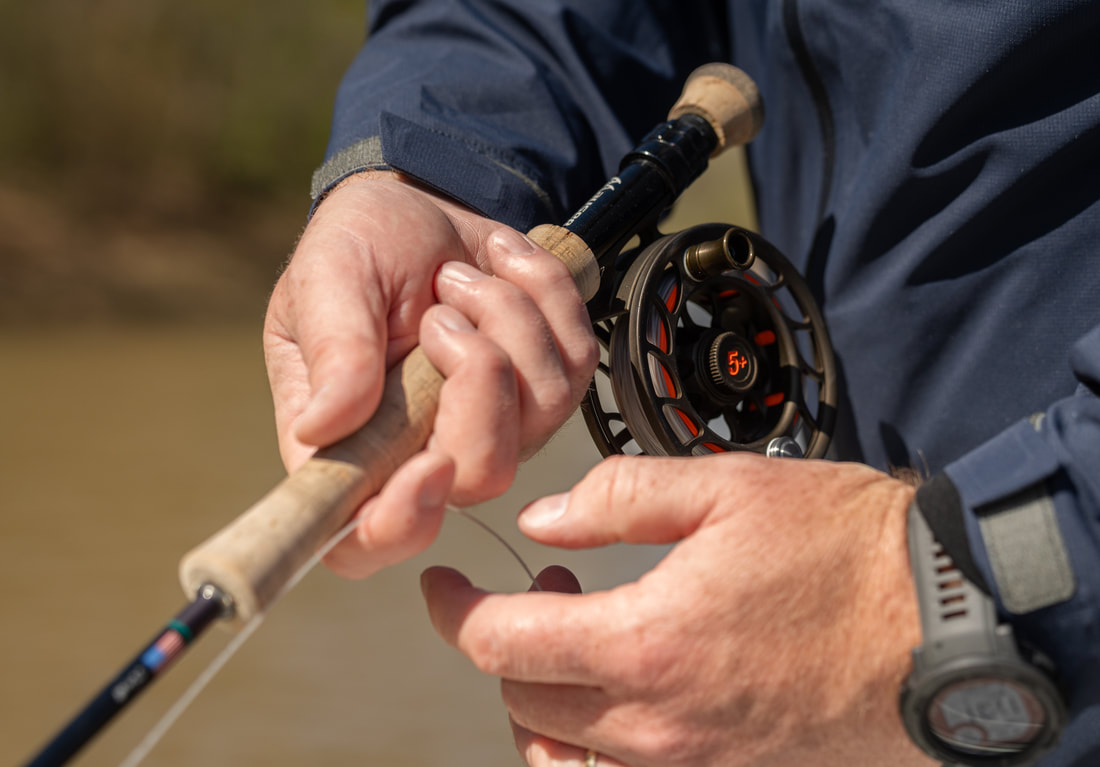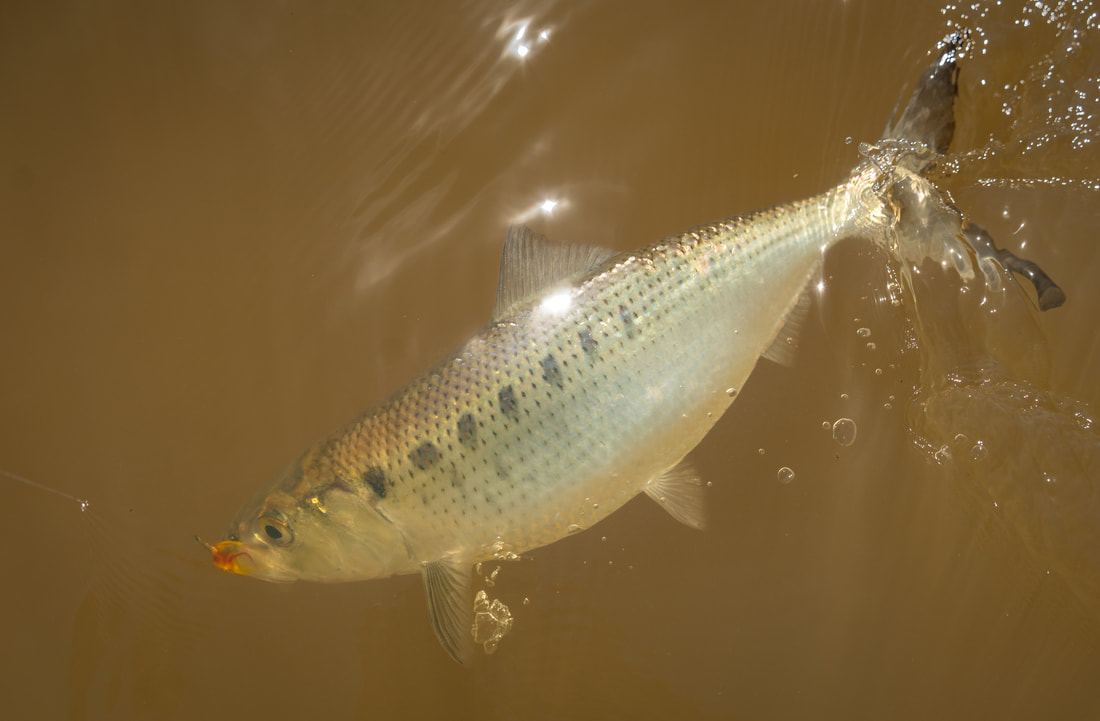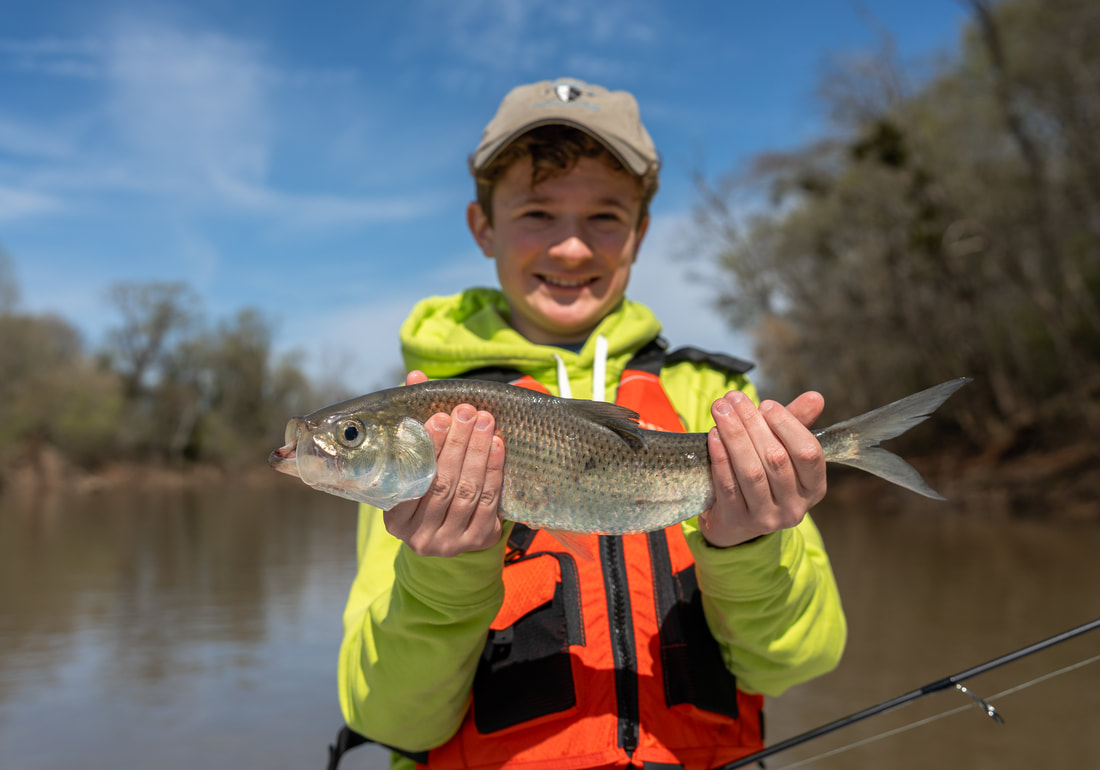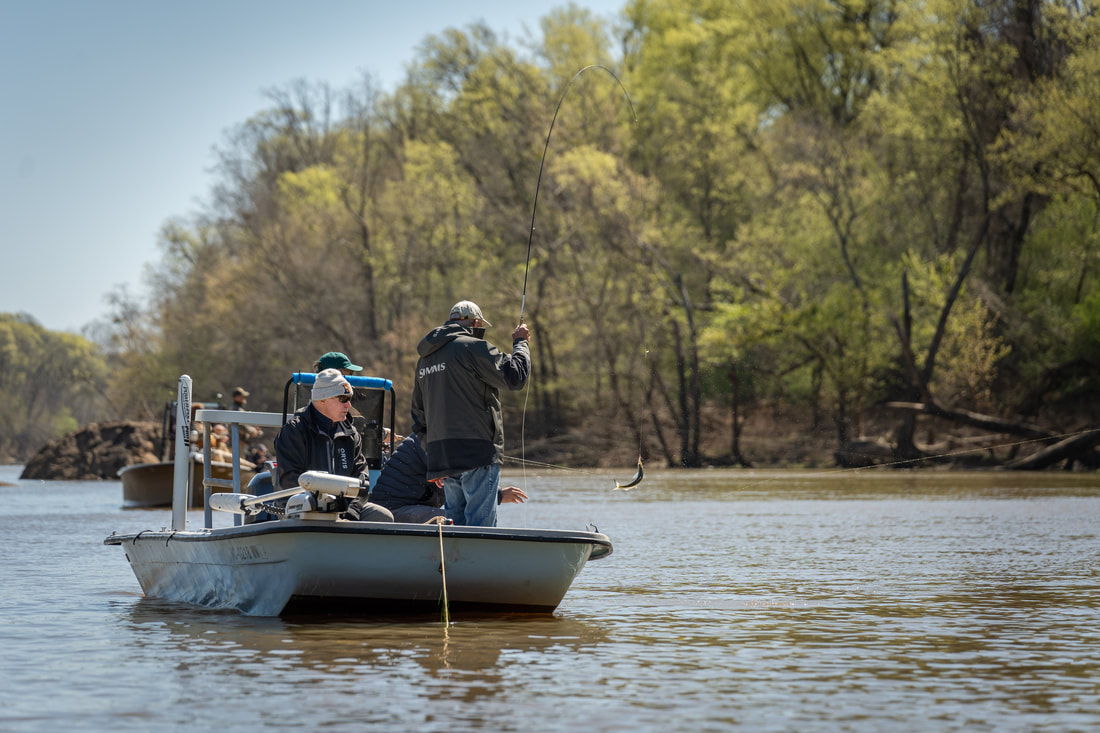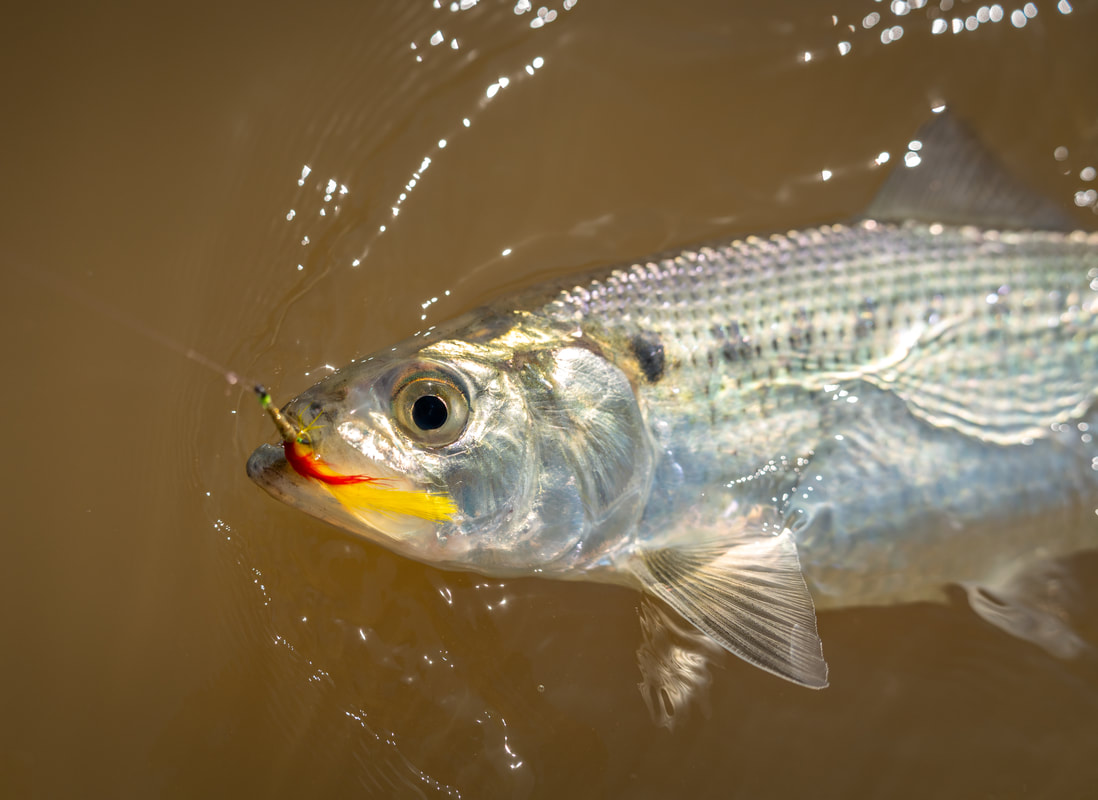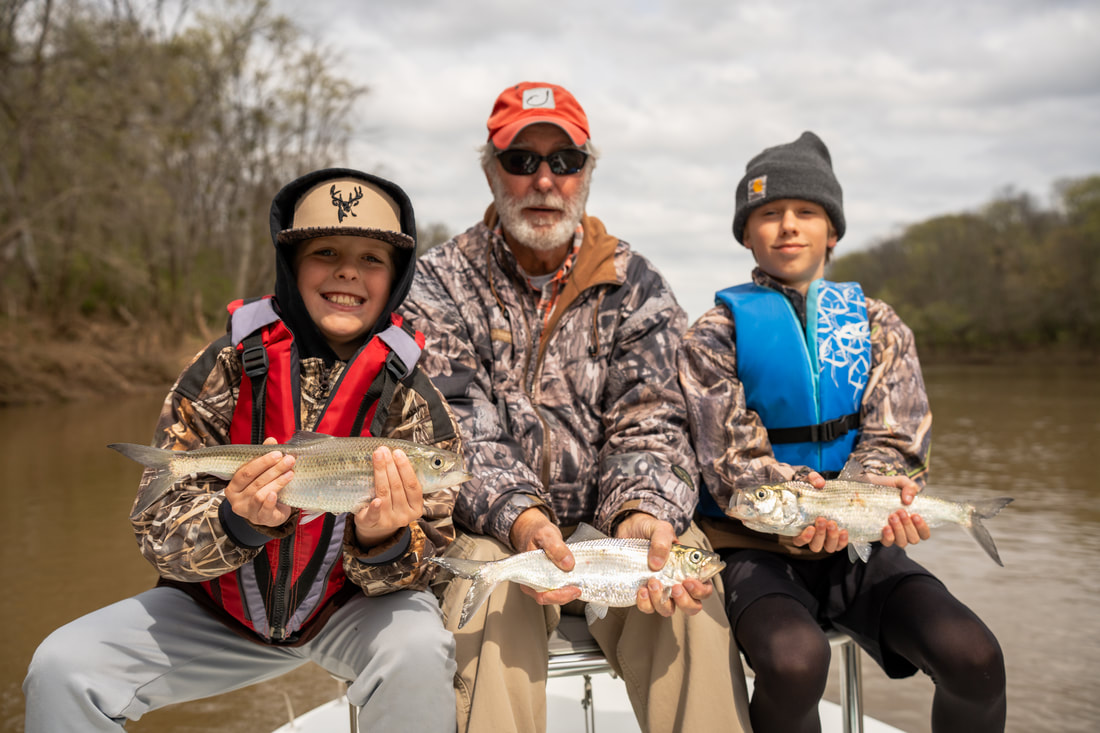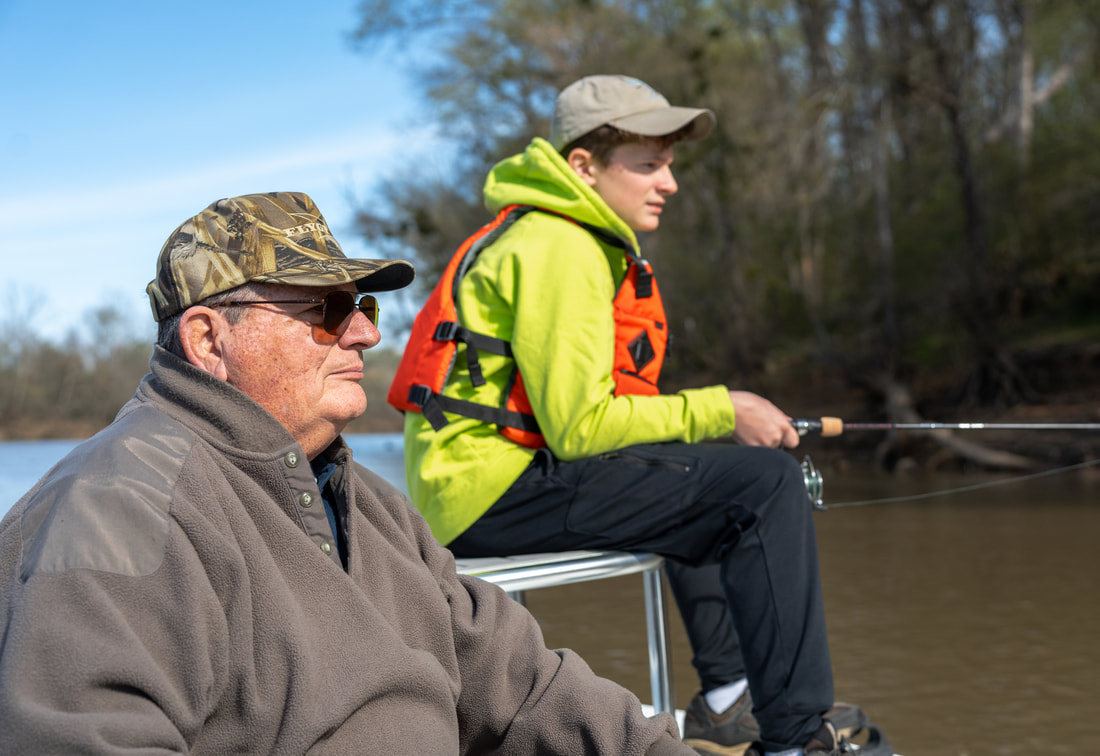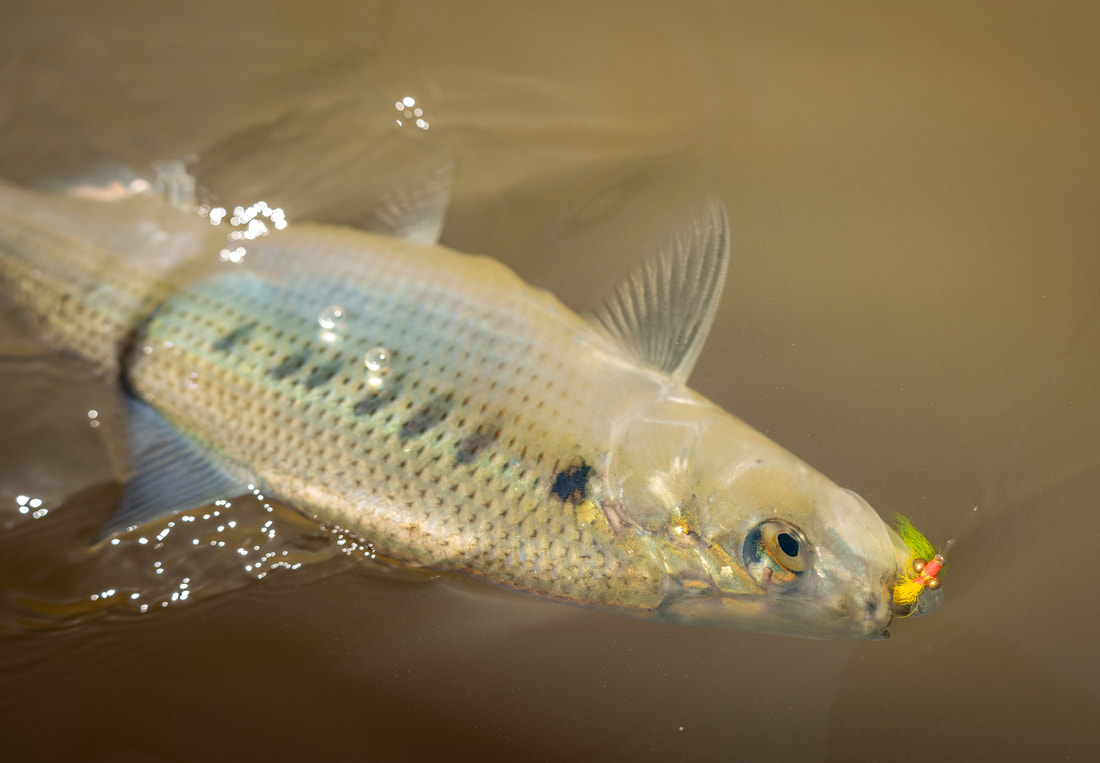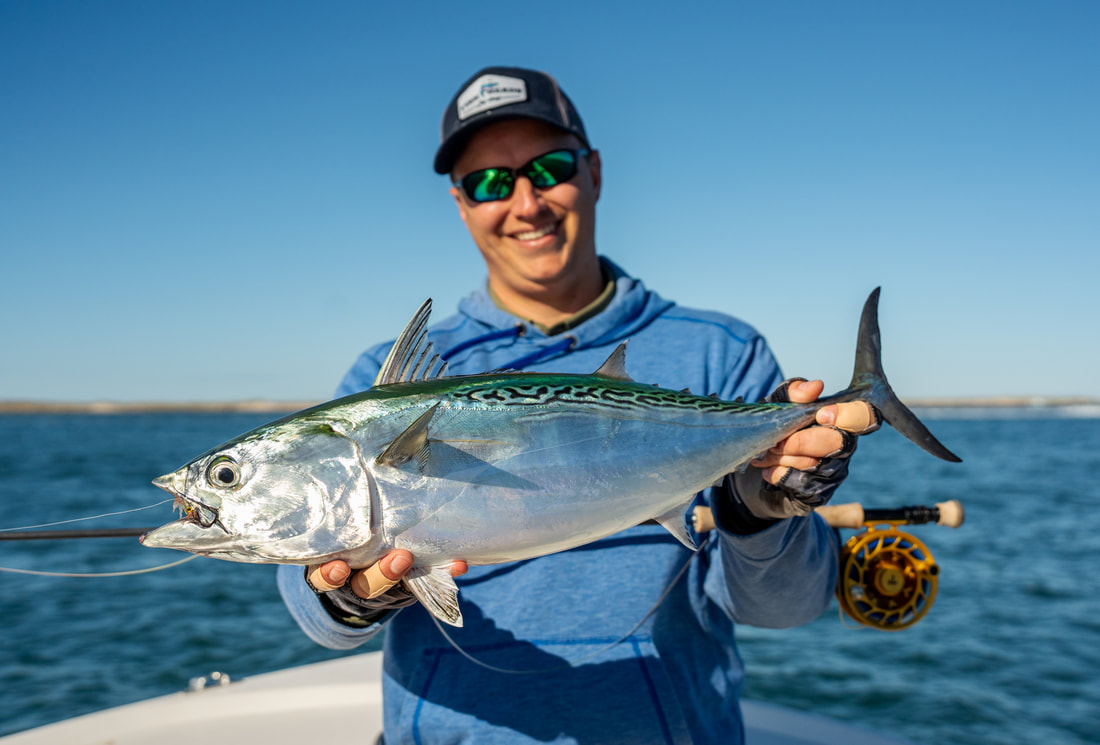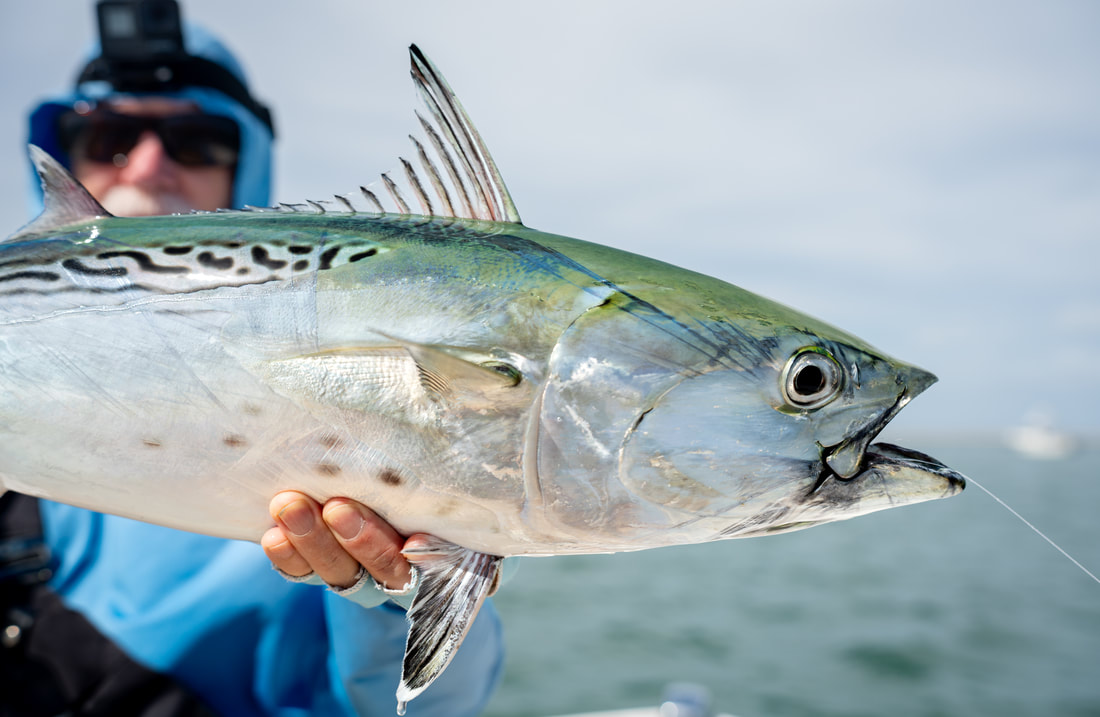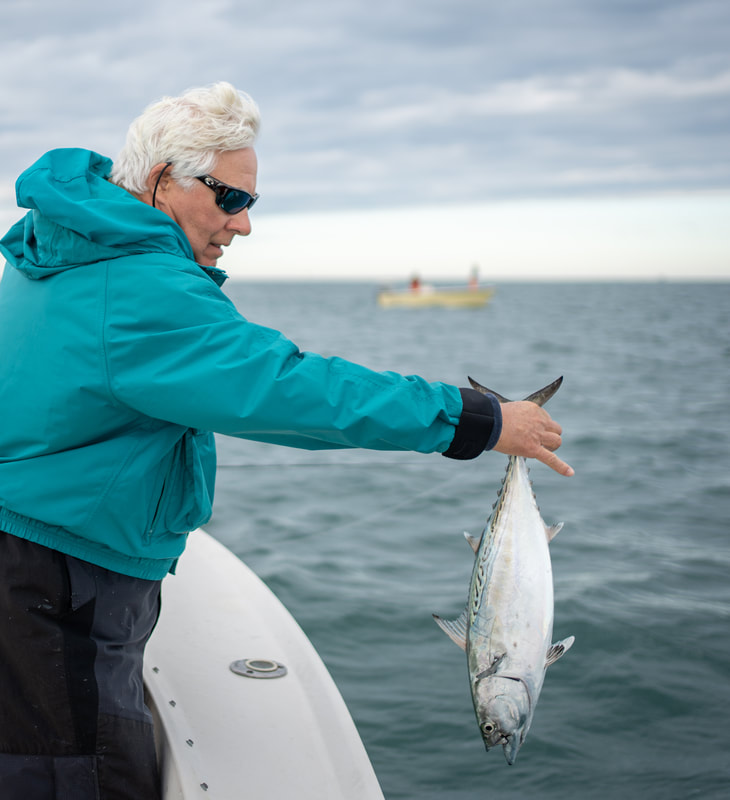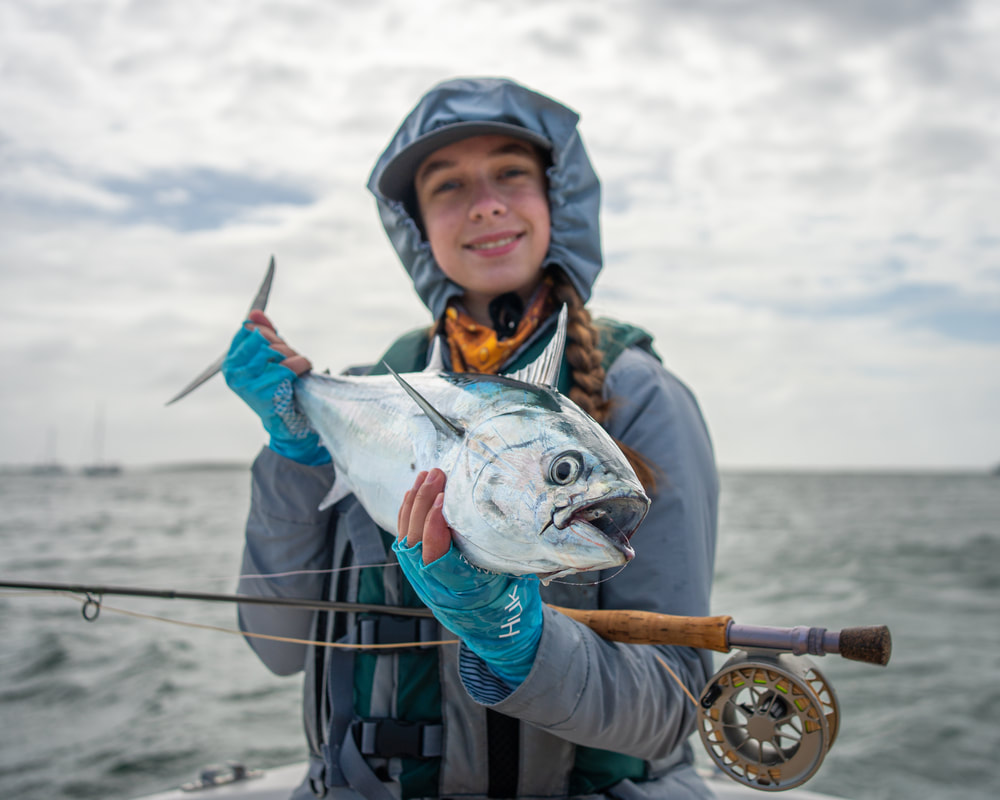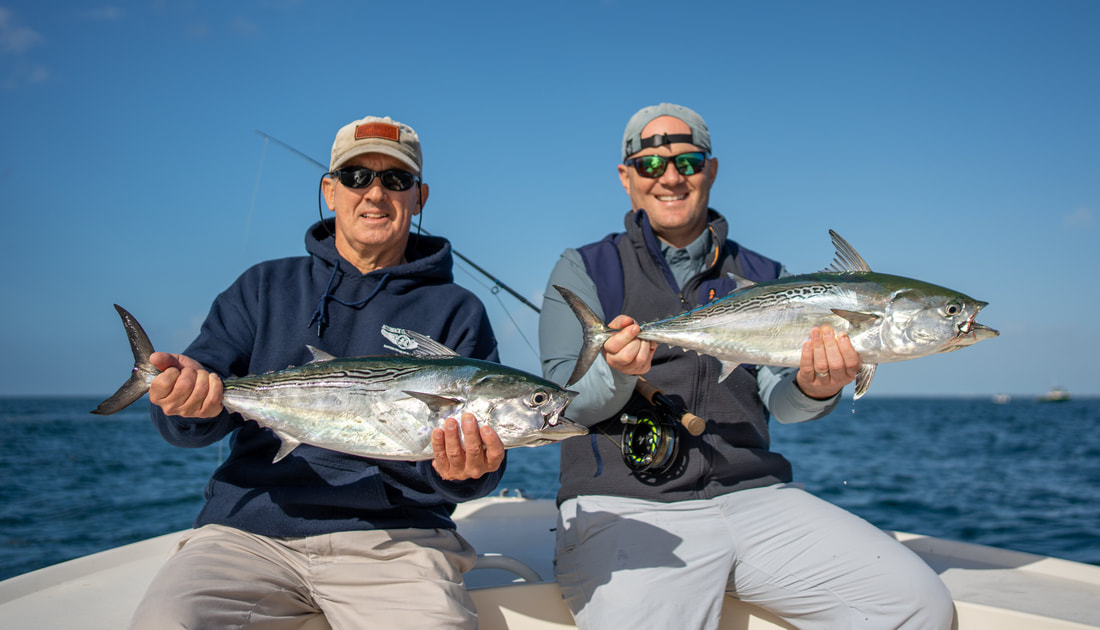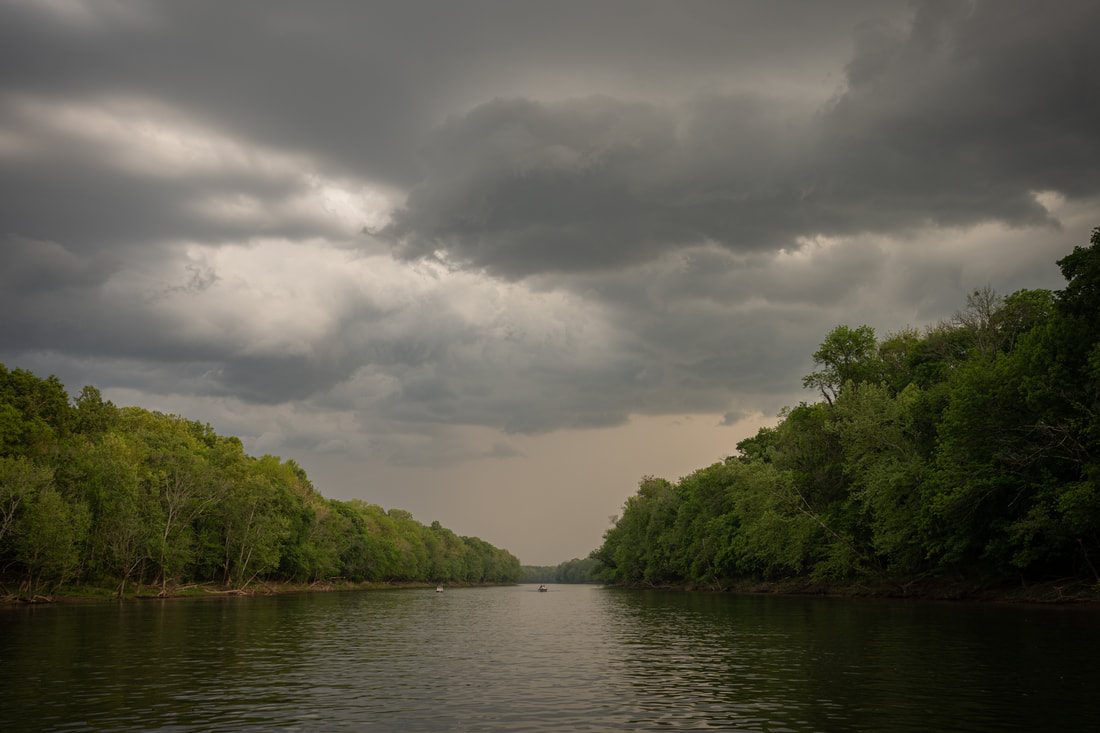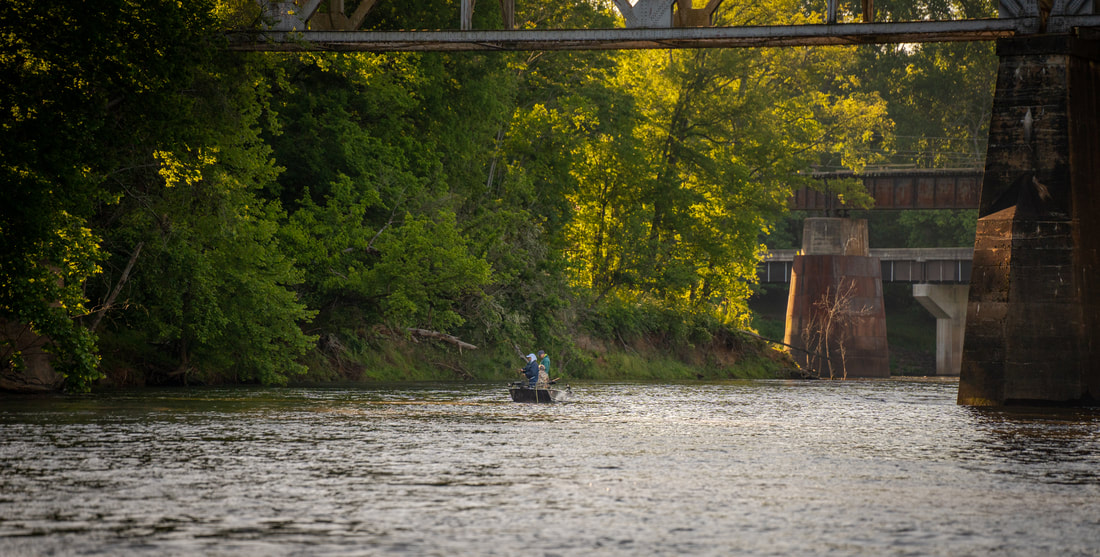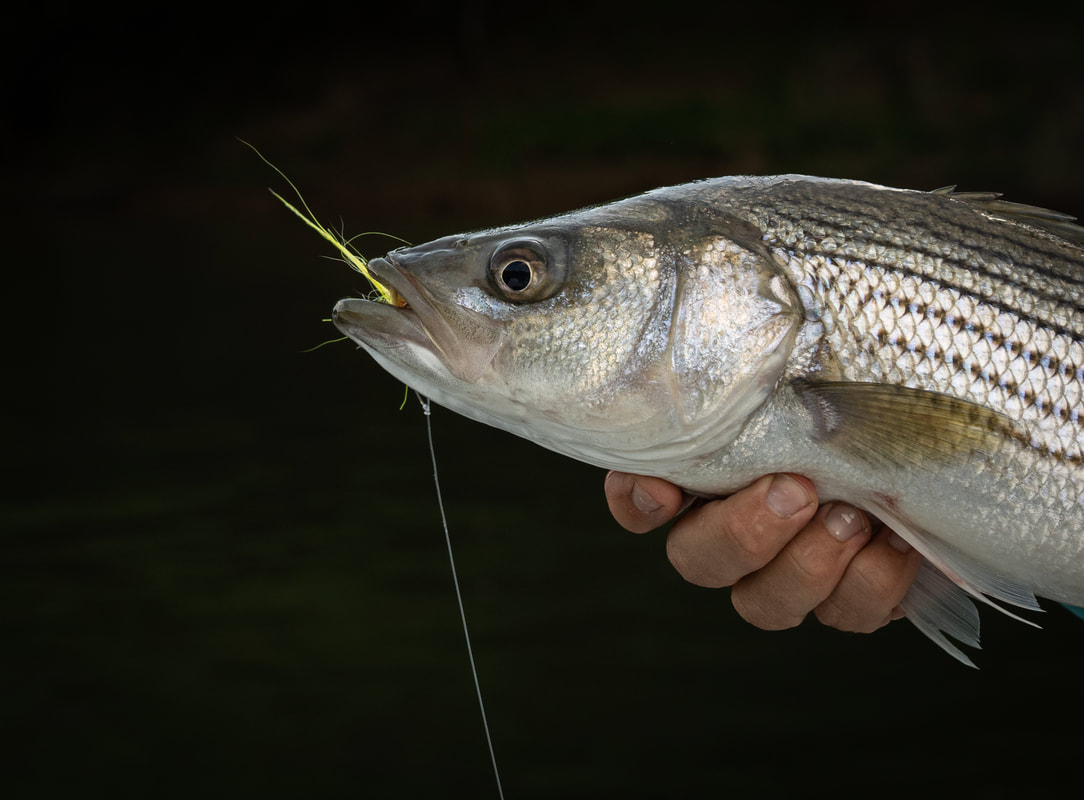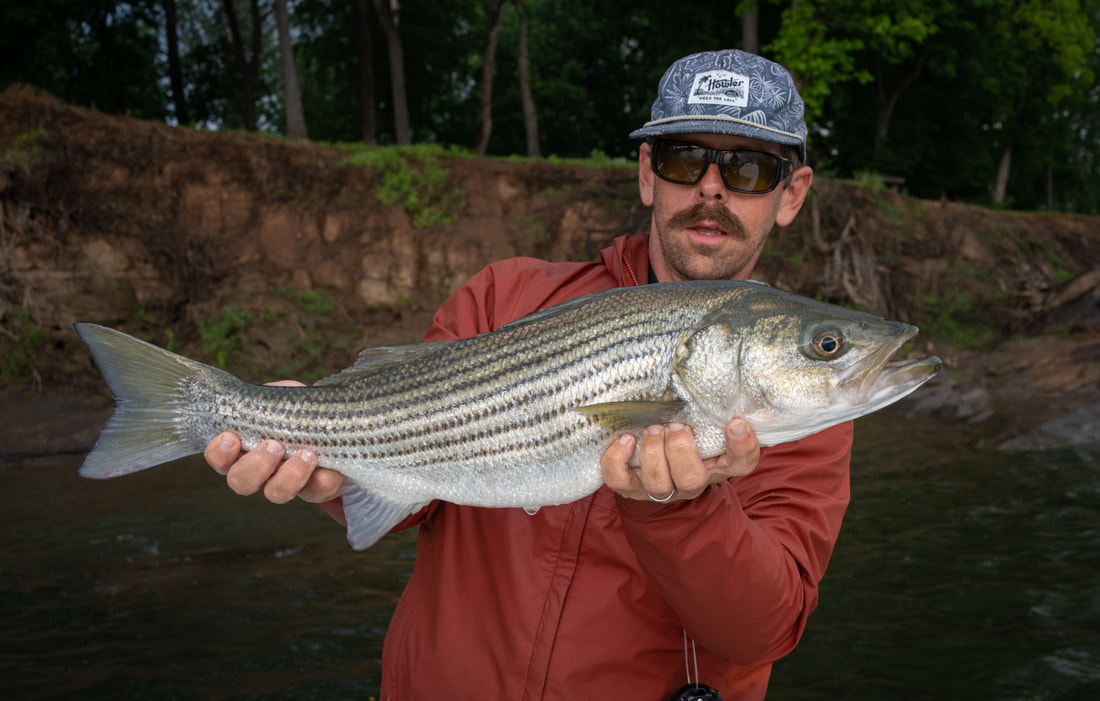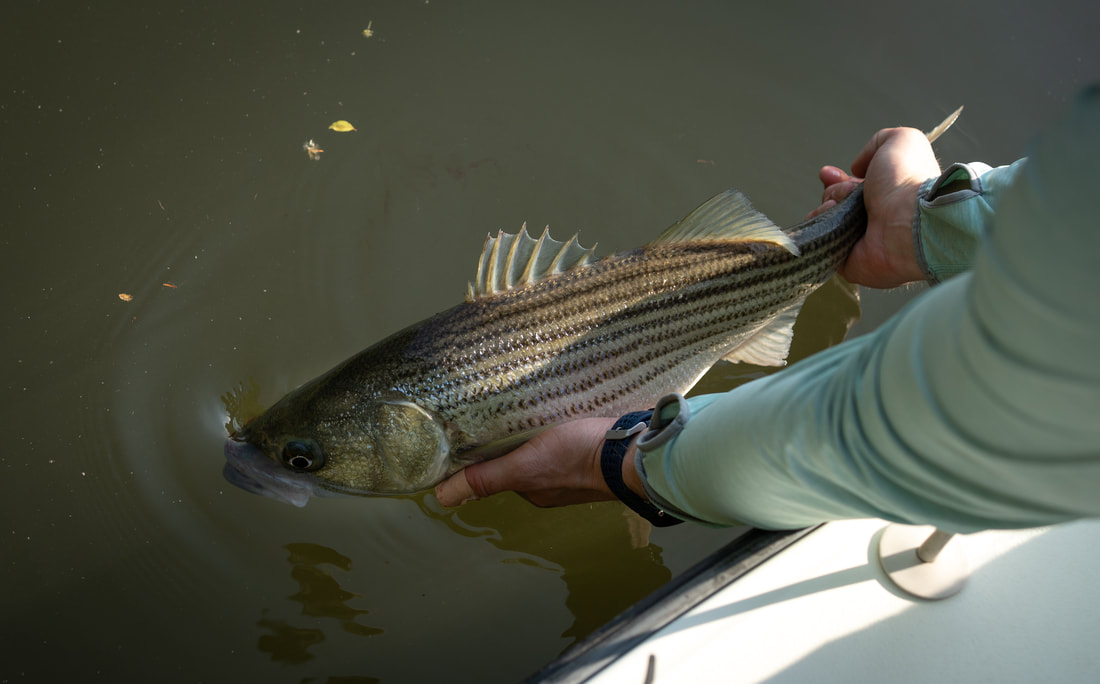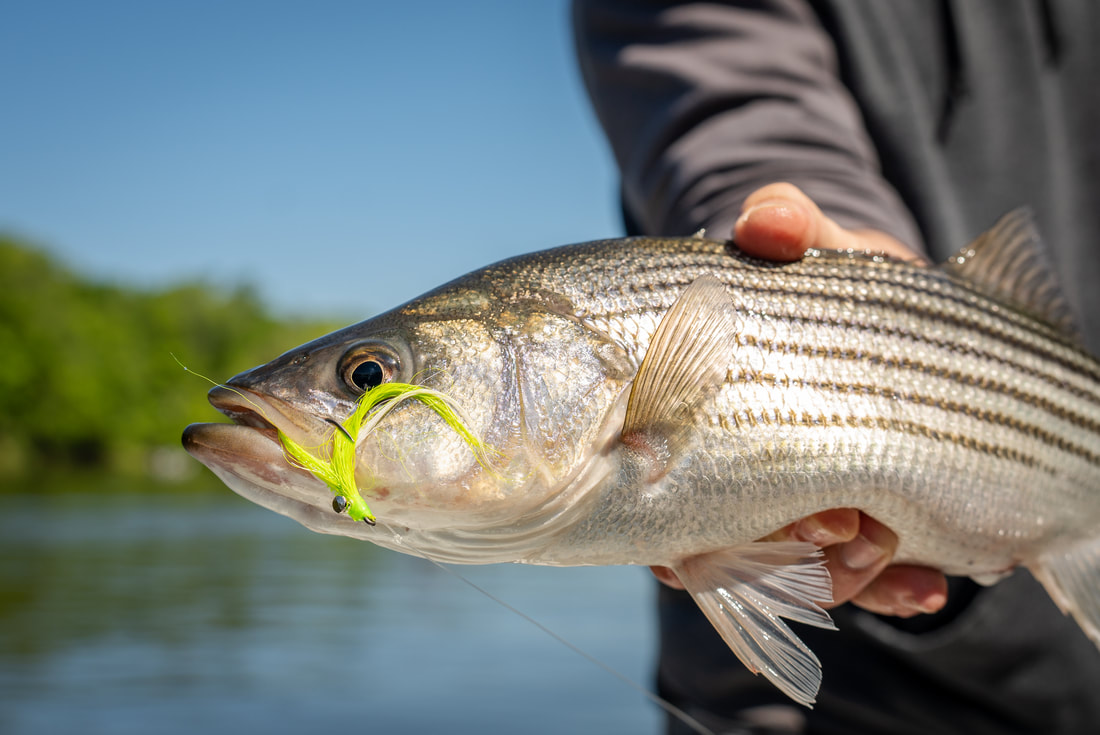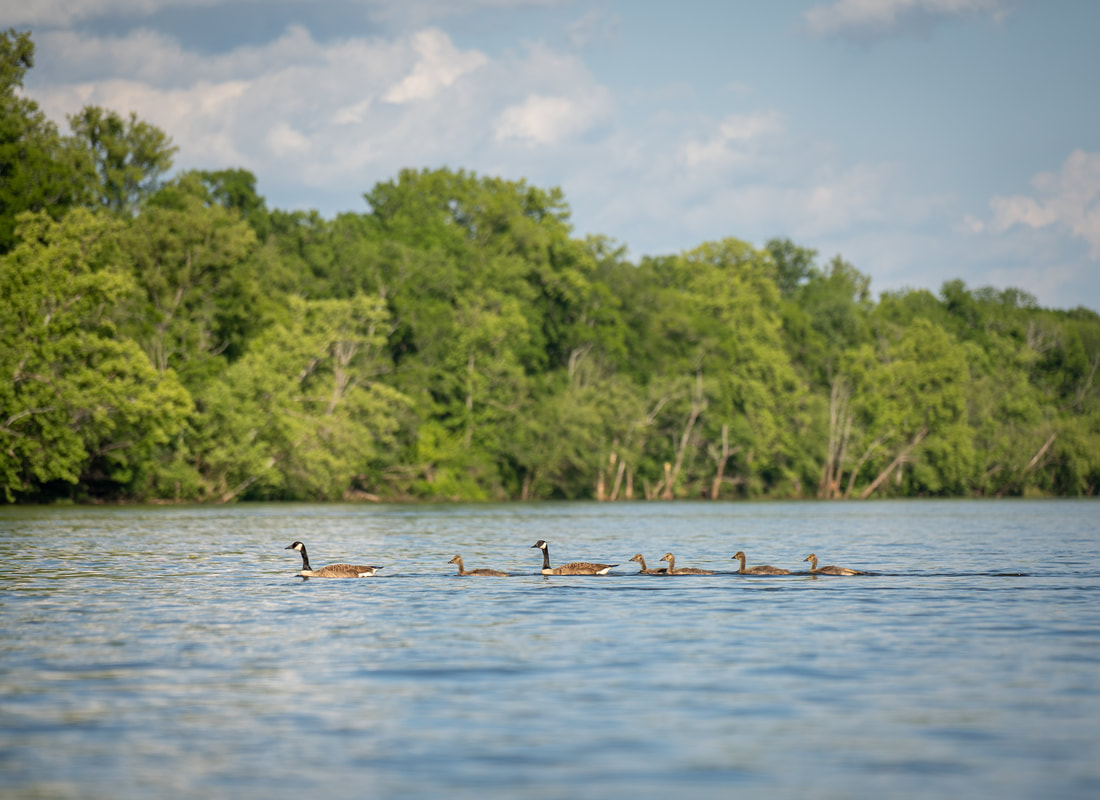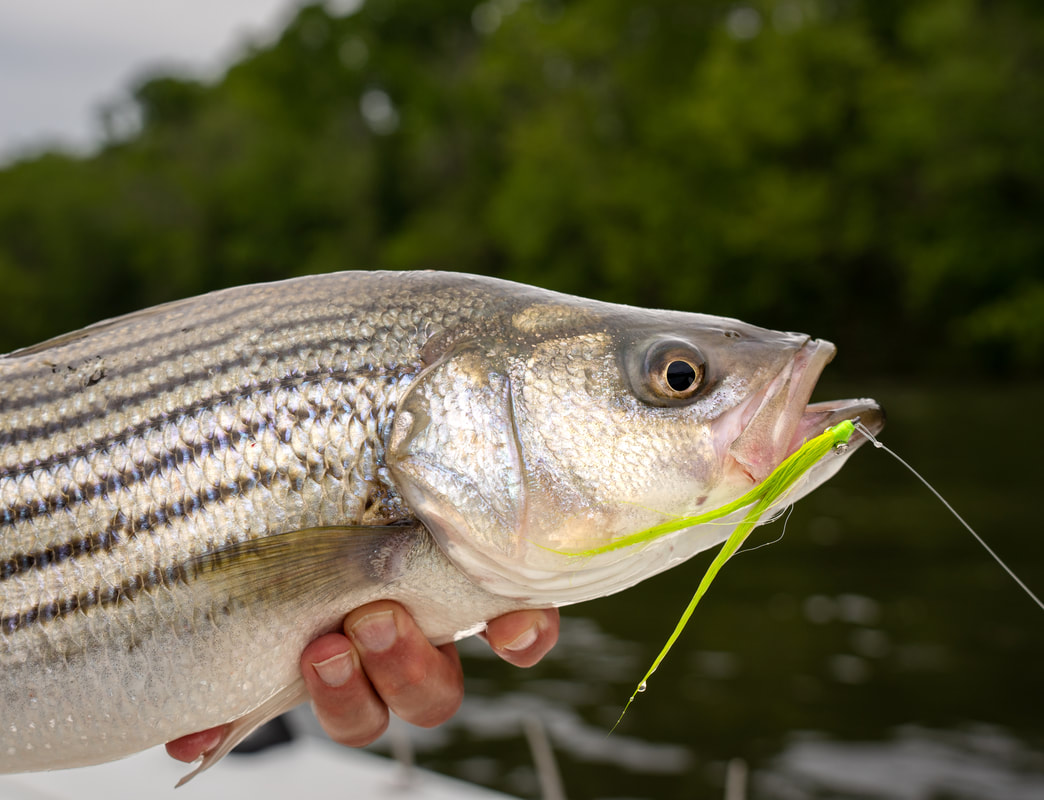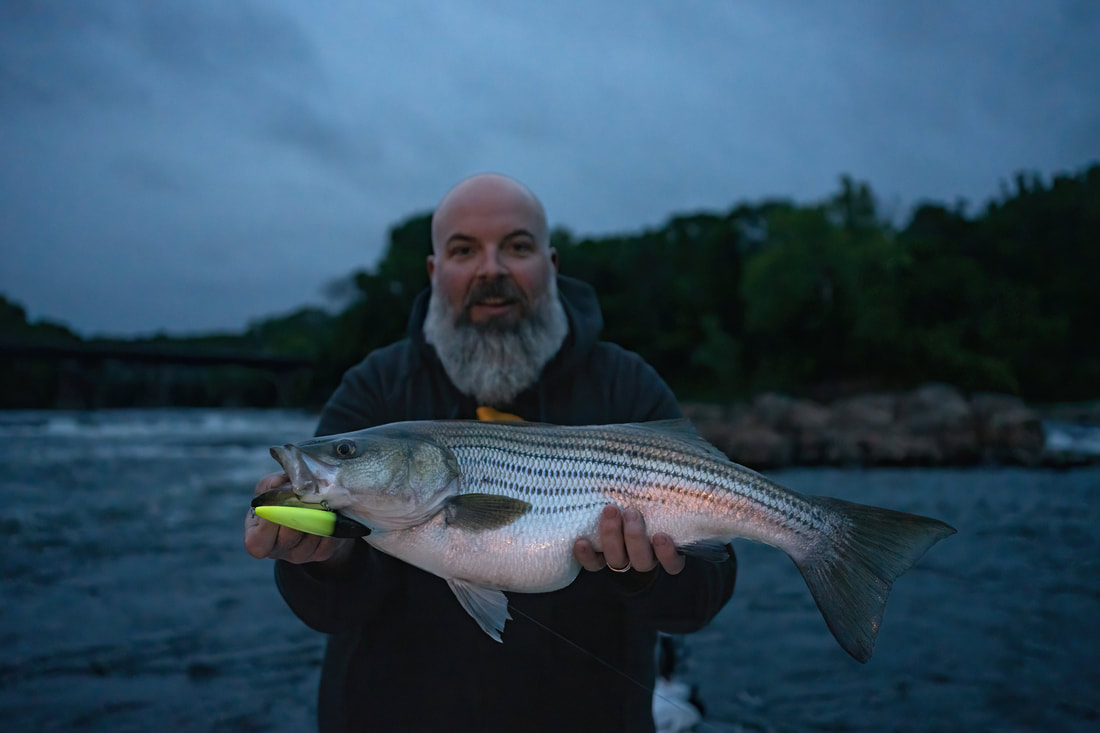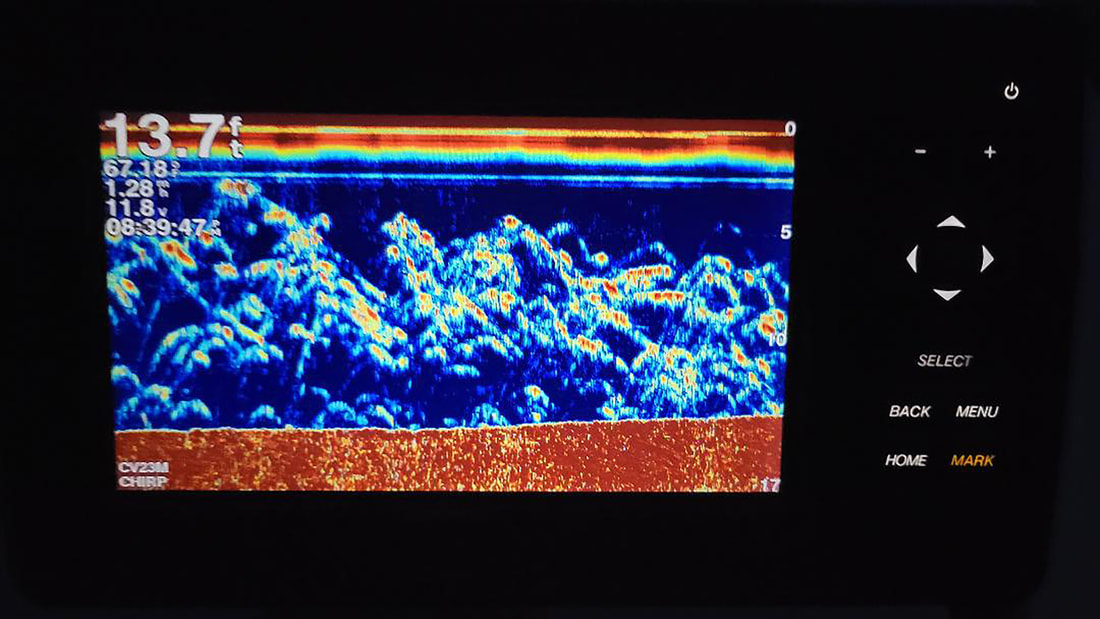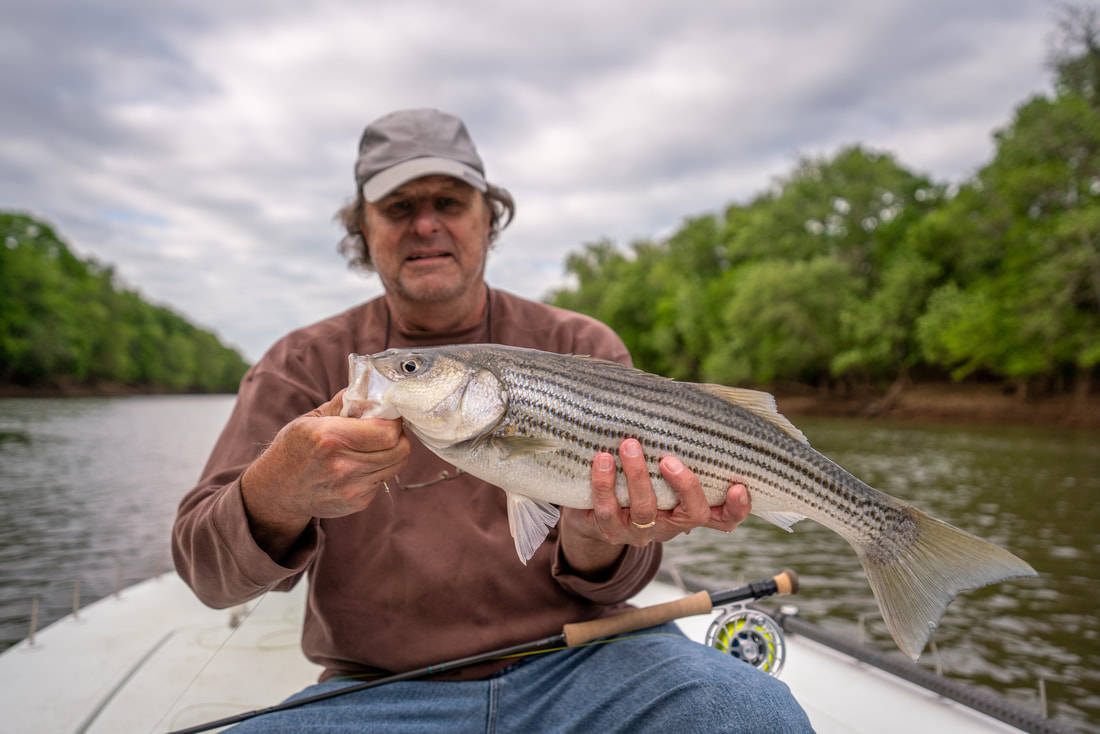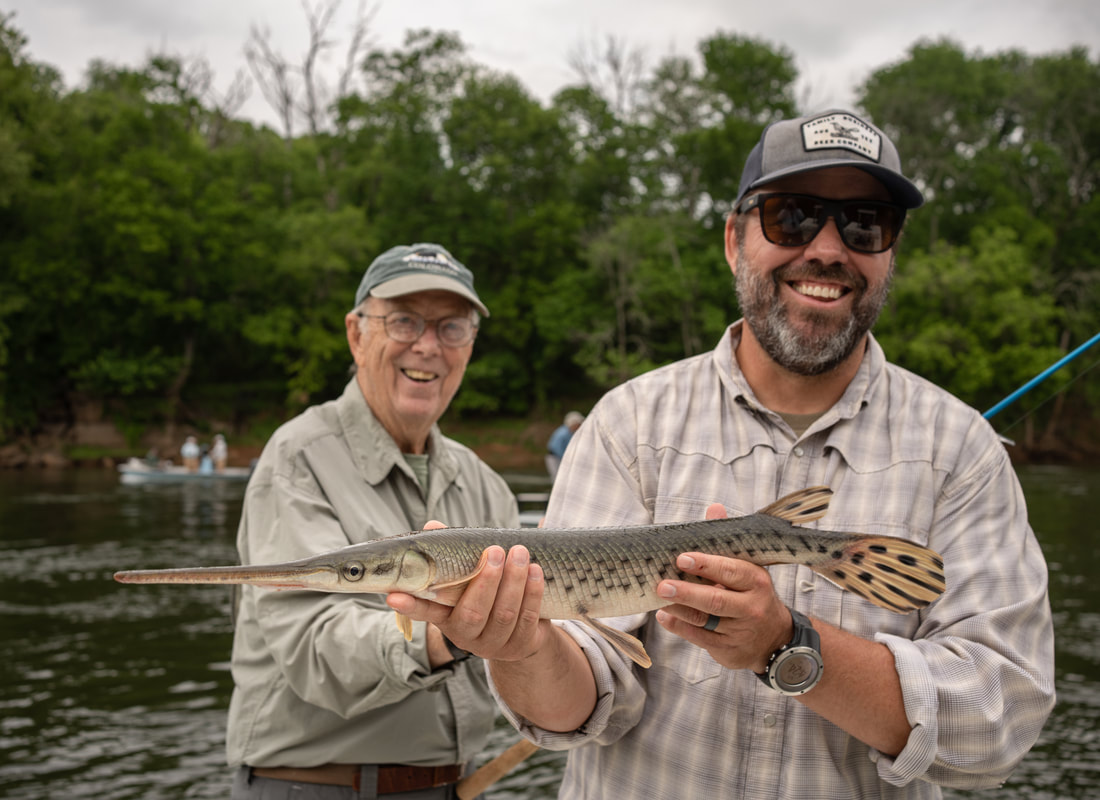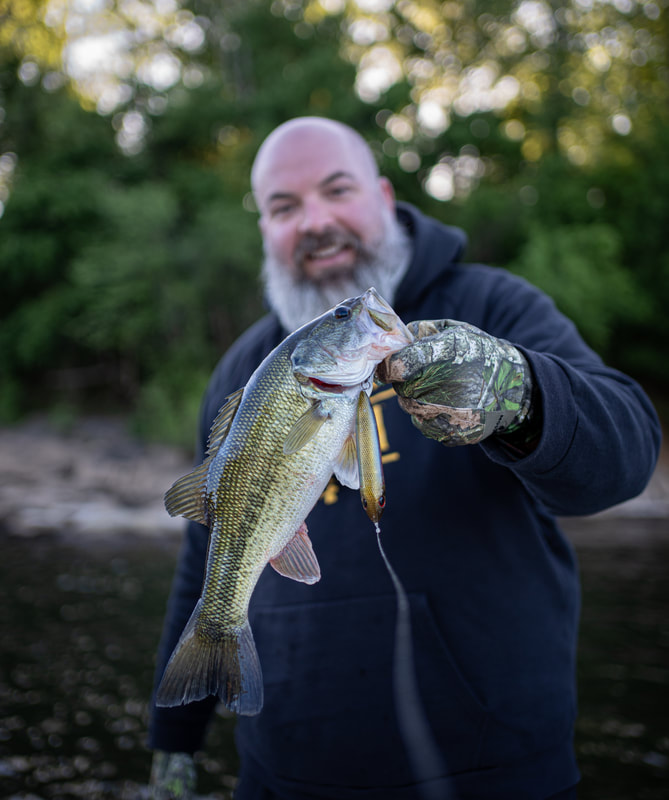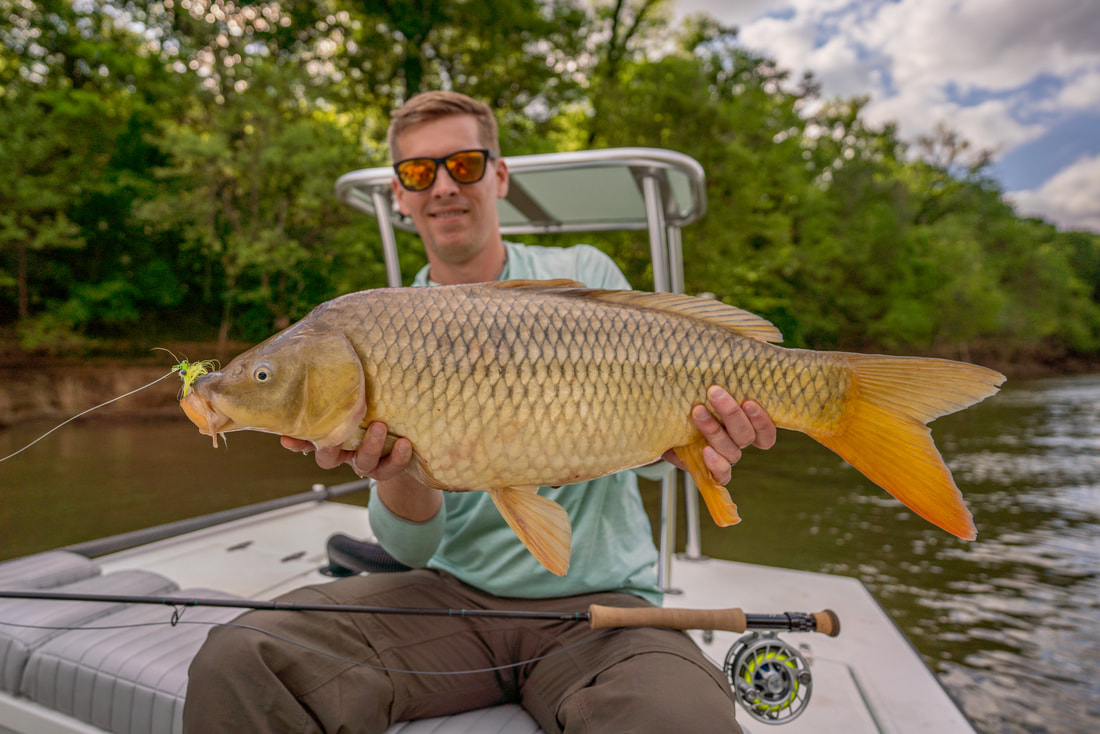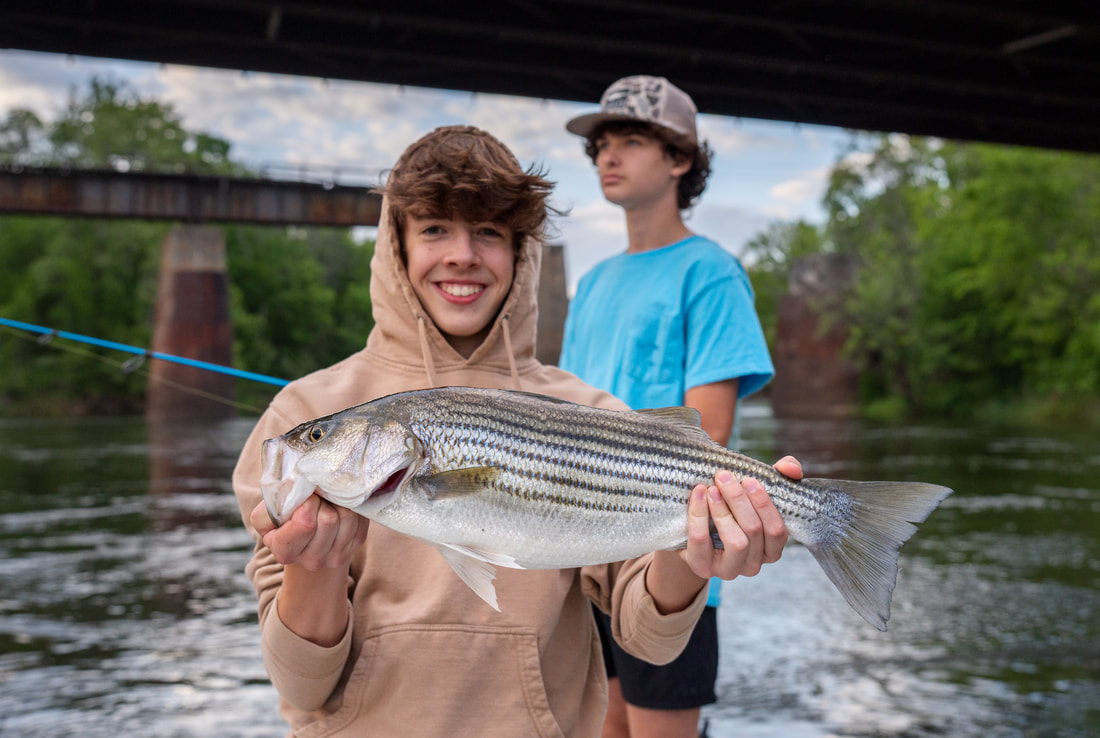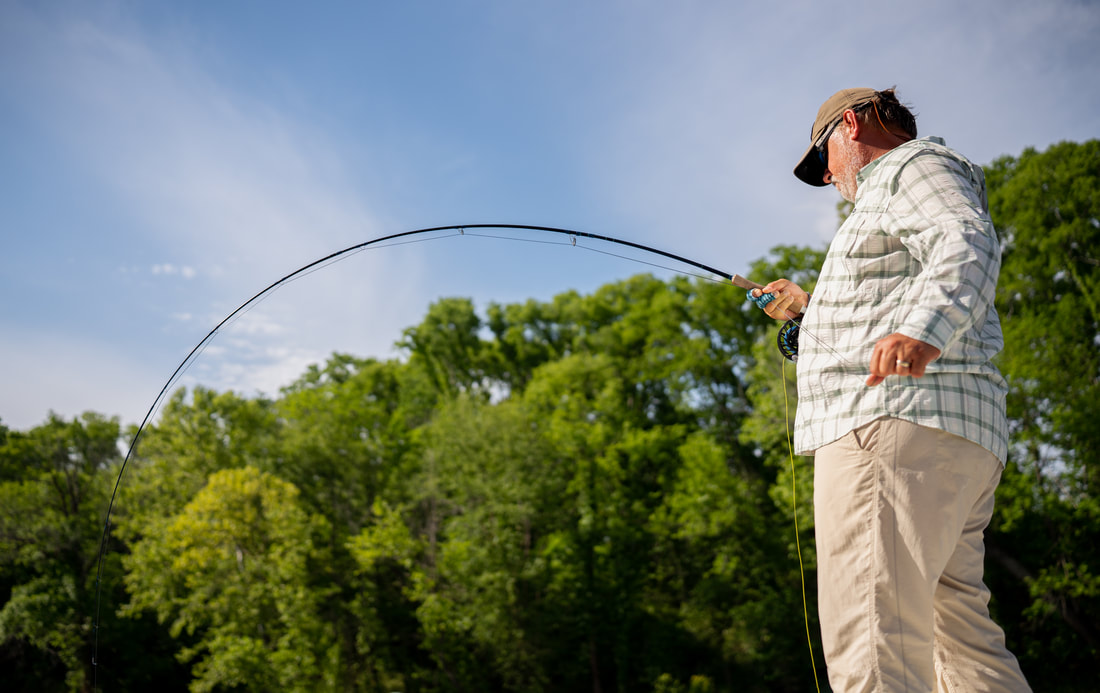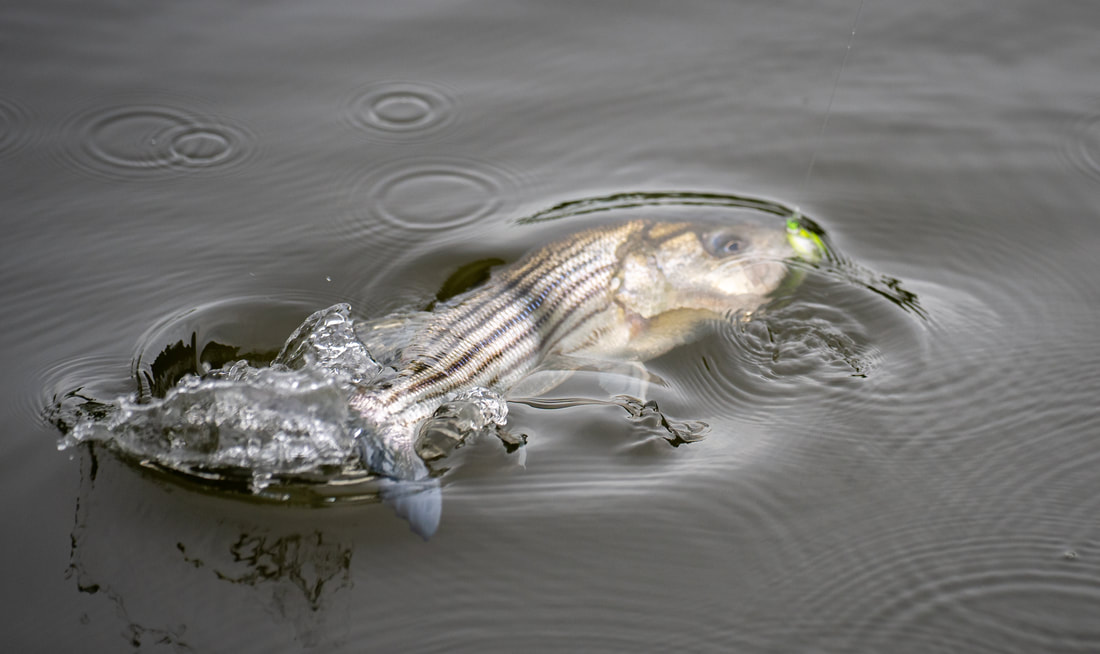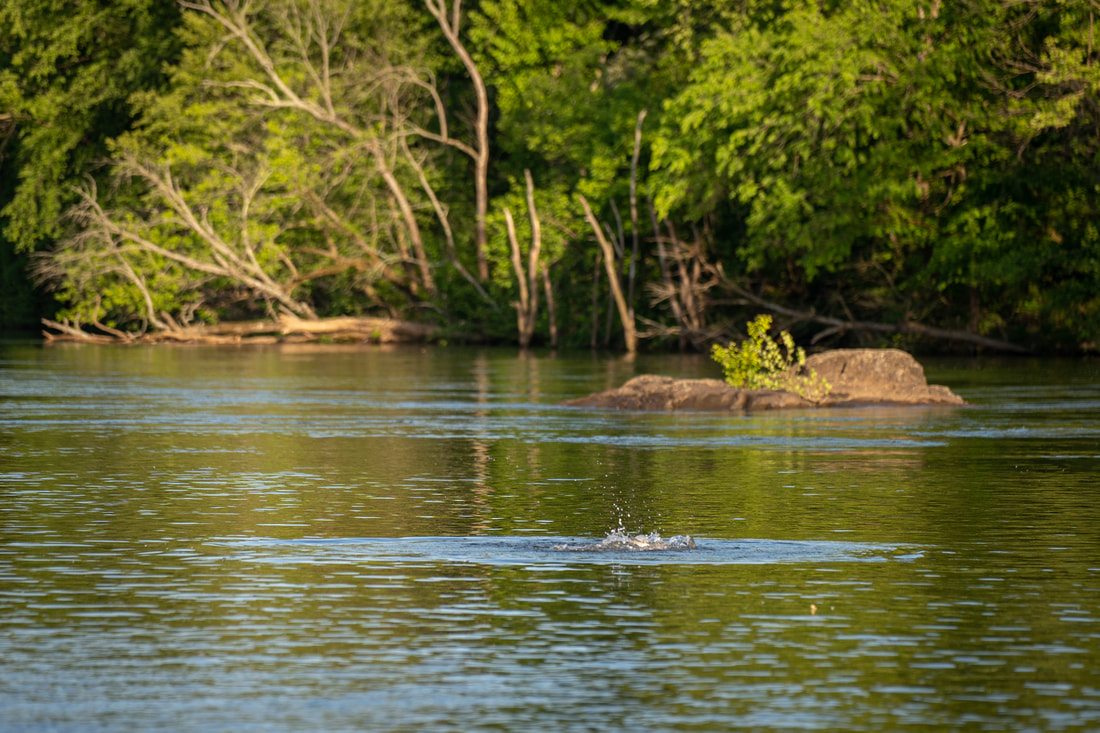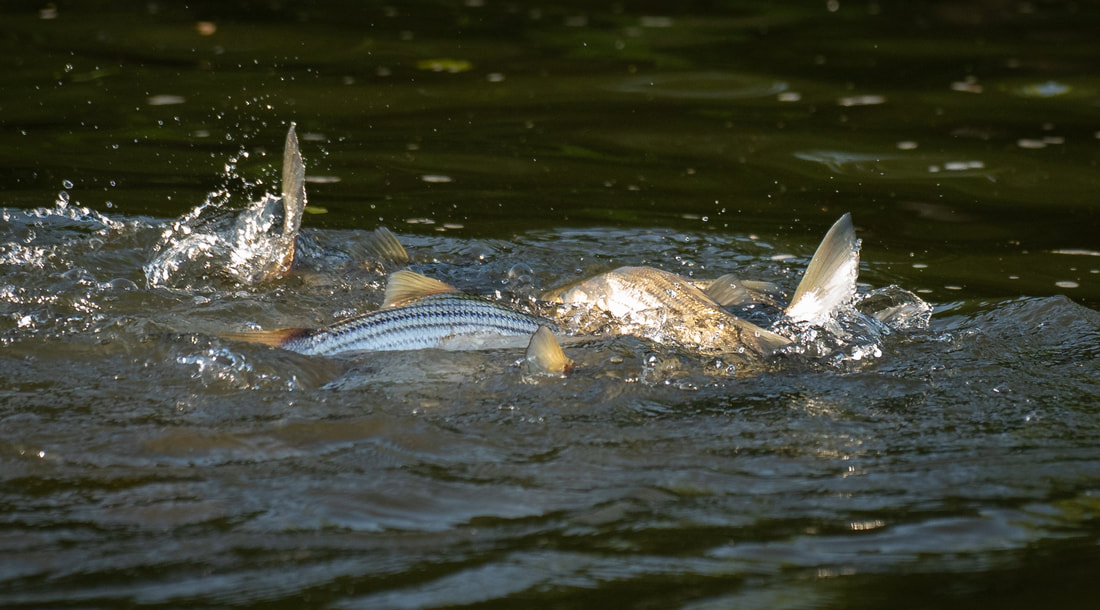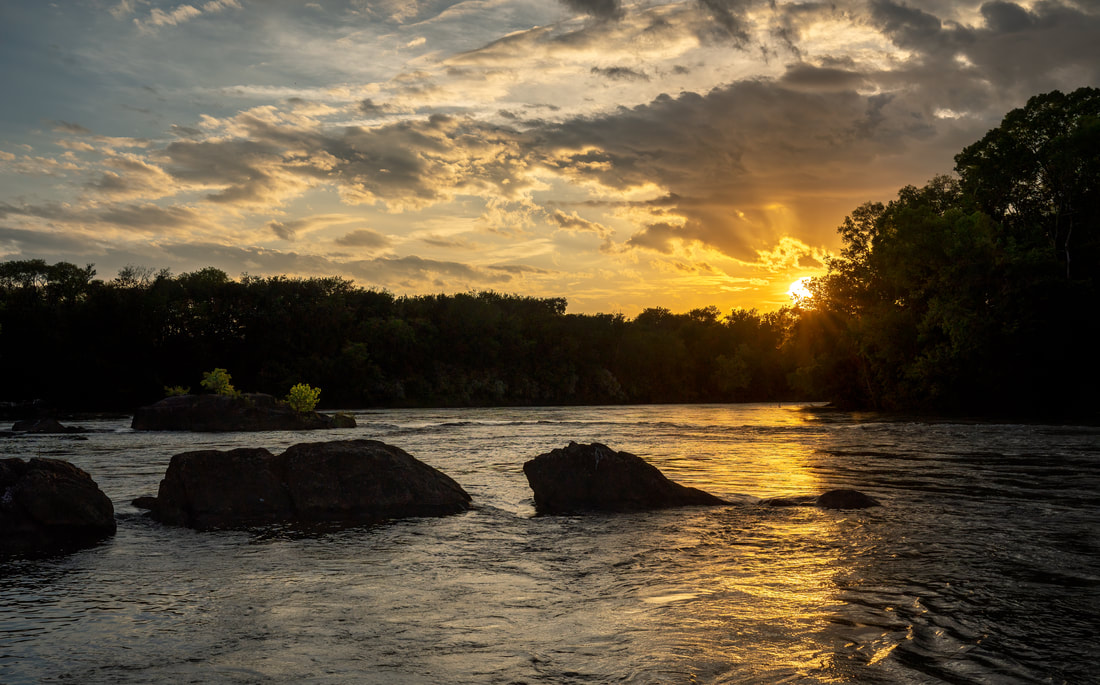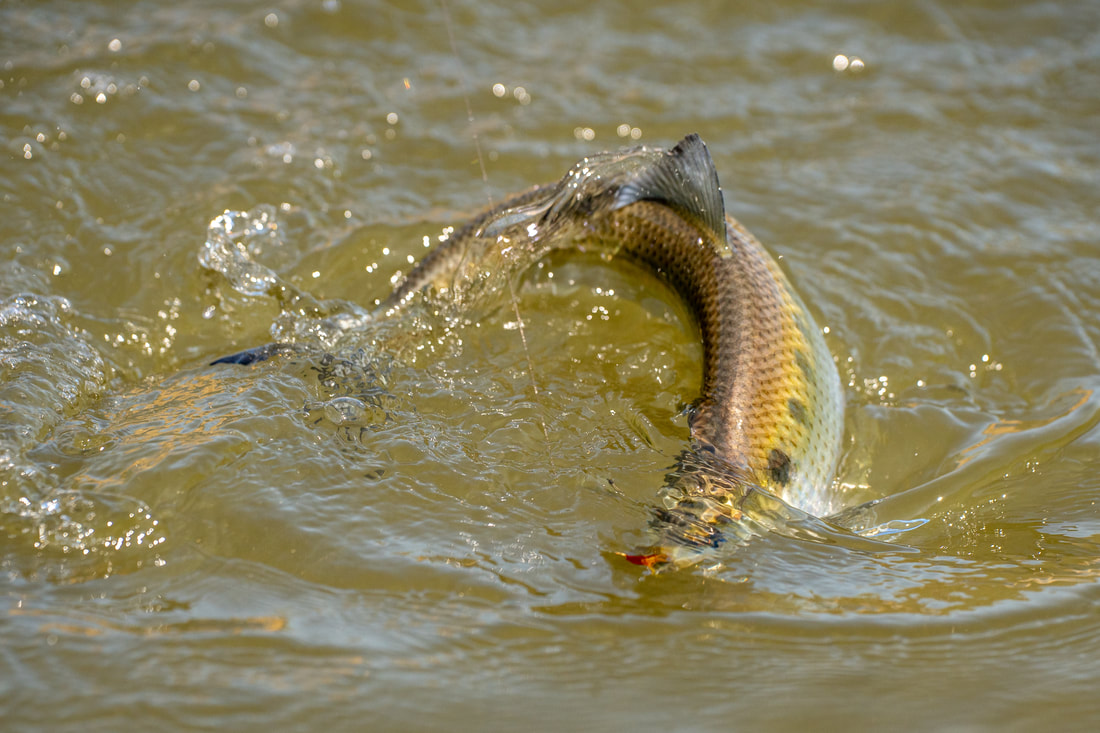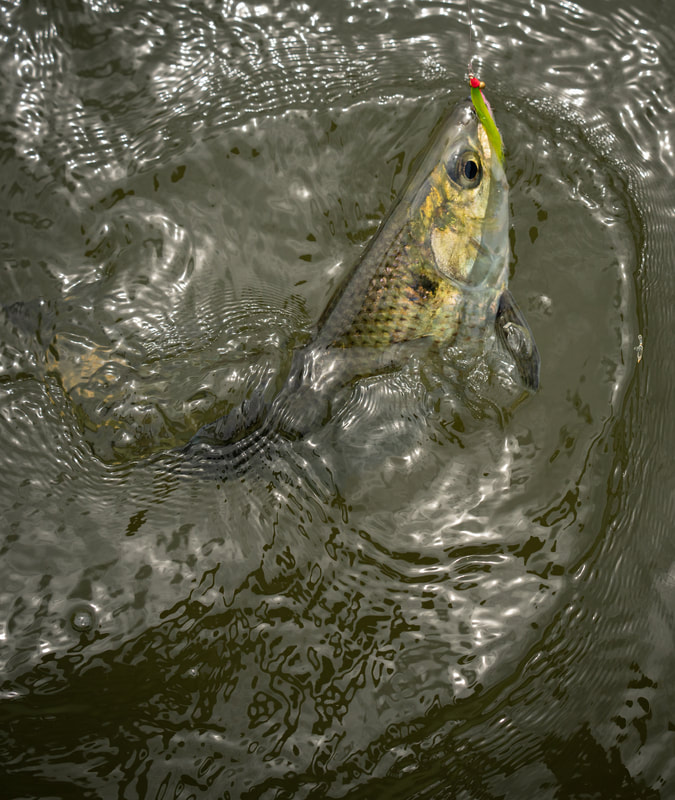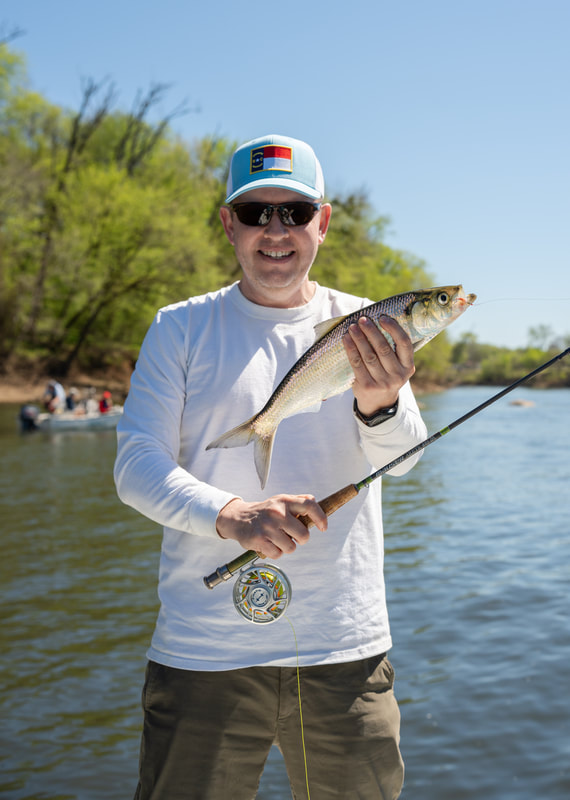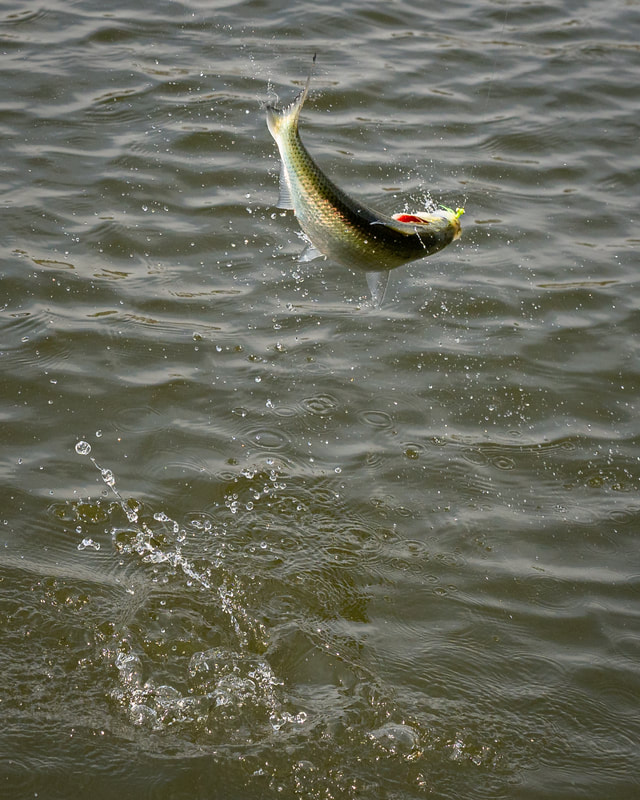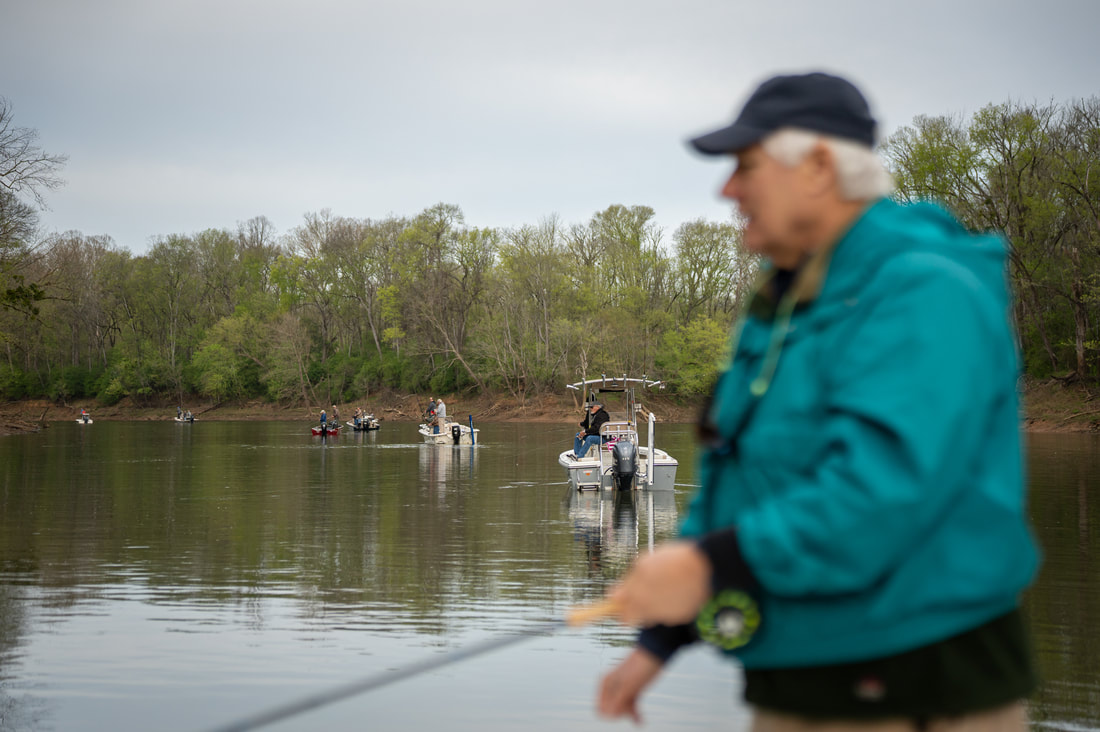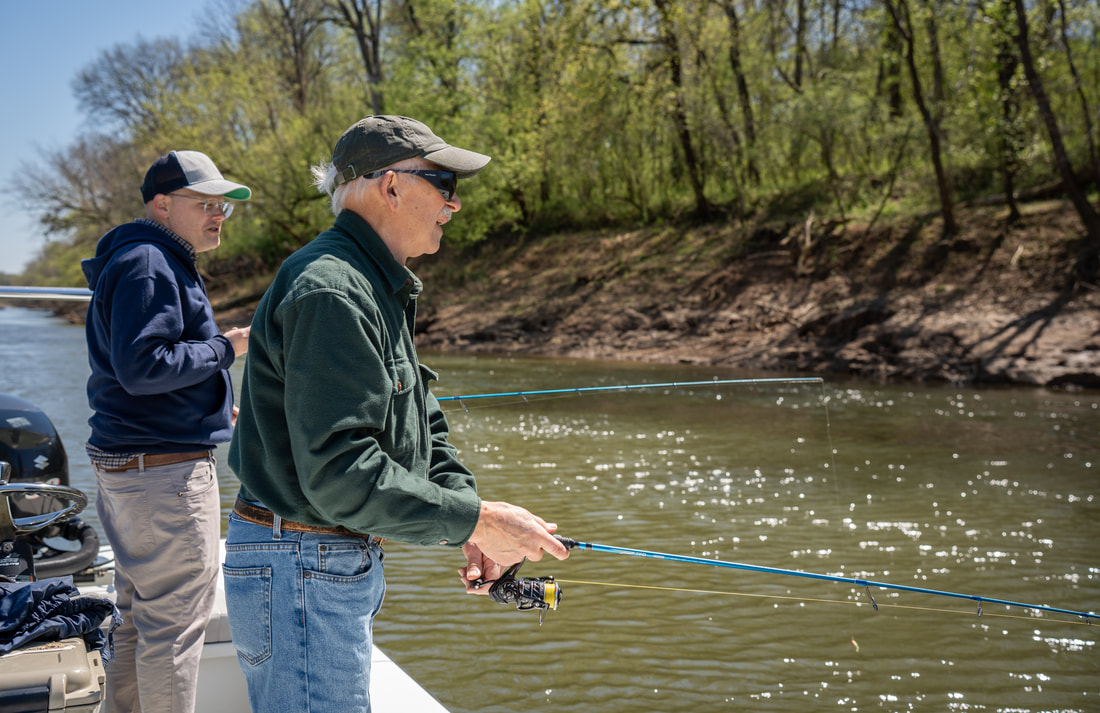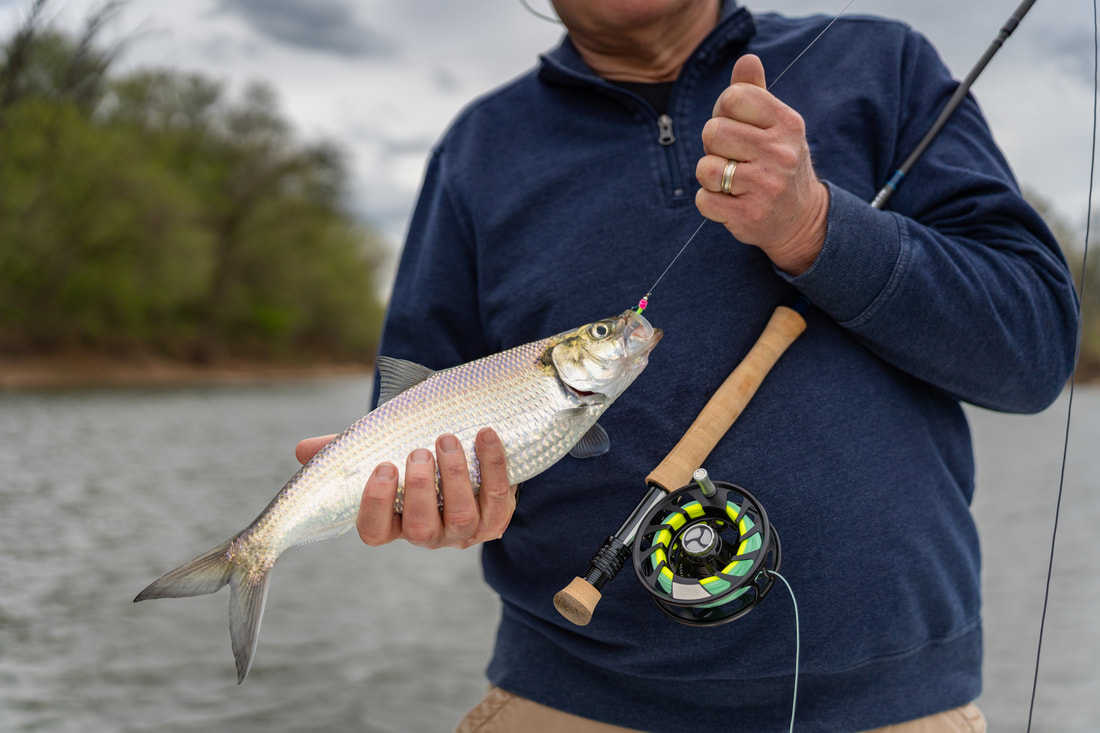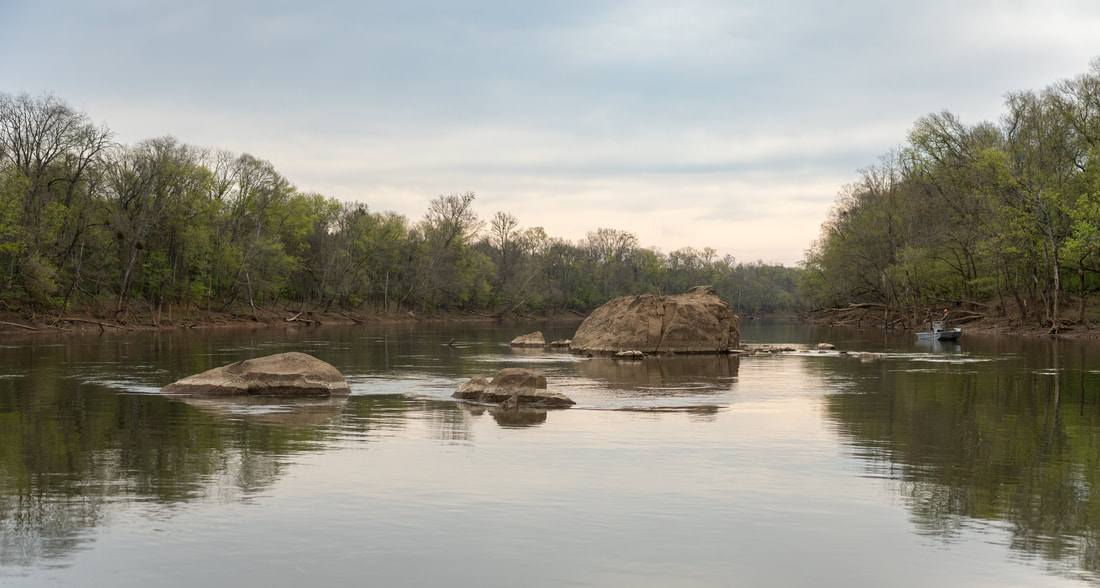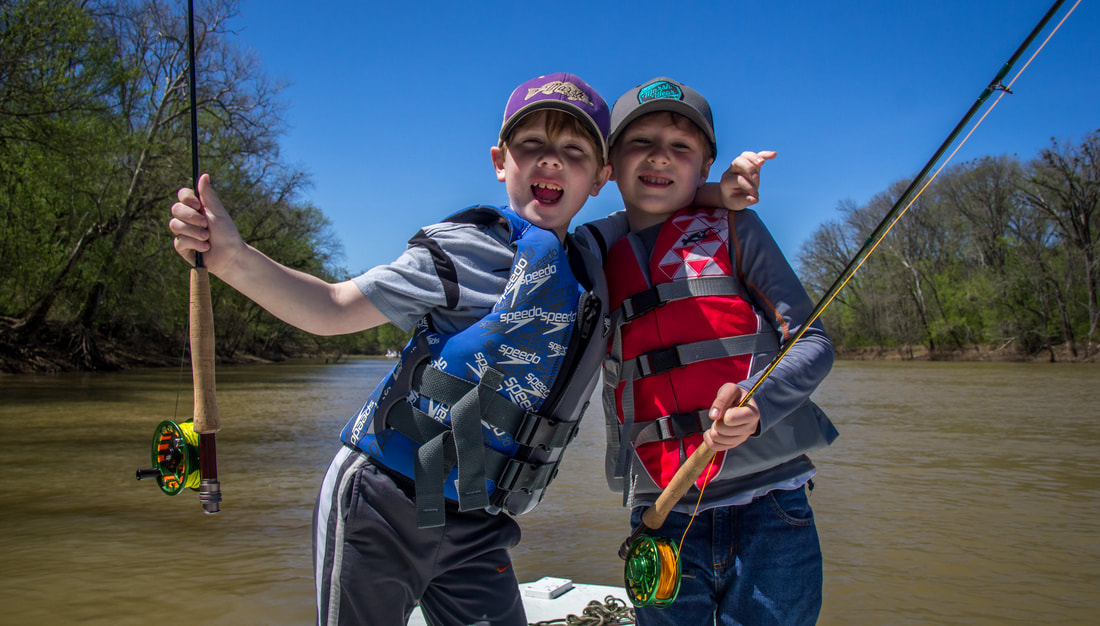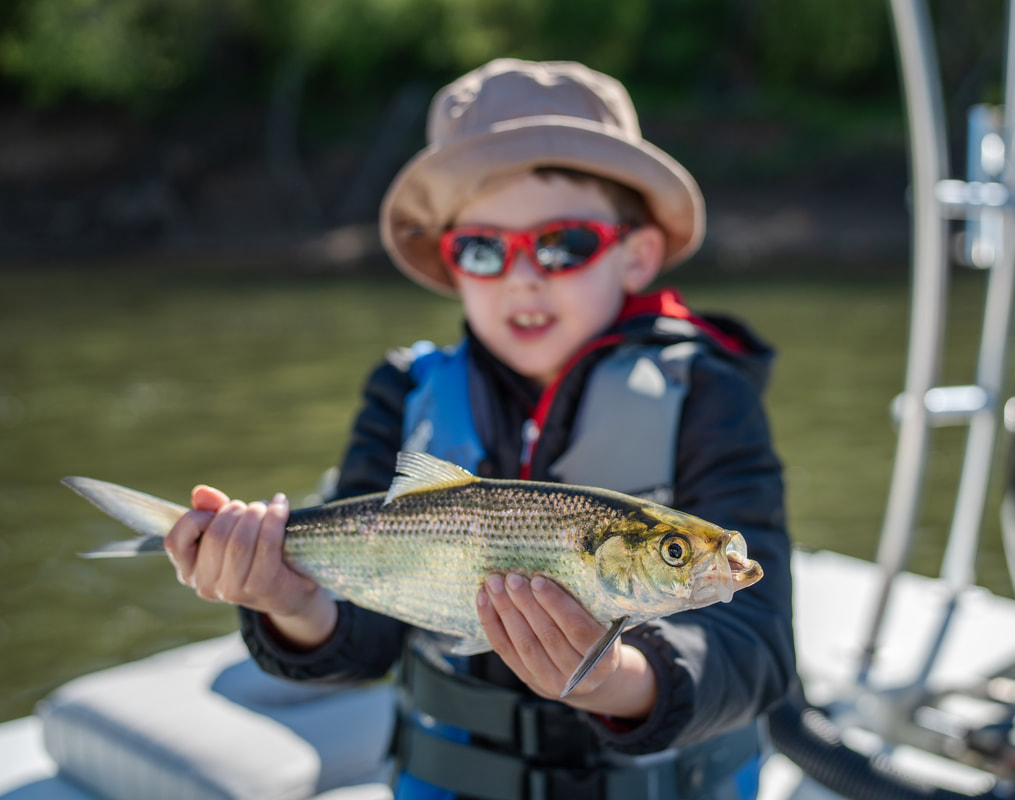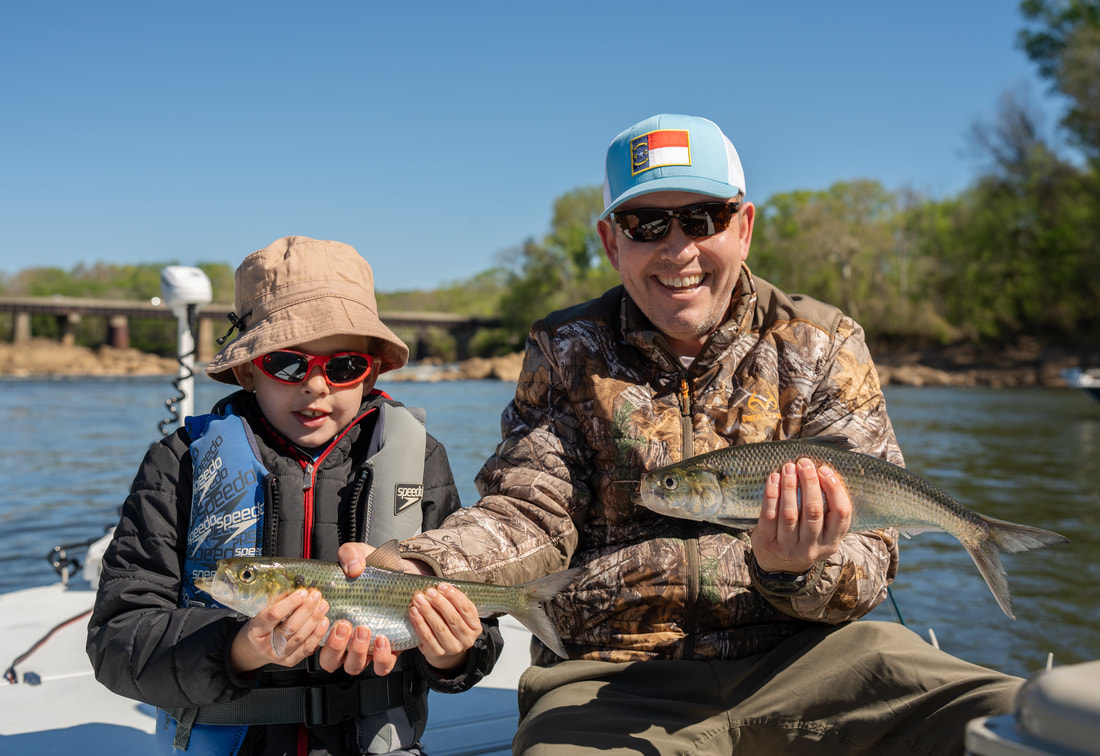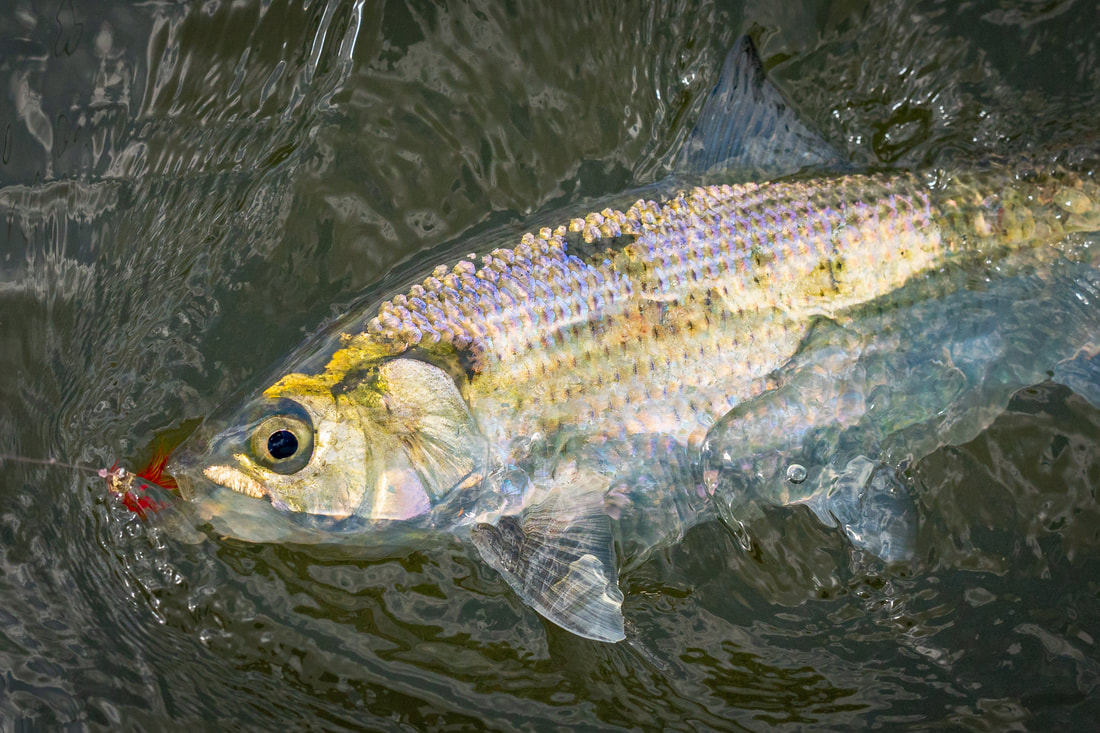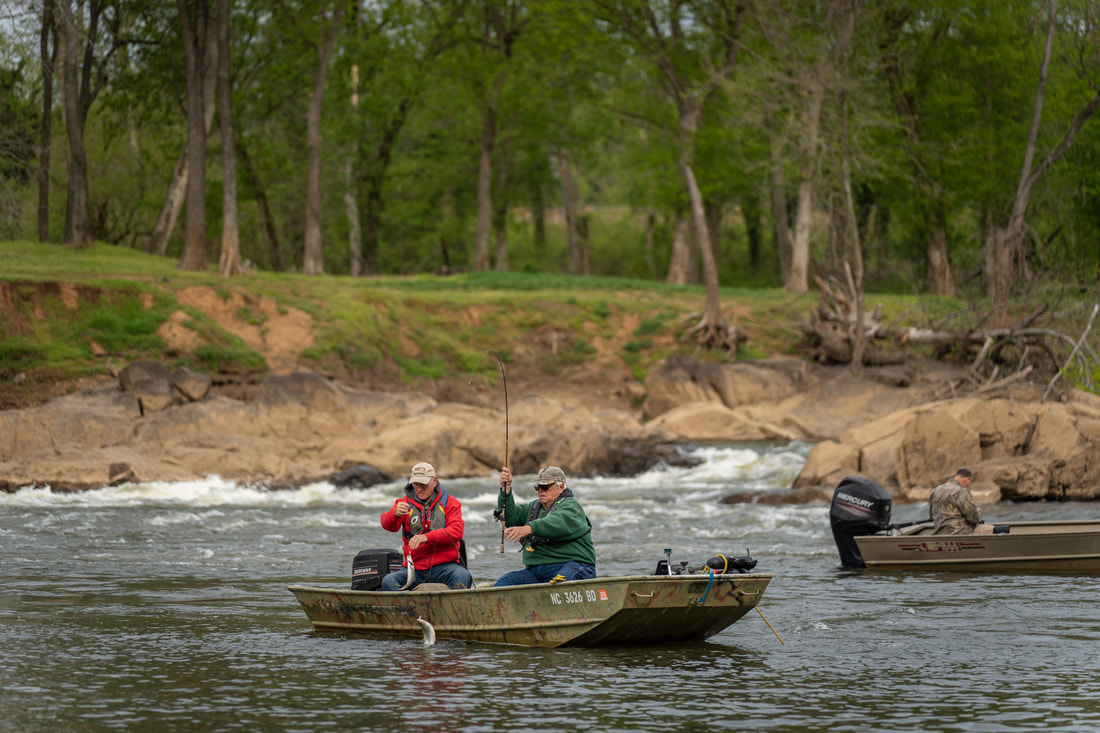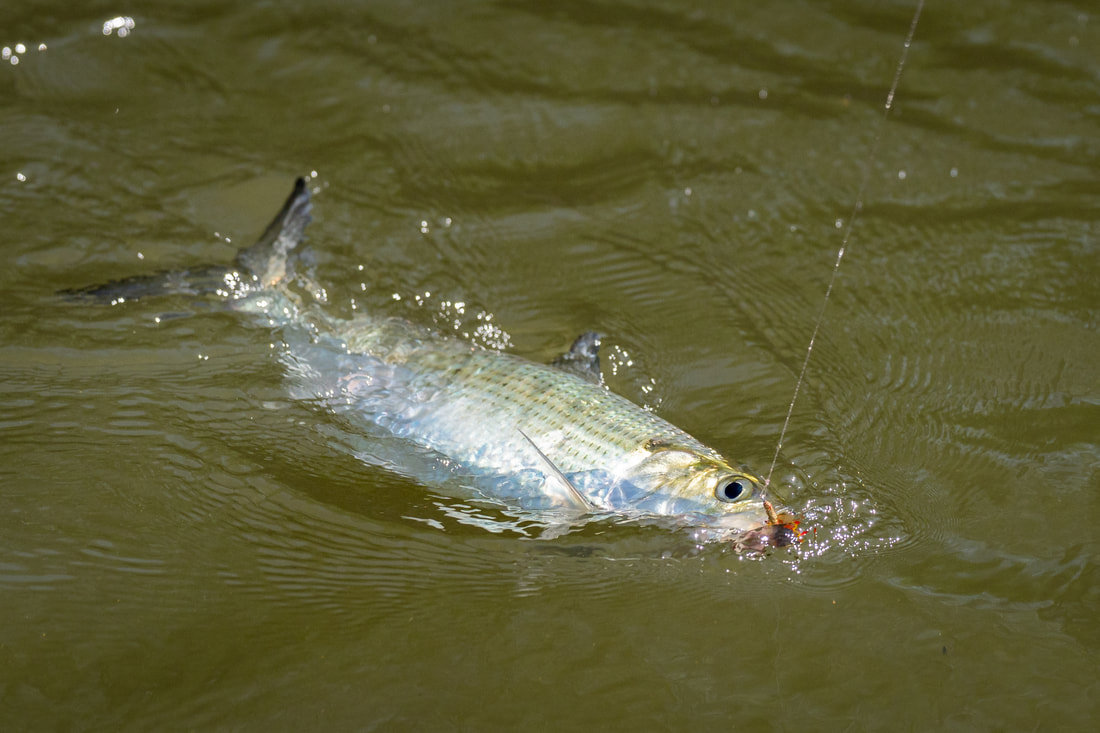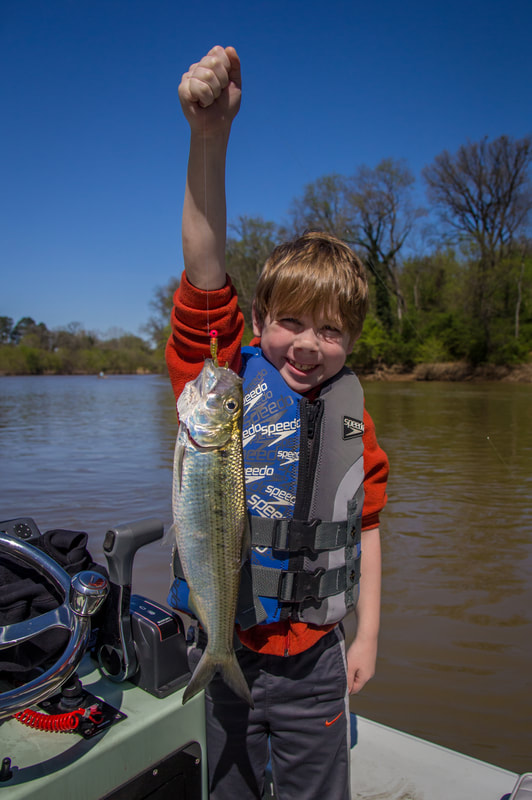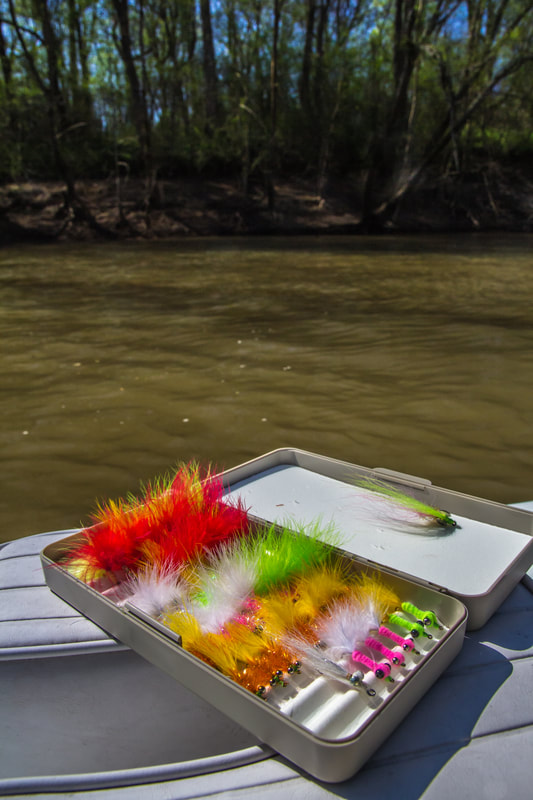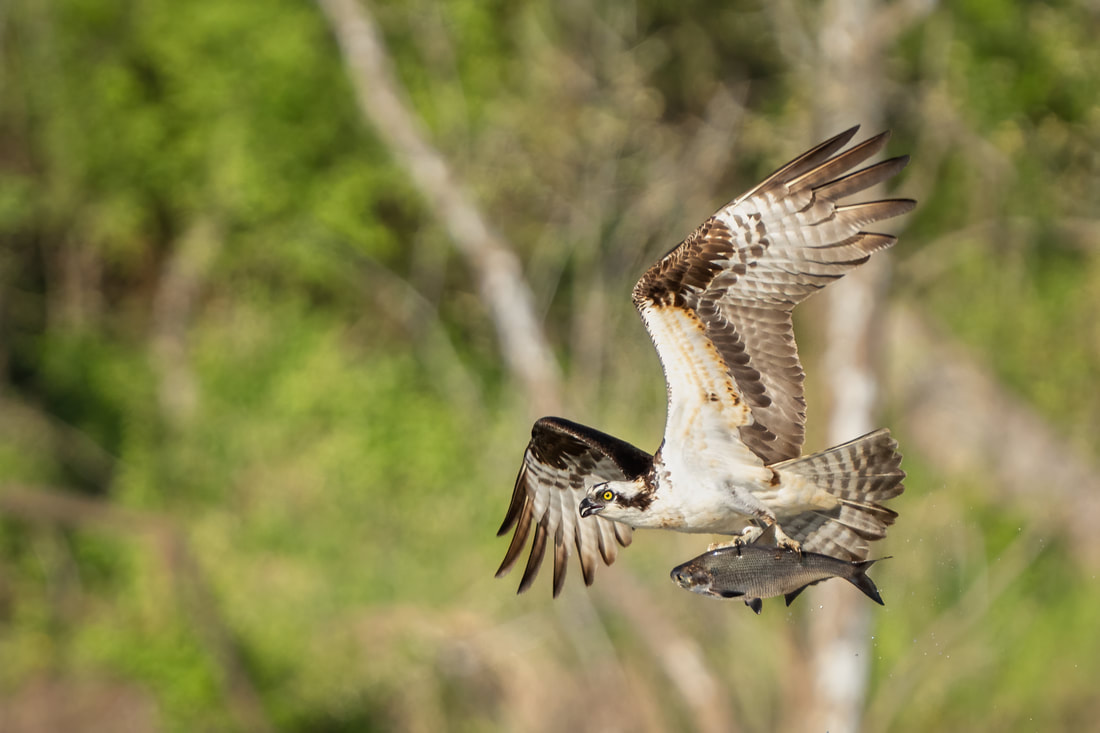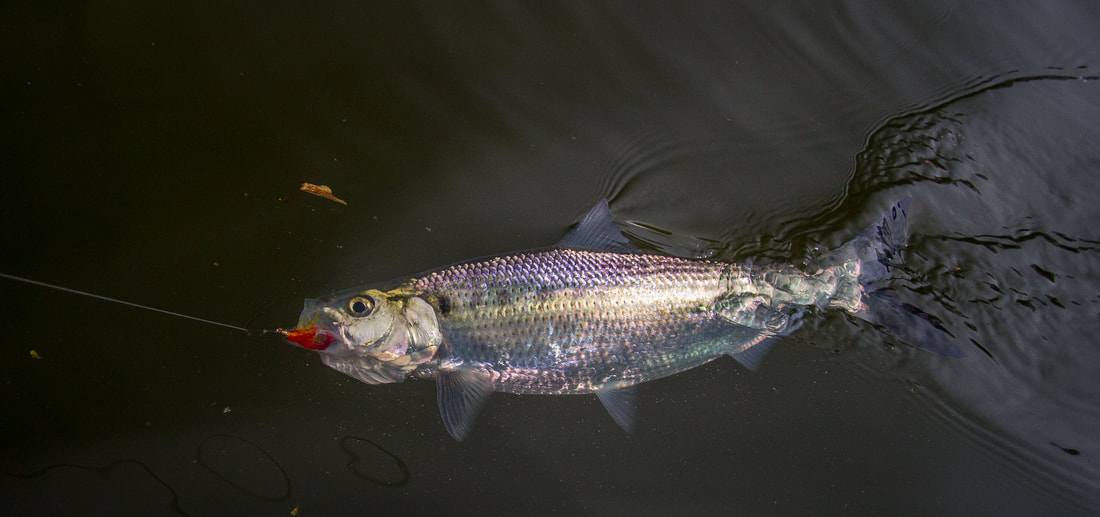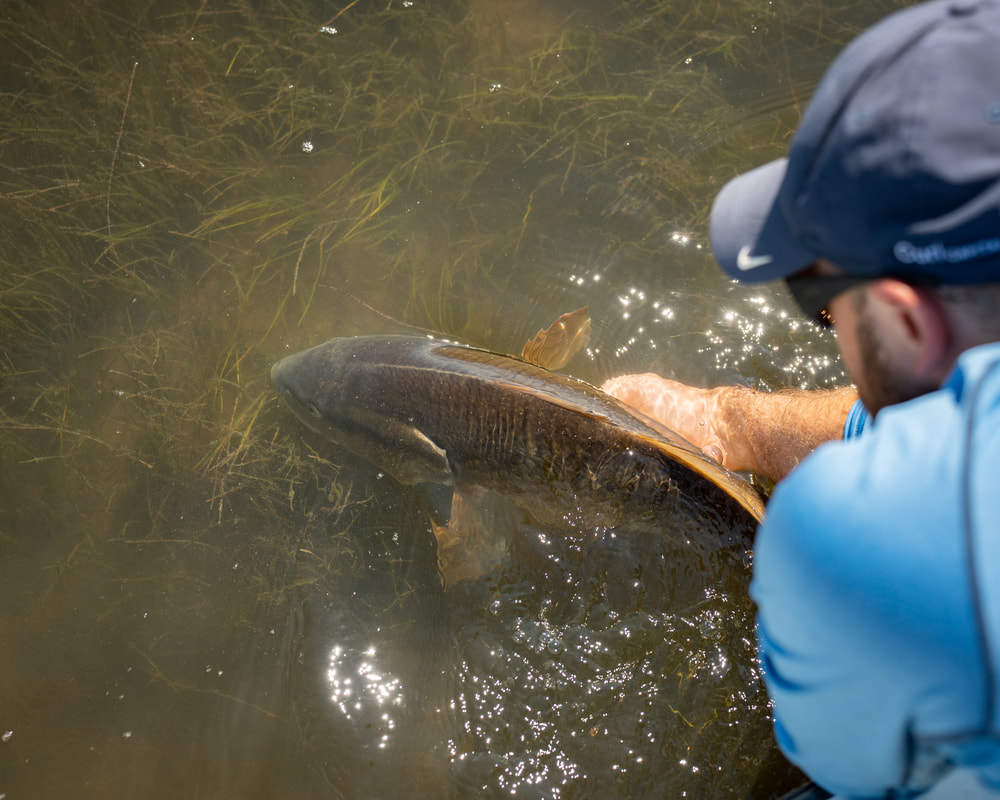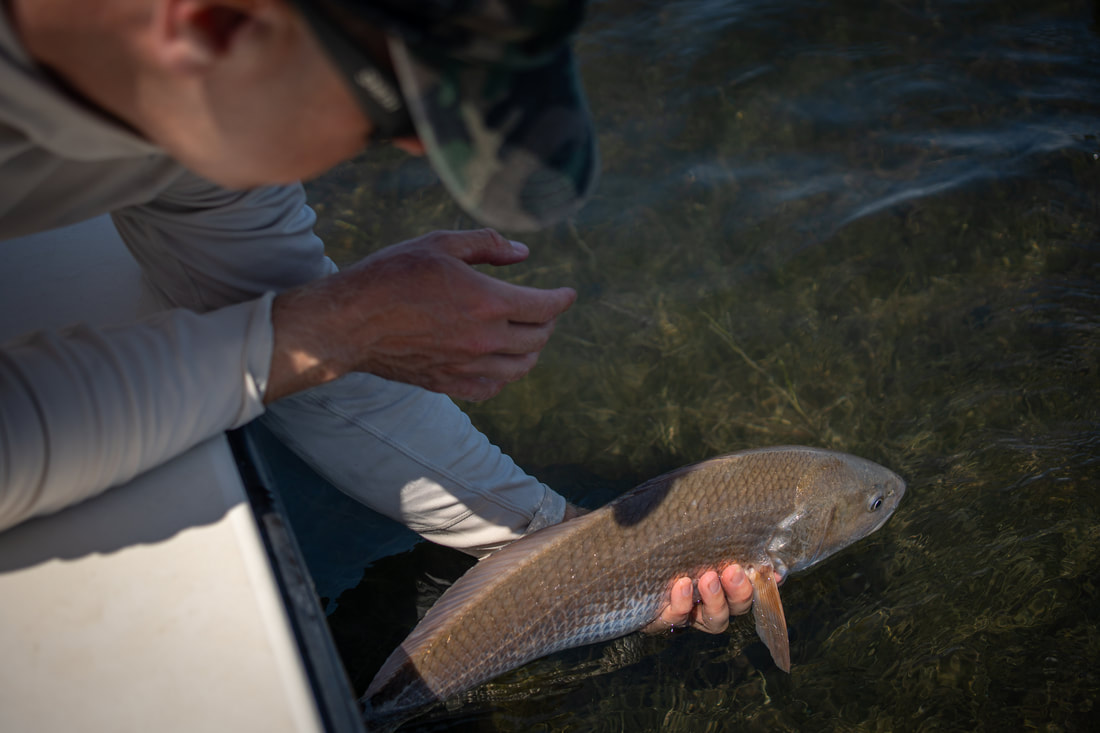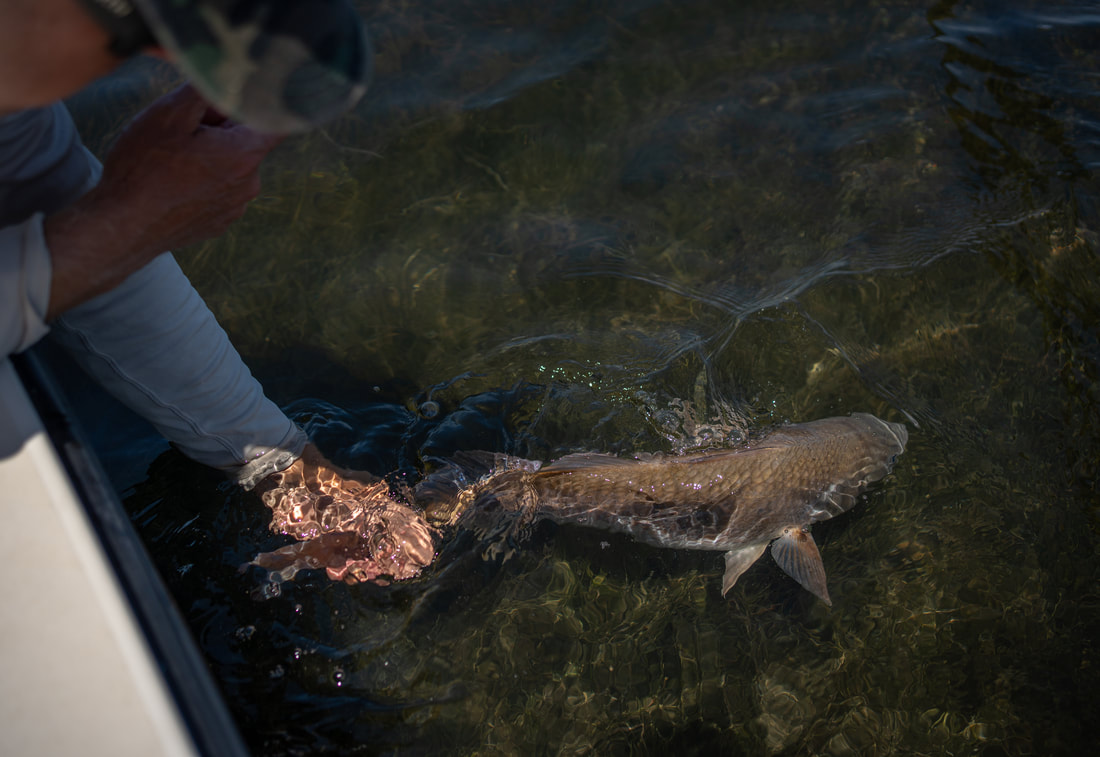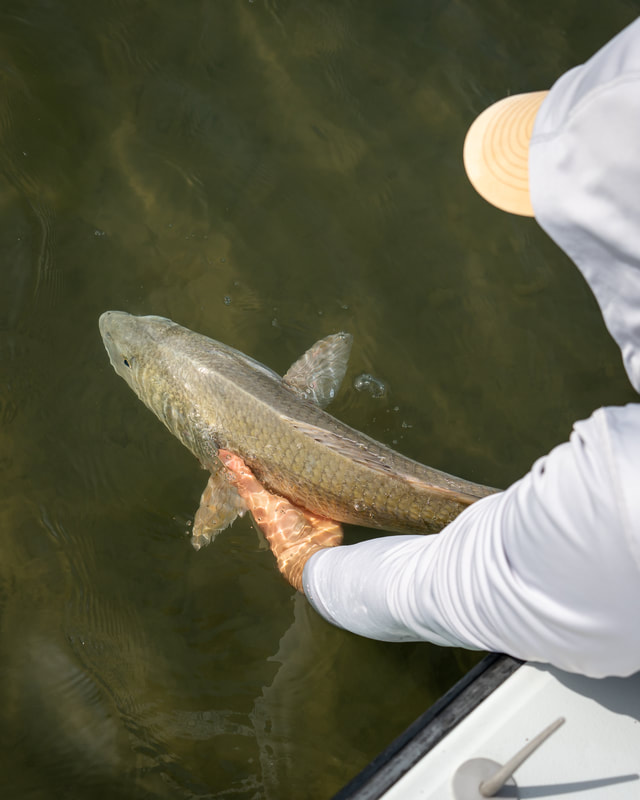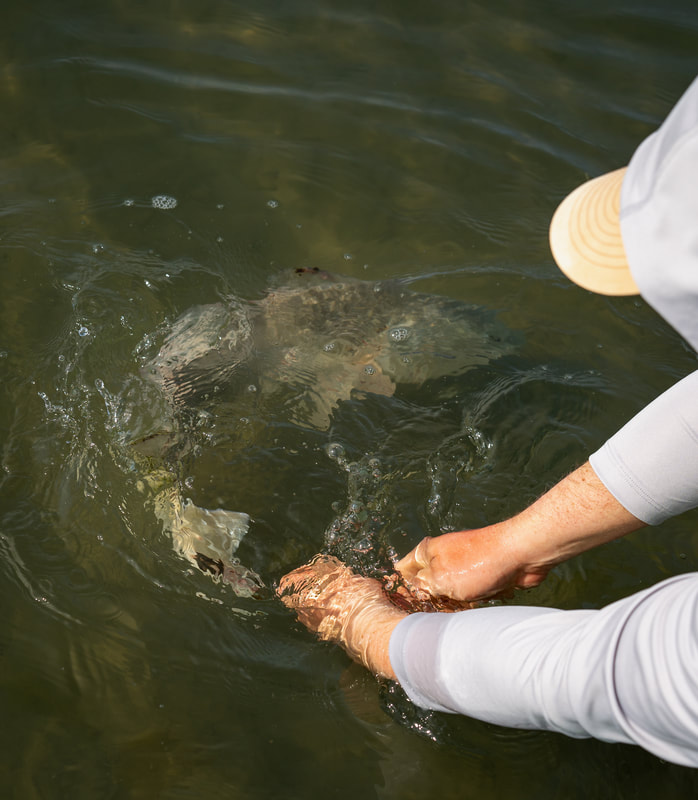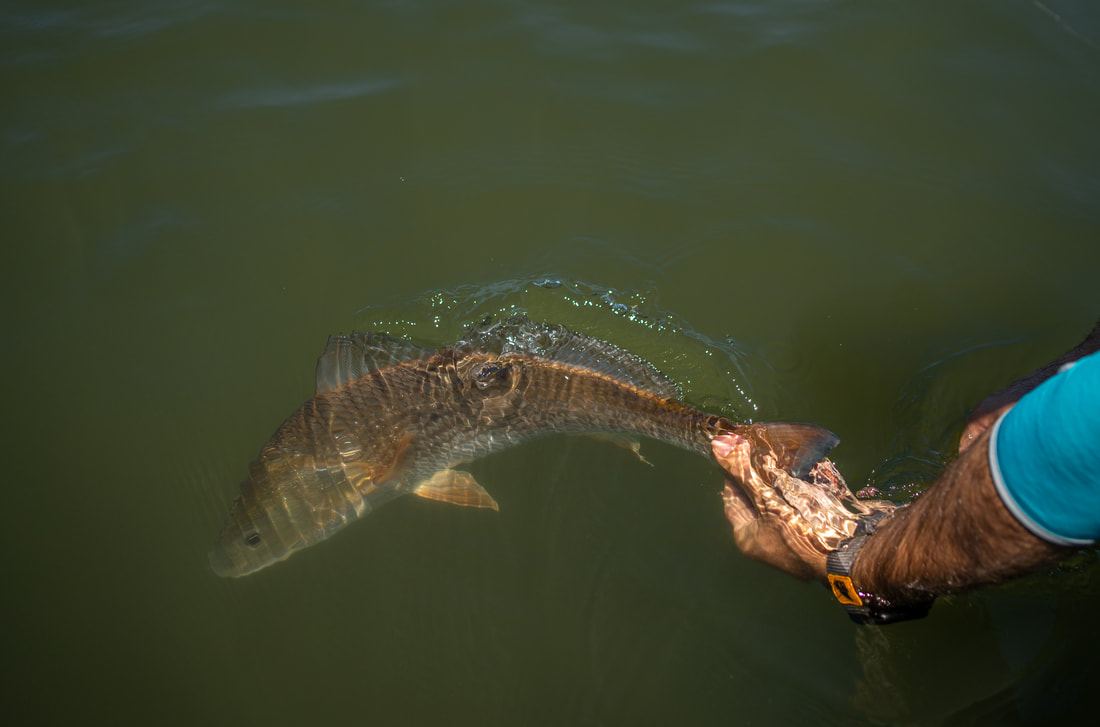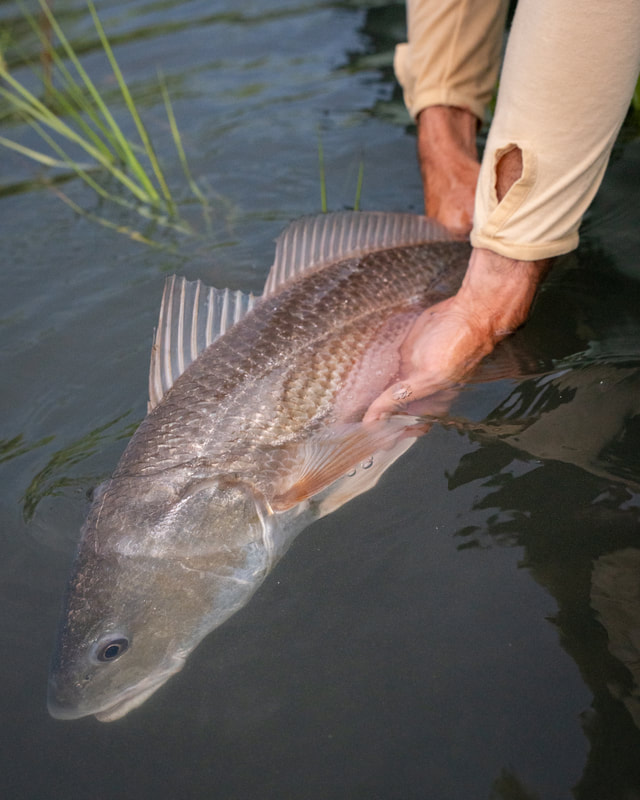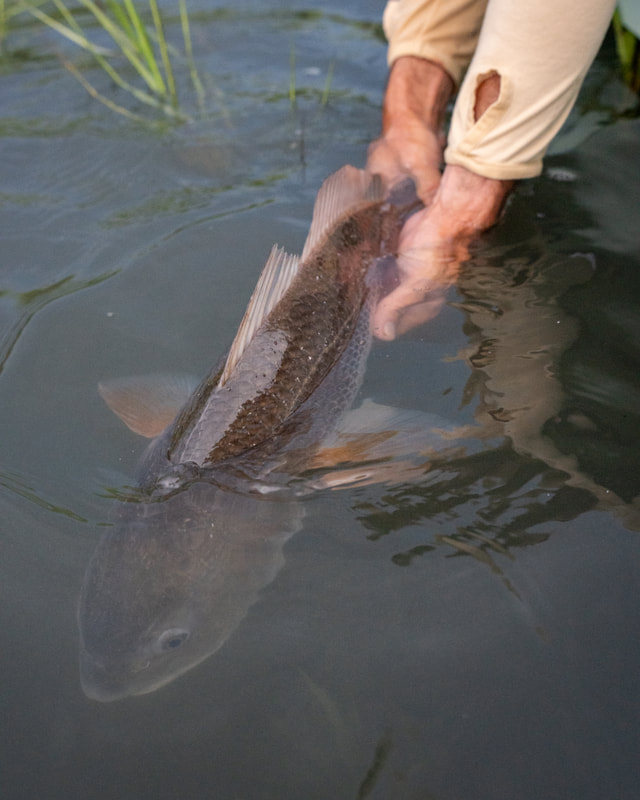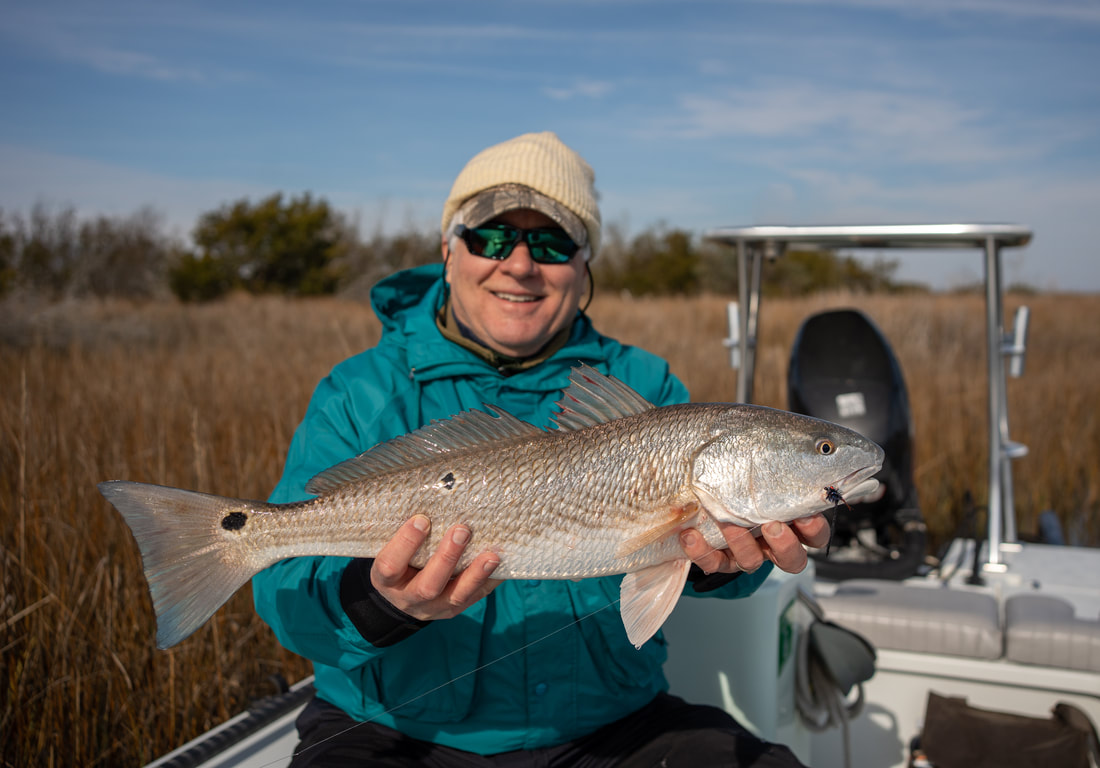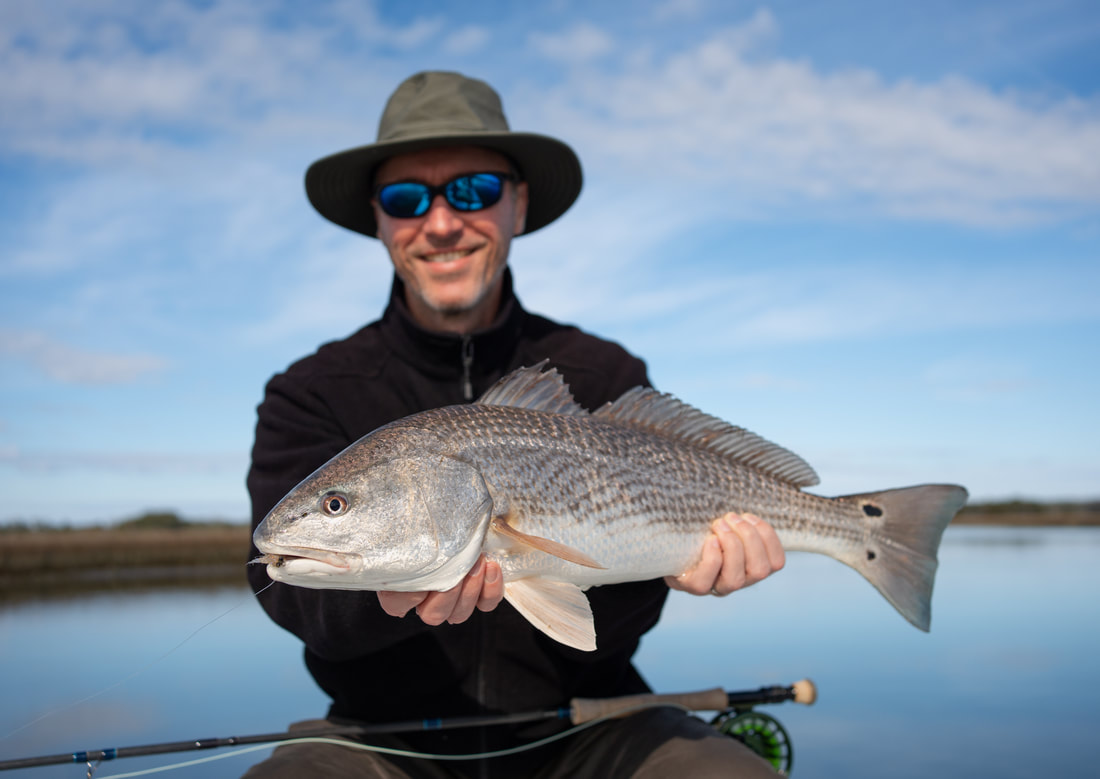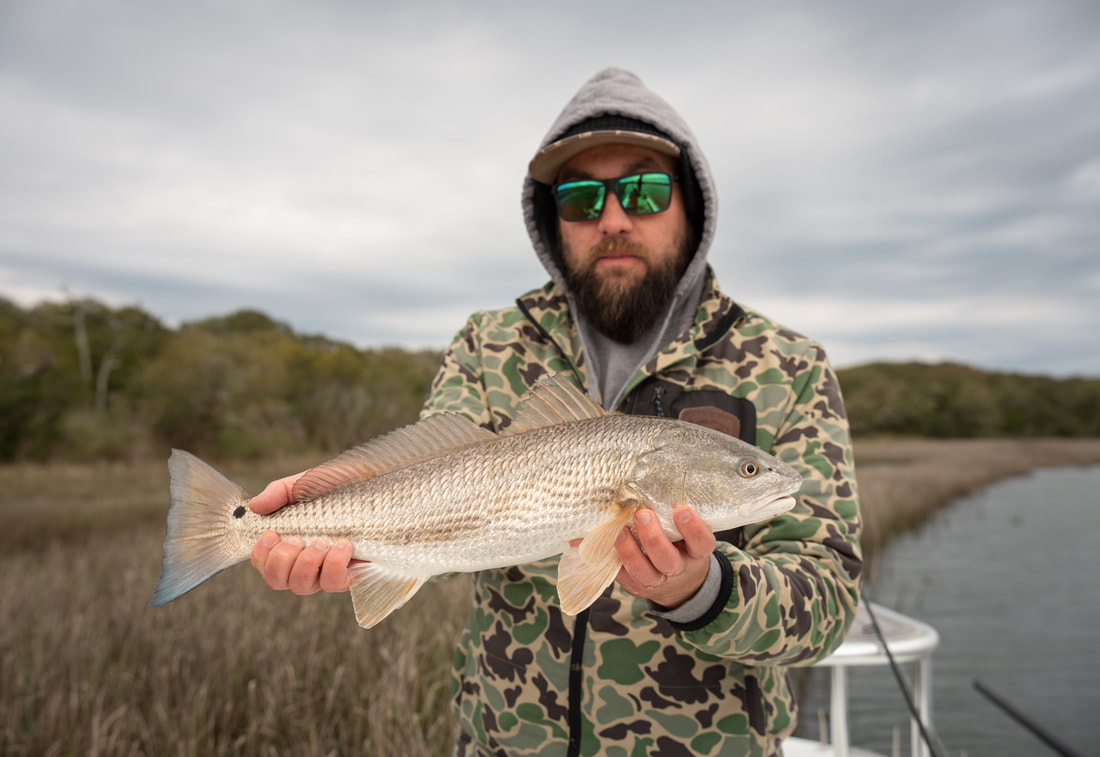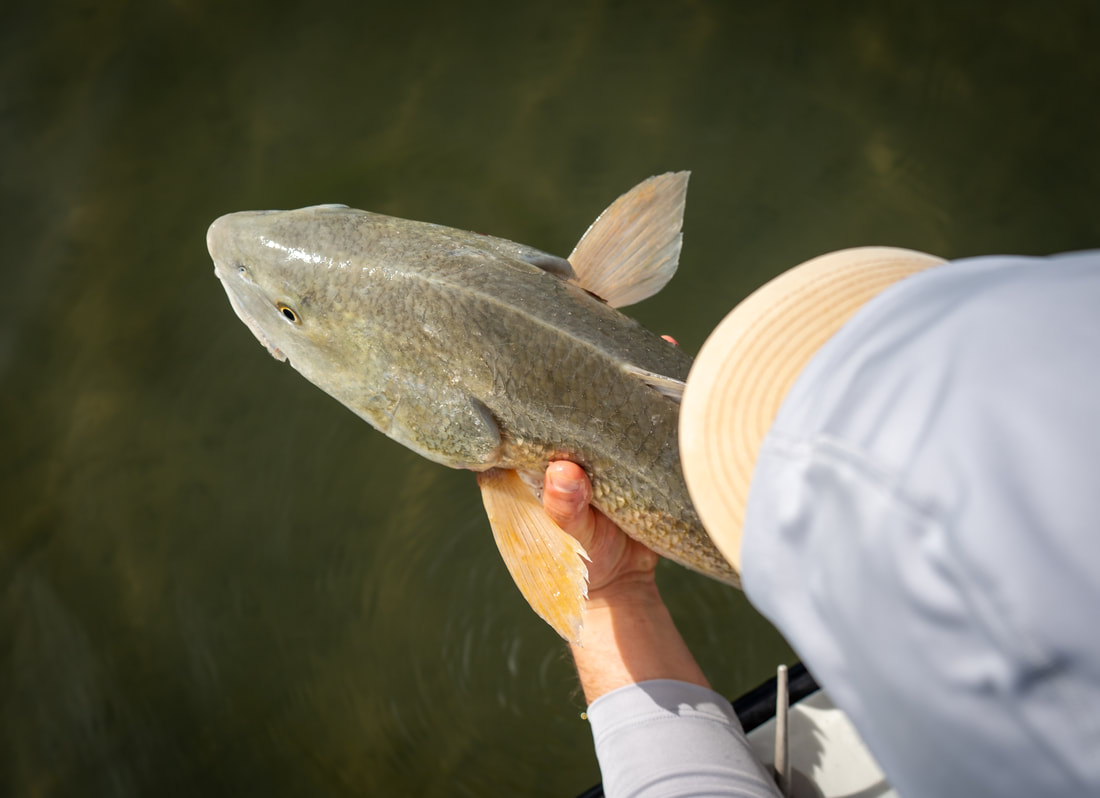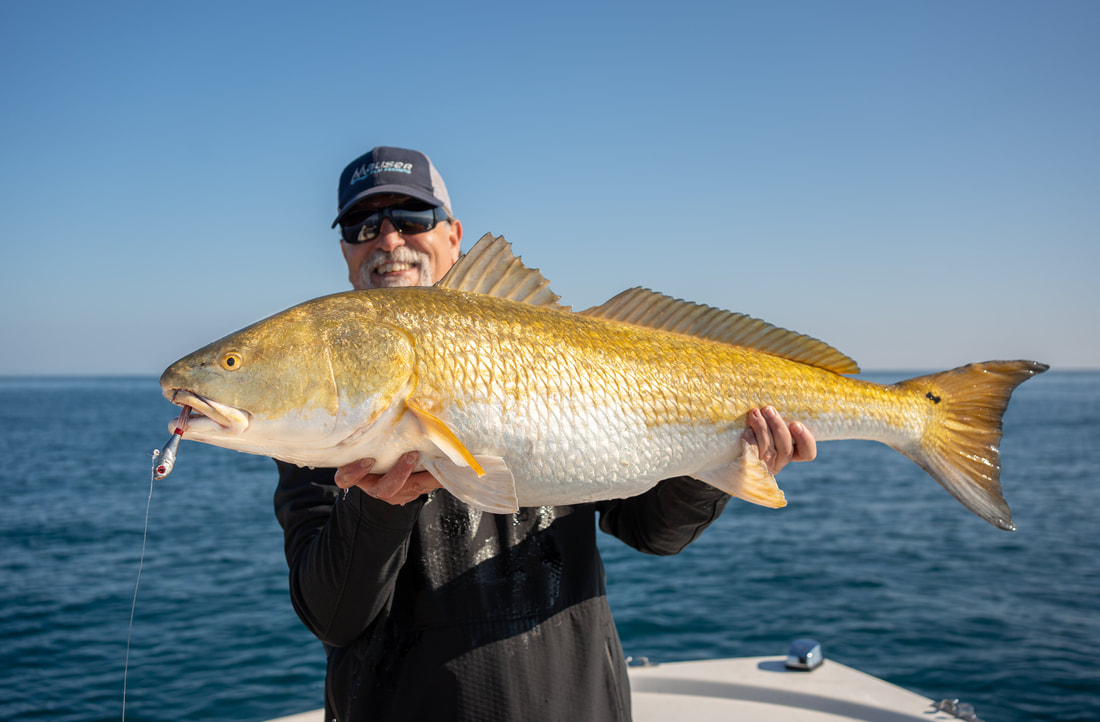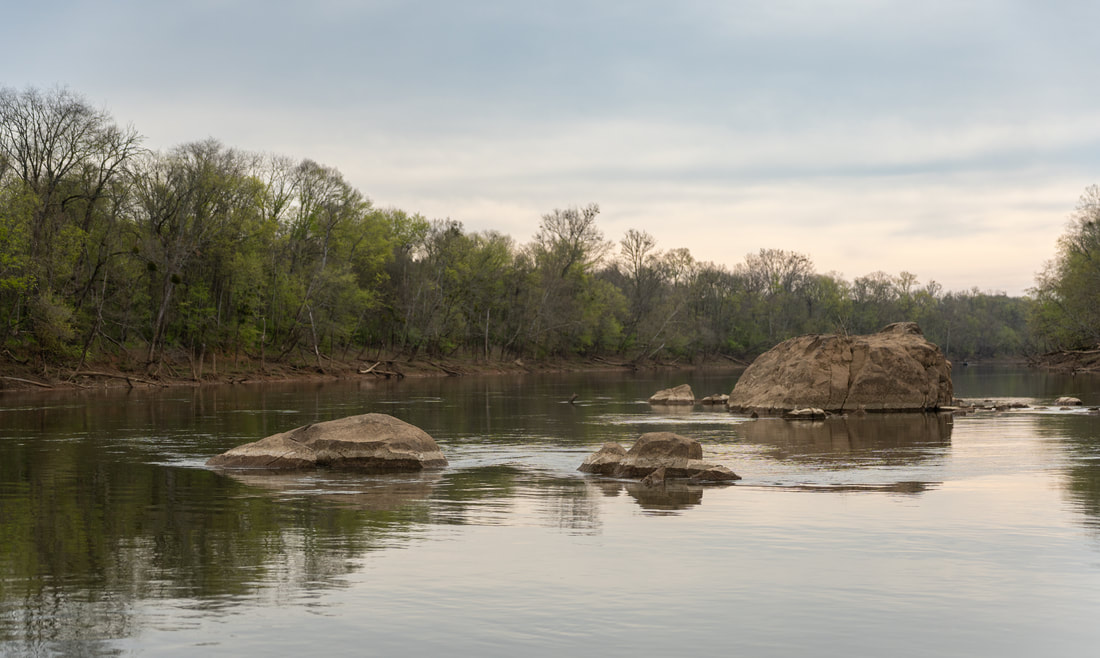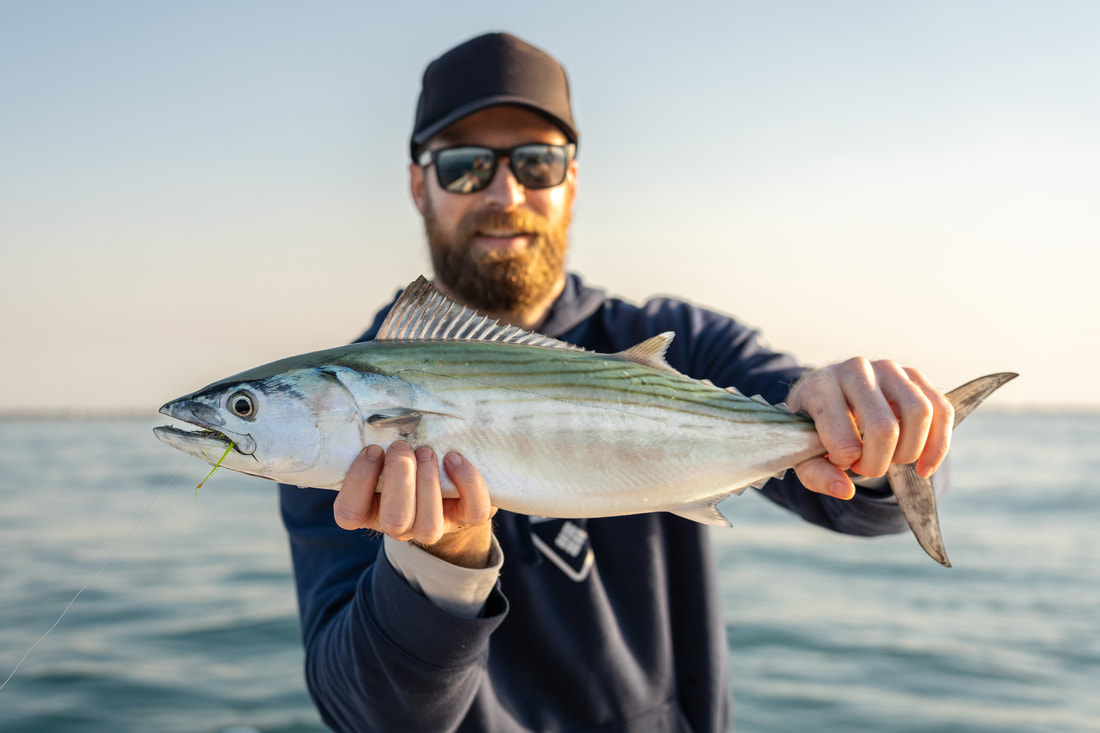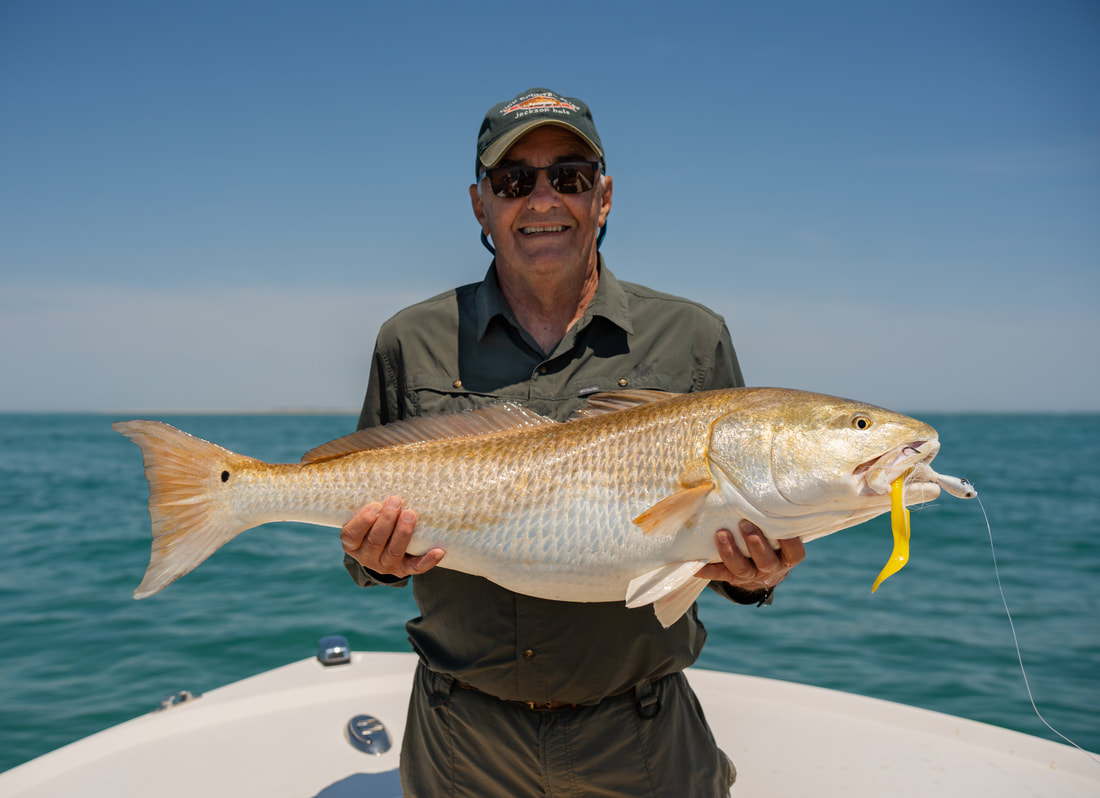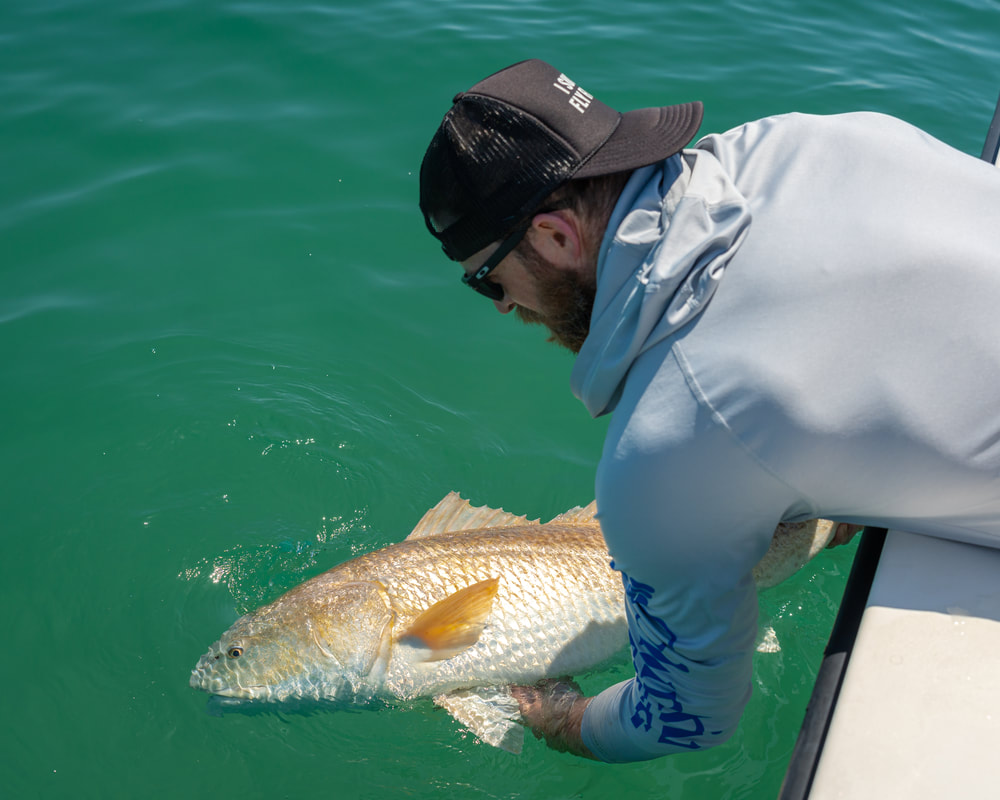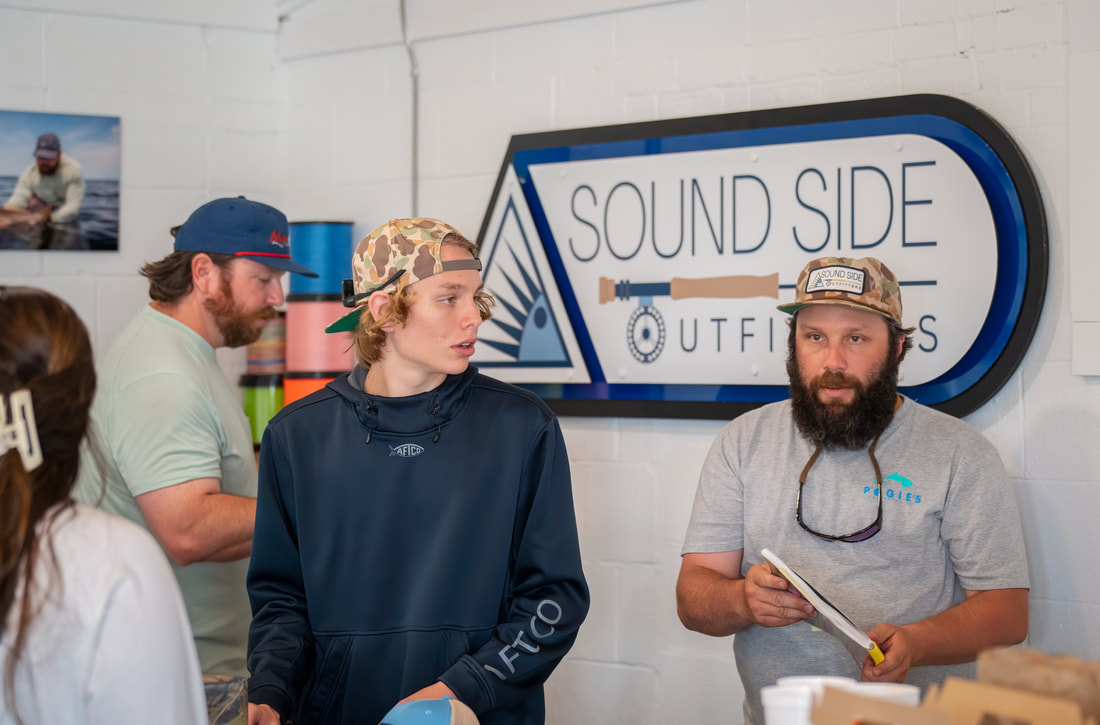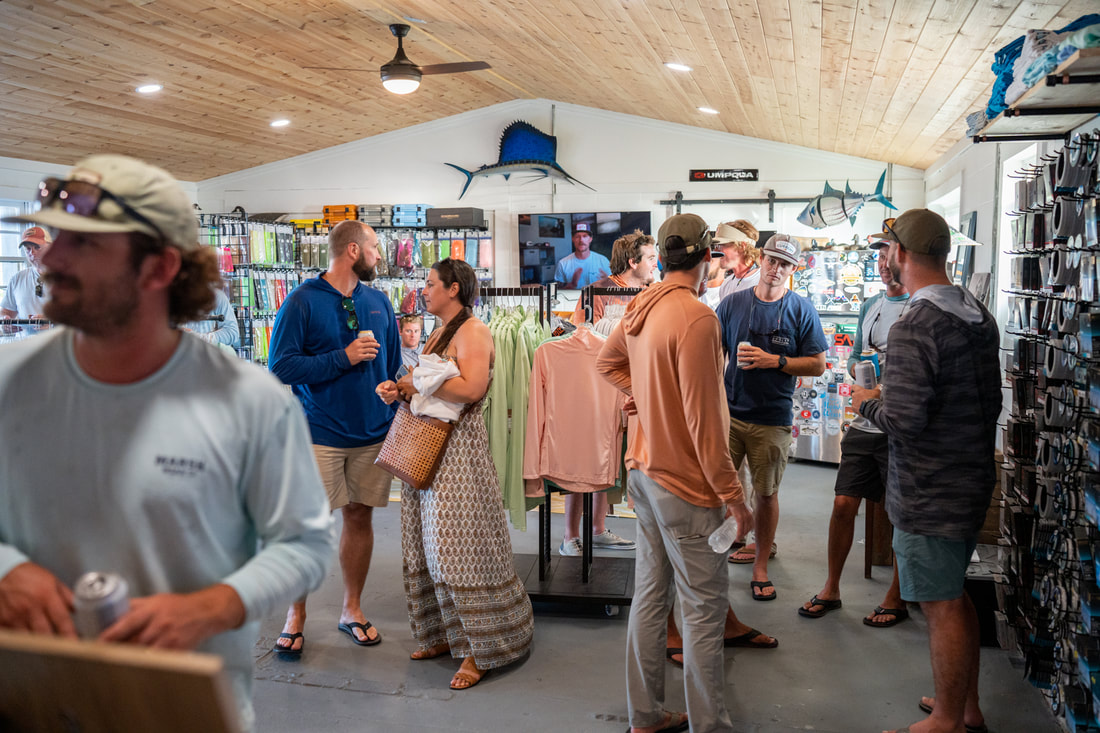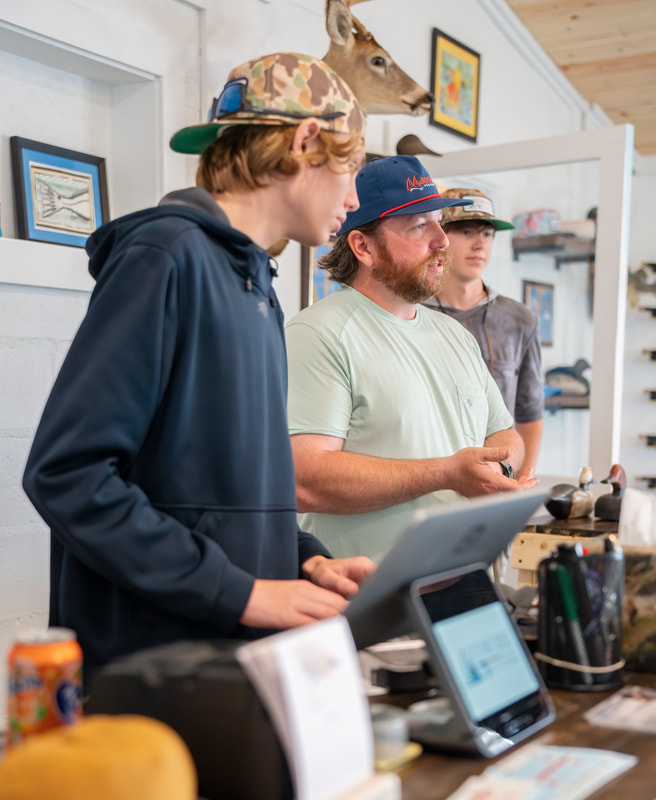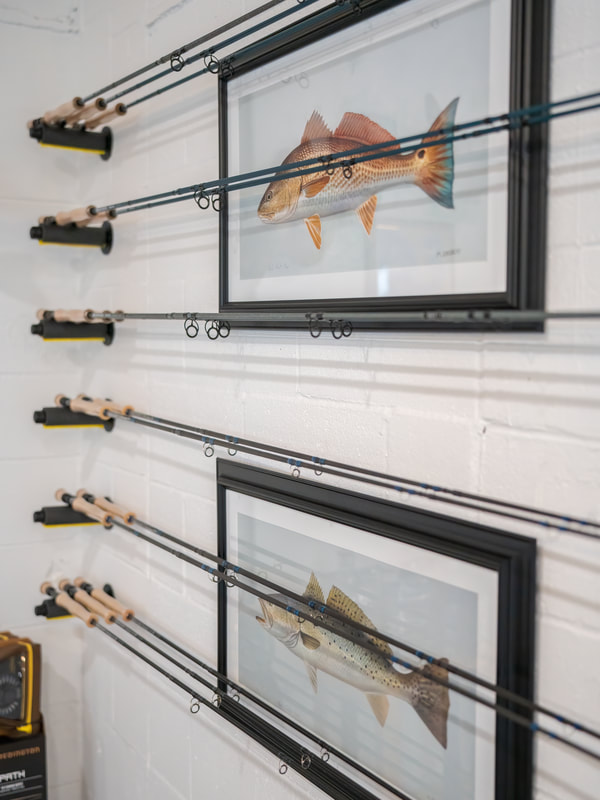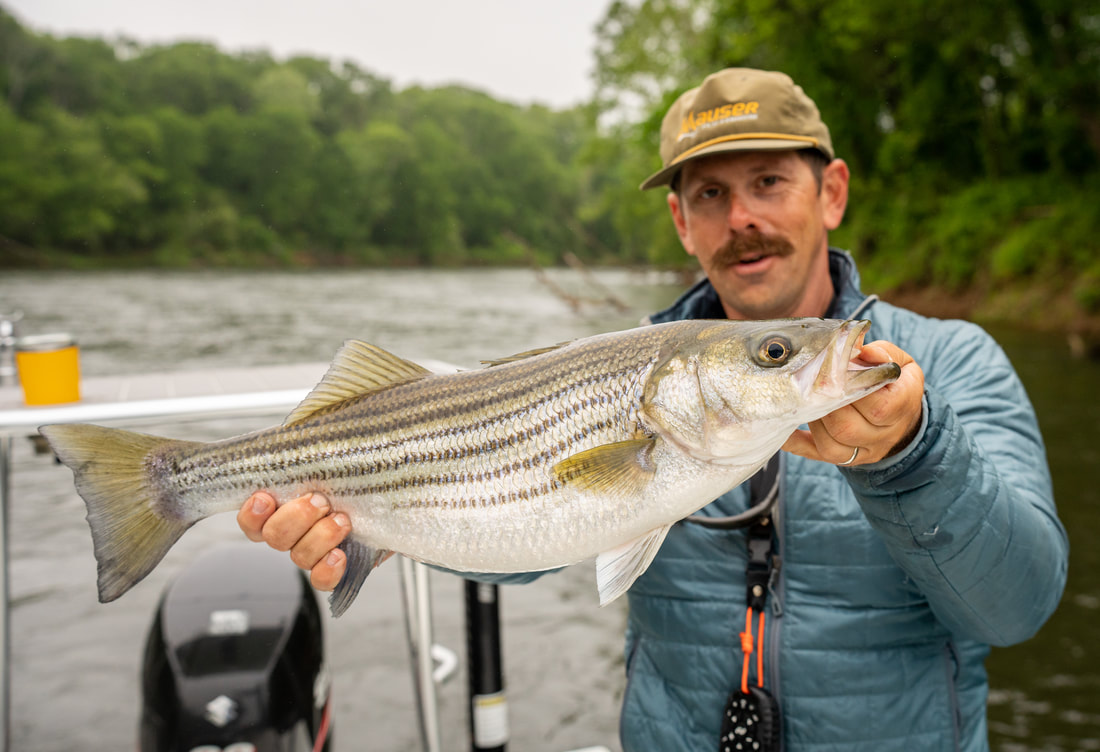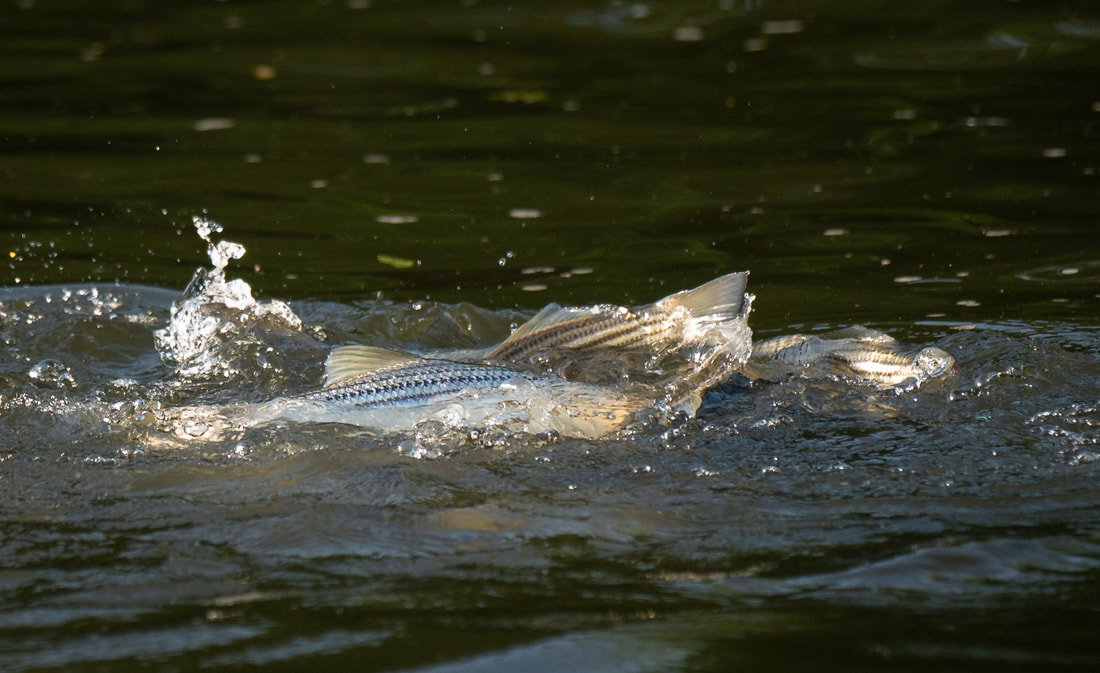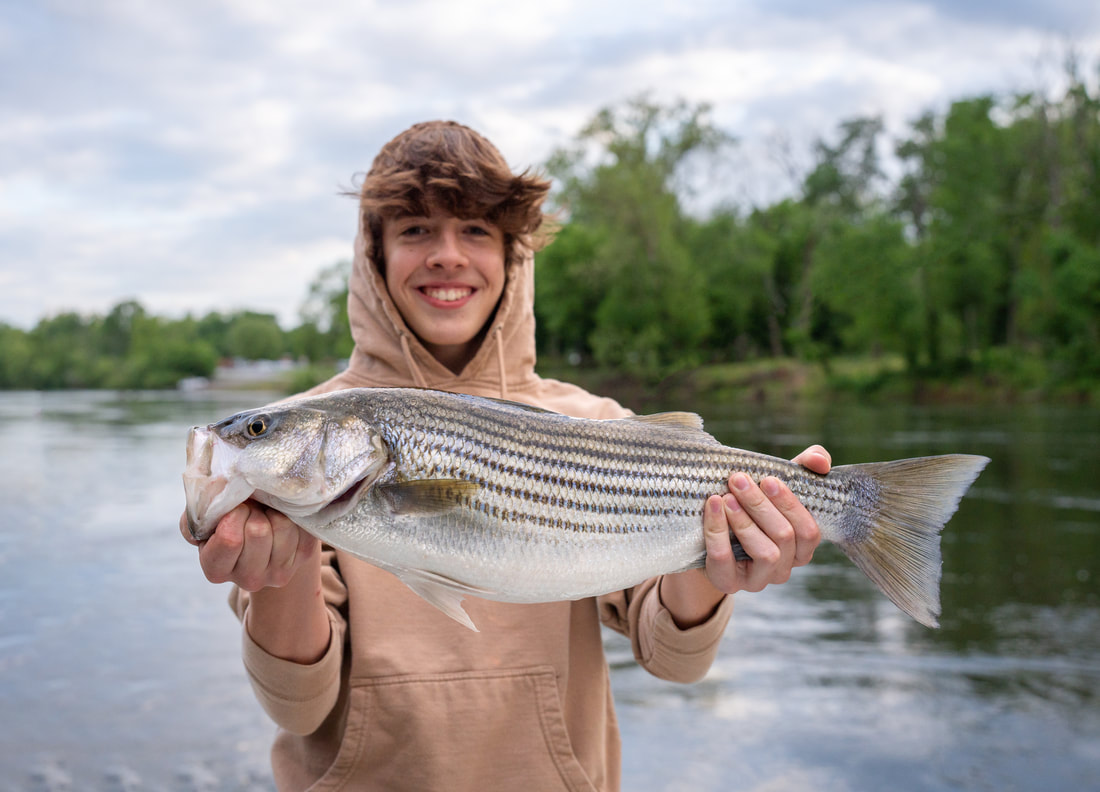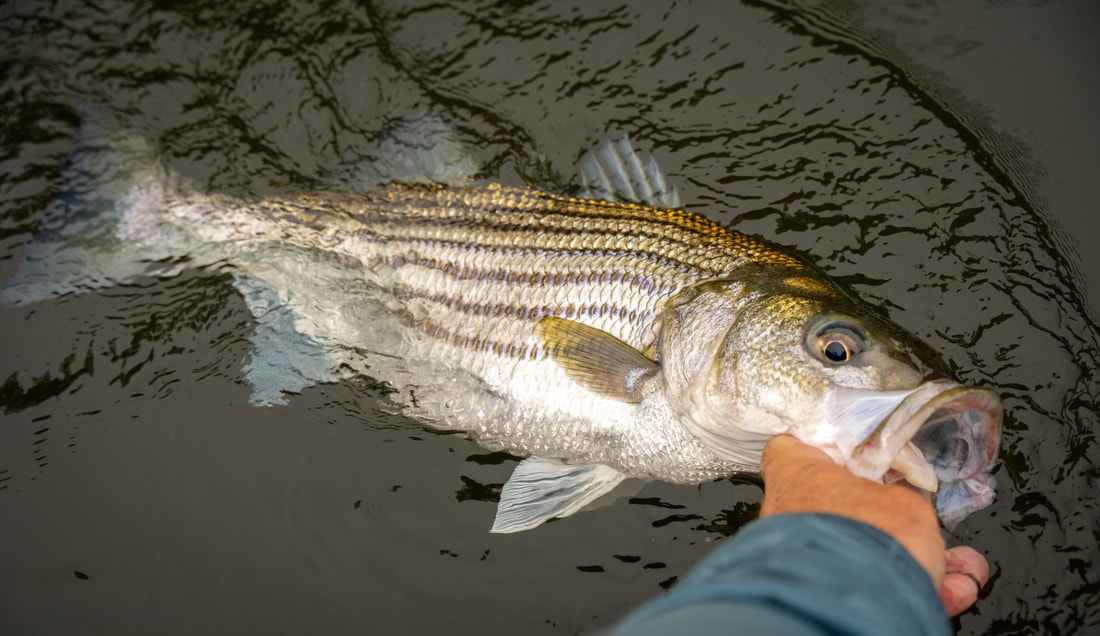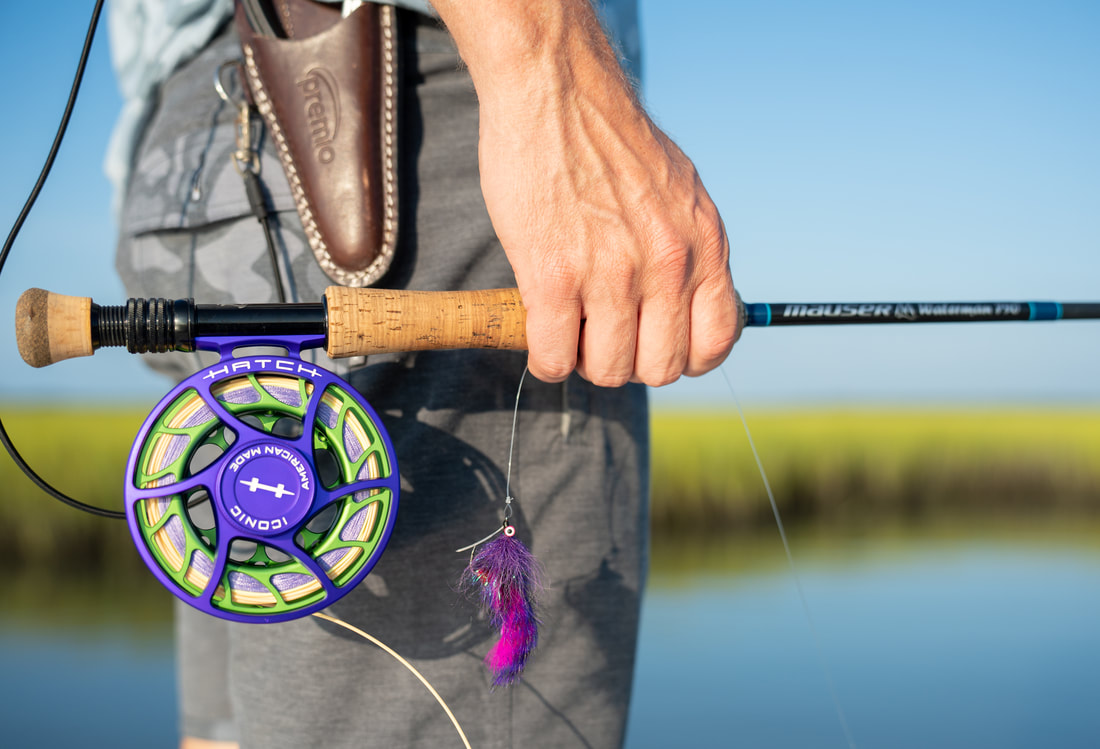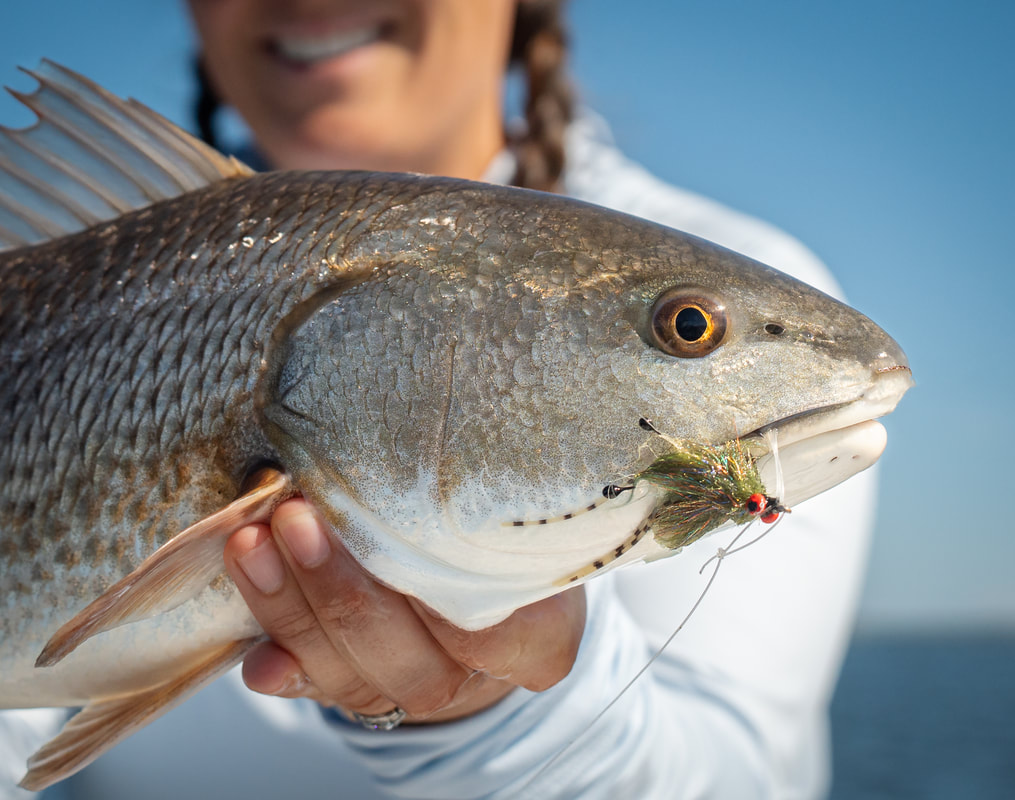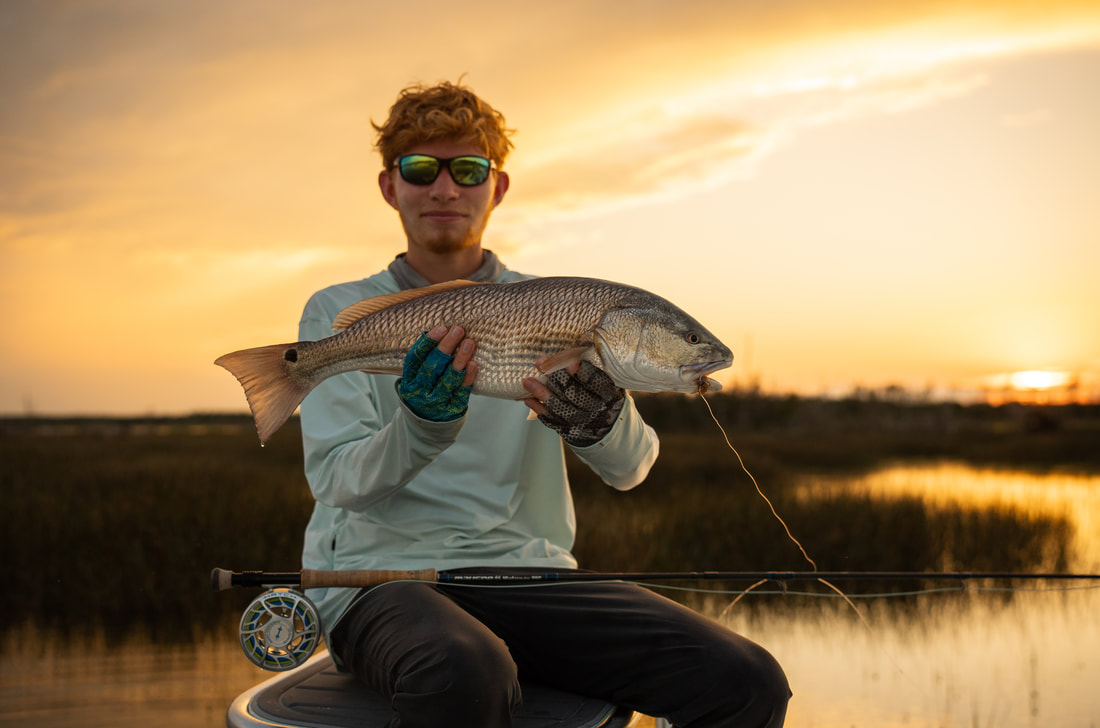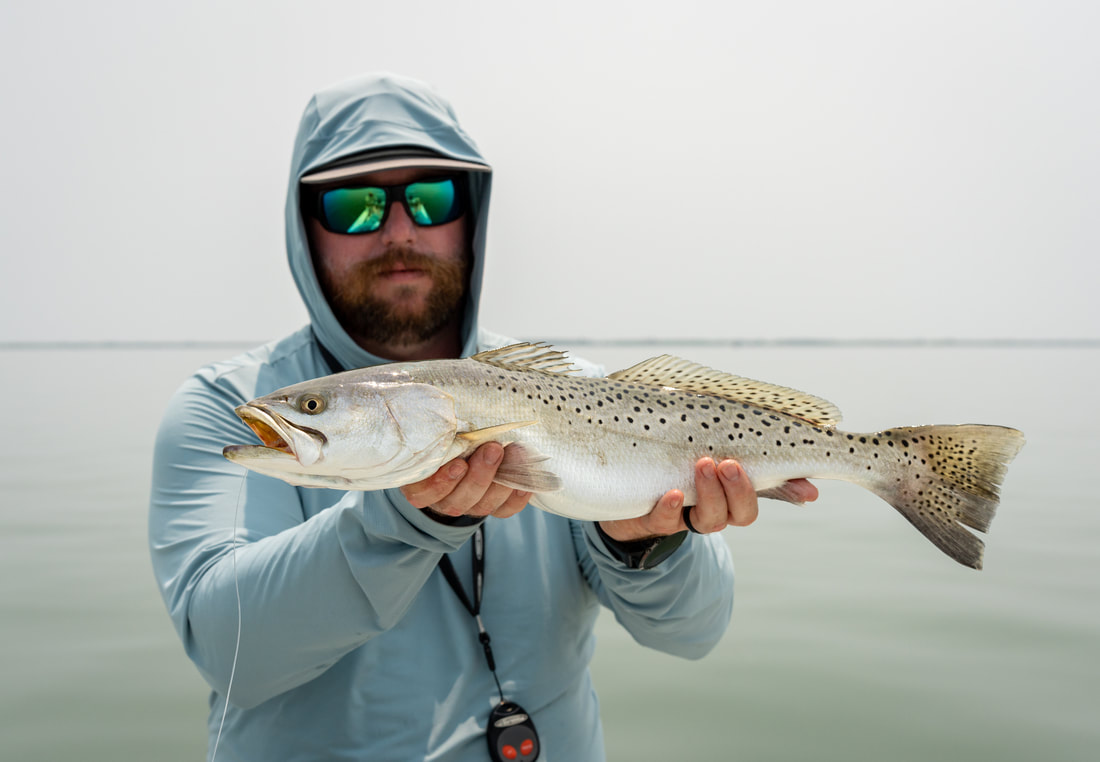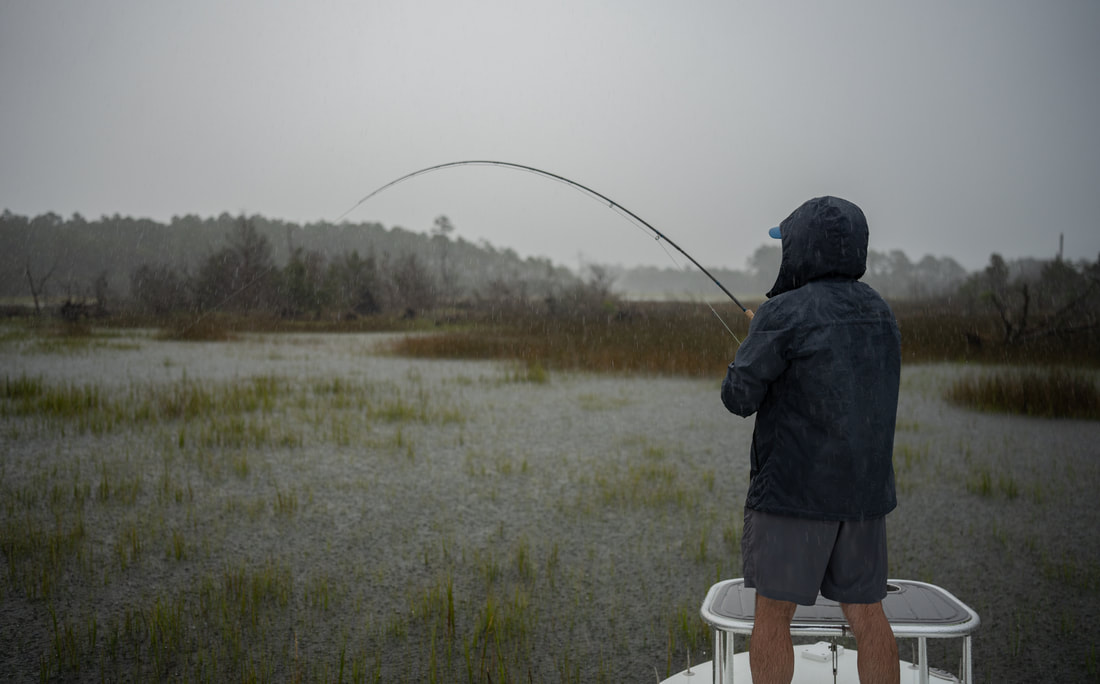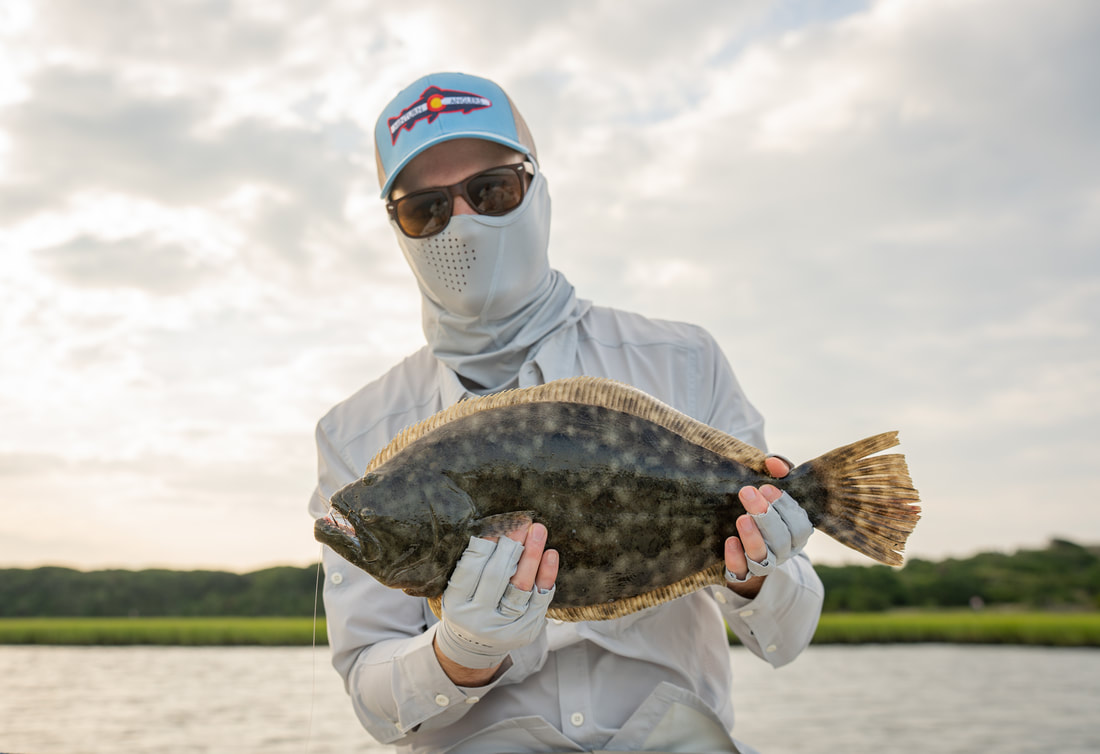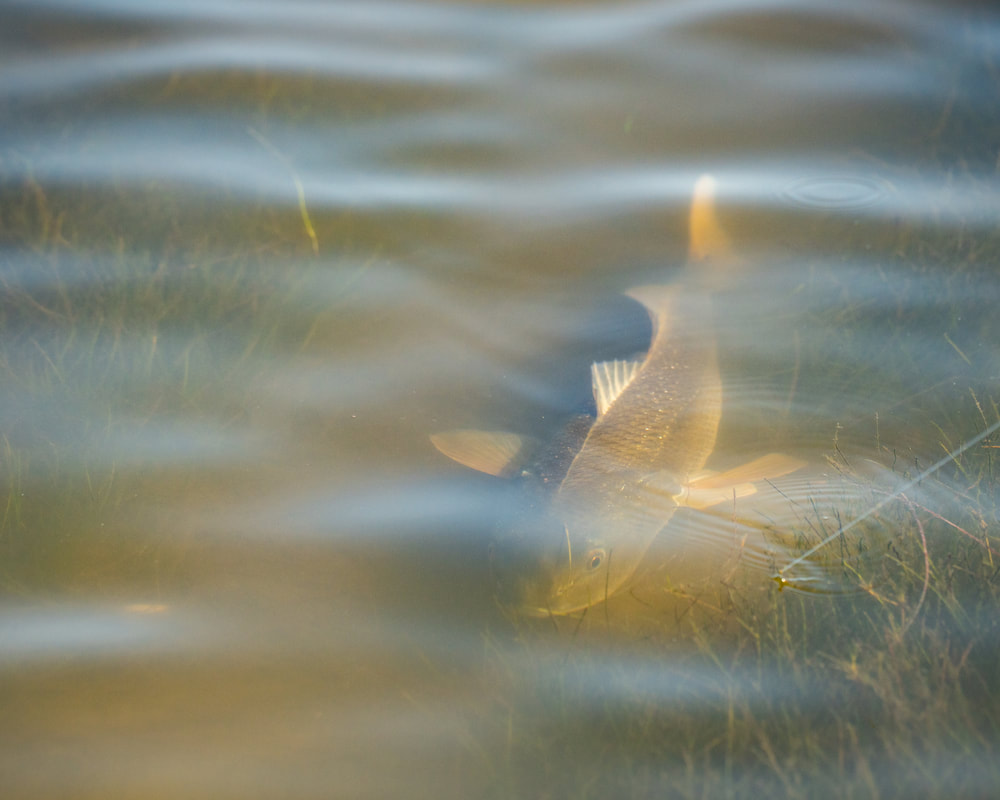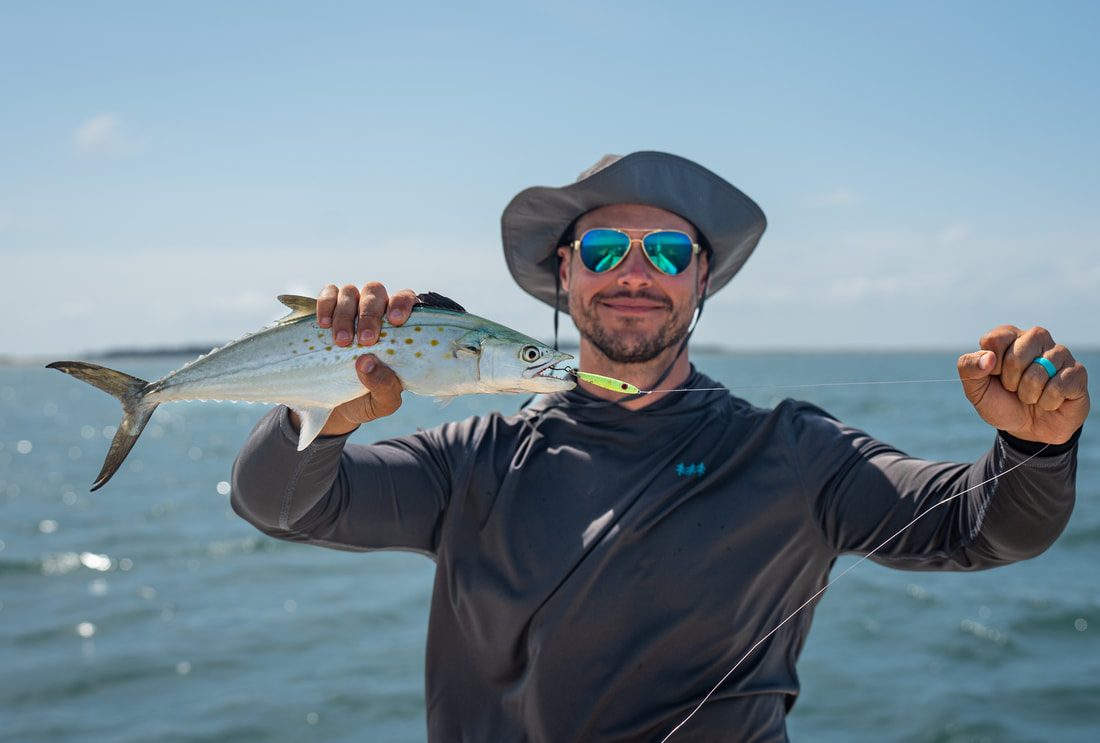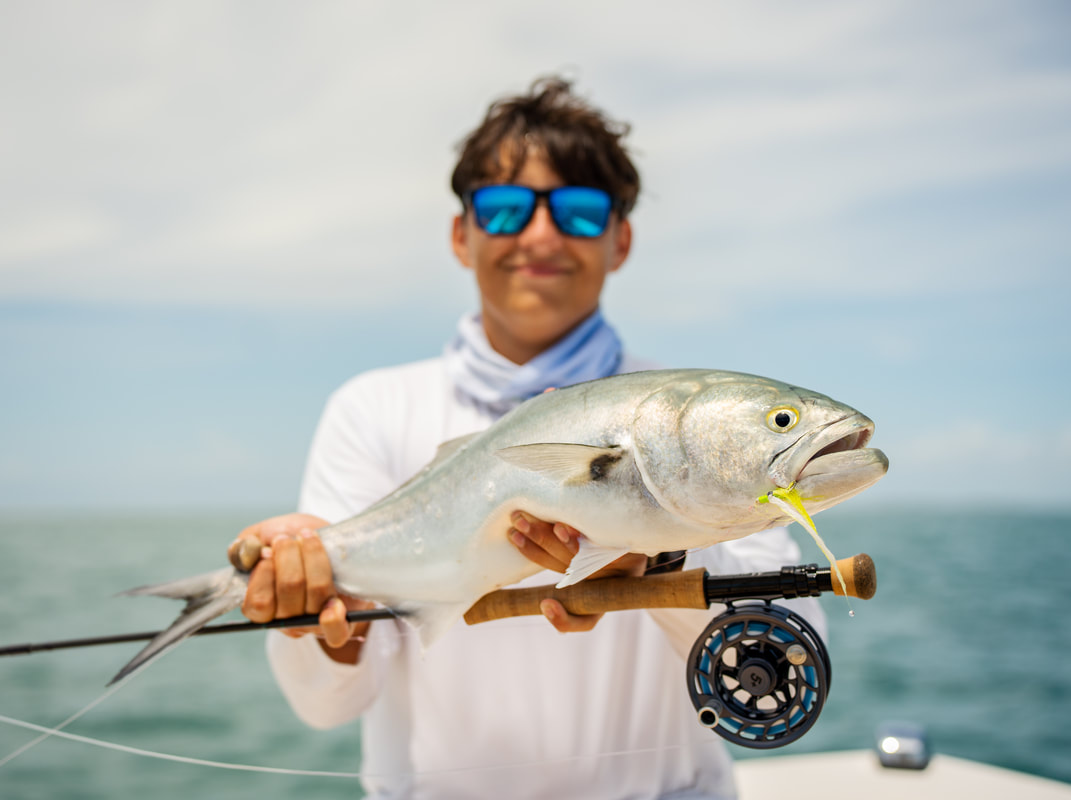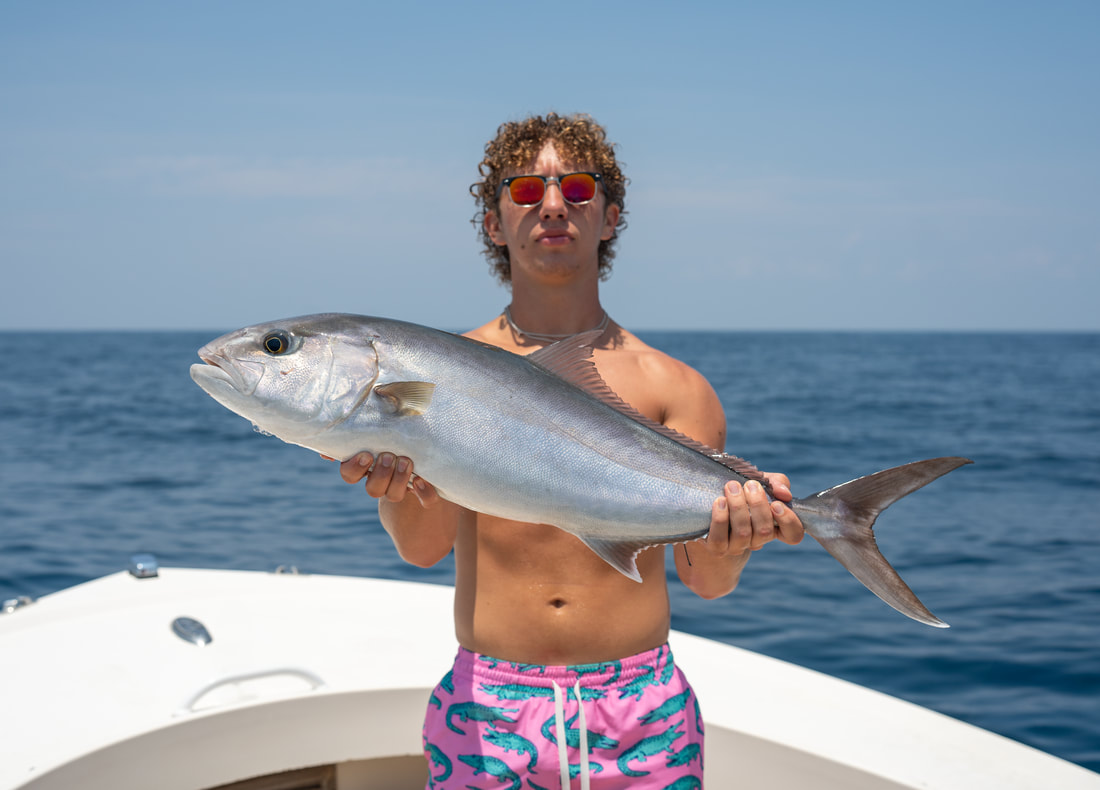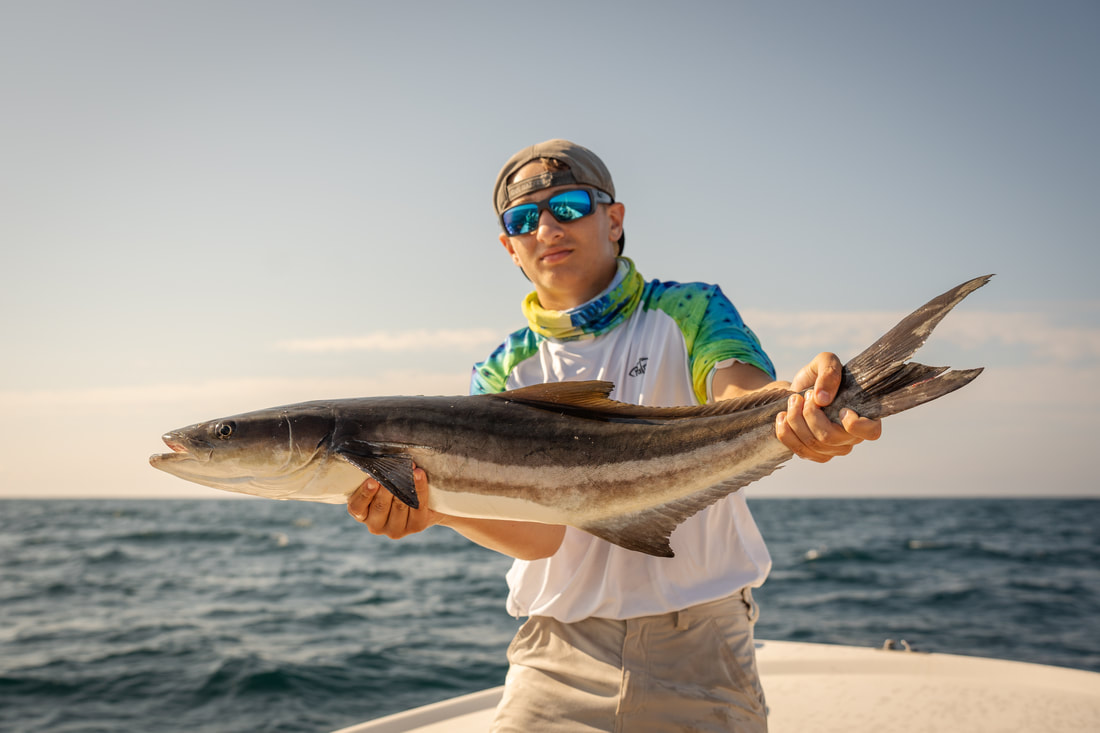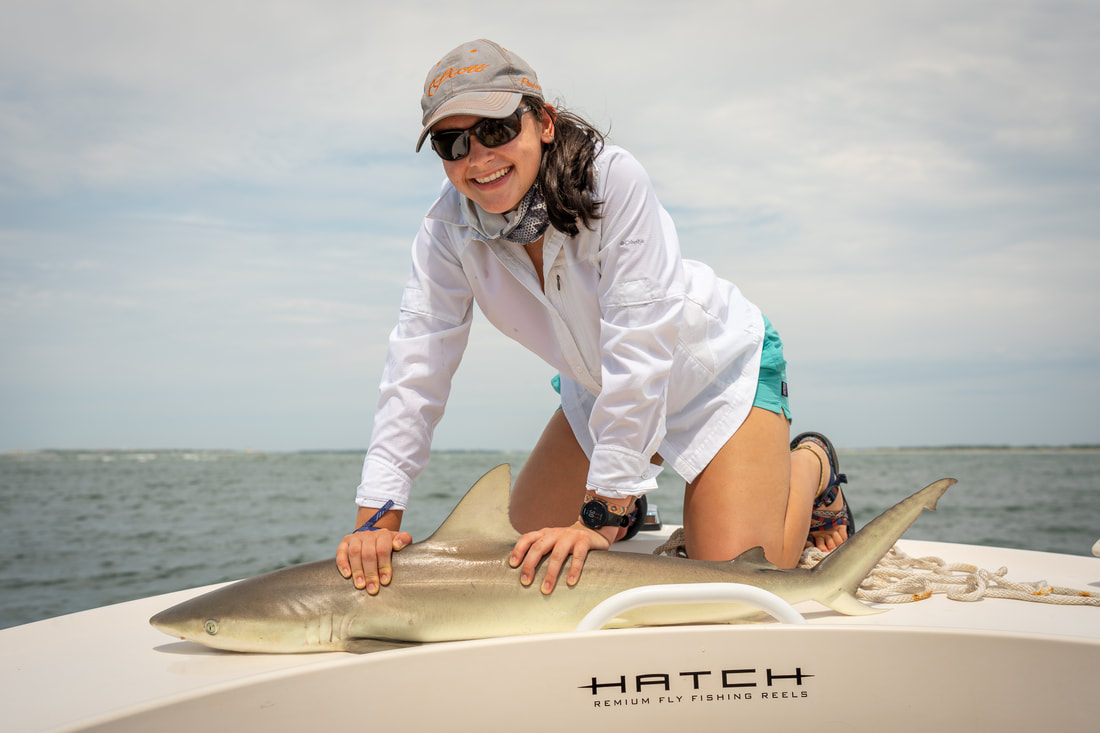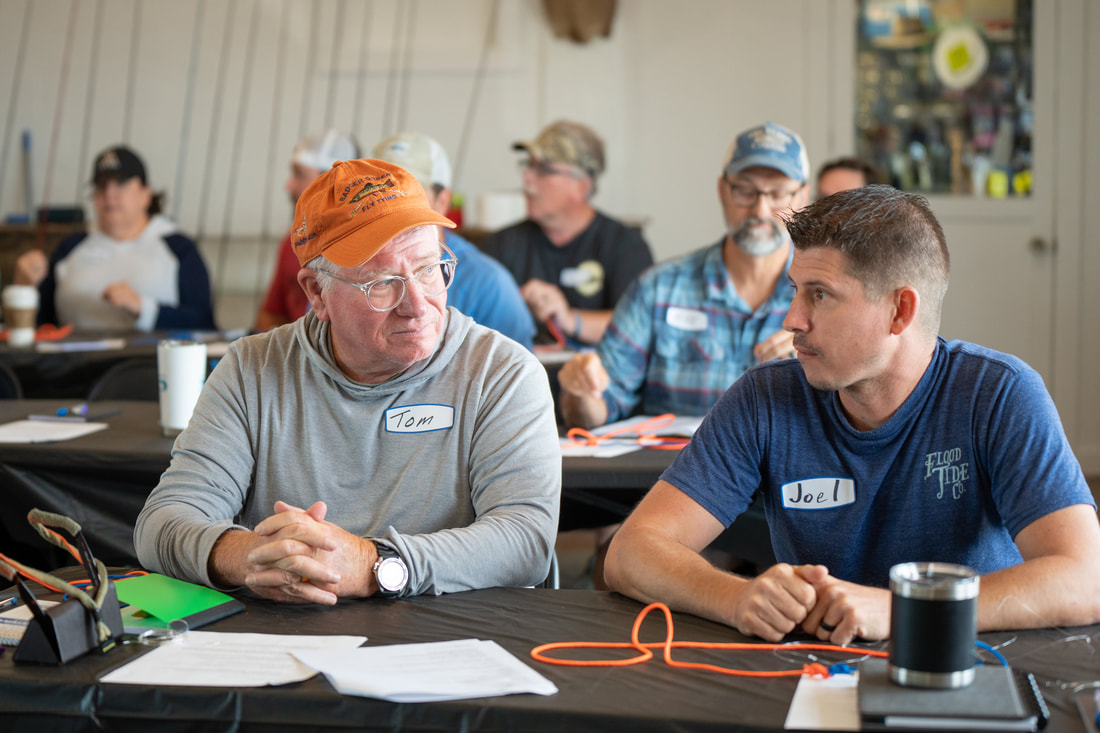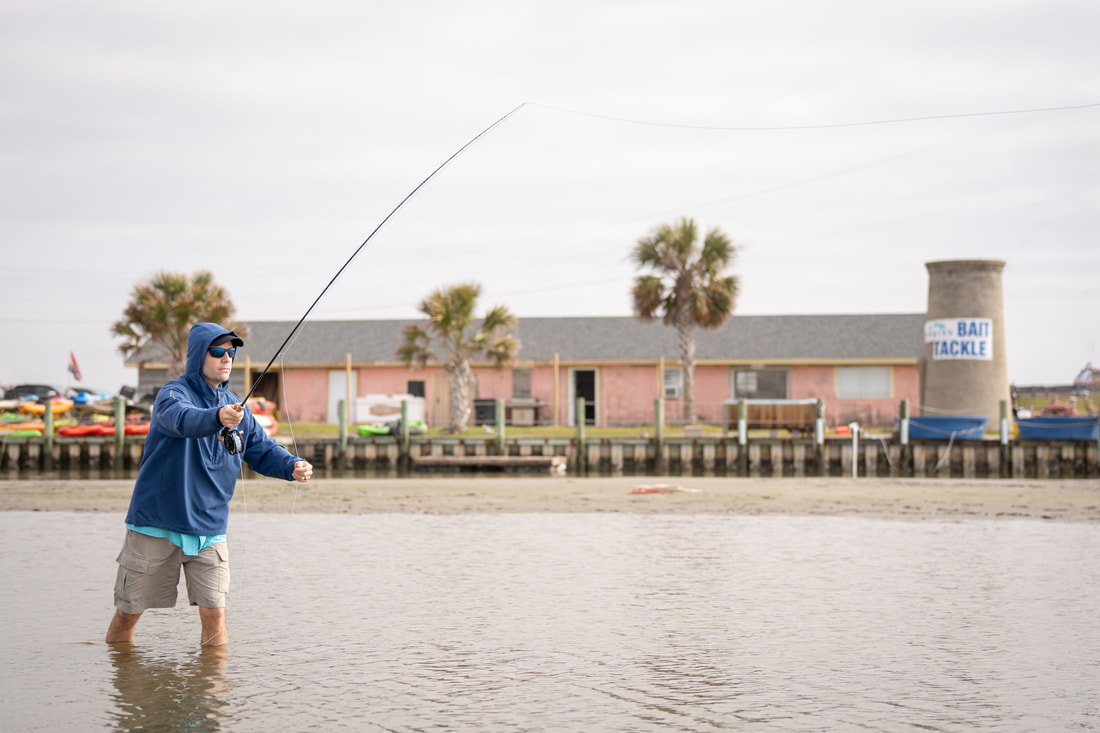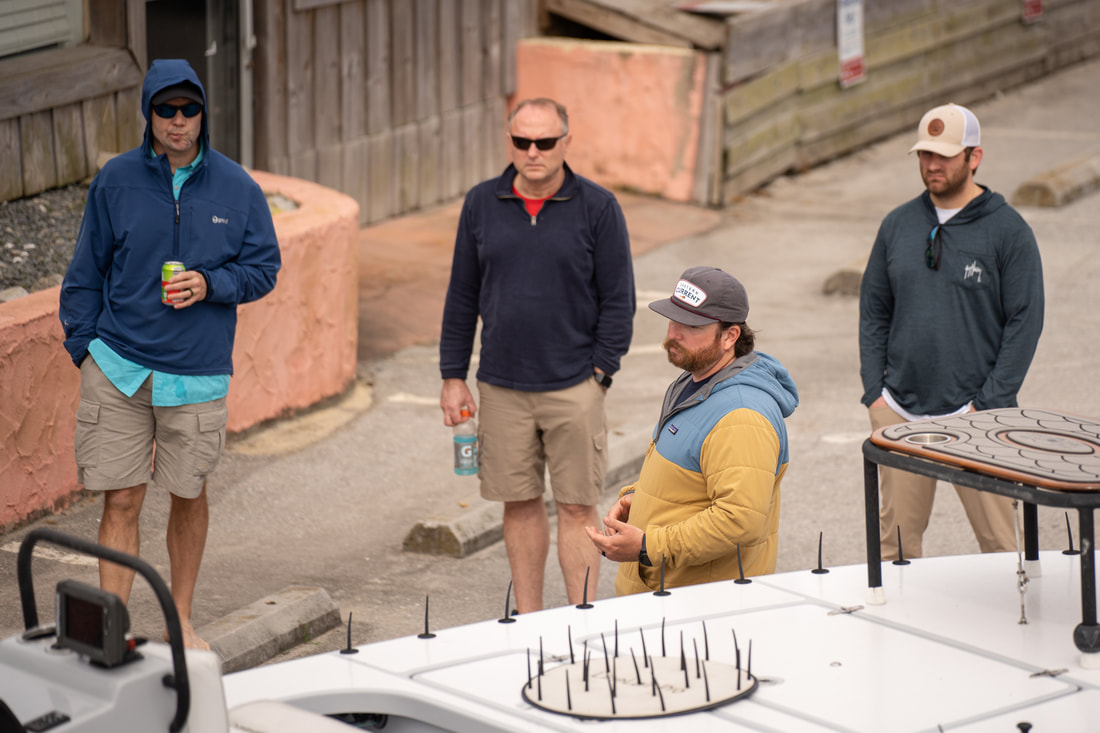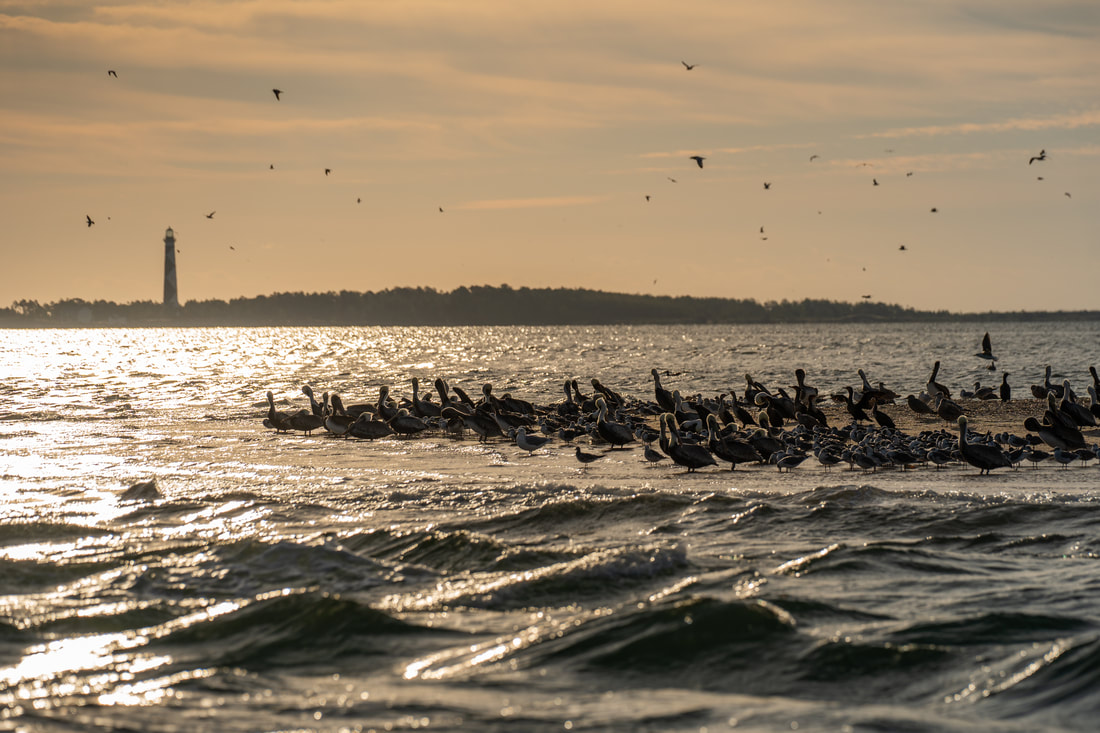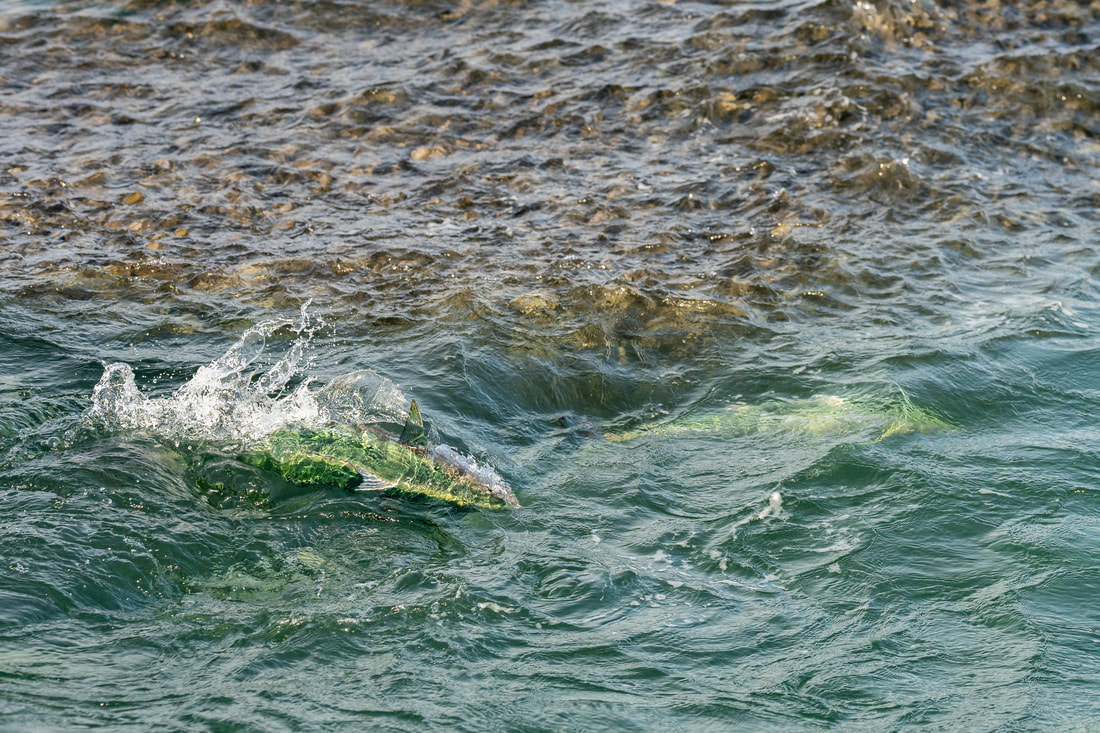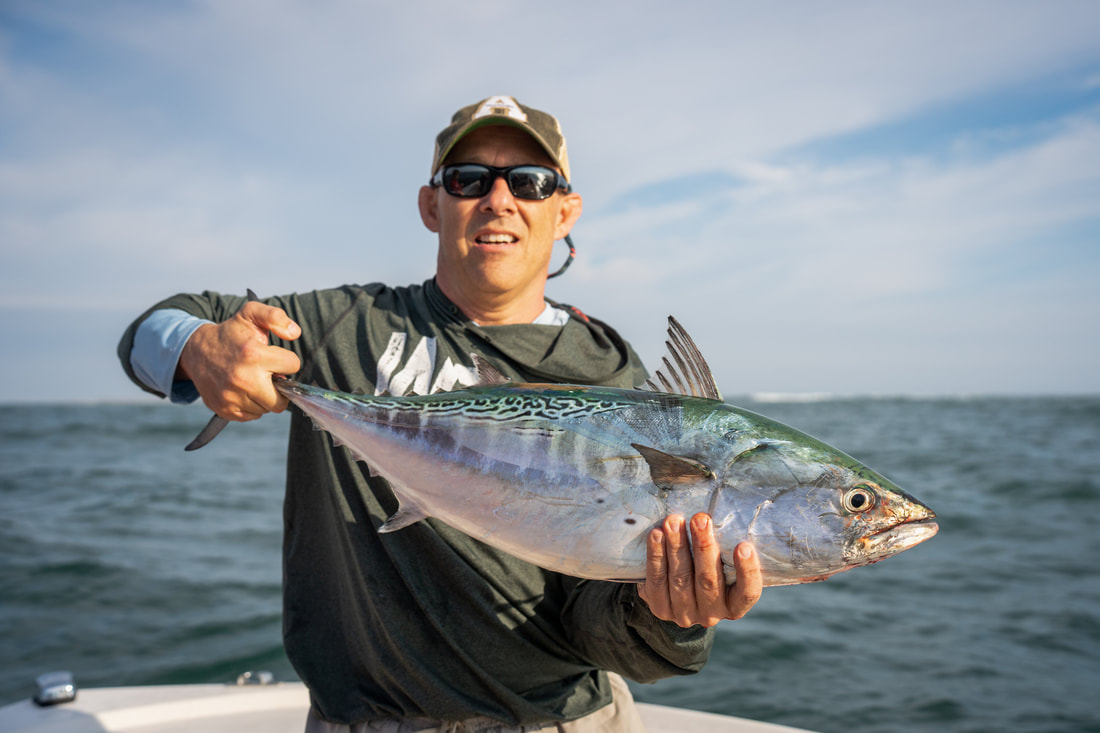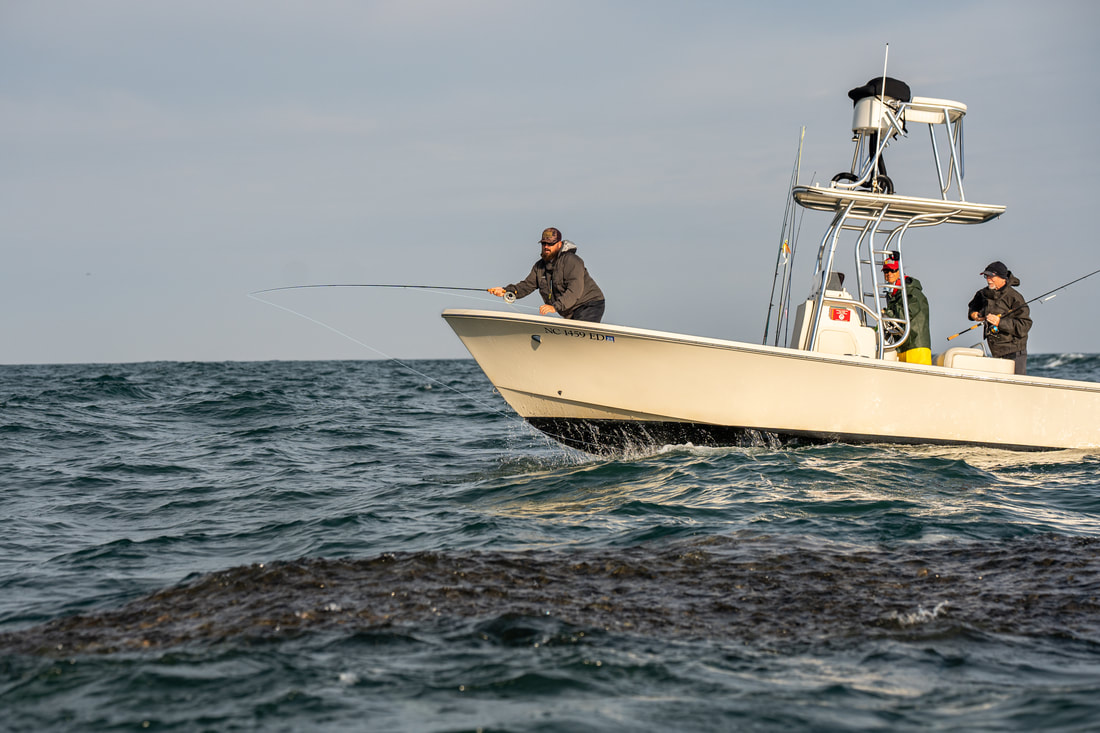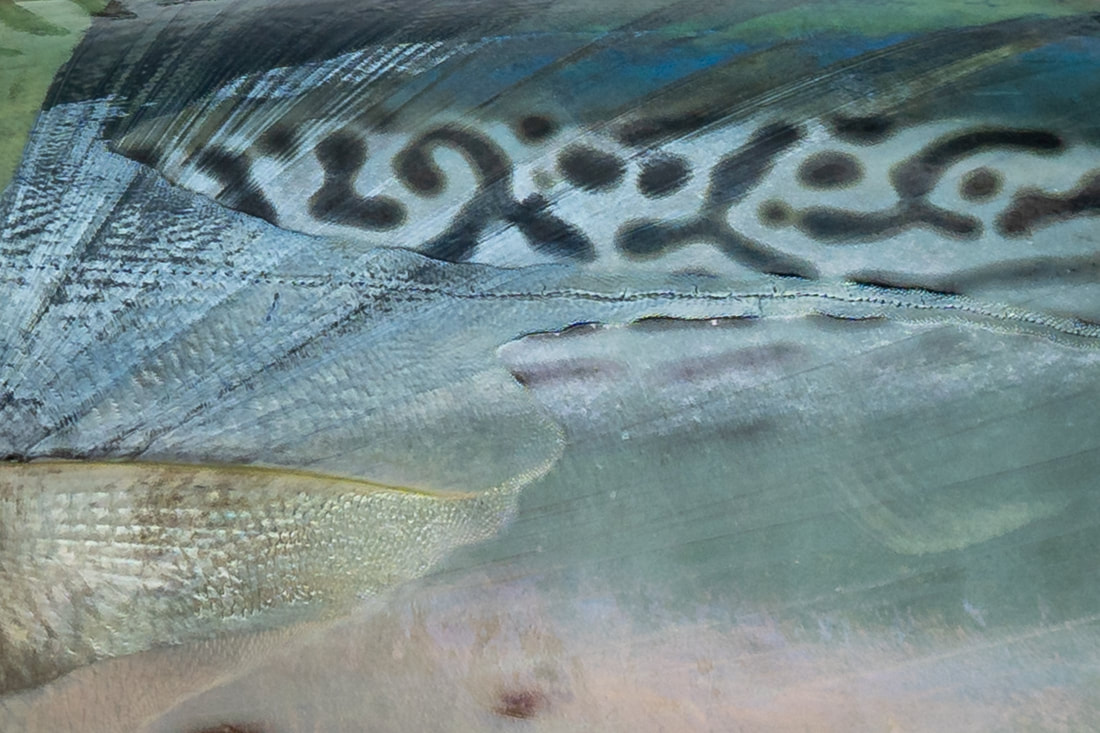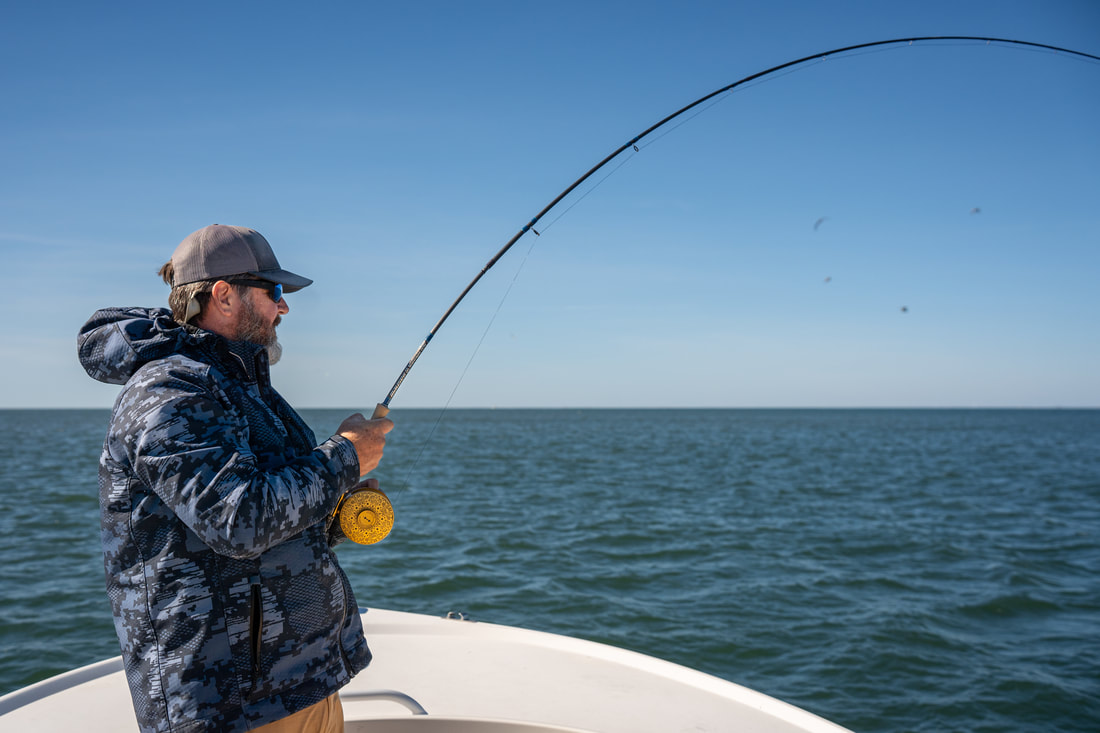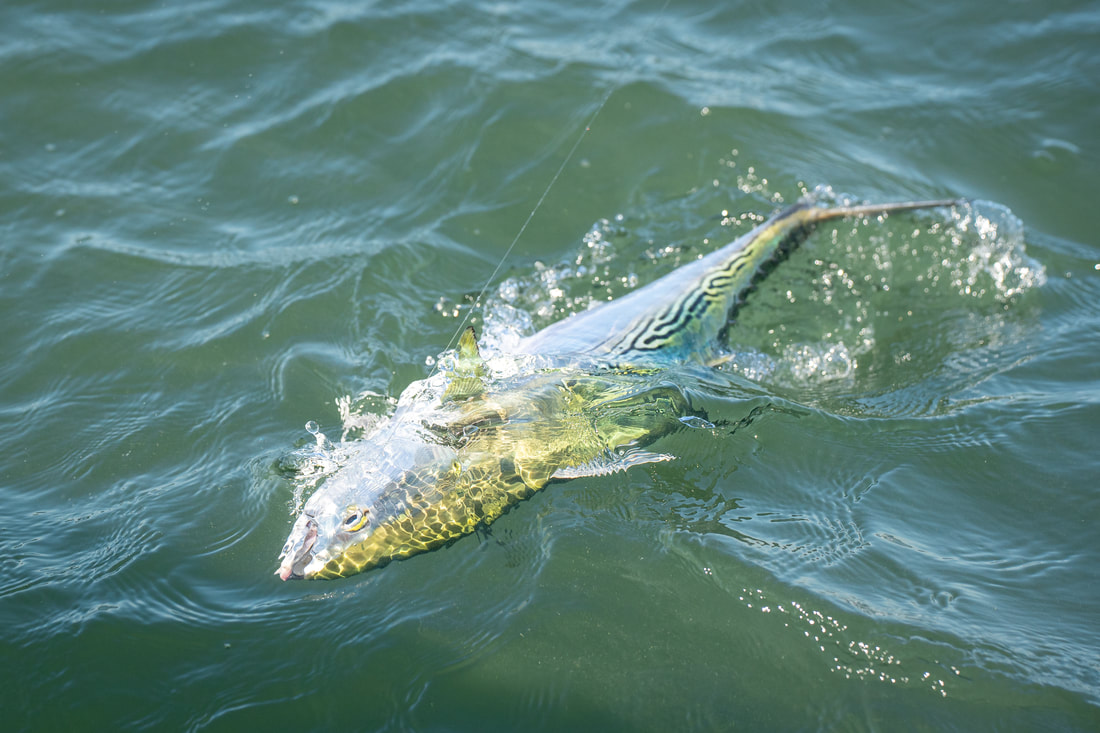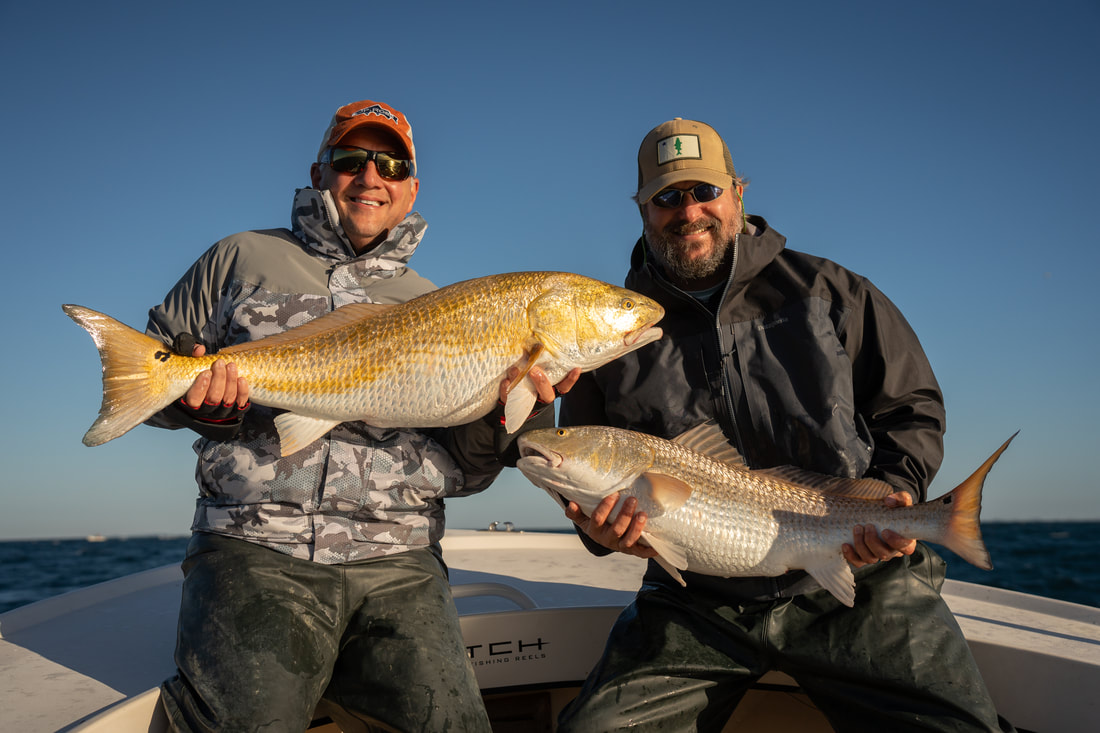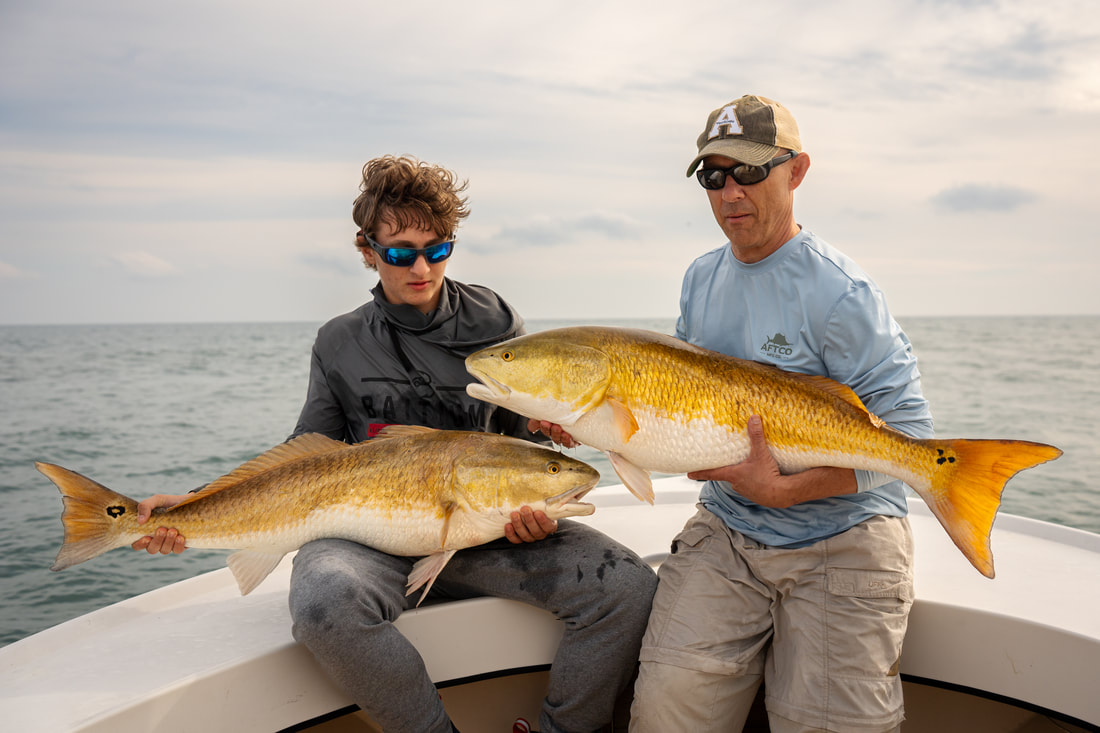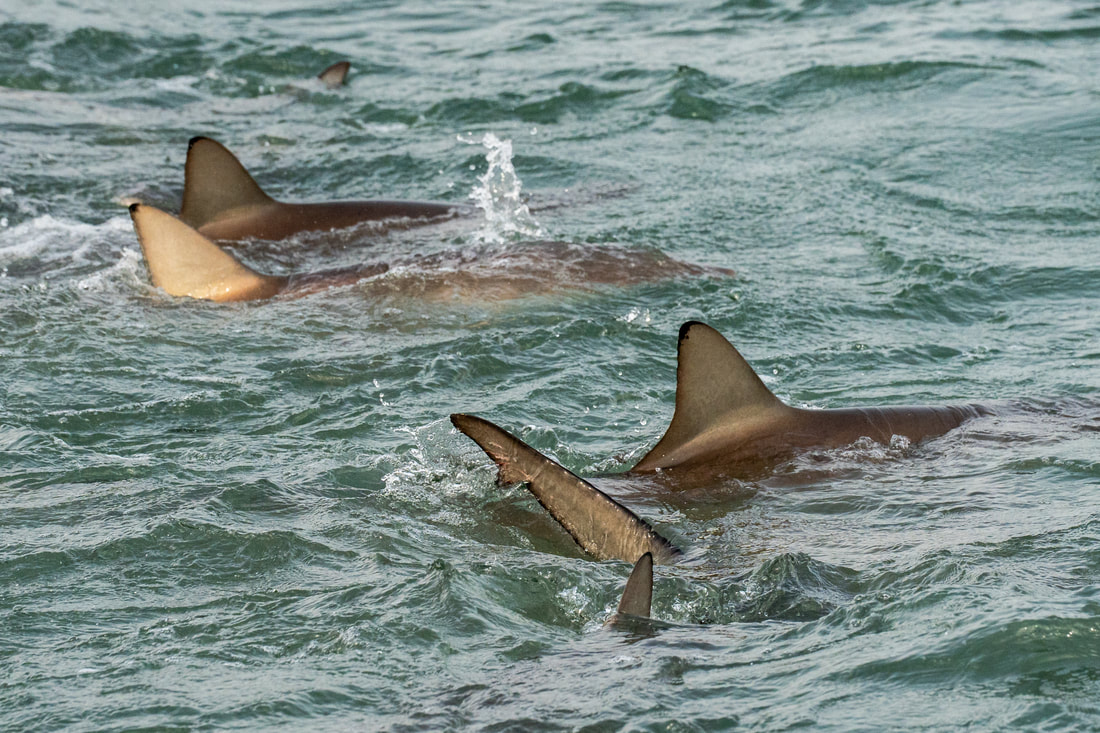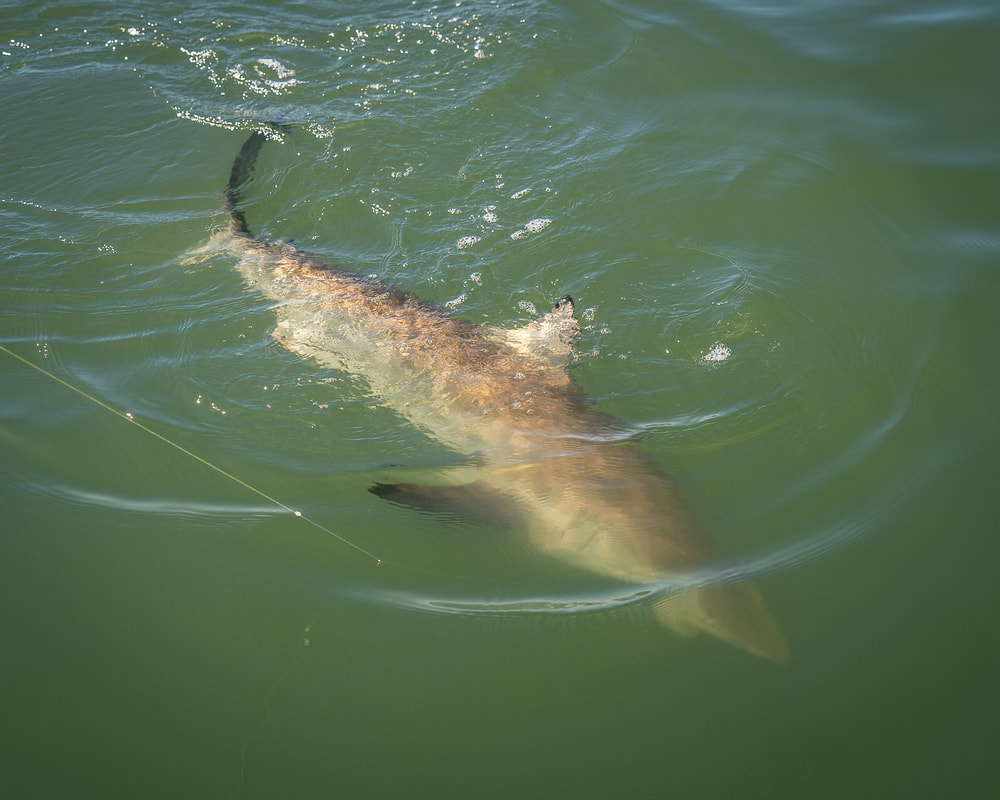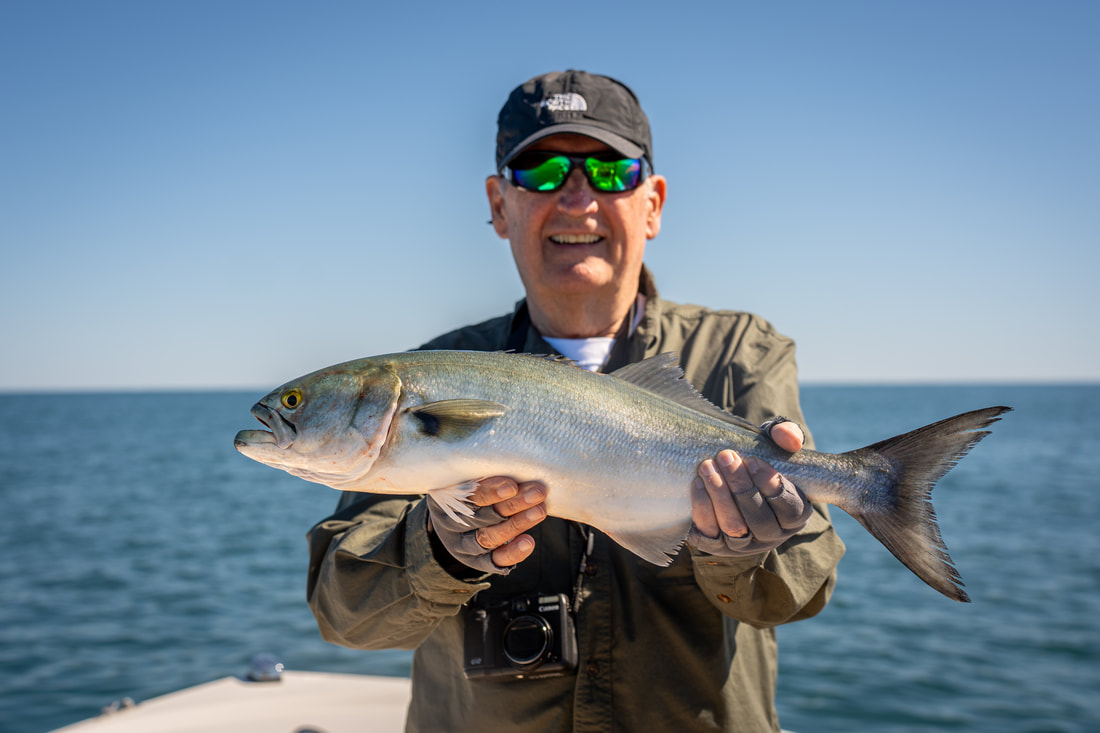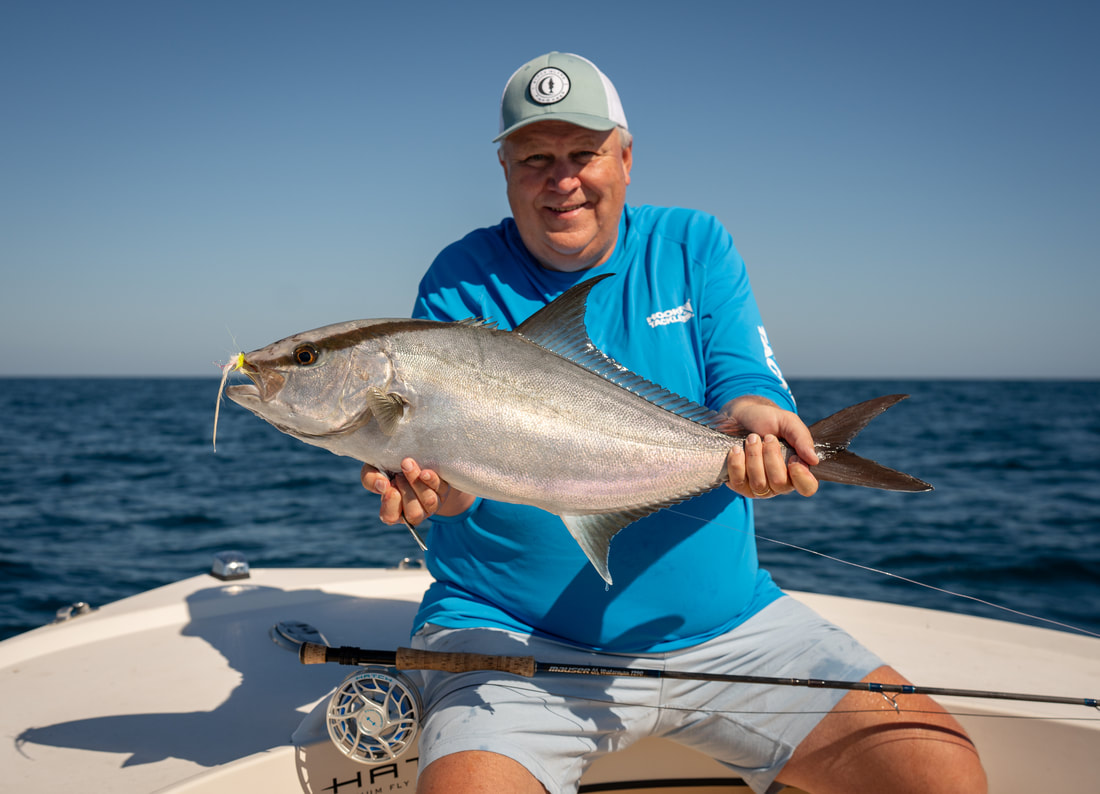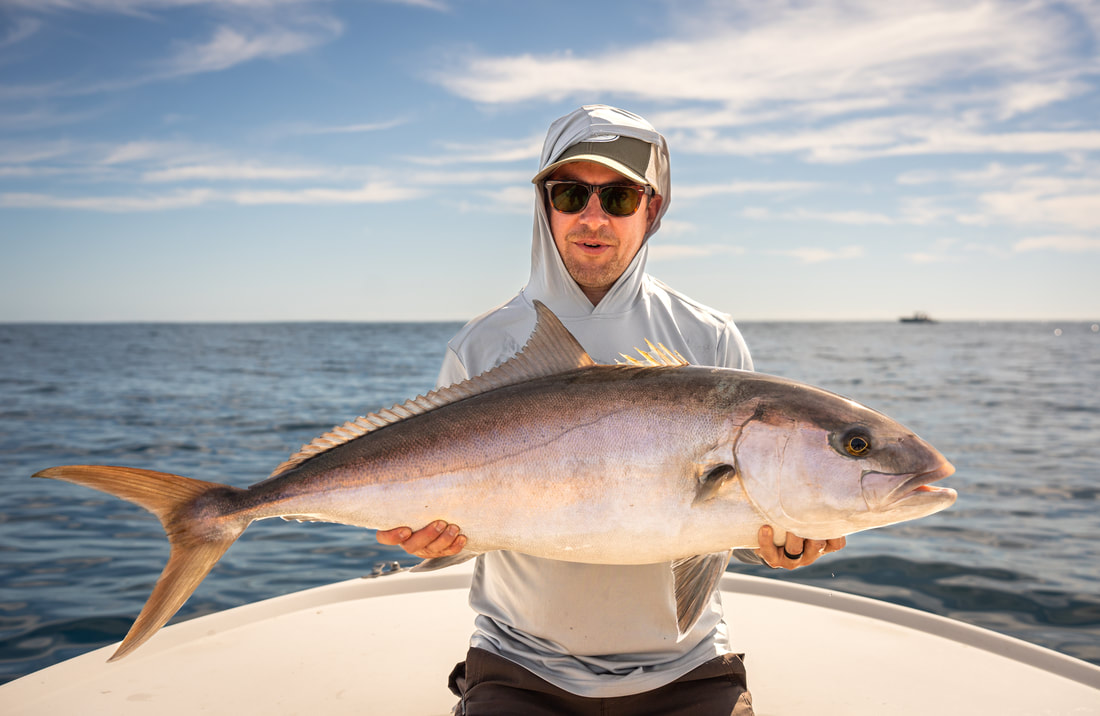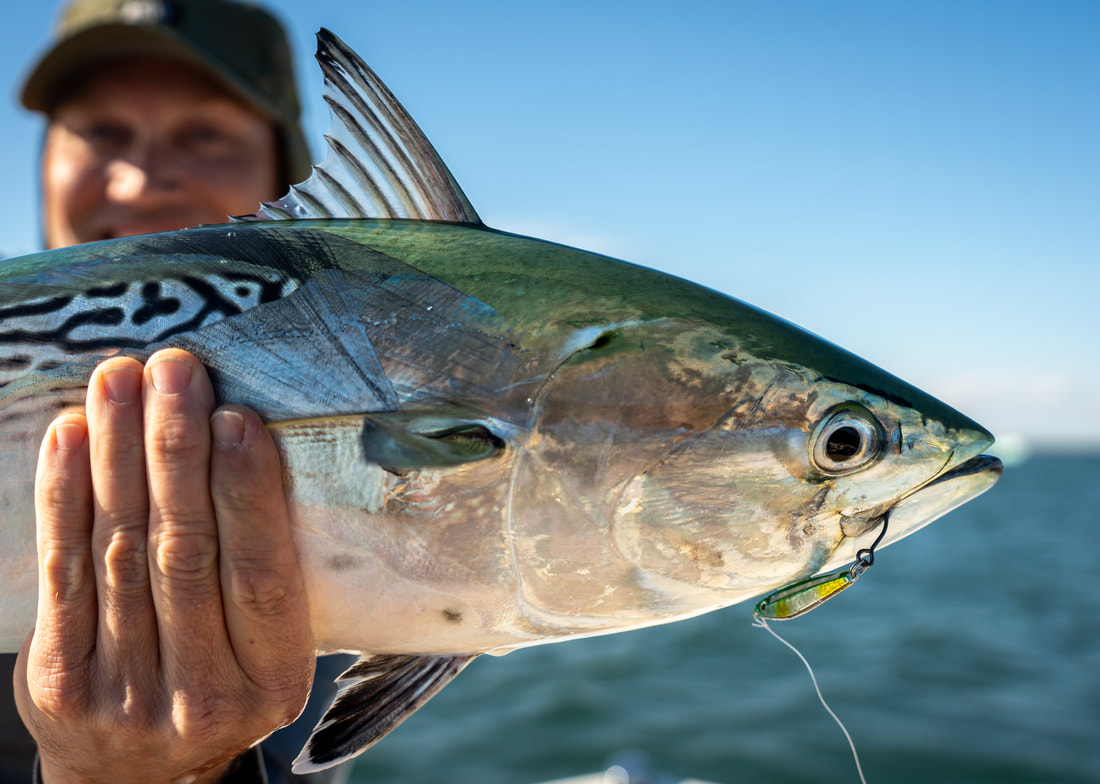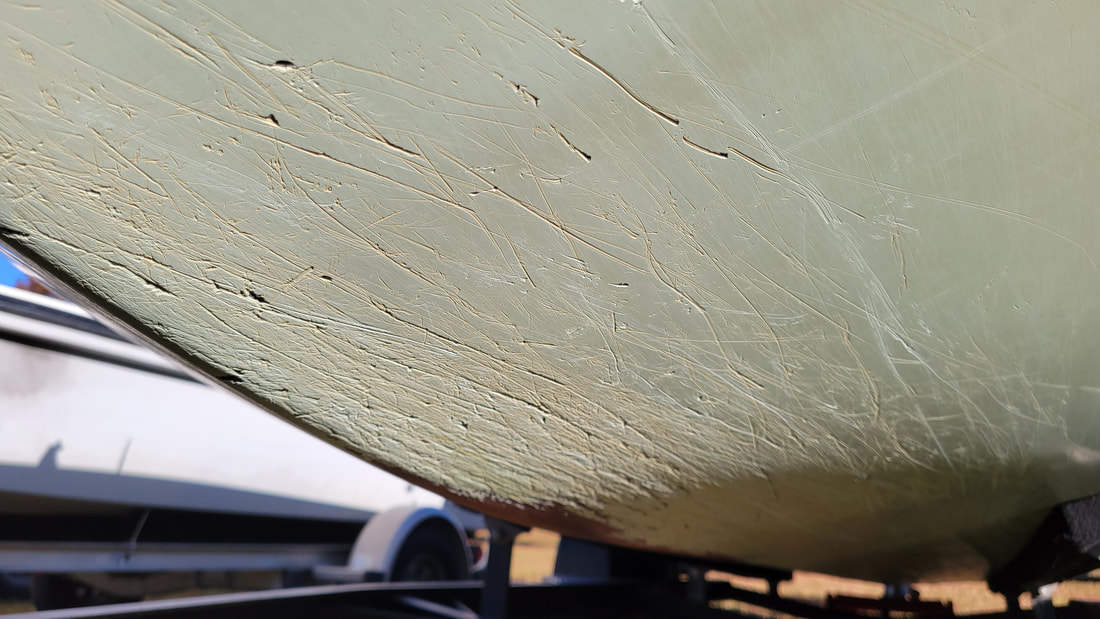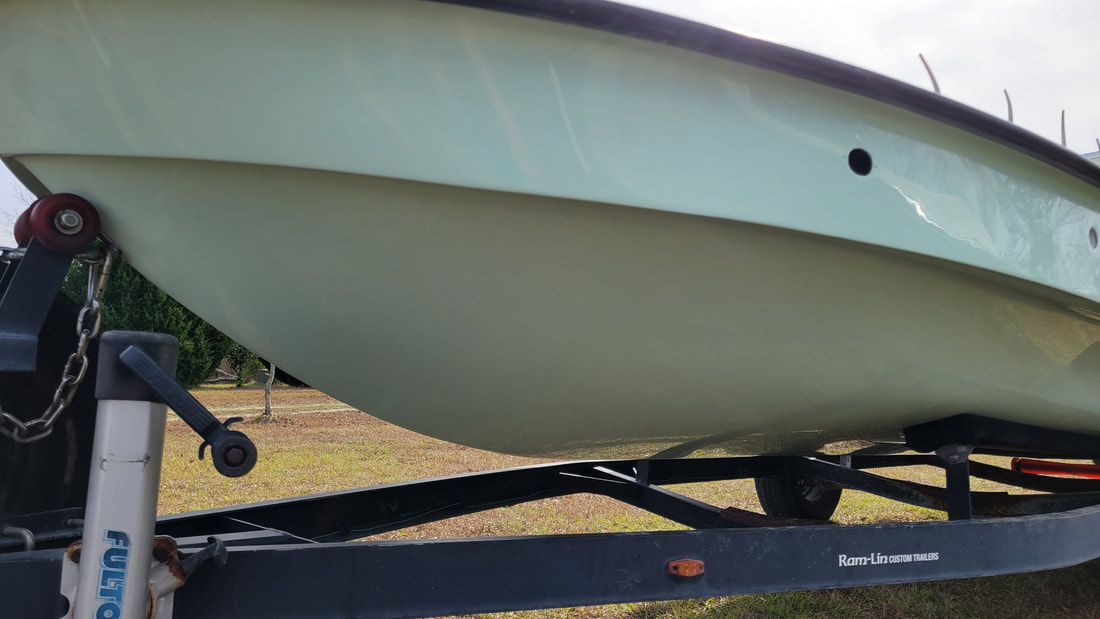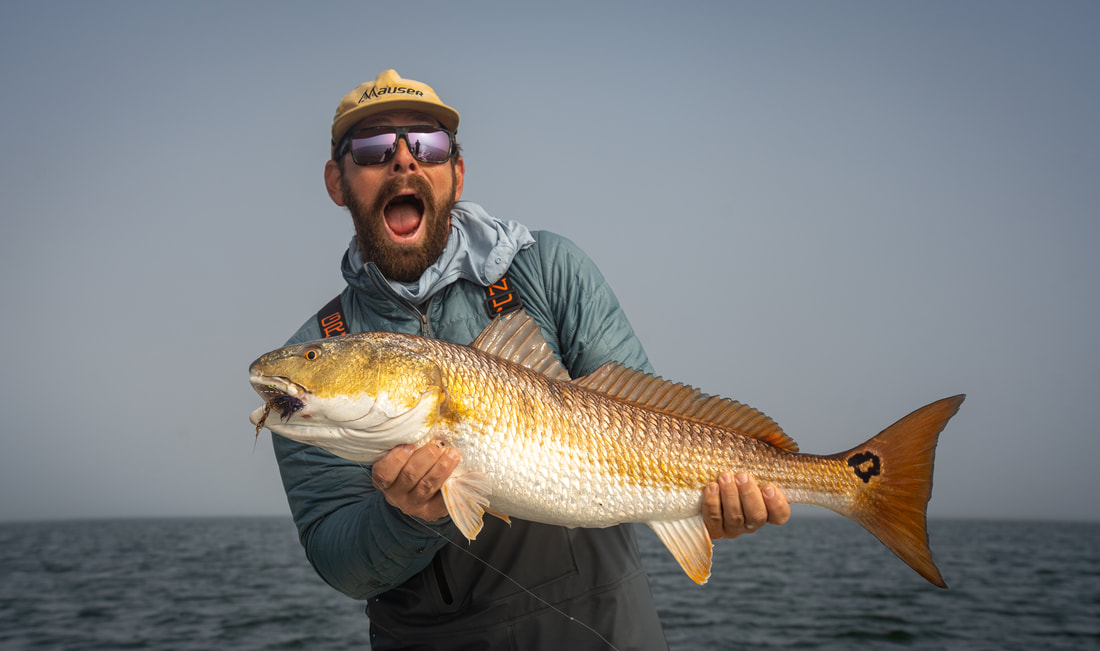|
The alarm sounds off, it’s 5:30, and I force myself to roll out of bed. I walk around the room and turn on every light as I guzzle down a bottle of water. Rubbing the sleep out of my eyes, I throw on a pair of shorts and reach into the rack of hooded fishing shirts and grab the first one I touch. I splash some water on my face, put in my contacts, brush my teeth, and I am out the door. As I walk across the hotel parking lot in the dim pre-dawn light, I pass Jon boats, center consoles, and shallow water skiffs, all hooked up to their trucks and ready for action. I unplug my battery charger from the boat and jump in the Sequoia. The Roanoke River is just 5 minutes down the road from the Days Inn, and the Rockfish are waiting. As I arrive at the ramp, there are already a few early risers launching their boats. The fog is rising off the river, and there is a calmness to this place in the hour before the hustle and bustle begins. I take a sip of coffee and back my skiff down the “mile long” ramp. As I throttle forward and move towards the dock, I see my anglers coming down the walkway towards me. I tie the boat off, quickly park the truck and trailer, greet my anglers, and we are off. We run a few miles down the river, to a spot where there has been a pretty good morning topwater bite. We have this stretch of river to ourselves for an hour or so. Stripers bust topwater cast after cast through the dense fog. Eventually the fog rises, and the stillness of the scene is interrupted by a line of boats coming down the river looking for Rockfish. The early morning surface bite is over, and we switch over to sinking lines and Clousers to dredge for fish for the rest of the morning. After a couple hour break and a quick charge of the trolling motor, I find myself back out on the river with a new set of anglers for the afternoon. We dredge Clousers and jig soft plastics until the sun moves low on the horizon. We switch back over to top waters, as the evening spawn begins. Stripers explode on the surface as they try to fertilize the eggs released by the larger females. We fish until dark, and make the run back to the ramp, trying to avoid the Rockfish fights happening all around us. As I arrive back at the hotel, exhausted from the day, I plug in my battery charger, re-rig my equipment, grab a late dinner in my room, and grab a shower before heading to bed. It’s past 11pm at this point, and I need every bit of sleep I can get before starting it all over again the next day. That’s Striper Season, and I love it. I usually do this for about 10-12 days each April/May and although I am sick of hotel living by the end of it, it is always a little bit of a downer to say goodbye to the Roanoke each spring. There is not a better river to be on during the month of May each year, as immeasurable numbers of Striped Bass make their way to the fall line on the Roanoke to spawn. This is an amazing river, with so much more to offer than just fish. Sure, you can have some killer days with substantial numbers of fish caught, but you can just as easily work really hard for just a handful of fish. The fish are there, heck you could reach down and touch them with your rod tip, but sometimes they have nothing but “making babies” on their mind and they can go lockjaw on you. I tell my anglers to come looking for an overall wonderful experience. The sights, the sounds, the smells, and the fish, all come together to make this place worth visiting time and time again. I just finished up my 2024 season on the Roanoke River, and I've been reflecting back on what makes this place and these days on the water so special. Let's break it down and let the images help tell the story. The Beauty... This river is always changing. Fog, blue skies, huge storm cells, sunrises, sunsets. Changing water levels, trees blooming, migratory songbirds calling, Bald Eagles and Ospreys on the hunt. The smell of Honeysuckle in bloom. Otters, Muskrats, Turkeys, Geese and Wood Ducks. And you can add the sound of tens of thousands of Periodical Cicadas from Brood XIX to this year's list. I love that every day brings something new to the river. The Camaraderie ... The people. Fellow guides, clients, friends and locals all make up the dynamic of fellowship on the river. Whether it's the old timer sitting by the dock in his lawn chair, a guide you haven't seen since last season, or a client with an inspiring story, I love my conversations with all of them. I also love showing them this place, and their first (of hopefully many more) Roanoke River Striped Bass. The Catching... Oh yeah, there's the catching part. That's what you initially came here for anyway. Yes, we can handle that, no problem. Like I said before, some days you really have to work for them, even if the sonar is lit up with them. Other days, you see why this place was given the name "Rockfish Capital". Fly, spin, bait caster, topwater, down deep, name your poison, you can fish it on the Roanoke. The Fish and their reason for being here... Why is this place full to the brim with Striped Bass? This stretch of the Roanoke River, along the fall line, where rapids and boulders give way to steep clay banks is the spawning ground of thousands and thousands of Striped Bass. Returning to where they were born, these fish swim anywhere from a hundred to a thousand miles to spawn the next generation of fish. Seeing these fish complete their journey and the cycle of life, through knock down drag out spawning fights is something unbelievable to witness. Since these fish have worked so hard to complete their purpose in life, we treat them with the utmost respect. Each fish is handled with great care and returned to the water to continue to spawn for years to come. It is an honor to be able to fish for these fish, and I want to do everything I can to see that continue into the future. Well, that brings this chapter to a close. I am so thankful for the ability to fish the Roanoke each year and I am extremely appreciative of the anglers who come to experience this place with me. Thank you! See you on the Roanoke next year.
0 Comments
We are a week into the month of April and things sure are feeling spring-like. Flowers are in bloom, the grass is green, and the air and water temps are on the climb. And warming water temps in April, make me think of one thing. The bite that's getting ready to fire up along our nearshore waters any day now. Surf temps are currently at 60 degrees and that's the magic number for Atlantic Bonito to show up along the beaches of the Crystal Coast. I've heard recent reports from South Carolina and just the other day Wilmington, so I expect them very soon. Atlantic Bonito show up along our nearshore wrecks and hard bottoms from 1 to 5 miles off the beach where the bait is this time of year. These fish will generally hang around until the water temps climb over 70 degrees in May. Atlantic Bonito, like their cousins the False Albacore, feed voraciously on Anchovies, Silversides and other schooling baitfish. There is ususally a topwater bite at first light and then you can fish for them deeper in the water column once the sun gets up. Fly or Spin, these fish are a fun target and fight hard just like Albies. The biggest difference is that these fish have a set of sharp teeth, and they are quite good to eat, both cooked and raw. We target these Bonito out of my Parker 23' and we can easily handle up to 3 anglers comfortably. I'll have fly rods rigged with sinking and intermediate lines and spin gear set up with the Bonito's favorite baits. We normally leave out of Morehead City, but sometimes we will fish out of Bogue or Browns Inlet depending on where the best bite is. Either way, the best bite is usually right at first light, before the wrecks get covered up with competing boats, so plan to head out early. My first nearshore trips for Bonito will start this week and I will be running them through the end of April before heading to the Roanoke for Striped Bass. I'm really excited to get out after these awesome fish that are so much fun to tangle with. The great thing about hitting the nearshore waters in April is that there are so many other opportunities if the Bonito don't play nice. False Albacore, Bluefish and Spanish Mackerel should be around at some point during April, so you never know what you might get into. The Albies and Blues show up in March or early April and the Spanish show up towards the end of the month when the water temps approach 70 degrees. While fishing the hard bottoms and wrecks for Bonito, you can also have the opportunity to jig up some Grey Trout from the bottom. Another possibility during April, is finding big schools of Bull Redfish in the ocean. This is definitely a possibility, not a guarantee, but I've had several trips in April where we were rewarded for going looking. Once the Bonito bite slows down, it's an option to go checking for these giant goldfish. These fish are often in giant schools, numbering in the hundreds, and often in clear water. We will sometimes mark them down deep on our sonar, but it's not unusual to be able to sight fish them on the surface. Heavy spinning rods rigged up with big bucktails or swimbaits along with rods rigged with big poppers can be the best way to get hooked up. That being said, we can also get it done on 10 to 12wt fly rods if you have a good casting arm. These fish, and the excitement that you experience pursuing them, just might make these my favorite fish to target in North Carolina. Between Bonito, Albies, Blues, Mackerel and Bull Reds, there are so many ways to have a great time in the ocean in April, whether you want to target one of those species or all of them. If you'd like to get out there and go look for them in the next 3 weeks, give me a shout.
When I was about 14 years old, my parents bought me a canoe. I spent much of the following Summers paddling the creeks and millponds of Eastern NC. I got to see a lot of beautiful and quiet places, full of fish, that the average person with a motorboat couldn't access. As I got older, HP and bigger fish replaced the paddles and quiet millponds of my youth. I've been guiding since 2012, and powerboats, busy boat ramps, and ego crushing fish have become a part of daily job. I do love it, it's what I do. But I have to be honest, a while back, I started missing those quiet moments on small bodies of water, empty of other anglers, and full of forgiving fish. In early 2023, I got the idea of purchasing another canoe and escaping into the black water creeks and swamps again. I have a friend in Florida, Joe Mahler, who turned me on to Merrimack Canoes, and I fell in love with his white Merrimack Tennessean. I decided that if I was going to do this, I was going to do it right, and I began my search for a used Merrimack of my own. In May of 2023, I found a red Merrimack Osprey in New Jersey and made the drive up there to pick it up. My sons and I paddled the White Oak, the Newport, Lake Phelps and more last summer. We found wildlife, giant moss draped Cypress Trees, and lots of willing fish. Whether we were casting a 4wt and popping bugs for Bluegill, Pumpkinseed, and Bass, or just exploring beautiful shorelines, I completely fell in love with paddling again. The Osprey model was designed back in 1954 and was built for hunters and anglers. At 13ft long, with a 39" wide beam, it's extremely stable and great for fly fishing. It's a great boat, but I continued to keep my eye open for a Tennessean model. In March of this year, I found a pristine white Merrimack Tennessean in Northern Virginia. I made the trip up and scooped it up. My Osprey is a fiberglass hull with cherry ribs and trim, this particular Tennessean is made of featherlight Kevlar material with the same gorgeous cherry ribs and trim. At 14.5' long with a 36" beam, the Tennessean paddles fast and quiet, tracks very well, and is almost as stable as it's sibling the Osprey. I absolutely love paddling this Tennessean solo or tandem. Paddling a canoe in the backwaters, among the cypress and lily pads is too special to keep it to myself. Therefore, I've decided to incorporate it into my guiding business. I don't need or want to run a bunch of canoe charters every year, but I am excited to add this as an offering to any of my anglers that would like to experience something different...something special. These will be one-on-one trips. I'll be at the stern handling all of the paddling and I'll host one angler on the bow with either a 3-5wt fly rod or an ultralight spinning rod. We will spend 3 or 4 hours exploring the dark tannin-stained waters, of a slow flowing river, fishing for multiple species of panfish and bass along cypress knees and fallen logs. Plan to see little to no other boats/people, and plan to be surrounded by beautiful backdrops as you cast to hungry fish. These are going to be very minimalistic trips, keeping gear to a minimum and taking our time working the shorelines for fish, and taking in the gorgeous surroundings. Slowing life down and keeping it simple, that's the name of the game when fishing from a canoe. Redfish are a challenging and exciting target, Albies make your heart skip a beat, and Amberjack pull like there's no tomorrow. Saltwater fish are great, and they deserve all the props they get. I've caught them all, they're great. But honestly, I love a big Bluegill crushing a popping bug on the end of a 4wt just as much as I love pursuing any of the big saltwater fish. It takes me right back to my childhood and soothes my soul. I imagine this being a fishery that will start up each April as the creeks warm up and something we'll offer all summer into early fall when the water begins to cool off again. I'll supply all the gear, from rods and lures/flies to lifejackets and refreshments. All you have to do is show up and let me chauffeur you around some of my favorite backwater haunts. For now, I'll be focusing these trips on the upper White Oak River and upper Newport River, but I will be scouting and adding other locations over the next few years. You don't need blitzes, or tailing fish, or fish that take two hands to hold. A small panfish or bass is a blast on light tackle, that being said, you never know when that 5lber is going to come up and inhale your popper. I've always built my business around experiences more than numbers. There are guides that can probably put you on more fish than me, but those trips don't necessarily involve fishing in the ways that I truly want to share with my anglers. I want every person who steps foot on my boat, to feel like they are going on an adventure, and exploring beautiful, amazing areas. We want to catch fish too, but I want them to leave with memories of an overall "experience". That's why I'm so excited to offer these canoe trips as new way for my anglers to experience the outdoors that I love so much. If this sounds like something you might enjoy, I'd love to talk with you about it in more detail. For more info about our blackwater canoe trips, click the link below.
Something very cool will be happening soon and I can't wait to experience it again. All over the eastern half of the United States, 13- and 17-year Cicadas will be emerging over the next few weeks. This will be one of the largest emergences in decades, and trillions of these buzzing insects will break through the surface of the ground only to mate and die within a few weeks. In certain parts of North Carolina, we will be seeing loads of these orange and black Cicadas during May and June. So, what's all this have to do with a fishing post? Well, if you've ever wanted to see Carp and other fish lose their minds for a few weeks, then keep on reading... As I type this, there are already Cicadas beginning to emerge from Charlotte to Raleigh. Over the next 2 weeks, we should see an unbelievable increase in the numbers of Cicadas on the land, in the trees and in the air. The sound that these Cicadas make as they call out in the hundreds of thousands, is deafening...but it's a sound that means that great fishing is right around the corner. Within a few weeks of emergence, these Cicadas will mate, deposit their eggs and fall to the ground and perish. Birds, small mammals, and reptiles will gorge themselves on these delicious Cicadas as they fall to their deaths. Any Cicada that falls from a tree over the water will likely be eaten by a fish below. Although Cicadas are eaten by many species of fish, from Trout to Catfish to Sunfish to Bass, the Common Carp is probably the most prolific Cicada feeder. After a few days of Cicadas falling into a Carp filled waterway, these fish will figure out what the deal is and will go absolutely crazy until all the Cicadas have died off. This is a short window of opportunity, and a lot goes into predicting the peak of the fishing during the Cicada emergence. First off, you have to use ground temperature estimates to guess when they will emerge. After that, you will take a guess at when they will start to die off...will it be 2, 3, 4 weeks after they emerge? If you hit the water too soon, the Carp may not have the game figured out, if you wait too long, you may miss the peak. But if you hit it just right, you may get shots at Carp after Carp cruising the surface searching for the next buzzing Cicada to run down and inhale. These Cicada broods may only emerge every 13 or 17 years, but when they do, they more than make up for the time they've been gone. I've fished two 17-year Cicada emergences, one in West Virginia back in 2016 and another in Western NC in 2018. Are they worth it? Well, let's just say I am pretty hyped about the possibilities in the coming weeks. So, what does it take to make it happen? A lot of research and a little bit of luck! I've been crunching numbers and looking at my calendar and have settled on some dates that I will keep open for Carp on Cicada trips. I'm going to officially open up May 28, 29, 30, 31 and June 1 for these trips. These dates could be a few days pre-peak, or a few days post-peak, but I think they are going to be really close to prime time. I'm planning to stay in the Raleigh/Durham area that week and will either fish out of Jordan Lake or Falls Lake (more details to follow). We will price these trips the same as my Striped Bass trips and do long half days or full days. I can provide all the fly gear, including Cicada fly patterns. If you'd like to fish it on spin, I am pretty sure we can adapt and make it happen too. If you miss out on this rare opportunity, you just might kick yourself in the butt for the next 13 years until it happens again. Doubled up. Carp are generally very picky and hard to fool with a fly, but during a Cicada emergence, they can completely lose all inhibitions. If you'd like to come fish topwater Carp with me, or have any questions, please reach out to me.
910-340-4811 [email protected] I just got back from the Roanoke River targeting Hickory Shad during their annual spring migration. Except for one day of wind and storms, we had a very successful week on the river. We ran a few more trips this year than we did the previous year, and I look forward to continuing to build up this fishery as an opportunity for my anglers to enjoy. Forget about the fish for a minute. This river. It's beautiful. I never get tired of floating down it and watching the shoreline change from steep drop offs, to winding guts (feeder creeks), to low lying forests. During the March migration of shad, the trees are just beginning to produce buds and leaves. Quite different from the lush green foliage that dominates the riverbanks during the May Striped Bass run. At this point you can still peer back into the forest and catch glimpses of Whitetail Deer and Turkeys. Otters and Nutria swim down the shoreline. Bald Eagles, Ospreys and Vultures ride the thermal above us as we drift down river. This place is a sight to behold. But yes, there are fish, and plenty of them. Hickory Shad dominate the scene, although there are the less common catches of American Shad, Largemouth Bass, White Perch and Striped Bass during the late March peak of shad season. I think I'm officially done talking in "numbers" when it comes to the Roanoke, it feeds expectations and can cause anglers to focus on "hitting the mark"...losing sight of all the other awesome experiences to be had on the Roanoke. If I need to advertise big numbers to get people to come fish the Roanoke, then I am not doing a good enough job giving them a great all-around experience. Without talking numbers, I'll just say that the shad fishing on the Roanoke in March is as good as it gets anywhere on the East Coast from New England to Florida. Quite possibly the biggest concentration of Hickory Shad on the planet. I'll leave it at that. I spend the winter months leading up to the shad run, chasing after Redfish. I love my Reds, but we do a lot of chasing... and stalking, and searching, and getting our egos crushed in between finding Redfish that are willing to eat a fly. Don't get me wrong, I love it, but it does require patience and a pretty decent skill set to catch winter Redfish on fly. That's part of the charm of it, it is challenging. Then comes March Shadness and everything changes. We go from fishing, to catching, literally. It's great for kids, for new fly anglers, and for pro's that just want to have a day of cast, hook, fight, release, repeat, repeat, repeat... It's great training for someone who needs practice with a sinking line, or is working on their double haul, or wants some reps on their strip strikes. It's also the perfect place for dad, or a grandpa, or a mom, or an uncle to get a kid absolutely hooked on the sport of fishing. Shad are downright willing to eat, and that's what I love about them. Muddy water, clean water, high water, low water, fast water, slow water... they're not picky and that's their enduring quality. They are also beautiful, energetic, and acrobatic. They are the more user friendly, mini version of one of my favorite fish, the Silver King. The rare Alosa sapidissima for the win! Stretching some string. "Gaudy" is a shad's favorite color. Doubles and even triples can be the norm on a good day. I added a few TFO Panfish ultra-light rods and 1000 series reels to the stable this year. They were perfect for slinging little jigs to the bank and were a blast to fight the shad with. No need to get fancy, a pack of 1/16 oz crappie jigs in pink, chartreuse and white will get them fired up. Bring plenty, because the bottom of the Roanoke is littered with rocks, logs and branches. I brought a couple Mauser Arete 4wts rigged with Hatch 3 plus reels and SA 150gr sinking lines, which seemed about perfect for getting the flies in front of the fish. The river was flowing at about 6500 CFS and the 150 grain lines got down into the zone with ease. Will Paul, doing what he does best... putting his anglers in front of hungry fish. Jump! That's a solid Hickory Shad. He might be trying to hold back that smile, but no doubt, fun was being had by all. Ready for the bite. Such an awesomely designed fish. Did you know these fish travel from the ocean all the way up the Roanoke to spawn? From their spawning grounds near Weldon, NC, it's a 180-mile swim to Oregon Inlet. The crazy thing is, we don't know how many miles these fish travel beyond Oregon Inlet. These fish probably travel several hundred miles at least, to reach their spawning grounds, and then make that journey again to get back into the depths of the ocean. Year after year, returning to the same spawning grounds where their parents produced them. It's just amazing! One of my anglers brought his Mauser Waterman and Hatch Iconic Nevermore custom to try out. I was stoked to get some shots of it in action. I've been fishing for these Hickory Shad on the Roanoke River for 18 or 19 years now. I haven't gotten tired of seeing them yet, and I doubt I ever will. The run is about over for 2024, but if it's something you are interested in doing, I wouldn't let another year pass by. I'd love to show you what the fuss is all about in the spring of 2025. The ol' red and yellow marabou dart for the win! Slinging some major string! Yes please! May I have another? Yes you may, just make another cast. Our little Arete 486 on the hunt. Acrobatic show is covered under the price of admission. You willing to bet that there might be a few shad in this bend of the river? Brian putting another cast out there and hoping to win another prize. Have you noticed how muddy the water is in all of these pics? Although the water flow was pretty normal for a shad run, the water was extremely dirty this year. Not sure what the COE was doing to cause that, but surprisingly, it seemed to have no ill effect on the bite. I bet the shad had to be within 6" of your lure or fly to see it, but there were so many fish around, you still got bite after bite. Paying homage to the shad before sending him back home. I spend a lot of my year chasing fish that can be challenging and picky. I'm thankful for the times that I get to chase fish that are the polar opposite of "picky". I love trying to capture the action with my camera, as much as my anglers love trying to capture the fish itself. Fact: It's nearly impossible to not smile while catching shad. That moment of coming tight, that we all daydream about. Most of my year, we rely on 8 to 10wt rods and heavy-duty reels to get the job done, so I really love the times that we get to strip it back to light-duty gear like these 4wt setups. So much fun! Judges give this jump a score of 9.2! Some days it's so good that you can catch your fill within sight of the boat ramp, other days you are thankful to have a boat and be able to move downriver to find a steady bite. Fishing just upstream of "the big rock", can be pretty fruitful some days. Speaking of rocks, when the water flow is low, especially during shad season, there are several rocks across from, and just downstream of the boat ramp that are within inches of the surface. You really need to be aware of where they are, or you are at risk of hitting them with your hull or motor. Not trying to scare you away from DIY, but it's really worth it to have someone with experience show you around. Hot pink did the trick for this Hickory. By the way, let's talk about releasing these fish. Although you can keep and eat Hickory Shad, we choose to release all of ours so that they can complete their mission of spawning and producing the next generation of Shad. Since we are not harvesting any of these fish, we want to give them the best chance of survival we can. We only photograph about 5% of the fish we catch, and we keep them in a net in the water until we are ready to take a quick photo. We then quickly get them back into the water and swimming away. All of the fish are dehooked over the water without bringing them in the boat and handling them any more than needed. A de-hooker is an amazing tool that greatly reduces the physical stress on any fish that you don't plan to harvest. That's a big Hickory! The smiles alone are worth the trip! Capt Richard Andrews putting his anglers on the fish. Trust me, I keep a bunch of this particular fly in my box for a good reason. Triples with grandkids and grandad. That's something to remember! Shad trips are great family trips. I really appreciate everyone who came out to chase Shad with me in March. I am so thankful to have this amazing and healthy fishery in my home state. It's so good, that I want to spread the word, and build it into an integral part of my guiding business. We did a week of fishing this year, and I'd love to extend that for next year. If you'd like to go, it's never too early to start talking with me about it. I'm happy to answer any questions you might have, and I'd love to have you join me in the Spring of 2025.
This past week a lot of anglers used their keyboards and voices to show their support of guard rail regulations on False Albacore along the NC Coast.
These “guard rail” regulations were presented to North Carolina’s Marine Fisheries Commision a year ago, after ASGA’s research started gaining traction. Previous to the American Saltwater Guide’s Association’s scientific study of False Albacore, there was little to no science on these fish. Thanks to their genetic sampling and tagging from New England to Florida, we are starting to understand their migration and genetics better. It turns out that all of these fish are from the same breeding stock…they are all related. Many of the Albies that summer in Massachusetts, spend their fall in North Carolina, and overwinter in Key West Florida.
With increasing pressure on these fish both recreationally and commercially, it became concerning that there were absolutely no limits on the harvest of these fish. One of the biggest concerns was the fact that False Albacore, due to their oily nature and high content of Omega 3, are being considered as a possible new target by large commercial industries from outside of the USA. The possibility of huge boats coming in with thousands of yards of seine nets to encircle the schools of Albacore for fish meal or cat food is quite frightening.
The push for the Marine Fisheries Commision to vote in favor of protective regulations on these fish has increased over the last year. A plan was written up by the Division of Marine Fisheries to set a cap on Albie harvest. They took the 5-year average of Albies harvested in NC from 2018-2022 and doubled it. If this rule was voted in, regulations would go into effect on Albies only once we hit the 200% average harvest cap. Once the regulation kicks in, it would be 10 fish per rec angler, and 3500lbs of fish per commercial trip. There are less than 3% of the commercial anglers even hitting the 500lb mark on Albie harvest, much less a 3500lb mark. This plan was put together with the idea that the restrictions would not affect any current recs or commercials and would even allow for some growth. What it would do though, is stop the fishery from expanding out of control into a disastrous situation. It would also keep a large-scale fishery for Albacore from being developed. We share our Albies up and down the East Coast, so the fish would only be protected while in NC waters once the rule would go into effect. There are currently 4 other states to the north of us considering protective regulations also, and they were watching us to help them make their decisions.
The last few weeks, guides, anglers and the ASGA have been rallying for support of this ruling. Leading up to the meeting, over 250 public comments were submitted in favor of the proposed rules. Then this past Wednesday night and Thursday morning, many guides and rec anglers came to the meeting to speak in front of the Marine Fisheries Commission. Later on Thursday the commission deliberated and took a vote. There were commissioners who voted against the vote due to the lack of science proving that Albies needed regulations. On the other side, there were commissioners who voted in favor of regulations, stating that the lack of protection due to the lack of adequate science always ends up with over fished fisheries, as there just isn’t enough funding for more scientists. In the end, it came down to status quo vs setting a new standard. The MFC voted 5 to 4 in favor of guard rail regulations to protect Albies in the future as more science is done to study the species. This is a big win for Albies and for every angler that appreciates these amazing fish. For the first time in a long time, I watched NC set a shining example for all of the other states to follow. Hopefully this will lead to a chain reaction of protection up and down the East Coast.
A huge thank you to everyone who spoke out in favor of False Albacore this month, we could not have done this without the support of the public.
The Wednesday meeting and public comments can be viewed here:
The Thursday meeting can be viewed here. Public comments begin at the beginning and the deliberation and voting start at the 7hr 5 min mark.
For more information, please visit the Albie Project on ASGA's website.
I'm excited about returning to the Roanoke River again this May for the Striped Bass run. As of right now, I've cleared out May 1-11 of 2024 for Roanoke "Rockfish", but I could possibly extend that depending on bookings. The fish will hopefully be there before I arrive, and still there after I leave, but my plan is to hit the peak of the spawn when the stretch of River we fish around Weldon has the highest concentration of fish. Striped Bass are found throughout many parts of the state. Juvenile fish can be found in coastal rivers, large adults are found offshore, and many lakes contain landlocked fish. Just like the earlier runs of Hickory Shad, Weldon is also probably the best place in the state to catch Striped Bass, or "Rockfish", as they’re locally known. Being anadromous, Striped Bass make a Spring journey up the Roanoke River towards their spawning grounds near Weldon. Stripers start to show up in April and usually hang around until mid May. On a really good day, it’s possible to boat close to one hundred fish when the bite is on. Historically, April has been the keeper season, and the Weldon area can be very crowded. It has recently been announced by the NCWRC that there will be no keeper season on the Roanoke this year. Keeper season or not, our favorite time to fish for them, is the first two weeks of May, when the fish numbers are at their peak, and they are the most active. The majority of stripers are schoolie sized fish from 16-24″, but there are big cow females between 30-50lbs in the same stretch of river, so you never know what you could hook into. Last year, every few days we would land a really nice 10lb fish among the schoolies. I absolutely love fishing this river every year. It's an experience to be had! I worry sometimes that the experience is lessened by anglers having too high of an expectation. Several anglers, guides, magazines, and social media posts have sold the Roanoke as the place where you catch 100 fish per trip. Does it happen? Sure...some days. That being said, I tell my anglers to always be realistic. There are lots of factors that can play into the bite. Water temps too high or too low? Water flow too low and the fish are down river? Flow too high and the fish are up in the bushes? Are the fish pre-spawn, post spawn, or are they right in the middle of their spawn and thinking about love? I've seen the most senior of guides on the river struggle to catch a dozen fish some days. I've also seen a local catch a hundred fish while standing on the bank using a $20 rod and reel combo. Every day is different. Generally, when I tell my anglers about the fishery, I say that a slow day on the Roanoke in May is comparable to a good day on most any other river, and a really good day on the Roanoke could ruin you from wanting to fish anywhere else. The truth is this river is so much more than numbers. It's one of the best fishing experiences to be had in the state of North Carolina. Where else can you see Bald Eagles above you, Turkeys along the banks, River Otters splashing at your feet? All while watching dozens of angry male Rockfish fight each other on the surface, trying to spawn with one big female as she releases several hundred-thousand eggs? Seeing all that, and also having the potential to catch more fish on fly or spin than you ever have in a single day? How awesome is that? I love this river and the experiences she provides on a daily basis during the Striped Bass migration. While up on the Roanoke, we'll be fishing out of my 18ft East Cape Fury. There's plenty of room for 1 or 2 anglers to cast fly or spin, while I control our drift and watch the fish finder for schools of fish. My boat will be loaded with plenty of fly rods with the proper lines, and leaders. We'll also have a stack of spinning rods ready for action. I'll be ready for whatever the Roanoke and the Stripers throw at us, with boxes full of hundreds of flies, jigs and top waters. The bite can often peak right at sunrise and sunset, so we set up our trip times around that. We'll run morning half days from 6am-11am and evening trips from 3pm-8pm. If you want to get the full experience, we can do a long full day where we basically fish a 5hr morning trip, take a few hours mid-day break for lunch and a nap, and then hit the water again in the afternoon and fish till dark. Fly fishing is probably my favorite way to fish for these fish each May. 6wt to 8wt rods lined up with floating lines and 250-350gr sinking lines do the work needed to bring these fish to hand. The floating line setups are rigged up with poppers for the occasions when we get an early morning or evening topwater bite. The sinking line rigs get the most usage, pulling flies down 10-20ft to where the schools of fish hang in the water column. You can get fancy with your flies, but most days a simple Clouser or Deceiver is all you need. Chartreuse and white flies take up half the real estate in my fly boxes, but I tie up a variety of colors for that occasional day when the fish decide to be picky about colors. Most of our spinning rods are rigged up with brightly colored soft plastics on jig heads so that we can fish deep into the water column. The topwater bite on spin can be excellent too. Top Dogs, Zara Spooks, Skitterwalks, Wakebaits, Poppers ...if its loud and obvious, they'll try to kill it. Some of our highest numbers of fish, and biggest fish, come on topwater right before dark. If they are not eating on top, then we will locate them on the sonar and dredge a sinking fly line for them. Sometimes the schools of fish are in the mood to eat, and sometimes they are too focused on "love" to be bothered with chasing a fly. These fish are like lottery tickets. Not every single one is a winner, so the more lottery tickets you can scratch, the higher your chances are. This right here is what you hope for. A solid wedge of Striped Bass stacked nose to tail and fin to fin from mid water column down the bottom. Often these schools can be several hundred yards long and stretch from one side of the river to the other. This is the only place I know where someone could possibly go catch 20 fish on fly and go home disappointed. If you come with your mind set that you will catch fish every cast, you could be really let down, and miss out on all the other great things happening around you. If you come looking for a great overall experience, then you'll never be let down. The Roanoke Rocks! While fishing for Stripers on the Roanoke, we often catch other species too. From Longnose Gar to Largemouth Bass, to Redhorse Suckers, to Common Carp... Speaking of Carp, there is an opportunity to do more than just luck into one blindly in May. I have an area only 15 minutes from our Striper spot, where we can pole flats and lake edges sightcasting to Common Carp. I'm still working on developing this fishery, but it's already at a point where sightfishing them is very doable. If you'd like to split your time between drifting for Stripers and poling for Carp, I would love to talk to you about doing both! Let's chat about it! Hooking into a healthy Striper will put a smile on anyone's face. That's what we're looking for! Putting on a show! Striper spawning action. Come on fish...get a hotel room! I love witnessing the Sun rise and the Sun set on the mighty Roanoke. And there's plenty of fishing to keep you busy between the two. I'll be on the Roanoke March 21-26 guiding for Hickory Shad, and May 1-11 guiding for Striped Bass. I'd love to show you why I love this place so much. Shoot me a message or give me a call if you'd like to go this year.
As we approach the end of January, I'm already excited about returning to the Roanoke River this spring. In less than two months, I'll be floating down this wild river with clients, enjoying the amazing fishery that is the Hickory Shad spawning run. We are right in the middle of our winter Redfish season here on the coast, but I can't help thinking of what's next, as I order new 4wt sinking lines, tie up Shad flies, and imagine the fun to be had. For some reason, Shad just don’t get the same love that Striped Bass receive on the Roanoke. I truly think anglers don’t know what they’re missing, as fishing for these aggressive, acrobatic fish is as fun as it gets. Both Hickory and White Shad make their spawning runs up the coastal rivers of North Carolina every February through April. The Tar, Neuse and Cape Fear are all known for their spring shad runs, but in my opinion, the Roanoke River near Weldon NC is the best place on the planet to experience shad fishing. The hickory shad usually show up in the Weldon area during the first two weeks of March and hang around through early April. I wish I could spend a whole month chasing these fish, but I'll most likely try to time it to fish up there for a week during the absolute peak of the fishing. Even a slow day shad fishing on the Roanoke, is usually more action than you will experience in other locations. I generally hate over-hyping any of our fisheries, but I can safely say that fifty to one-hundred fish in a day, is a definite possibility when fishing the Roanoke. Not that numbers are the most important part of a fishing trip, but when it comes to shad fishing, continuous action is just part of the fun of it. The other great news is that you don't have to get up super early to experience the bite. Shad feed by sight, so we can start once the sun gets up and we can usually catch fish steadily throughout middle of the day. You also don't need any special equipment or skills to have fun catching these fish. If you don't fly fish, Shad are great fun on ultra-light spinning rods, light braided lines, and small jigs. In the Roanoke we are fishing for them in anywhere from 5-15ft of water with some current, so we count down as our lure sinks through the water column. Brightly colored shad darts, shiny little spoons or just plain old crappie jigs all do the trick. I keep rods rigged up with jigs in a variety of colors because the shad can often have a preference day to day. Fly fishing is personally my favorite way to target them. When I first started fishing for them on the Roanoke almost 18 years ago, we were using 6wt rods so that we could throw a heavy enough sinking line to get down to them. Over the years, sinking fly lines (and rods) have gotten better, and now we can catch them on fly rods as small as 4wt, or even 3wt! On my skiff, I usually keep a couple 4wts rigged up with 150-grain fast sinking lines to get the flies down through the current. We generally fish a very short leader, only 2-3ft long. For flies, we have a variety of small Clousers, and marabou tailed streamers tied in pink, white, chartreuse, red and yellow...the brighter and flashier, the better! Obviously, there is more to the Roanoke than just Shad, there is the beautiful scenery, the abundant wildlife (Ospreys, Eagles, Turkeys, Turtles, etc), and the pleasure of a slow drift down a river as it flows through the fall line and morphs from rapids to blackwater river. Shad fishing on the Roanoke is a total package deal, meaning you get some awesome views along with great fishing, making for some lasting memories. It's also a fantastic place to get your children hyped up on fishing. Shad are probably only second to Bluegill in the easy to catch department. If your son or daughter can turn the handle on a real, there's a good chance they can catch Shad on their own. The normally continuous action of Shad fishing really helps keep the younger anglers focused and interested in the sport...and if they need a break, there's always time for snacks! I am officially open for Shad trips on the Roanoke March 21-26, 2024. If I get enough interest, I may expand that, but for now, those are the dates I'm leaving open on my calendar for Shad. We will be offering half to full day trips to meet your needs and I can supply all the gear, or you can bring your own. The only thing you will need is a NC Freshwater Fishing License, if you are of the age where you need one (we can assist with that if you need). In my eyes there's no better way to welcome Spring back to North Carolina than a day of fishing for Hickory Shad. The action is steady, they fight hard on light tackle and love to jump, and they bring a smile to everyone's face. Plus, you get to experience all of this on one of the prettiest rivers in the entire state. I'd love to have you join me this March catching Shad on the Roanoke out of Weldon NC. To book a trip, shoot me an email ([email protected]) or call or text at 910-340-4811.
I feel like I should post a trigger warning on this story, as I know I'm going to upset a few people. I've made the decision to go 100% catch and release on Redfish in 2024. I made this decision several months ago, but wanted to go ahead and put it out there for everyone as we enter a new year of fishing. Before we go any further, I'm not telling any other anglers or guides what they should or shouldn't do. I'm also not judging anyone for harvesting any type of fish, as long as they are obeying the law. Right now, you may be saying, "John, why the heck aren't you harvesting any Redfish in 2024?" Well, I guess we need to step back a few years and start there. I've been chasing Redfish here on the Crystal Coast almost 20 years now. I started my guide service 12 years ago, and I was only doing it part time to start. I loved fly fishing, so I decided to fill that niche as a guide. As my business grew, it stayed focused on sight fishing and fly fishing, although we do blind cast when the situation calls for it. As a guide with mostly fly fishing and sight fishing anglers making up my clientele, we have a few situations going on. One, the majority of my anglers are very conservation minded and catch and release focused to begin with. Two, many of my anglers like to chase fish in the hardest way possible, so we need lots of shots.... lots. Since we need many opportunities, and we aren't worried about filling the cooler, my guide service never really harvested that many Reds in the first place. I'd occasionally get a guy who wanted to take one or two home, but I don't know if we've ever even had a year where we harvested 10 Reds. Fast forward to September of 2022. We were fishing some shallow water Reds and had one in the boat. Once we snapped a few photos, we watched it swim off and it dawned on me that we had not harvested a single Redfish that whole year. I started thinking back trying to remember the last time I had thrown one on ice for a client. After a while, I remembered us putting one or two in the cooler for an angler in September of the prior year. It had been a whole 12 months since we had kept a Redfish. I thought that was pretty cool. Then something told me that we should try to finish out 2022 with no Redfish. Should be easy enough. Albie season was starting up in a few weeks, then I'd be off the flats until December. I only had about 8 or so Redfish trips left, and we had made it this far, this should be a piece of cake... I jinxed myself the second I started thinking that. I had a gentlemen call me the following day and request a late September Redfish trip. He was a fly angler and professed to be a really good one. He excitedly told me that he was looking forward to the thrill of stalking a Redfish in shallow water, sight casting a fly to it, working the fly just right to entice a bite, hooking and fighting the worthy opponent, and then frying it up for supper. I wondered if he had heard the "gulp" in my throat when he told me how excited he was to harvest his catch. My mind was racing to figure out how I was going to respond before the conversation went too far. Part of me said, "John, stick to your guns", and the other part of me said, "John, just run the trip, he might not even catch one anyway." "Sorry sir, we aren't harvesting any Redfish this year" I quickly said to him. How dumb of me to think he would just accept that answer. In actuality, this was just the beginning of a somewhat stressful conversation, where I really had to defend my reasoning. He believed that as a license holding angler, he had the right to harvest his 1 Redfish per day. And although I agreed that he absolutely did have that right, I would need him to respect my request, if he was fishing on my boat. I explained to him that I was more than happy to take him any time in 2023 and harvest a fish, but that I was steadfast in goal of not harvesting any Reds in 2022. He ended up going fishing with another guide. I lost $500, but I kept my moral values by not backing down. I felt like that was a win, but my anxiety began to build as I thought about the rest of my Redfish trips already on the calendar. I immediately contacted the rest of my anglers for the year and explained to them what I was working on. Thankfully every one of my remaining clients was onboard and I was able to finish out 2022 as a full-time guide without harvesting a single Redfish. That felt amazing and meaningful. As we moved into 2023, I didn't push to do another catch and release only year of Redfish. I figured I would just let it ride out and see what happened. At some point during the spring, an angler caught a Redfish and asked if he could keep it. I didn't hesitate to say yes. And thus ended a year and a half streak of catch and release. I had one more angler request to keep one later that summer, and we kept that one too. Not to sound like a wimp, but something in my gut bothered me about killing those fish. I'm not against harvesting fish. I love keeping Atlantic Bonito and eating them. I'm happy to let my anglers put a limit of Spanish Mackerel in the cooler. But for some reason, killing those Redfish didn't sit right with me. Perhaps it's because I consider those fish my business partners, and I rely on them being there day after day. Maybe it's because we fish for them in a way that makes us work extra hard to catch them, and I consider them such a worthy opponent. Whatever the reason, it bothered me enough that I decided that I would be going back to zero harvest on Redfish in 2024. Even if that meant losing some charters and income. Besides having a soft spot in my heart for Redfish...why am I going total catch and release on them?
Well for one, I don't think we have enough of them here in NC. I can hear all the grunts and groans from the audience in response. Look, I don't think our Redfish population is in trouble, I don't even think it's low...but I know it could be better. I hear all the time from anglers that fish for them with bait or even blind cast for them, that we have a good population of fish, that they have no problem catching plenty. There are quite a few people, who even believe we should raise the limit on them. I spend enough time poling up shallow, sight fishing for these fish, both here in North Carolina, and in other states. And what I've seen in other states, tells me that although our fish are doing okay, we definitely have room for improvement. There is more pressure on these fish than ever. Just drive by any coastal boat ramp and compare the number of trailers now to how many were there 5 or 10 years ago. The number of boats and anglers on the water has exploded. So, although each angler can only keep one fish, there are more anglers than ever keeping fish. Not only that, but there are more boats pushing these fish around and educating them than ever. If you bait fish for Redfish, you may not notice the pressure on these fish as much as I do, but I can see these fish getting smarter and smarter every year. We're a bunch of goofballs chucking feathers at Redfish from 30ft away in less than a foot of water...we need as many opportunities as we can get. My point is, I know the fishery could be better. If I'm taking fish out of the water, then I don't think I should get to complain about the numbers of fish in the water at the same time. We have a good fishery, and I want to do my part to keep it that way, and maybe, just maybe, see it get even better down the road. I had my most successful year of guiding ever last year. We sustainably harvested fish on about 5% of those trips. And we harvested Redfish on only 1% of those trips. I don't mind losing 1% of my business to do my part to make our fishery better. I think my biggest concern is offending all of my guide buddies who post the livewell pics, cooler shots and cleaning station photos. Please don't be offended. I'm not belittling anyone who wants to harvest Redfish, nor am I saying anything negative about any guide who harvests Redfish for their clients. We all have different business models. I'm just doing what works for me. I think my second biggest concern was scaring anglers away. I promise we have a good fishery; I could take you out there right now and show you big schools of Redfish…I’m just doing my part to make sure we still have that down the road. I am fortunate to have some amazing clients that are stoked to go chase Redfish, get challenged, lose some, win some, and watch them swim away afterwards... and I'm so thankful for that. I have to be honest; I was a little nervous to put this post out there into the Universe. Enough of that nonsense, I'm going to be proud to tell people that we're giving them all a second chance in 2024. If you are an angler or a guide who is going 100% catch and release on Redfish in 2024, I'd love to hear about it. Winter Redfish We kicked off 2023 with a great winter Redfish season. January, February and March gave us crystal clear water, big schools of fish, and lots of hookups and happy anglers. I can remember having some large schools of 100 to 300 fish floating around in 12" of water, and watching fish eat flies 30 or 40ft off our bow. We had lots of opportunities to change flies, presentations and stripping speeds, learning what the fish wanted, by watching how they would react. One of my favorite memories from early 2023 was accidentally bumping into a school of well over 500 upper-slot fish stretched over a hundred yards of sand flat and proceeding to get successful shot after shot at them. Although I usually get sucked into chasing slot Redfish in the shallows January through March, we also took a few days to go look for their parents out along the beaches. Not only did we find some big schools of Bull Reds, but we also found a bunch of winter False Albacore. You never know what you'll find running out there in the "big pond", even in the dead of winter. Early Spring Shad on the Roanoke River Although I grew up an hour down the road from Weldon, I didn't start fishing the Roanoke there until 2007. I still remember that first trip and how much fun I had catching Hickory Shad that day. I've been back chasing the shad on personal fishing trips almost every year for the last 17 years. This year I finally started running shad charters up there and we had a blast. I stayed for 5 days running trips and I couldn't tell you how many fish we caught. Using 4wt fly rods and ultra-light spinning rods, we couldn't stop smiling. As an adult I absolutely love catching these fish, but these fish are also a wonderful fish for kids to practice the sport of fishing on, due to the high chances for success. For 2024, I'll be back up there late March-early April and I'd love to fill a full week of charters. I'll start advertising for it soon, but feel free to contact me if you want to talk about doing a shad trip. Spring Nearshore - Bonito and More! After coming back home from the Roanoke River, we jumped in the Parker and went looking for Atlantic Bonito, along with Bluefish, Albies Spanish Mackerel, and Grey Trout. This mostly consisted of running out to the nearshore wrecks at first light and getting in on some Bonito surface action and then fishing for them below the surface once the sun gets up. I'm mostly a catch and release focused guide, but I absolutely love keeping a few Atlantic Bonito as sushi, ceviche, or seared on the grill. On several of our Spring nearshore trips we were able to go find some schools of big Bull Redfish after the Bonito bite died off. Some of my favorite memories of 2023 include following and casting to a 100-yard-long school of giant pumpkins floating in aqua green water somewhere out in the middle of the Atlantic. For 2024 we will absolutely be back out there targeting Bonito, spring Albies, Spanish, Blues and hopefully finding some more jumbo Redfish. New Fly Shop in Town Our little circle of friends has talked about opening a fly shop for years. We had this mental picture of not just a fly shop, but a hangout, a hub for all the fly-fishing activities on the Crystal Coast. The stars finally aligned for my buddy Perry McDougald in 2022 and he purchased a building on the waterfront, that with a lot of hard work, became an amazing fly shop as of April 2023. Perry is doing a great job serving local anglers, keeping exactly what you need in stock, and providing a cool hangout spot for us fly geeks. I wish him continued success in 2024! www.soundsideoutfittersnc.com Back on the Roanoke chasing Striped Bass Right after the opening of Sound Side Outfitters, I packed the Toyota and the Fury up and made my way back up to Weldon. I spent the last few days of April through the 10th of May on the Roanoke taking my anglers out targeting Striped Bass on the Roanoke. Just like Shad fishing, I also love the laid-back vibe of drifting down the river casting flies and plastics to Stripers. The Roanoke has long held the title of "Rockfish Capital of the World", due to the numbers of fish that pack into that stretch of river to spawn each spring. Last year, the first half of my Roanoke mini season didn't quite live up to the Rockfish Capital name. For whatever reason (low flows, temps, etc.), the fish were late to the party last year and we struggled the first week to see the types of trips I had hoped for. By early May, the fish finally started stacking up in the river and we started having the days that bring me back up there year after year. The problem with the Roanoke is that it's advertised for its 100 fish days, so you can easily get disappointed with a 10 or 20 fish day, depending on your expectations. If you come with the expectation of having fun no matter the number of fish, you will fall in love with this fishery and the scenery and wildlife that comes along with it. There are a handful of trips up there from 2023 that are etched in my memory with piles of fish spawning on the surface, owls and cicadas calling across the river, and top water plugs getting crushed by hungry Striped Bass. I'm looking forward to getting back up there again this coming May and enjoying all of the things that make the Roanoke Spring Striper season so special. I hope you can join me on the river. Hatch Reels Partnership I made the switch to Hatch Fly Reels back in 2017 and they have continually provided a solid fish catching experience for me from my light 4wt rigs all the way up to battling bruisers offshore on my 12wts. On top of being a great tool, I've been a big fan of Hatch's mission and their family like atmosphere. This past summer, I was invited to join their Pro Staff and continue to build my relationship with their brand while fishing their latest and best gear. I'm honored to be a part of their team and I can't wait to see where we can take it in 2024. Hatch Outdoors | Pro Staff John Mauser – Hatch Outdoors, INC Summer in the Marsh - Crawling and Tailing Reds, Flounder and Trout Redfish have always been the backbone of my guiding business. And although I've branched out in several other directions, I still spend a lot of my yearly total guiding days in the pursuit of shallow water Redfish. Even though we fish for them 12 months a year, summer is still the most sought out time for anglers to come fish for them. We spent a lot of time out there from May through September this year. Low tide crawlers. High tide fish on top waters. Flood tide tailers in the grass. Fish in creeks, bays, and on big open flats. We did it all. I have to be honest with you, I struggled a bit this summer as a sight fishing guide. We had two major factors that made life hard last summer. Hot water and dirty water. It was one of the hottest summers I can remember and the water temps up on the flats could easily hit 90 to 95 degrees by noon. That pushed a lot of the fish off of those shallow flats we like to fish, as they searched for cooler more oxygenated water. On top of that, the wind and rain we dealt with last summer kept the water pretty dirty. I worked as hard as I could to turn slow days into good days, and good days into great days. Although the peak of summer was tough, the book-end months to summer, June and September, were much better. And high tide fishing with top waters was really good this summer, as those fish were extremely aggressive in 2-4ft of water and the water clarity didn't matter. We were also blessed with a couple large schools of Redfish in certain spots this summer, which is abnormal but very much appreciated. I'm looking forward to flip flops, board shorts and tailing and crawling Redfish in the summer of 2024. I hope you can spend some time on the bow with me casting to them next summer. Summertime Nearshore and Wreck Fishing Although I found myself in the East Cape a lot of last summer, I also spent a good deal of time on the Parker fishing the nearshore and offshore waters of the Crystal Coast. I'm a big fan of being ready for anything when fishing in the ocean, and several trips this summer started off as Spanish Mackerel trips along the beach, but somehow ended with us 20 miles offshore jigging Amberjack. I love doing that kind of stuff. My anglers caught everything from Mackerel and Blues to Cobia and Amberjacks, and even Sharks on both fly and spin. We'll be back out there again this coming summer and I'm looking forward to trying some new techniques like slow pitch jigging on some of these fish. Saltwater Fly Fishing School We put on two Saltwater Fly Fishing Schools again this year in the Spring and Fall. Us instructors love sharing our knowledge and experiences with anyone who is interested in becoming a better fly angler. During our schools we covered everything from equipment selection, to fly choices, to rigging, to presenting flies to fish, to mastering the double haul. We'll be back in 2024 with more classes, so stay tuned for updates on that. CAROLINA FLY FISHING ACADEMY - Home Albie Season Begins! I'm always looking forward to Albie Season. Especially in the heat of the summer, you start really getting amped about going after fish that don't give you the middle finger. There's something special about a big school of angry mini tuna, foaming on the surface, and knowing that you are going to get an eat as soon as your fly touches the water. I am so appreciative of all the anglers that kept me booked every single day this past fall. Albies have become a big part of my business, and I couldn't do it without all of you. Our season kicked off in late September and went on for two months straight. Although we had some killer days with the Albies around for hours at a time, we also had some days that they played hard to get. Some days they showed up with their knife and fork and bib on, and some days they ghosted us even though there were epic proportions of bait around. Fortunately, Albies were not the only thing available to us on those slower days...and that's what I love about the Crystal Coast. Bluefish, Spanish Mackerel, Bull Redfish, Amberjack, Cobia and Sharks offered a ton of pullage if you were willing to look for them. Bull Reds are one of my favorite targets in the nearshore waters, there's something special about those big old orange fish. I saw more of them this fall than I've ever seen, and I definitely wasn't mad about that! Some days we had acres of Bluefish under birds, and not just little 1-2lbers...we caught all the 5lbers you could want and had some pushing 10lbs. Some days we had big groups of Sharks on bait balls mixed in with jumbo Albies. And some days everything merged, and we had a mosh pit of big Blues, Sharks and Albies in the top half of the water column, with a 10ft wall of Bull Reds underneath. Goodluck getting your lure or fly past the mayhem and down to the Reds. We had several days where we lost $200 in tackle in a few hours of fishing. The tackle shops really loved me this fall! And you want to talk about chaos? See what happens when you hook a 5lb Bluefish or a 40lb Redfish with big hungry sharks around. Just keep your hands out of the water... If the weather was nice, we often took the option to ride offshore to some shipwrecks and look for Amberjack and other predators. You never know what you'll connect to when you drop a fly or a jig down in 100ft of water over structure. Can't say it enough, variety is the spice of life, and you have plenty of it on the Crystal Coast. We finished out the end of November with the Albies returning and playing nice. My last trip of the season had us fishing in hard west winds and rough seas, but we had Albies busting all around the boat for a few hours. I'm not sure the total number of Albies we caught in 2023, but we did tag 78 of them for the Albie Project with the American Saltwater Guides Association. I'm honored to be helping them out with their mission to get more scientific data on species like Albies, Redfish and Striped Bass. There is even more in the works for the Albie Project in 2024. Stay tuned. The Albie Project – American Saltwater Guides Association A New Coat for the Fury! While I was living in the Parker for 2 months, my beloved little skiff was getting a makeover. 9 years of being poled over sand and oysters had her looking pretty rough. Rough, as in, you could see bare fiberglass all over the bottom. With the help of a trusted friend, I was able to connect with a local NC shop to have the Fury sanded, patched, re-gelcoated and buffed to perfection. She looks good! Like brand new good. I'm going to make a separate post this winter detailing the whole thing and giving props to the excellent work done by Rojo Marine Performance in Washington NC. A Much-Needed Getaway! After Albie Season ended, we made the trip to Louisiana for our annual guy's getaway. During those 5 days in Louisiana, I probably spend more time with a fly rod in hand on the front of a boat than all the other days of the year in NC combined. This trip is my little gift to myself for a long year of guiding. It was a great trip, and I will post a full report with a bunch of pics soon. Stay tuned. Back after those Winter Reds! And here we are right back where we started, poling to schools of winter Redfish in clear shallow water. It's only December, but all signs say we are going to have a really great winter Redfish season coming into 2024. If you get a pretty day on the long term forecast and want to go sight cast Reds, give me a call or email. 2023 was without a doubt, my best year in 12 years of guiding, and it's all because of my anglers. As we stand right on the edge of 2024, I can't wait to make the coming year my new best year ever...I hope you can be a part of it. I wish you nothing but happines, health and success in the coming year!
|
|






